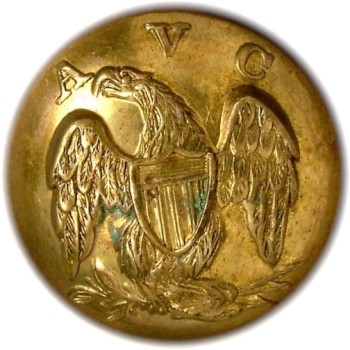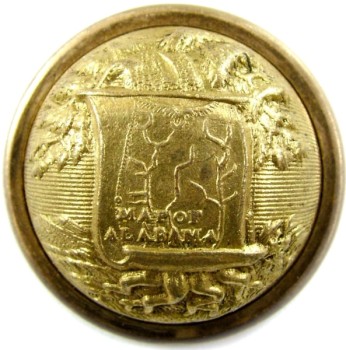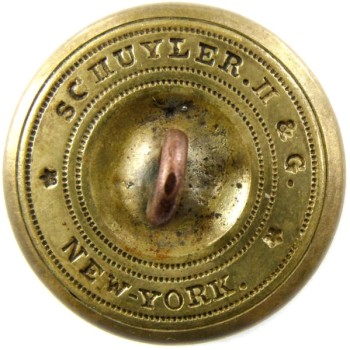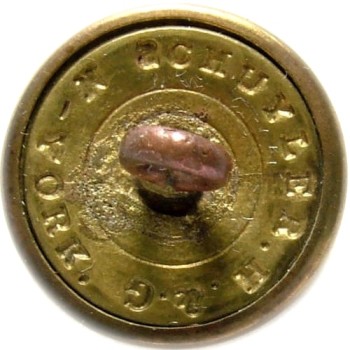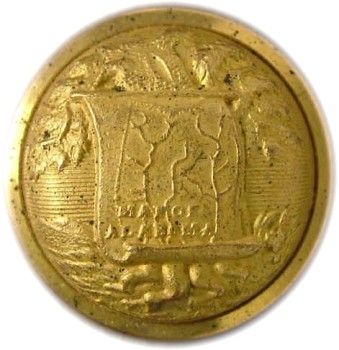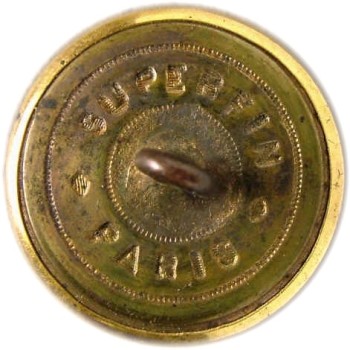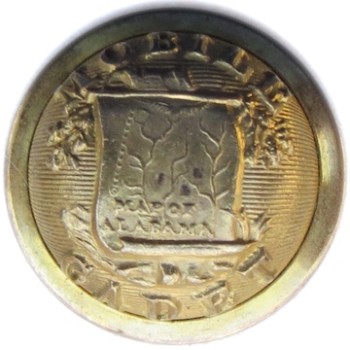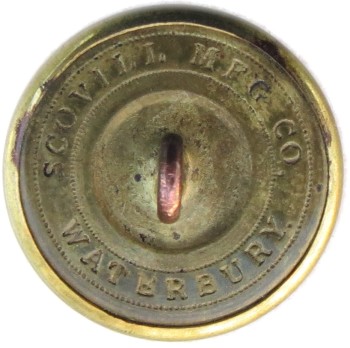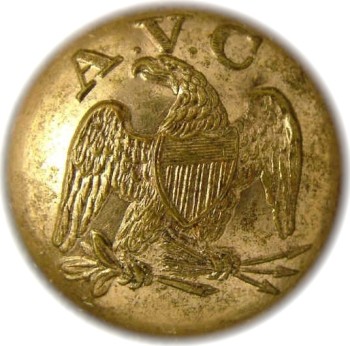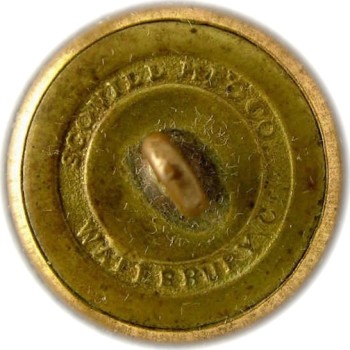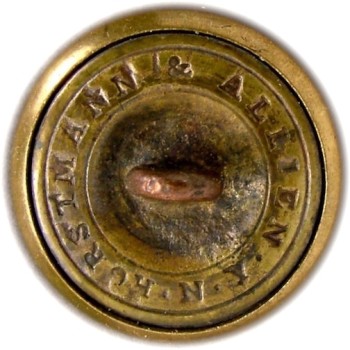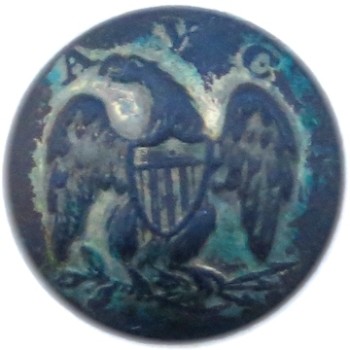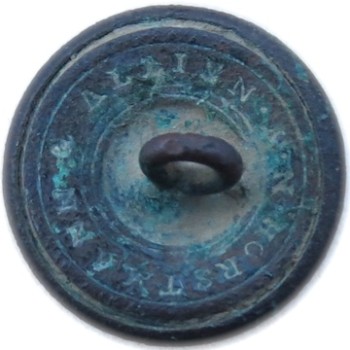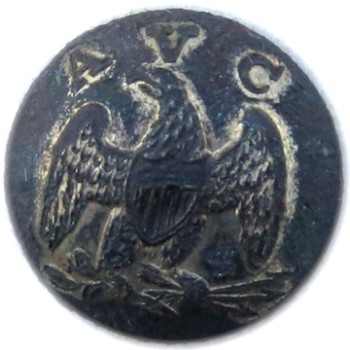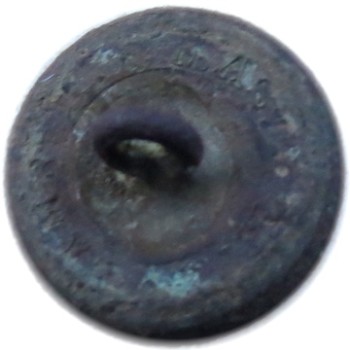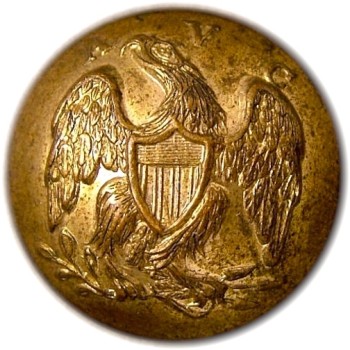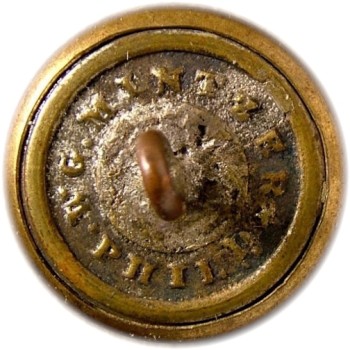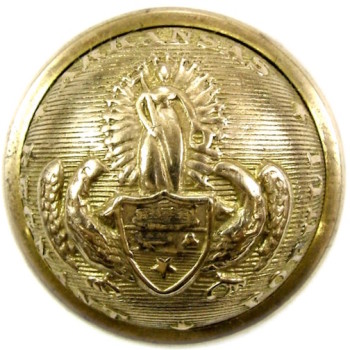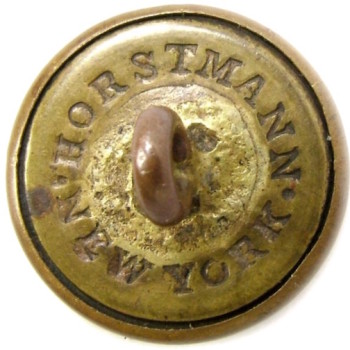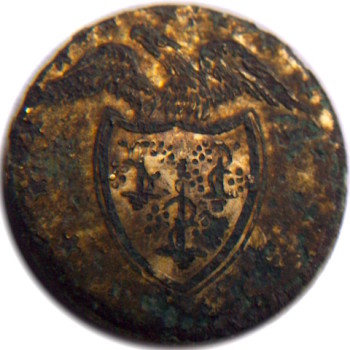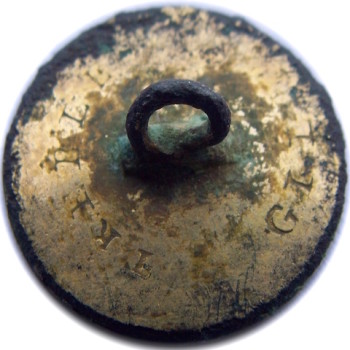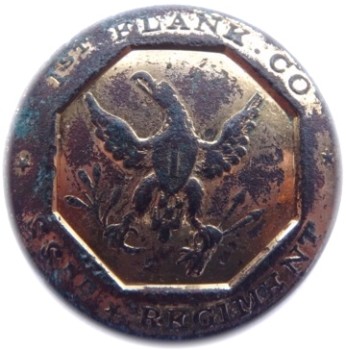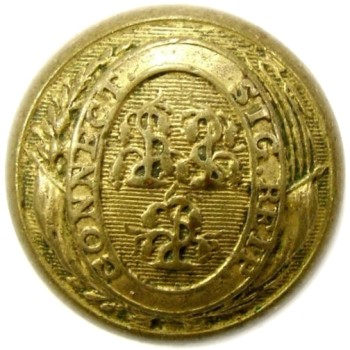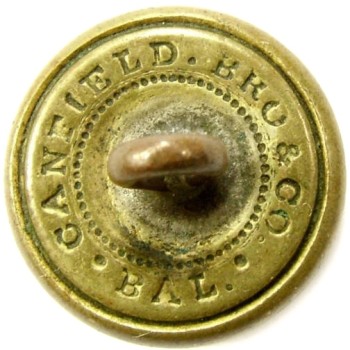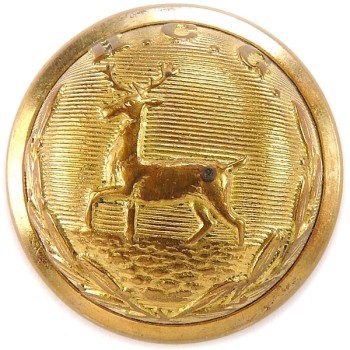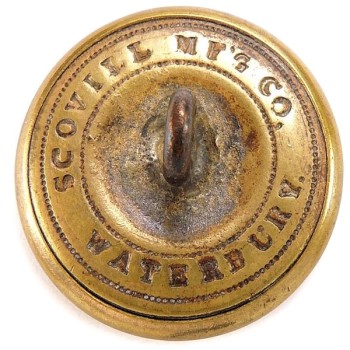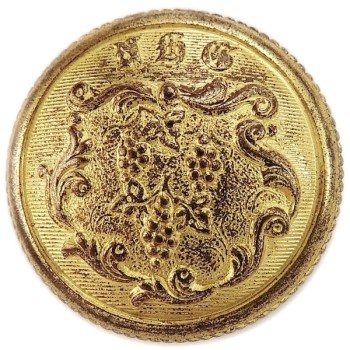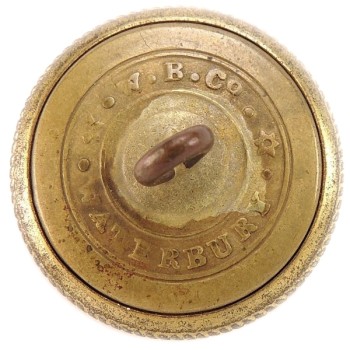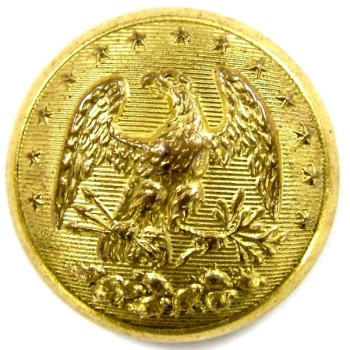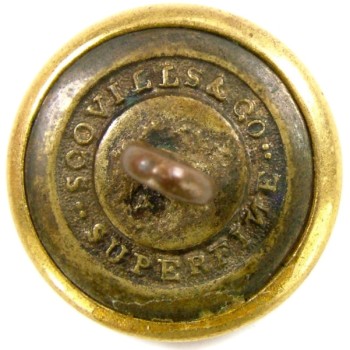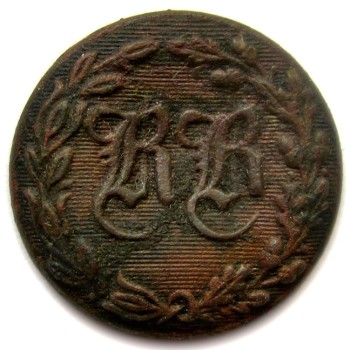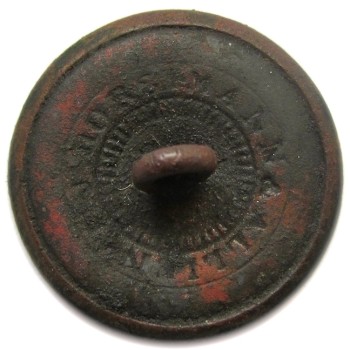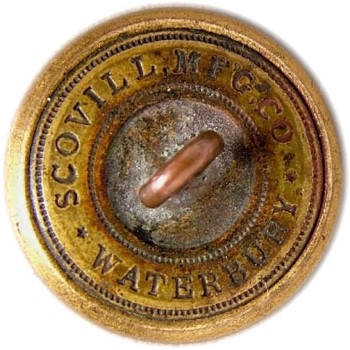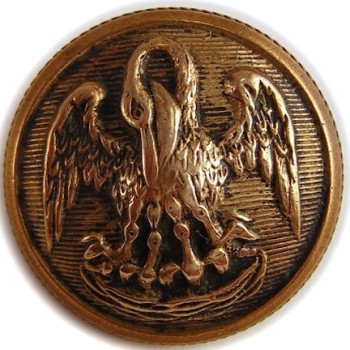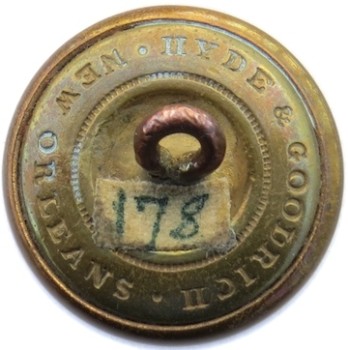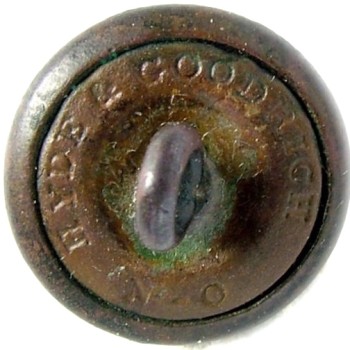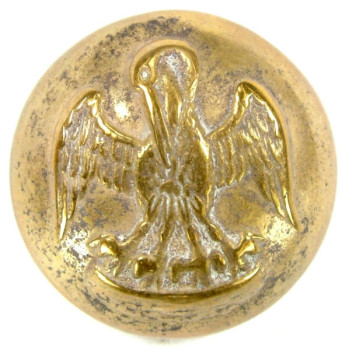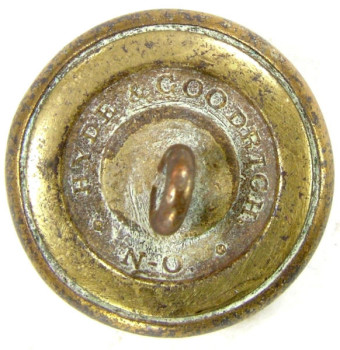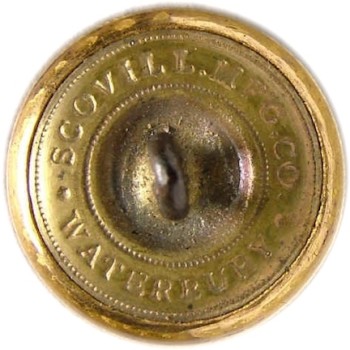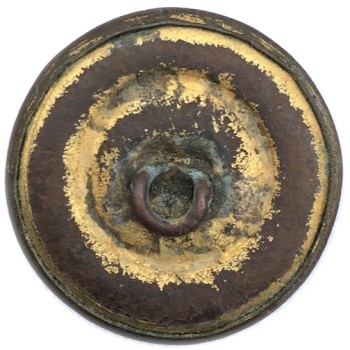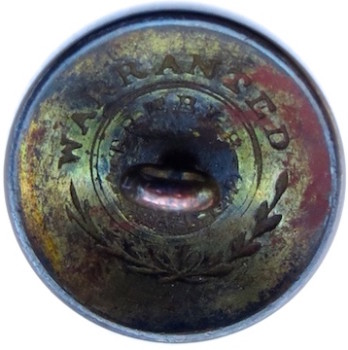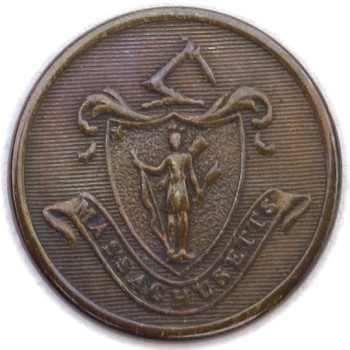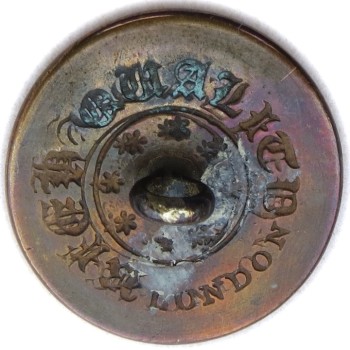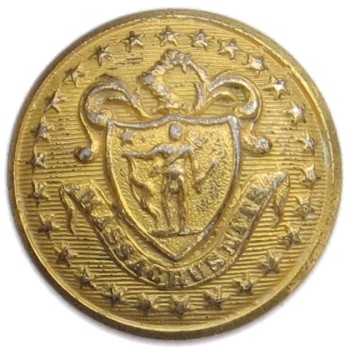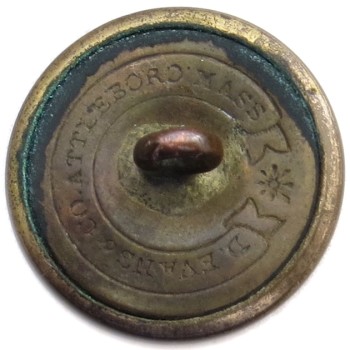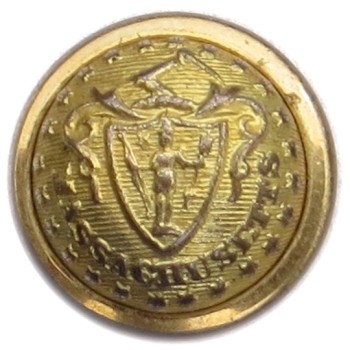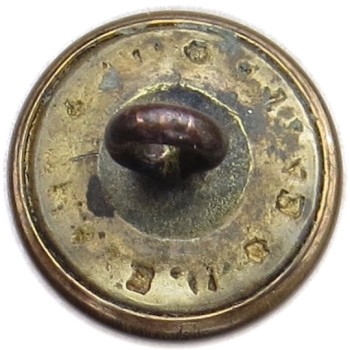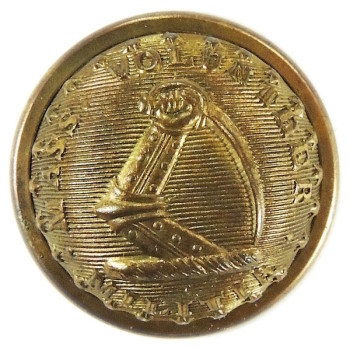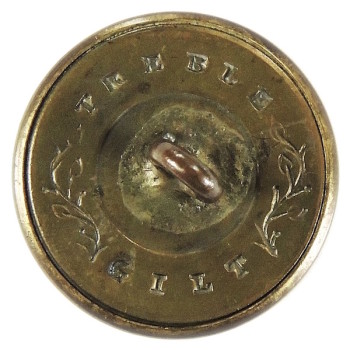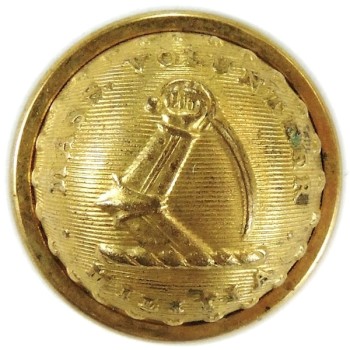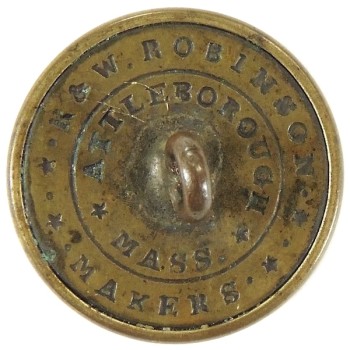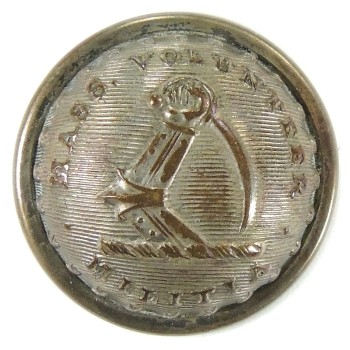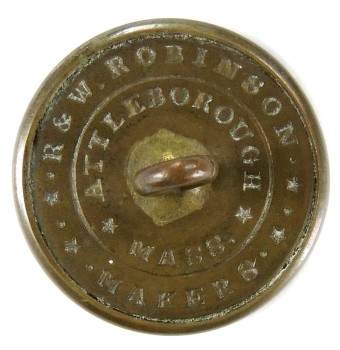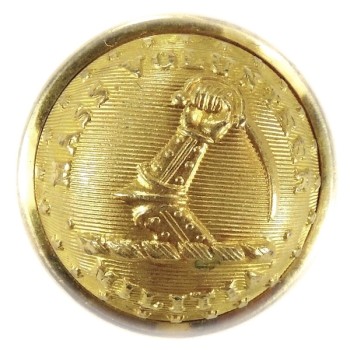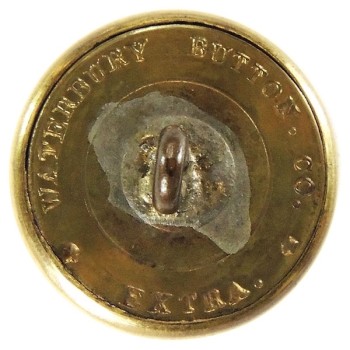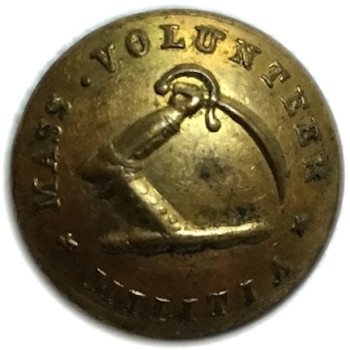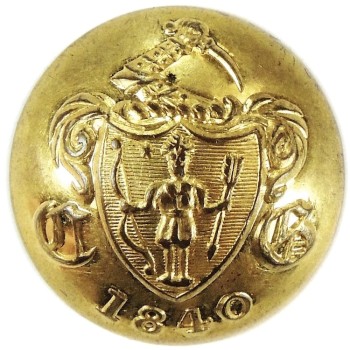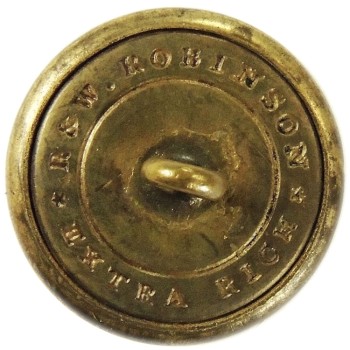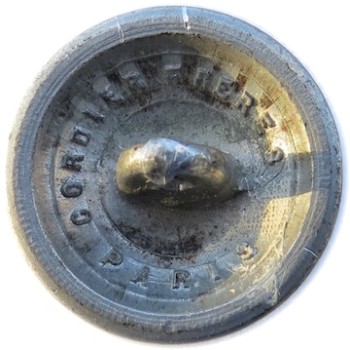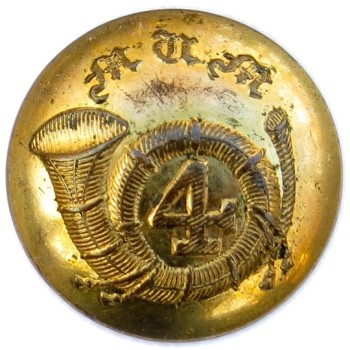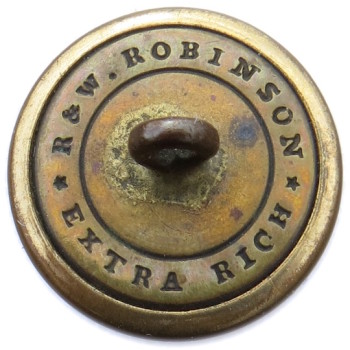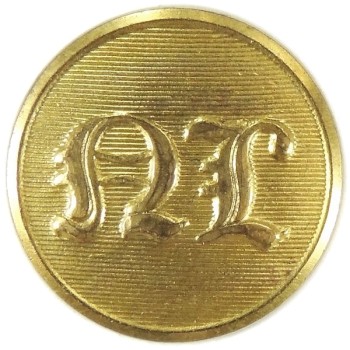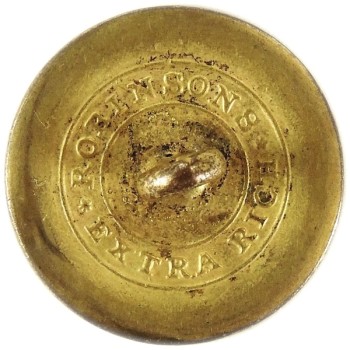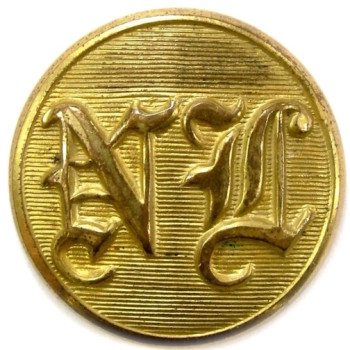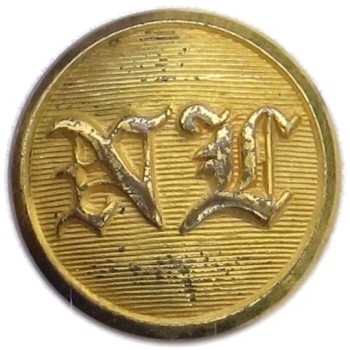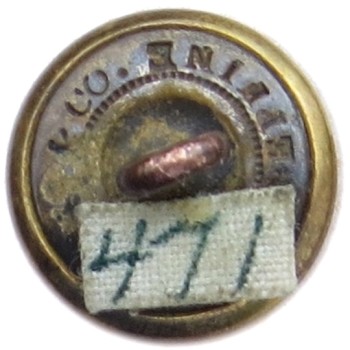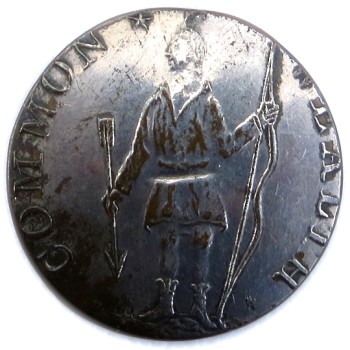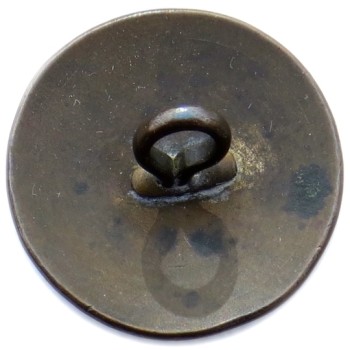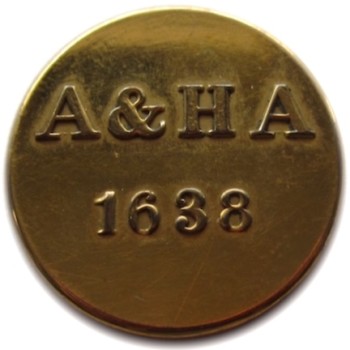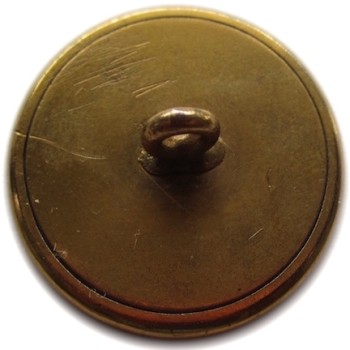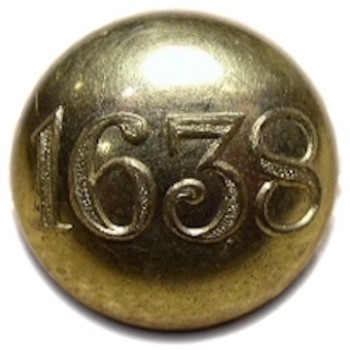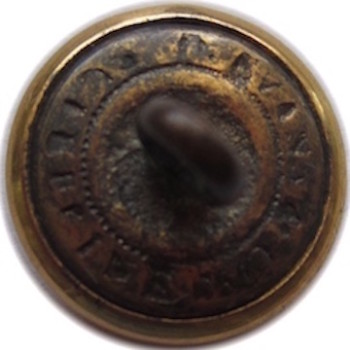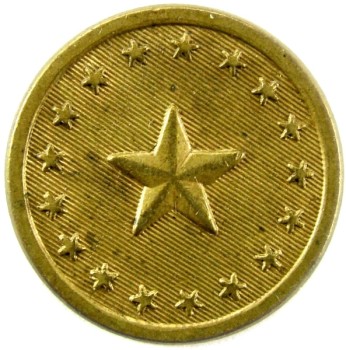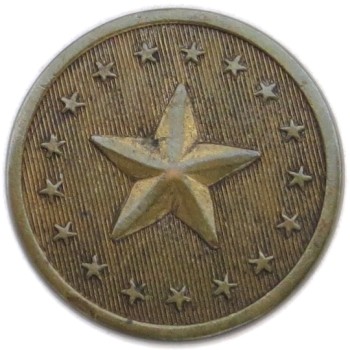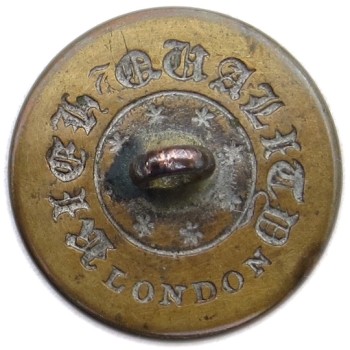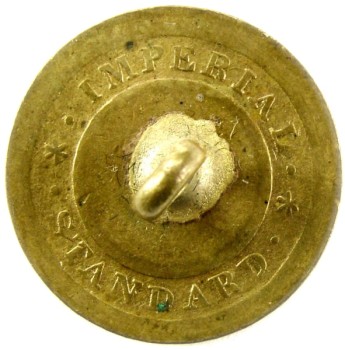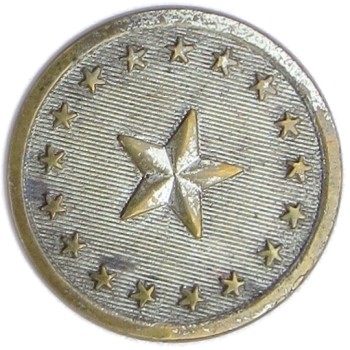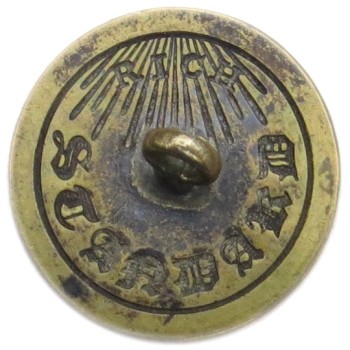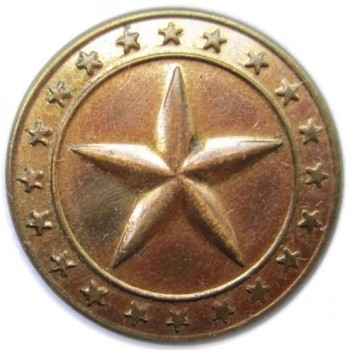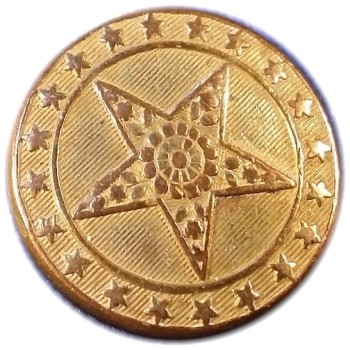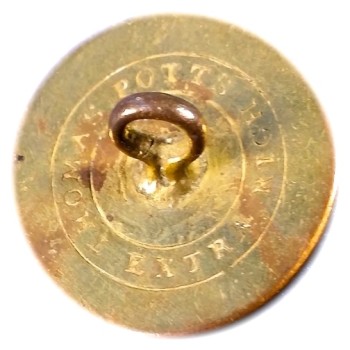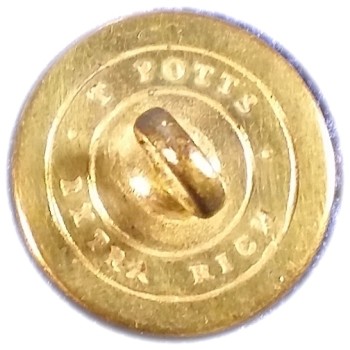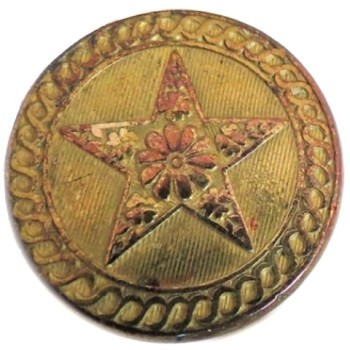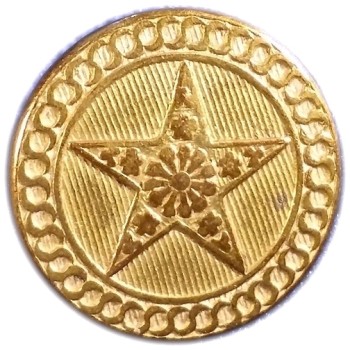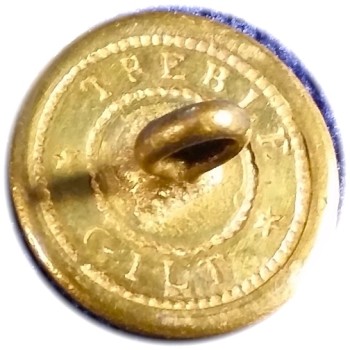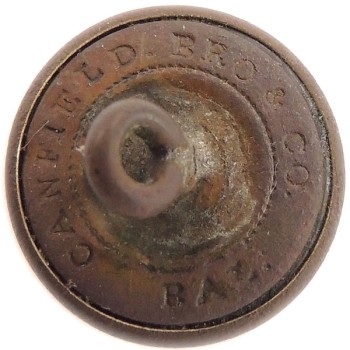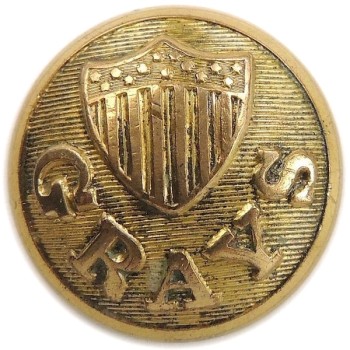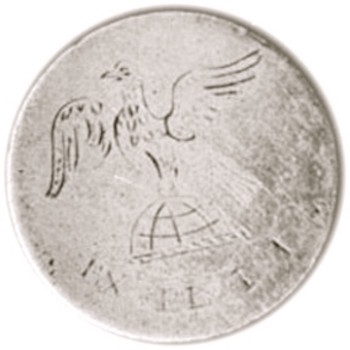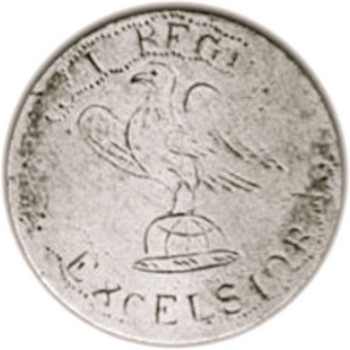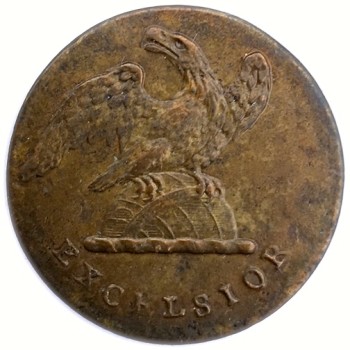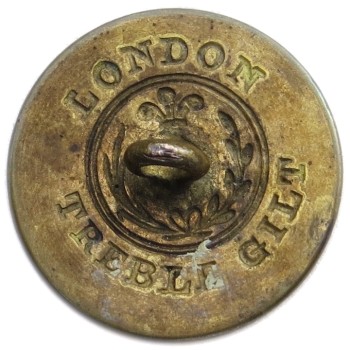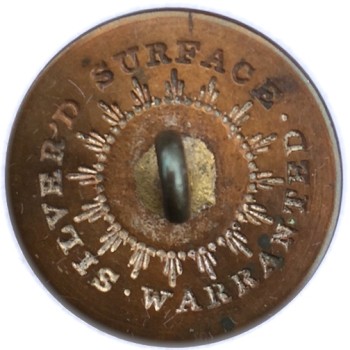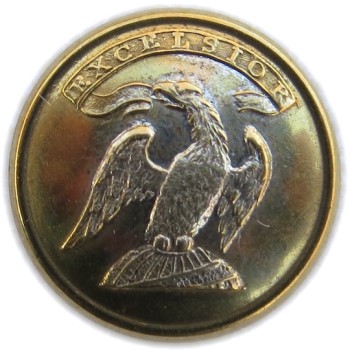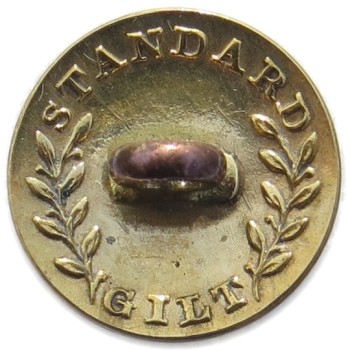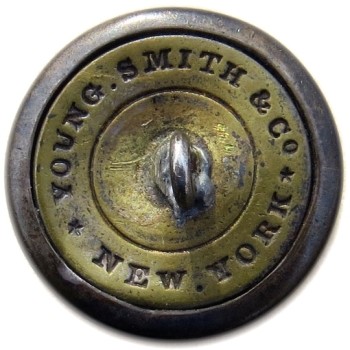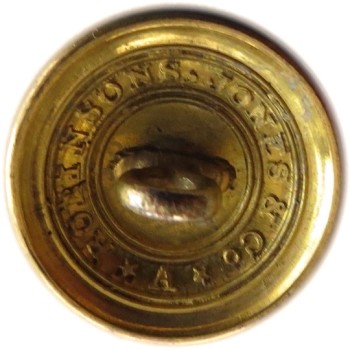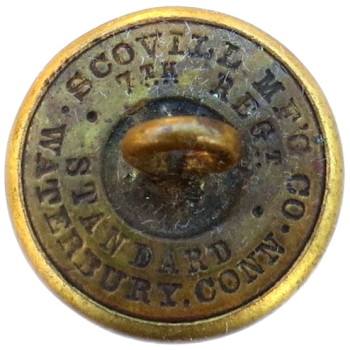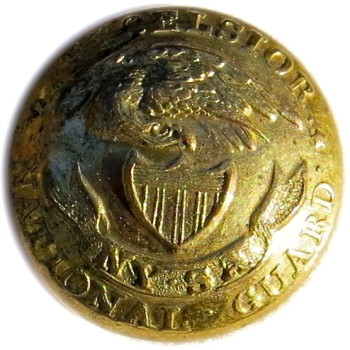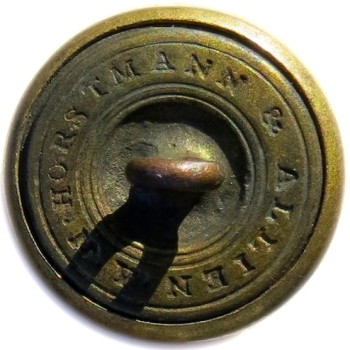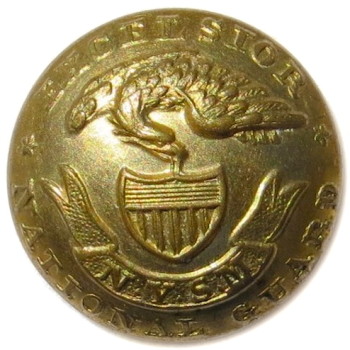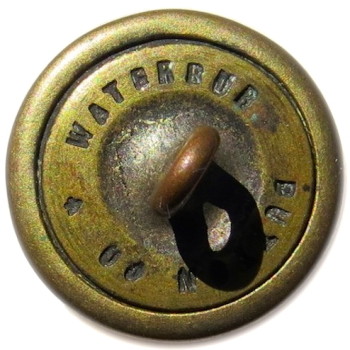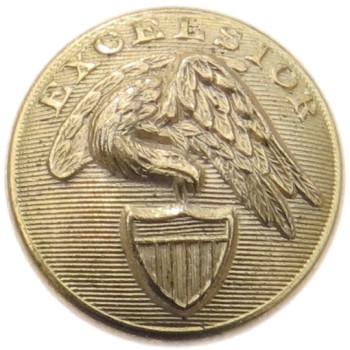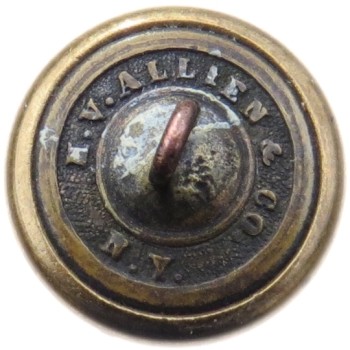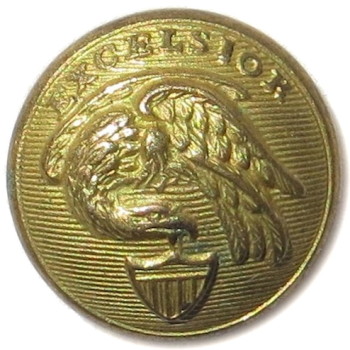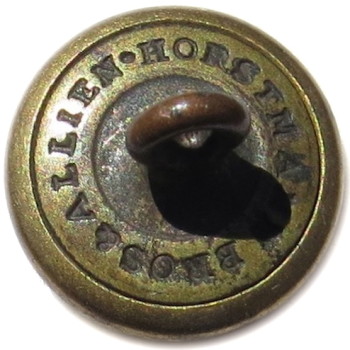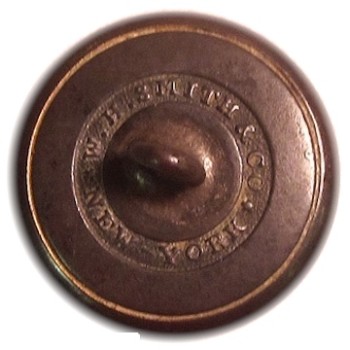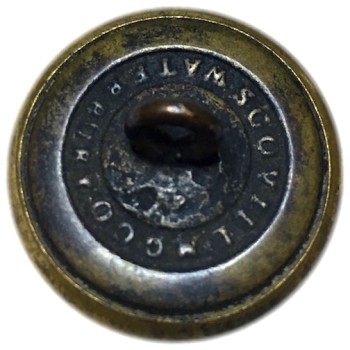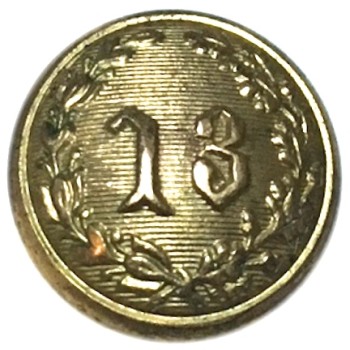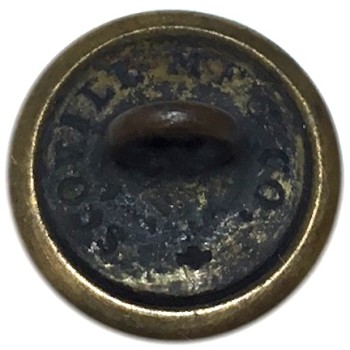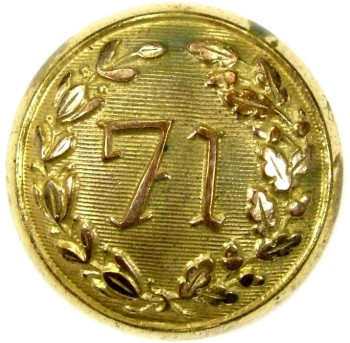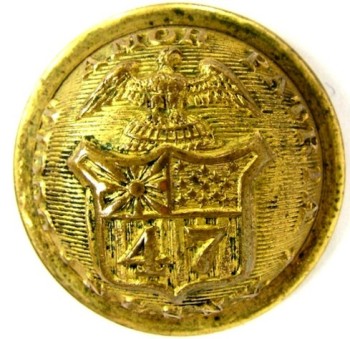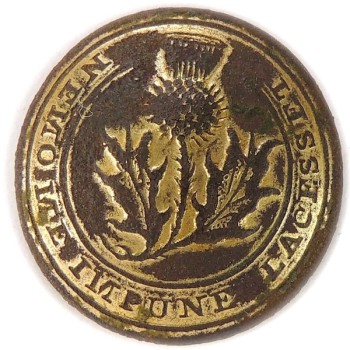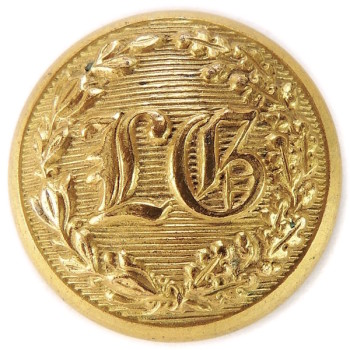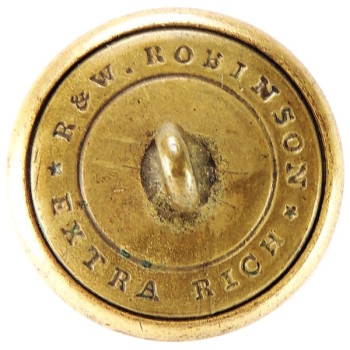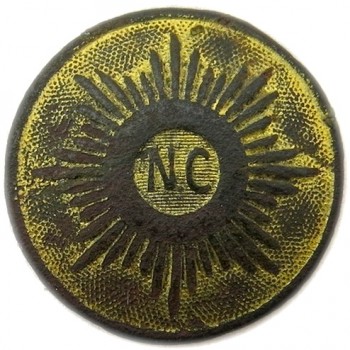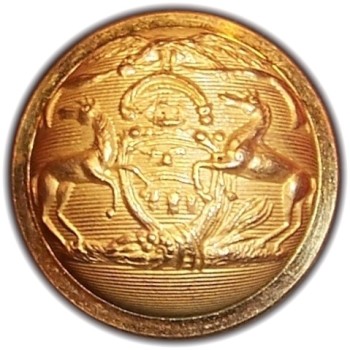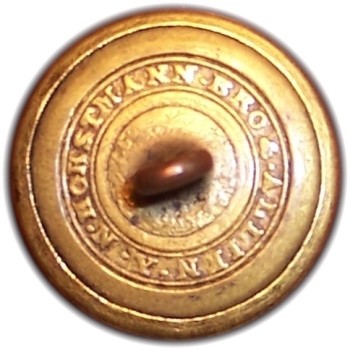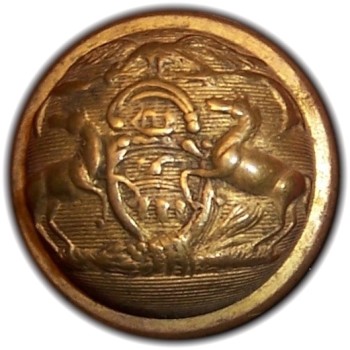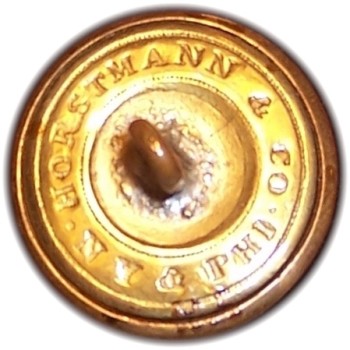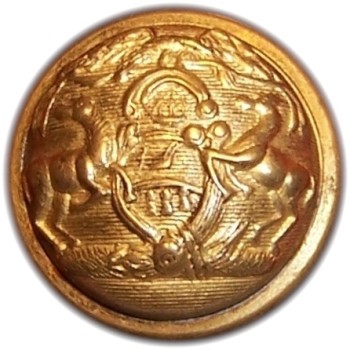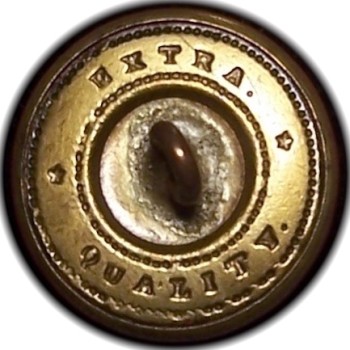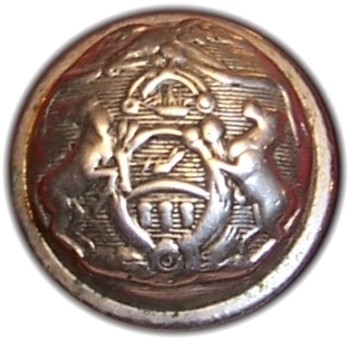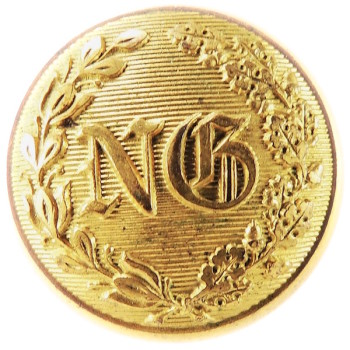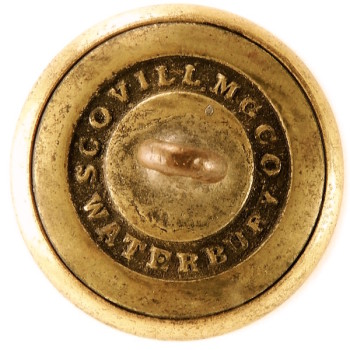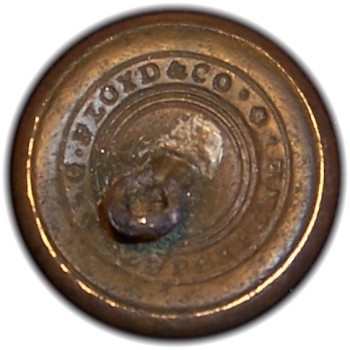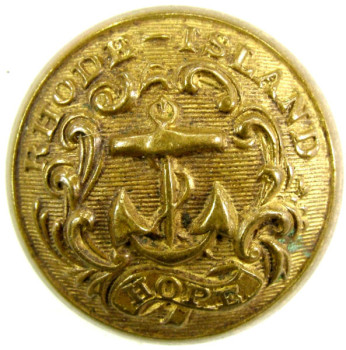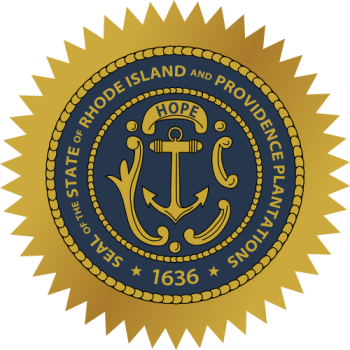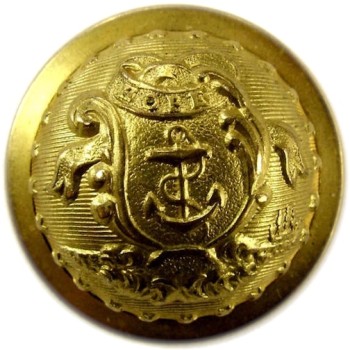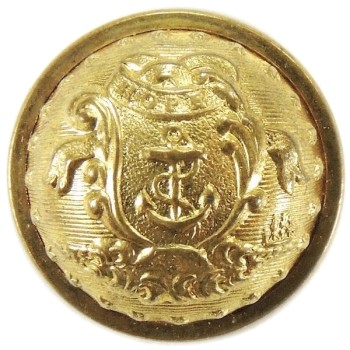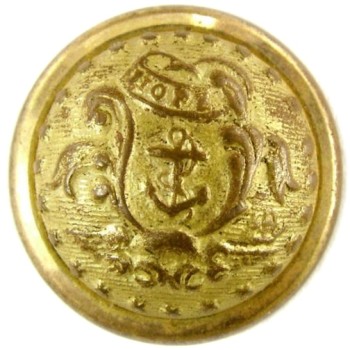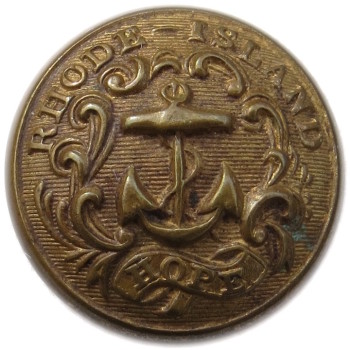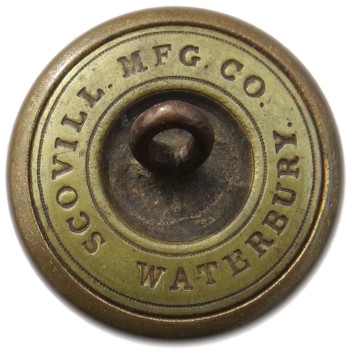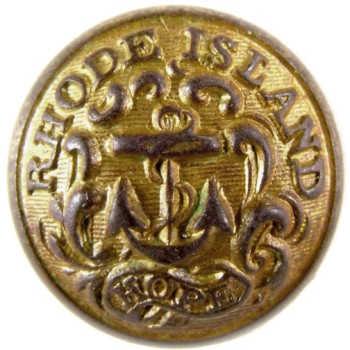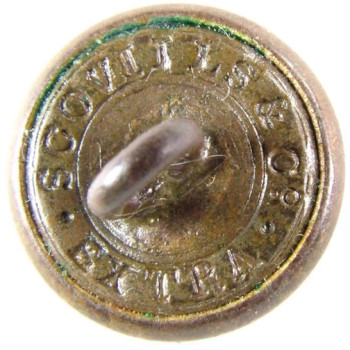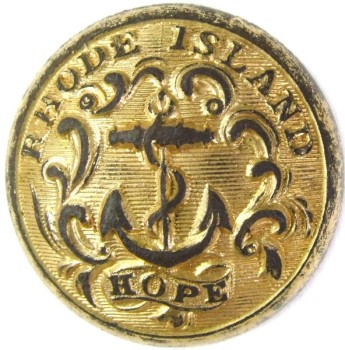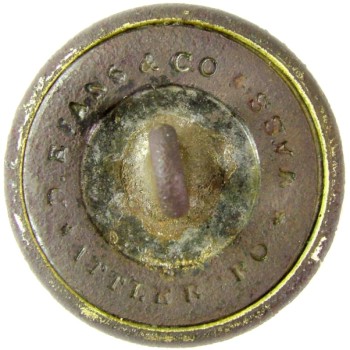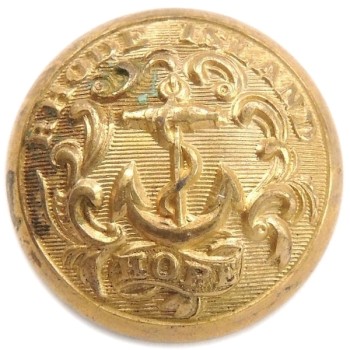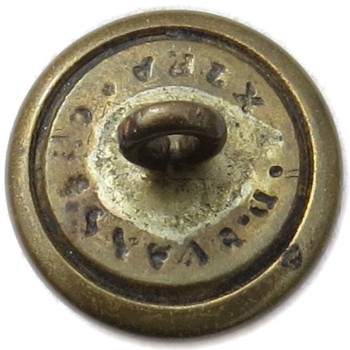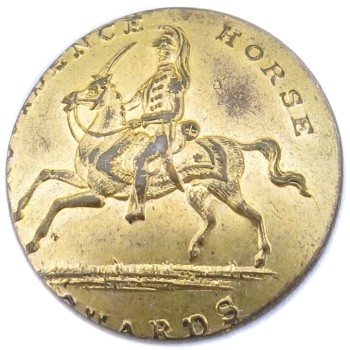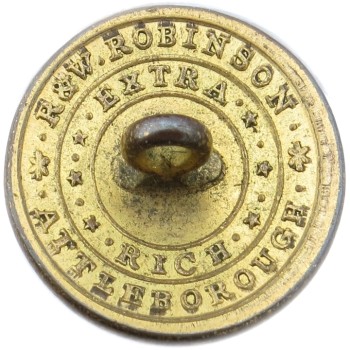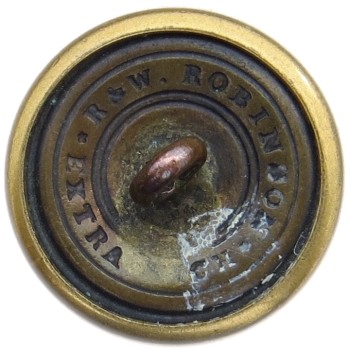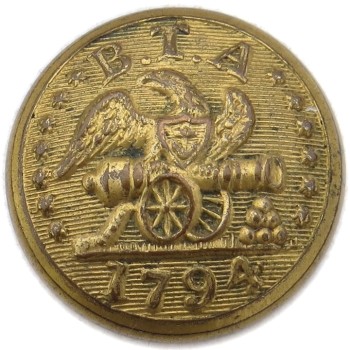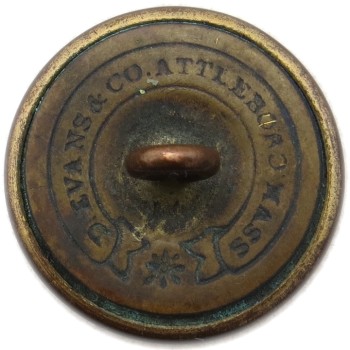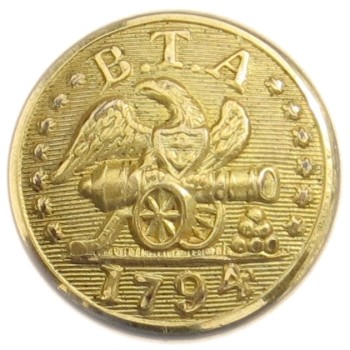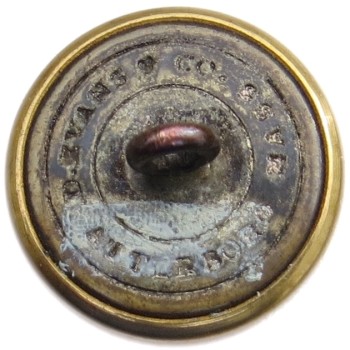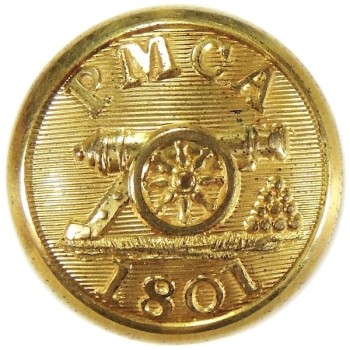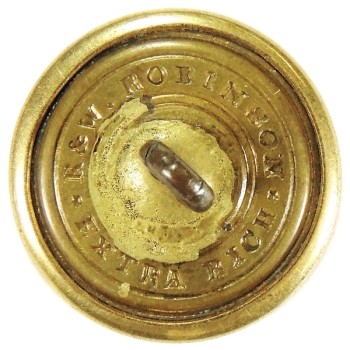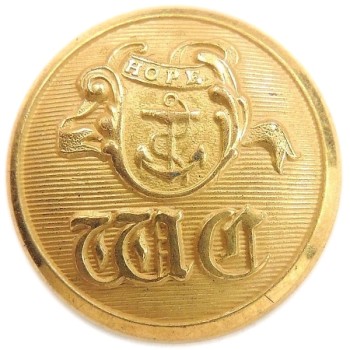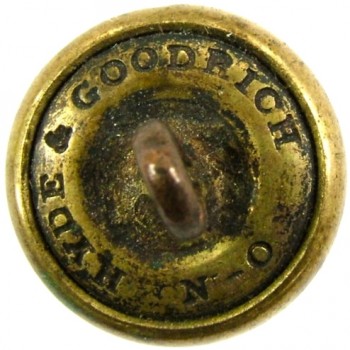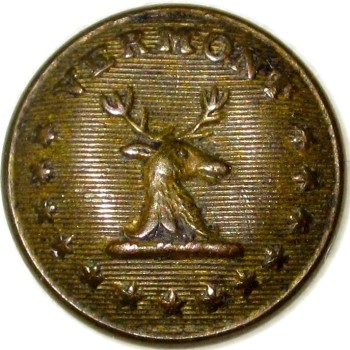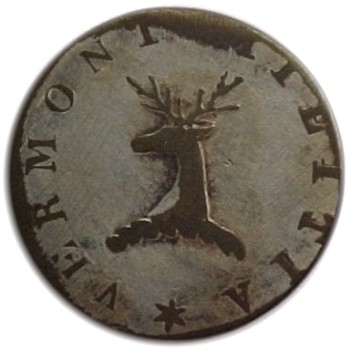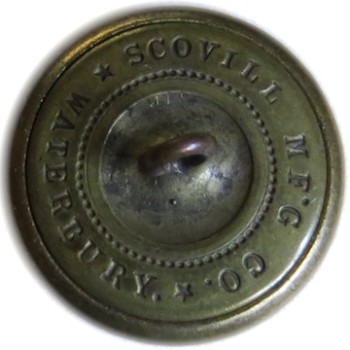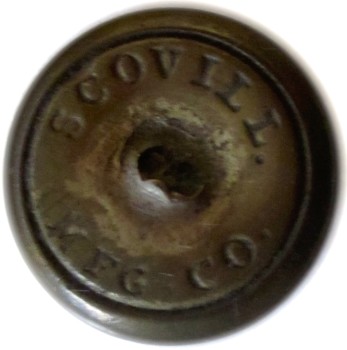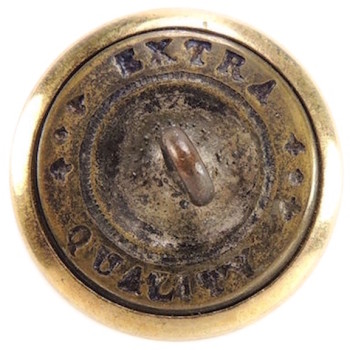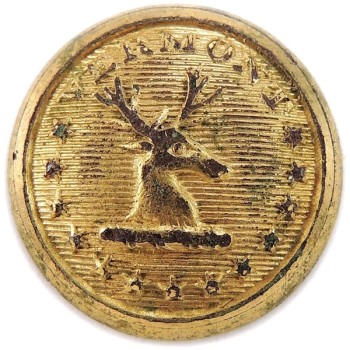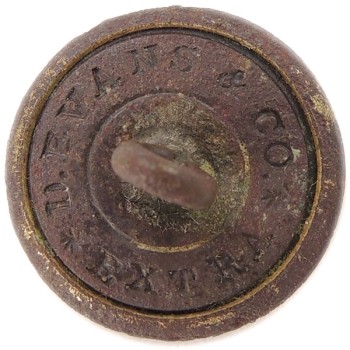~ United States Militia Units ~
1799-1810 Massachusetts Artillery Militia
Even though the Militia existed in the colonies before the battle of Lexington & Concord, I think it best to begin after 1789 when George Washington was elected President and the new US government formed under the Constitution. The first use of a semi federal-army was in 1794, when George Washington raised and led 13,000 state militia to quell the Whiskey Rebellion in Pennsylvania. The experience of unifying and leading a citizen based state militia system demonstrated to Washington that our country in time of war would have a major weakness compared to other countries who would have a well trained and disciplined army. The various state militia units were only a loose knit affiliation of citizens that lacked the necessary military discipline. Another major problem was the inadequate field training for officers and engineers. In a letter to General Alexander Hamilton he writes,“The establishment of a military academy upon a respectable and extensive basis has ever been considered by me as an object of primary importance to this country; and while I was in the chair of government, I omitted no proper opportunity of recommending it to my public speeches, and otherwise to the attention of the legislature.”
Being mindful of the country lacking a strong unified military army, President Washington repeatedly warned Congress of these military short-comings throughout his administration and up until his death in 1799. Finally, in 1802, the federal military academy at West Point was established. This was the answer to the United States problem of relying on a state based militia system and relying on foreign mercenaries for protection. In the beginning, there was a lack of appropriate funds by Congress for it’s military personal. Federal soldiers were given rations and were very limited on military equipment. On the other hand, state’s militia units were more properly outfitted, and were given very generous private donations. Unfortunately, money doesn’t buy experience, discipline or training. I would have to personally say they were ceremonial in nature. Most of these units were run by egocentrically rich citizens who presumed un-earned ranks of officers. It wasn’t until the war of 1812, when the various state’s militia units were overcome by British regulars that the US Congress came to realize the real consequences of Washington’s warning about the use of state based citizen militia units. After the War of 1812, Congress increased it’s military budgets drastically, and from this point on a Federal Standing Army was deemed better for the national defense. State’s militia units continued service by maintaining public order, but were primarily used in slave holding states where there principle duties was to round up run away slaves. In the years of peace between the War of 1812 and the Civil War, but the state militia’s fell into a “name only” ceremonial-parade marching units at best. They lacked any real war skills, field training, or anything that resembled adequate combat training. Local communities militia had never even drilled together as a larger regiment. By the time the Civil War came around, the US Army only consisted of a paltry 16,000 men, and both sides equally rushed to prepare. Following the Confederate Army taking Fort Sumter in 1861, President Lincoln called up the states militia to re-take the Federal seized property and found that the states militia was far inadequate for the task. He writes, “…strength was far short of what the Congressional Statute provided and required.” By the summer of 1861, military camps started to crop up and circle around Washington, D.C. They composed of new three year enlistment of Army Volunteers, and 90 day State Militia Units. The generals that Lincoln placed in charge of these men were simple inexperienced civilians who have never handled large bodies of men, and they lacked military combat training. There granted positions lacked military discipline, and they had a less understanding of the importance of discipline for war. This is why i choose to honor the Ancient & Honourable Artillery Button on my home page. It is a prime example of how an Ancient Militia was a very well known for being a strong fighting unit for over two hundred years, and then turned ceremonial over time. By the time the Civil War came around they were only recognized by their former reputation.
~ We honor those military men who gave of themselves, and thankful their personal sacrifices for the common good. As Americans we Cherish the Liberties and Freedoms that are afforded to us and Enjoy the Advanced Citizenship that America offers. God Bless America! ~
~ Robert J. Silverstein ~
Robert’s Notes: Most states usually gave their militia free reign in choosing their buttons and accoutrements for their uniforms. A lot of Militia Units choose patterns that had their own state’s coat of arms, but the units without the resources to have their own dies cut, had the option of asking the garment maker to request manufacturer supplied “Federal type specimens” with motifs similar to those U.S. Army Buttons issued between 1800 to 1825.
Yes Robert, “I would have to agree with your assessment of general service patriotic eagle designs. Remember that local militia units of this period were loosely organized following state and federal regulations, but were locally recruited and financed, they followed the regulations that they wanted to follow and there would have been lots of vendors offering supplies, and they pretty much made their own buying decisions. They bought uniforms from various garment makers, the garment makers bought buttons, sometimes specified, sometimes generic, these buttons you asked about could have been sold to other units and other states. The star count on most of these early buttons is artistic, whatever the artist thought would do. If a star count is not 13, it probably is artistic and not symbolic.” – Harry Ridgeway .
*
Alabama’s Militia Units
Alabama is located in the Southeastern region of the United States. It is bordered by Tennessee to the north, Georgia to the east, Mississippi to the west, and Florida and the Gulf of Mexico in the south. Alabama’s native indian tribes included the Cherokee, Iroquois, Choctaw, Creek, Koasati, and the Muskogean tribes. The word “Alabama” is believed to have come from the related Choctaw language, and was adopted by the Alabama tribe as their name. The Spanish were the first Europeans to reach Alabama in the 16th century. In 1540, the expedition of Hernando de Soto passed through Mabila as well as other parts of the state in 1540. More than 160 years later in 1702, the French founded the first European settlement in Old Mobile. The city was re-located to the current site of Mobile in 1711. This area was claimed by the French from 1702 to 1763 as part of La Louisiane. After the French lost the Seven Years War to the British, Alabama became part of the British’s West-Florida territory. Thomas Bassett, a loyalist to the British monarchy during the Pre-Revolutionary War era, was one of the earliest White settlers in the state outside Mobile. He settled in the Tombigbee District during the early 1770s. The British control over this territory only lasted for a brief time from 1763 to 1783. After the Continental Army’s victory in the revolution, Alabama’s territory was divided up between America and Spain. Spain retained control of this western territory from 1783, until they surrendered their garrison in Mobile on April 13, 1813.
Alabama is nicknamed the “Yellowhammer State,” after the state bird. Alabama is also known as the “Heart of Dixie” and the “Cotton State.” The state tree is the longleaf pine, and the state flower is the camellia. The capital of Alabama is Montgomery. Alabama 22nd state join union on December 14, 1819. In 1817, territorial Governor William Bibb designed the Great Seal of Alabama. It depicts a state map with navigable rivers that appear like a road map. After the Civil War, Carpet baggers abolished this seal in favor of one with a Federal Eagle & Shield design. This only lasted until 1939, when the Alabama legislature decided to resurrect the original seal by William Bibb. Just before the Civil War, Alabama authorities ordered buttons for their militia depicting a Confederate Type Eagle with down swept wings under the initials A.V.C. for Alabama Volunteer Corps.
Mid-1860’s Alabama State Militia Officer’s Staff
Color: Antique Yellow Brass.
Metal: High Convex, 3-Piece, Raised Design, Gilt Brass.
Size: 23mm. Coat Size.
Albert’s Number: AB 1A.3: RV 35
Tice’s Number: AB 200-A.1
Variation: State Seal of Alabama / Alabama Map / Middle River Has No Branches.
Present Condition: A Non Excavated Specimen, Exceptional Planchet Condition, An Exceptional High Relief Pattern Remains.
Robert’s Notes: It should be noted that Scovill manufactured nearly all these northern Alabama seal staff buttons after the Civil War, post-1865. Some though are confirmed to be used during the Civil War, but only with the Superfin / Paris Backmark. Cuff size specimens have been found at Civil War sites, but only with Schuyler, H & G backmarks. They probably used the SUPERFIN backmark to conceal sales to the south, but undocumented (Schuyler, 18). True Civil War specimens are exceptionally rare. The button’s pattern depicts the State Seal of Alabama nailed to an Oak Tree. The inscription, “Map of Alabama” is in raised lettering on the lower portion of the scroll. The state map is depicted with Navigable Rivers which appears like a road map. The Middle River has No Branches. The high relief pattern is set on an evenly lined convex field.
Reverse Button Analysis: This is a 3-piece button with a copper loop shank. The shank is original, straight, and intact.* SCHULYER.H & G * / NEW YORK dm with 2 inner and one outer ring of stipples. (Schuyler 18).
Mid-1860’s Alabama State Militia Officer’s Staff Cuff
Color: A Golden Golden Brown.
Metal: Convex, 3-Piece, Raised Design, Gilt Brass.
Size: 15mm. Hat or Cuff Size.
Albert’s Number: AB 1Av.1: RV 5
Tice’s Number: AB 200-As.1
Variation: State Seal of Alabama / Alabama Map / Navigable Rivers.
Present Condition: A Non Excavated Specimen, Exceptional Planchet Condition, An Exceptional High Relief Pattern Remains.
Robert’s Notes: Most of these cuff or hat buttons were manufactured for Officers in the State Militia after the Civil War. It should be noted that this particular cuff button with the backmark, “SCHUYLER . H.& G N-NEW YORK” dm has been found at Civil War sites. This button is extremely similar to the coat variation, except there is no inscription on the map. The button’s pattern depicts the State Seal of Alabama nailed to a Tree. The state map is depicted with Navigable Rivers which appears like a road map. The high relief pattern is set on a convex evenly lined field.The Middle River has No Branches. The high relief pattern is set on an evenly lined convex field.
Reverse Button Analysis: This is a 3-piece button with a copper loop shank. The shank is original, straight, and intact. SCHULYER . H .&. G / N- YORK. dm with 2 inner rings. (Schuyler 20 small).
1861-65 Alabama State Militia Officer’s Staff
Color: Brown Speckled Brass Yellow.
Metal: High Convex, 3-Piece, Raised Design, Gilt Brass.
Size: 23mm. Coat Size.
Albert’s Number: AB 1A.5: RV 10
Tice’s Number: AB 200-A.2
Variation: State Seal of Alabama / Alabama Map / Middle River Has No Branches.
Present Condition: A Non Excavated Specimen, Strong Planchet Condition, An Exceptional High Relief Pattern Remains.
Robert’s Notes: This backmark button was thought to be used during the Civil War by Alabama Staff Officers. It was thought to be produced in disguise by Scovill during the conflict. Collectors should note that Civil War specimens are exceptionally rare. The button’s pattern depicts the State Seal of Alabama nailed to a Tree. The inscription, “Map of Alabama” is in raised lettering on the lower portion of the scroll. The state map is depicted with Navigable Rivers which appears like a road map. The Middle River has No Branches. The high relief pattern is set on an evenly lined convex field.
Reverse Button Analysis: This is a 3-piece button with a copper loop shank. The shank is original, straight, and intact.”SUPERFIN / (diamond) PARIS (diamond) ” dm between 2 rings of dashes. (Superfin01).
Picture Courteous of Harry Ridgeway.
1860’s-70’s Alabama Mobil Cadets
Color: Yellow Brass.
Metal: Convex, 3-Piece, Raised Design, Gilt Brass.
Size: 24.08mm. Coat Size
Albert’s Number: AB 6A.1: RV 15
Tice’s Number: AB 252-A.1
Variation: State Seal of Alabama / Alabama Map / Alabama / Cadet.
Present Condition: A Non Excavated Specimen, Exceptional Planchet Condition, An Exceptional High Relief Pattern Remains.
Robert’s Notes: There is some uncertainty in dating these buttons. The Wide Rim suggests Post Civil War after 1871, however the Scovill backmark is commonly accepted on other earlier period buttons (Scovill M311). The Cadets were organized in 1845, and mustered in as Company A, 3 Alabama Regt. (Volunteer Militia) and then served with distinction in the 1st and 3rd Alabama Regt. during the Civil War. They received their first marching orders as Confederate soldiers on April 23, 1861. Tice notes in his book that Scovills made buttons with extremely wide rims after the civil war, and places a Post date of 1871. He thinks the button were made after the Alabama state authorities reconstituted the Mobil Cadets, just after Congress readmitted Alabama into the union. The button’s pattern depicts the State Seal of Alabama with the inscription, “Map of Alabama” in raised lettering in the lower portion of the scroll. The state map is depicted with Navigable Rivers appearing like a road map. In a semicircle above is the word, “Alabama” and below “Cadet“. The high relief motif is set on a convex evenly lined field.
Reverse Button Analysis: This is a 3-piece button with a copper loop shank. The shank is original, straight, and intact. SCOVILL MFG CO. / WATERBURY dm within 2 stipple rings.
The RJ. Silverstein Collection.
1860-61 Alabama Volunteer Corps
Color: Tarnished Brass Yellow.
Metal: Convex, 2-Piece, Raised Design, Gilt Brass.
Size: 22.6mm. Over Coat Size.
Albert’s Number: AB 2B: RV 25
Tice’s Number: AB 212 A.3
Variation: Federal Eagle W/ Down Swept Wings / A. V. C Above /1 Berry & 4 Petal Olive Branch / 3 Close Spaced Arrows / Eagle’s Head Touches V.
Present Condition: A Non Excavated Specimen, A Strong Planchet Condition, An Exceptional High Relief Pattern Remains.
Robert’s Notes: This is the largest size AVC button at 23mm, and was most likely used on an over coat. This is slightly larger then it’s 21mm counterparts. This button was made for Alabama troops just before the start of the Civil War. There is only one known pattern in this size, but can have 3 different backmarks. The Canfield Bro & Co. & Jas Conning Mobile being the more rarer of the 3. The button’s pattern depicts a Federal Eagle facing right with Down Swept Wings. In the Eagle’s left talon is Three Close Spaced Arrows pointing towards the left. In the Eagles right talon is a One Berry & Four Petal Olive Branch. There is a slightly slanted spade shape Federal Type Shield over the Eagles chest. The initials for Alabama Volunteer Corps. “A. V. C” is in a semicircle above the Eagle’s head. In this die variant the Eagle’s Head touches the “V“. The high relief pattern is set on a plain convex field.
Reverse Button Analysis: This is a 2-piece button with a copper loop shank. The shank is original, straight, and intact. SCOVILL MF’G CO. / WATERBURY CT. rmdc Scovill M230.
1860 Alabama Volunteer Corps
Color: Brass Yellow With A Splash of Green.
Metal: Convex, 2-Piece, Raised Design, Gilt Brass.
Size: 20.06mm. Coat Size.
Albert’s Number: AB 3B: RV 20
Tice’s Number: AB 216-A.1
Variation: Federal Eagle W/ Down Swept Spread Wings / A V C Above /3 Petal & Berry Olive Branch / 3 Close Spaced Arrows / Eagle’s Beak Touches A.
Present Condition: A Non Excavated Specimen, A Strong Planchet Condition, An Exceptional High Relief Pattern Remains.
Robert’s Notes: This button was made by Steele & Johnson in 1860 & 1861. Alabama most likely ordered these buttons to outfit their troops just prior to the Civil War. There are at least 3 known die variants with this pattern, but with just slight variations. The button’s pattern depicts a Federal Eagle facing right with Down Swept Spread wings. In the Eagle’s left talon is Three Close Spaced Arrows pointing toward the left. In the Eagles right talon is a Three Petal & 3 Berry Olive Branch. There is a pronounced outlined Federal Type Shield that is slightly slanted on the Eagles chest. The initials for Alabama Volunteer Corps. “A V C” is in a semicircle above the Eagle’s head. In this die variant the Eagle’s Pronounced Beak touches the “A“. The high relief pattern is set on a plain convex field.
Reverse Button Analysis: This is a 2-piece button with a copper loop shank. The shank is original, straight, and intact. HORSTMANN & ALLIEN / . N . Y. dm between two rings, Horstmann A23, coat.
1860 Alabama Volunteer Corps
Color: Earth Brown With Gold Highlights & Green Encrustations.
Metal: Convex, 2-Piece, Raised Design, Gilt Brass.
Size: 23.73mm. Coat Size.
Albert’s Number: AB 3B: RV 20
Tice’s Number: AB 216-A.1
Variation: Federal Eagle / A V C Above /3 Petal Olive Branch / 3 Close Spaced Arrows / Eagle’s Beak Touches A.
Present Condition: An Excavated Specimen, Good Planchet Condition, A Good High Relief Pattern Remains.
Robert’s Notes: This button was made by Steele & Johnson under Horstmann & Allien B/M around 1860-61. Alabama ordered these buttons to outfit their troops just prior to the Civil War. There are at least 3 known die variants with this pattern, but have slight variations. The button’s pattern depicts a Federal Eagle facing right with Down Swept Wings. In the Eagle’s left talon is Three Close Spaced Arrows pointing towards the left. In the Eagles right talon is a Three Petal & 1 Berry Olive Branch. There is a pronounced outlined Federal Type Shield over the Eagle’s chest. The initials for Alabama Volunteer Corps. “A V C” is in a semicircle above the Eagle’s head. In this die variant, the Eagle’s Pronounced Beak touches the “A“. The high relief pattern is set on a plain convex field.
Reverse Button Analysis: This is a 2-piece button with a copper loop shank. The shank is original, straight, and intact. HORSTMANN & ALLIEN / . N . Y. dm between two rings, Horstmann A23, coat.
The Robert J. Silverstein Collection.
1860 Alabama Volunteer Corps
Color: Dirty Brown With Gold Highlights.
Metal: Convex, 2-Piece, Raised Design, Gilt Brass.
Size: 15.3mm. Cuff or Hat Size.
Albert’s Number: AB 3A: RV 12
Tice’s Number: AB 214-As.3
Variation: Federal Eagle W/ Down Swept Wings / A V C Above /3 Petal Olive Branch / 3 Close Spaced Arrows.
Present Condition: An Excavated Specimen, Good Planchet Condition, A Good High Relief Pattern Remains.
Robert’s Notes: Alabama most likely ordered these buttons to outfit their troops just prior to the Civil War in 1860. There are at least 5 known backmarks for the cuff size button. The button’s pattern depicts a Federal Type Eagle with Down Swept Wings. In the Eagle’s left talon is Three Close Spaced Arrows pointing towards the left. In the Eagles right talon is a Three Petal & 1 Berry Olive Branch. On the Eagle’s chest is a slightly slanted spade shape Federal Shield. The initials for Alabama Volunteer Corps, “A V C” is in a semicircle above the Eagle’s head. The high relief pattern is set on a plain convex field.
Reverse Button Analysis: This is a 2-piece button with a copper loop shank. The shank is original, straight, and intact. LAMBERT & MAST / PHIL. rmdc
The Robert J. Silverstein Collection.
1860-65 Alabama Volunteer Corps
Color: Brown Freckled Gold.
Metal: Convex, 2-Piece, Raised Design, Gilt Brass.
Size: 20.09mm. Coat Size.
Albert’s Number: AB 3C: RV 20
Tice’s Number: AB 218-A.1
Variation: Spread Wing Eagle / A V C Above /5 Petal Olive Branch / 3 Close Spaced Arrows / Eagle’s Wings Touches C.
Present Condition: A Non Excavated Specimen, Strong Planchet Condition, An Exceptional High Relief Pattern Remains.
Robert’s Notes: In 1860, Alabama attempted to form new companies of efficient Militia called, “Volunteer Corps of the State of Alabama” from old militia units. By 1861, the Corps was almost at the point of death because most active units joined the Confederate Army. This die variant is the most common among all A.V.C. buttons. It was made by Steele & Johnson prior to the Civil War for Alabama Volunteers. This button is the most common found Alabama buttons and can be found in non-dug condition easily. The button’s pattern depicts a Federal Eagle facing right with Down Swept Wings. In the Eagle’s left talon is Three Close Spaced Arrows pointing towards the left. In the Eagles right talon is a Five Petal Olive Branch. There is a Pronounced Outline Spade Shape Federal Shield over the Eagles chest. The initials for Alabama Volunteer Corps, “A V C” is in a semicircle above the Eagle’s head. In this die variant the Eagle’s Wing touches the “C“. The high relief pattern is set on a plain convex field with a plain edge.
Reverse Button Analysis: This is a 2-piece button with a copper loop shank. The shank is original, straight, and intact. W. G. MINTZER / . PHILD.. * rmdc in stippled field, Mintzer 04.
*
Arkansas Militia Units
Arkansas is a state located in the southeastern region of the United States. It borders Oklahoma o the west, Tennessee and Mississippi to the east, Missouri to the north, and Texas to the southwest. The Mississippi River forms most of the states southeastern border and is considered to be the state line for the most part. Arkansas name is a Siouan derivation. The early frontiersman took the state name from the Quapaw Indians which meant,”Downstream People.” Arkansas was acquired by the United States through the efforts of Thomas Jefferson and his ambassador’s Robert Livingston and James Monroe. In 1802, Jefferson felt it paramount to buy New Orleans and parts of Florida from the French. Understanding the US need for foreign security and eminent domain, this led to the Louisiana Purchase in 1803 from the French. The United States government purchased over 800,000 square miles of land west of the Mississippi. This was the largest land acquisition in US history. It allowed the US government to open up lands in the west for settlement and open up duty-free port cities within New Orleans. In Arkansas, the Louisiana Purchase signaled an end to the French and Spanish dominance as American frontiersman filtered into the area. The territory of Arkansas was admitted to the union as the 25th state on June 15th 1836. Arkansas withdrew from the United States and joined the Confederate States of America during the Civil War. Upon returning to the Union, the state would continue to suffer due to its earlier reliance on slavery and their plantation based economy. This causing the state to fall behind economically and socially. White rural interests continued to dominate the state’s politics until the Civil Rights movement in the mid-20th century.
In 1820, Samuel Calhoun Roane designed the original Arkansas Territorial Seal. It depicts a spread Eagle with a Scroll in it’s beak. Inscribed in the scroll is the state’s motto (a Latin term), “Regnant Populus” meaning “The People Rule.” In the eagle’s left talon is a small bundle of Three Arrows, and in it’s right claw is an Olive Branch. Covering over the eagle’s chest is a large spade shaped shield divided into three with a Steamboat above, Plow & Beehive in the middle, and a Sheaf of Wheat below. On the shield’s right is an Angel figure with the inscription, “Mercy” in a banner ribbon. On the shield’s left is a large Pommel Sword with the inscription, “Justice” on the blade. Above the Eagle, is the Goddess of Liberty. She holds a Liberty Pole with a Phrygian Cap in her left hand, and a Triumphant Crown Wreath of Victory in her right. The Goddess is encircled by a ring of 13 Five Pointed American Stars with a circle of outside Emanating Rays. In 1832, and 1835, there were variations but consistent with the motif I outlined above.
1860’s Arkansas Infantry, General Use
Color: A Brass Yellow.
Metal: High Convex, 3-Piece, Raised Design, Gilt Brass.
Size: 22.08mm. Coat Size.
Albert’s Number: AK.1: RV 85
Tice’s Number: AK 200-A.1.
Variation: Arkansas Territorial State Seal / Arkansas / Regnant Populus / Star in Bottom Legend.
Present Condition: A Non Excavated Specimen, A Strong Planchet Condition, A Strong High Relief Pattern Remains.
Robert’s Notes: Arkansas only has one State Seal button made for troops serving in the Civil War. The Market place usually asks for a premium regardless of it’s rarity. Specimens can be found with both a Gilt finish or a protective lacquer coating. Steele and Johnson most likely produced these buttons during the Civil War period, but a few specimens with the Hyde & Goodrich backmark indicate the manufacturing origin would be at Waterbury’s Scovill Manufacturing company. The button’s pattern depicts a variation of the Arkansas Territorial State Seal. The state’s name, “Arkansas” is in the legend above, and there is an American 5 Pointed Star in the bottom legend. In the outside legend flanking the side of each eagle’s wing is the states motto, “Regnant Populus” which means “The People Rule.” The high relief pattern is set on an evenly lined high convex field.
Reverse Button Analysis: This is a three-piece button with a copper loop shank. The shank is original, straight, and intact.
1860’s Arkansas Infantry, General Use
Color: A Coppery Undertone Brass Yellow.
Metal: Convex, 2-Piece, Raised Design, Gilt Brass.
Size: 14.50mm. Cuff Size.
Albert’s Number: AK-Av.1: RV 25
Tice’s Number: AK 200-As.1.
Variation: Arkansas Territorial State Seal / Arkansas / Regnant Populus.
Present Condition: A Non Excavated Specimen, A Strong Planchet Condition, A Strong High Relief Pattern Remains.
Robert’s Notes: Arkansas only has one cuff button with the State Seal that is of Civil War period. The cuff is very similar except for three less depictions. First, it does not have either Star. The one in the bottom legend or the one in the shield. Second, it does not have the shield’s flanking Eagles. The button’s pattern depicts a variation of the Arkansas Territorial State Seal. The state’s name, “Arkansas” is in the legend above. In the outside legend is the states motto, “Regnant Populus” which means “The People Rule.” The high relief pattern is set on an evenly lined convex field.
Reverse Button Analysis: This is a two-piece button with a copper loop shank. The shank is original, straight, and intact.
*
Connecticut’s Militia Units
Connecticut is the southern most state in the New England region of the north east United States. It is bordered by Massachusetts to the north, Rhode Island to the east, New York to the west, and Long Island Sound to the south. Connecticut is often grouped along with New York and New Jersey and known as the tri-state area. The English colonist selected the state’s name from an Algonquin Indian word meaning, “Beside the long tidal river” this was eluding to the Connecticut River. This is a major U.S. river that approximately bisects the state. The word “Connecticut” itself is derived from various anglicized spellings of the indian phrase. Even though Connecticut has no direct access to the Atlantic ocean, the Connecticut River, Thames River, were used in conjunction with the ports along the Long Island Sound. This gave Connecticut a strong maritime tradition, which continues today.
Connecticut is also known as the “Constitution State“, the “Nutmeg State“, the “Provisions State“, and the “Land of Steady Habits.” Connecticut’s first European settlers were Dutch. They established a small, short-lived settlement in what is known as present-day Hartford at the confluence of the Park and Connecticut rivers. The first major settlements was established in the 1630s by English colonists. Thomas Hooker led a band of followers overland from the Massachusetts Bay Colony, and founded what would become the Connecticut Colony; other settlers from Massachusetts founded the Saybrook Colony, and the New Haven Colony. The Connecticut and New Haven Colonies established documents of Fundamental Orders, considered to be the 1st Constitutions in North America. In 1662, the three colonies were merged together under a Royal Charter, therby formally making Connecticut a Crown colony of England. Folklore holds that George Fenwick of Saybrook designed the original Coat of Arms in 1650. The arms depict a set of Three Grapevines on an elliptical field. The grapevines symbolizes the original community of Puritan believers that were transplanted from the old world and replanted into the new fertile grounds of America. The motif is surrounded by an accompanying motto, “Qui Transtulit Sustinet” which means “He who has transplanted continues to sustain.”
Connecticut developed a conservative elite class that would dominate colonial affairs in the years leading up to the American Revolution. In 1775, in the wake of the clash between the British regulars and Massachusetts militia at Lexington and Concord, Connecticut’s legislature authorized the formation and outfitting of six new regiments which ended-up enlisting around 1,200 troops. These CT militiamen were on hand at the Battle of Bunker Hill in June of 1775. By 1777, Danbury Connecticut’s depot became one of the Continental Army’s major suppliers for the Patriots cause. This depot was unfortunately short lived because the British landed an expeditionary force of 2000 troops in West Port, and immediately marched through to Danbury where they burned the depot along with most of the patriot’s homes. By the winter of 1778-79, the Danbury supply depot was restored, and under the protection of Israel Putnam who was encamped in Redding with 3,000 militia under his command.
Even after the American Revolution, Connecticut’s’s state delegates were influential in the development of the new federal government for the United States. The representatives attending the Constitutional Convention of 1787 drafted a power sharing compromise between the large and small states. This framework led to the modern Federal legislature consisting of two branches of government. Later in 1788, Connecticut sent four delegates to the Second Continental Congress who were empowered to sign the Declaration of Independence: Samuel Huntington, Roger Sherman, William Williams, and Oliver Wolcott. On January 5, 1788 Connecticut joined the Union as the 5th state to ratify the new Constitution of the United States.
1820’s Connecticut State Militia Officer Button
Color: A Golden With Green Encrustations.
Metal: Flat, 1-Piece, Raised Design, Gilt Plated.
Size: 22mm. Coat Size
Albert’s Number: CT 11: RV 35
Tice’s Number: CT O5O Unlisted Backmark.
Variation: Connecticut’s State Seal / Shield / 14 Five Pointed Stars.
Present Condition: An Excavated Specimen, Good Planchet Condition, A Strong High Relief Pattern Remains.
Robert’s Notes: In 1820 Leavenworth, Hayden, and Scovill first produced these for Connectitcut’s old common militia. This button pre-dates the states transition to an all volunteer “Active Militia” in 1847. This button’s pattern depicts a variation of the Connecticut State Seal. On the top portion of the button is a profile of an American Eagle looking upward toward the left. The Eagle’s sits on top of a Wide Spade Shape Shield with it’s Wings Wide Spread. Within the shield is 3 Grape Vines representing the states motto, “Qui Transtulit Sustinet” which is Latin for, “He who transplanted continues to sustain.” There is 14 raised 5 Pointed Stars circling around the outside edge. The high relief pattern is set upon a plain flat field with a plain edge.
Reverse Button Analysis: This is a one-piece button with a loop shank. The shank is original, straight, and intact. Gilt Treble dm. There appears to be three backmarks known. 1) Blank 2) L & H Scovill dm, which was an overstrike on a civilian button. 3) Treble Gilt dm.
Dug in Connecticut by Dave wise.
The Dave Wise Collection.
1837-40 1st Flank Company of the 22nd Regiment State Militia (1815-47)
Color: A Brassy-Rusty Brown with Small Pockets of Green Encrustations.
Metal: Low Convex, 2-Piece, Raised Design, Gilt Brass.
Size: 22-22mm. Coat Size.
Albert’s Number: CT 33: RV 25
Tice’s Number: CT 250-A.1
Variation: Wide Spread Eagle / 2 Arrows / 6 Petal Olive Branch / Octagon Frame / 2 Five Point Star.
Present Condition: An Excavated Specimen, Good Planchet Condition, A Good High Relief Pattern Remains.
Robert’s Notes: In the Antebellum and Civil War period CT’s infantry companies usually designated light infantry companies as, “Flanking Companies.” Flanking Companies usually comprised around 64 privates. Tice notes in his book that this represents the degeneration of Connecticut’s states militia companies during the 1830’s-40’s. He notes they held fewer drills, and were only known to gather twice a year for drills and parades. Military records show that most of their money was spent on liquor in Tontine Hotel and other taverns. There training and parade became a joke and the privates showed very little military discipline, uniformity and dress. Toward the end the men elected their officers from the rank of drunks. The button is noted to be rare since only a single company used this pattern for 3 years. It was made in Waterbury in 1837-40. The button’s pattern depicts a federal type Spread Eagle facing right, with a Six Petal Olive Branch in it’s right talon. In the eagle’s left talon is a small bundle of Two Wide Spread Arrows pointing upward toward the left. On the eagle’s chest, there is a Narrow Elongated Spade Shape Shield with a raised outline edge border. Within the narrow shield is the initial, “I” for infantry. The motif’s high relief pattern is set on a plain field that is within a depressed Octagon Frame. The name “1st Flank Co” is above, and “22nd Regiment” is below. Flanking both sides of the octagon is Two Five Pointed Stars. The number “22” was mistakenly reversed due to the die maker’s error. I am sure this was talked about in the tavern…lol.
Reverse Button Analysis: This is a two-piece button with a loop shank. The shank is original, straight, and intact. IVES KENDRICK & CO /* EXTRA * raised marker.
Dug in Connecticut by Dave wise.
Dave Wise Collection.
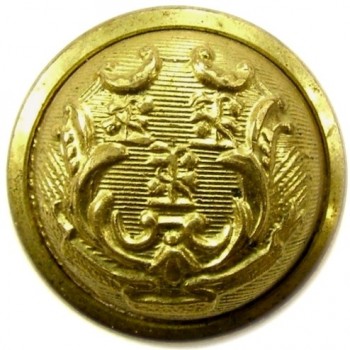

1845-60 Connecticut State Militia Officer’s Staff Button
Color: A Deep Gold.
Metal: 3-Piece, High Convex, Raised Design, Gilt Brass.
Size: 15mm. Cuff Size
Albert’s Number: CT12: RV 5-10
Tice’s Number: CT 200-AS.1
Variation: Connecticut’s Coat of Arms / Three Grape Vines / Decorative Ribbon Below.
Present Condition: A Non Excavated Example, Exceptional Planchet Condition, An Exceptional High Relief Pattern.
Isabela’s Notes: This staff button was commonly used by officers in Connecticut regiments during the Civil War. Scovill first produced this pattern in 1845, then stopped in 1860. The button’s pattern depicts Connecticut’s Coat of Arms with Three Grape Vines evenly spaced in the center of a decorative flowing scroll pattern. There is a Decorative Ribbon Below. The high relief pattern is set on a high convex lined field with a plain over lapping edge border.
Reverse Button Analysis: This is a three-piece button with a loop shank. The shank is original, straight, and intact. CANFIELD.BRO&CO. BAL. inner ring dm
The Picture is Courteous of H. Ridgeway.
1850’s-60’s Connecticut State Militia General Use
Color: Gold W/ Black Dirt.
Metal: 2-Piece, Convex, Raised Design, Gilt Brass.
Size: 14.6mm. Hat or Cuff Size.
Albert’s Number: CT 13: Unlisted Size Variant
Tice’s Number: CT 205-As.1
Variation: Three sets of Grapevines /4 Grapes /Sig. Reip Connect.
Present Condition: A Non Excavated Specimen, Strong Planchet Condition, A Strong High Relief Pattern Remains.
Isabela’s Notes: This cuff variant was made by Scovill in 1860, but the pattern dates back to the 1850’s to outfit the active militia. This button’s pattern depicts Connecticut’s State Coat of Arms of Three sets of Grapevines on an elliptical field. There are 4 Grapes from each vine. The grapevines symbolizes the original community of Puritan believers that were transplanted from the old world and replanted into the new fertile grounds of America. Circling around the Coat of Arms in a channel is the abbreviated Latin Phrase, “Sig. Reip Connect” which loosely translates to Seal of the Republic of Connecticut. On each side of the button in the legend is a Waving Flag. On the left there is a branch of Oak Leaves merging from the back of the flag, on the left is some kind of flowing tassels. The high relief pattern is set on an evenly lined field with a thin edge trim.
Reverse Button Analysis: This is a two-piece button with a loop shank. The shank is original, straight, and intact. CANFIELD. BRO & CO. / BAL. dm with inner stipple ring, backmark was used for small buttons only, Scovill produced in 1860, and thought to be mis-backed! Canfield 13 small.
1850’s-60’s Connecticut State Militia General Use
Color: Bright Gold.
Metal: 2-Piece, Convex, Raised Design, Gilt Brass.
Size: 22.80mm. Coat Size.
Albert’s Number: CT 13: RV 5
Tice’s Number: CT 205-B.3
Variation: 4 Large Grapes / Three 5 Point American Stars /American 13 Star Flag / 3 Stars in bottom Legend.
Present Condition: A Non Excavated Specimen, Strong Planchet Condition, An Exceptional High Relief Pattern Remains.
Isabela’s Notes: These buttons were first made for Connecticut’s active militia around 1850, and the pattern was continued on and used extensively during the Civil War by enlisted men. These buttons are great for collectors because they carry some unusual backmarks that span over key years. There appears to be a few variant difference by the makers. These differences include stars, flags, knots that bind branches, and size of the grapes. This button’s pattern depicts Connecticut’s state Coat of Arms of Three sets of Grapevines on an elliptical field. There are 4 Large Grapes from each vine with the addition of Three 5 Pointed American Stars. The grapevines symbolizes the original community of Puritan believers that were transplanted from the old world and replanted into the new fertile grounds of America. The Stars show the unity of the State and the Federal Government. In a horseshoe shape Banner Ribbon is the abbreviated motto, “Qui Transt Sust” in capital letters. This means “He who has transplanted continues to sustain.” Circling around the Coat of Arms in a channel is another Latin Phrase, “Sigillum Reipublice * Connecticutensis * which loosely translates to Seal of the Republic of Connecticut. In the legend on the left appears to be an American 13 Star Flag. In the right legend there is another American Flag mid point with Oak Leaves going toward the top. There appears to be 3 more American 5 Point Stars in the bottom legend in a chevron V shape. The high relief pattern is set on an evenly lined field with a thin edge trim.
Reverse Button Analysis: This is a two-piece button with a loop shank. The shank is original, straight, and intact. EXTRA + * + QUALITY + * + ” dm, inner ring of stipples, believed to be Waterbury Button Co, and a transitional backmark, Extra Q11.
1860’s Connecticut’s Hartford City Guard
Color: Gold with Copper Highlights.
Metal: 3-Piece, High Convex, Raised Design, Gilt Brass.
Size: 22.00mm. Coat Size.
Albert’s Number: CT 23: RV 5
Tice’s Number: CT 256-A.4
Variation: Antlered Stag / Fording A Stream / Olive Wreath / Hartford City Guard / HCG.
Present Condition: A Non Excavated Specimen, A Strong Planchet Condition, An Strong High Relief Pattern Remains.
Isabela’s Notes: These buttons were made for the City Guard in the 1860’s. In 1861, the city Guard was recognized as Artillery Company A, or the Hartford City Guard, under Captain Charles H. Prentice. In 1863, Connecticut changed it’s designation to an infantry unit. In 1865, it was changed again to Battery D, Light Infantry Unit part of the 3rd Regt. The City Guard was Hartford’s crack unit, and many former members went to the south CT Vol. regt. There is only one pattern known for coat and one for cuff. All these buttons were made in the early 1860s. The button’s pattern depicts an Antlered Stag facing right Fording A Stream. Below is an Olive Wreath in a semicircle around the legend. In the legend above is the initials for Hartford City Guard, “HCG” in large block letters. The high relief pattern is set on a high convex evenly lined field with a wide flat edge.
Reverse Button Analysis: This is a two-piece button with a loop shank. The shank is original, straight, and intact. SCOVILL MFG CO. / WATERBURY dm inside two rings of dots.
1850’s Connecticut’s New Haven Grays
Color: Brown Flecked Gold.
Metal: 2-Piece, Convex, Raised Design, Gilt Brass.
Size: 23mm. Coat Size
Albert’s Number: CT 27-A: RV 12
Tice’s Number: CT 265-A.1
Variation: Connecticut’s Coat of Arms / Old English Letters / Seven Scroll Decorative Border.
Present Condition: A Non Excavated Specimen, Strong Planchet Condition, A Good High Relief Pattern Remains.
Isabela’s Notes: Tice notes in his book that the Waterbury button company made these to supplant CTO 26. The button’s pattern depicts the Connecticut State Arms of Three Grape Vines in the center of Seven Scroll Decorative border. Old English Initials “N H G” above. The high relief pattern is set on an evenly lined field with a raised edge border with an outside Rope Trim.
Reverse Button Analysis: This is a three-piece button with a loop shank. The shank is original, straight, and intact. . WATERBURY . SPUR W.B.Co. SPUR rmdc.
*
Florida’s Militia Units
Florida is a peninsula state in the southeastern region of the United States. It is bordered between the Gulf of Mexico, and the Atlantic Ocean. To it’s northern borders is the states of Alabama and Georgia. Florida was given it’s name by the Spaniard Juan Ponce De Leon in 1513. The name means, Feast of Flowers. Saint Augustine established the first permanent European settlement in 1565. In 1821, Spain reached an agreement and transferred ownership to the United States. This transfer of ownership was immediately followed by the Seminole Indian War. This battle didn’t end well for the native American Indians and they were relocated by the US Army to Oklahoma. In 1845, Florida was admitted to the Union as the 27th state, and adopted a seal showing a map of the state. Florida’s militia used buttons bearing the territorial seal consisting of an Eagle with Down Swept Wings. In the eagle’s left talon is a laurel branch, and in it’s right claw is a small bundle of three arrows. The eagle is situated above cacti, and there are 13 Six-Pointed Stars arched above encircling the eagle. In 1861, Florida was the third state to secede from the union and join the Confederacy; but Florida did not produced buttons during the Civil War.
1840-50’s Florida’s State Militia
Color: A Deep Gold.
Metal: 2-Piece, Convex, Raised Design, Gilt Brass.
Size: 20mm. Coat Size
Albert’s Number: FL1: RV 50
Tice’s Number: FL 200-A.2
Variation: Spread Wing Eagle Facing Right / 13 Five-Pointed American Stars / Cacti underneath.
Present Condition: A Non Excavated Specimen, Strong Planchet Condition, An Exceptional High Relief Pattern Remains.
Isabela’s Notes: This button was made for Florida’s militia units during the 1840’s and 1850’s. This 2-piece button uses the unofficial Florida Territorial Seal on a lined field. The button depicts a Spread Wing Eagle facing right. In the eagles left talon is a multi-stem Olive Branch, and in it’s right is a small Bundle of Three Arrows. There are 13 Five-Pointed American Stars arched 3/4 away around the eagle, and a Cacti underneath. The high relief pattern is set on an evenly lined convex field with a thin flat raised edge. Collectors usually prize these Florida state’s militia buttons, and command a premium. The small sizes are exceedingly rare.
Reverse Button Analysis: This is a two-piece button with a loop shank. The shank is original, straight, and intact. .SCOVILL MFG CO.. SUPERFINE.. rmdc within a channel diagonal bar of backmark “N” is reversed. Scovills 450.
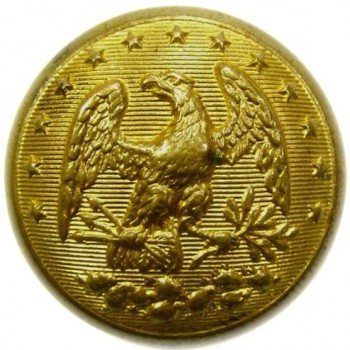

1840-50’s Florida’s State Militia
Color: A Deep Gold.
Metal: 2-Piece, Convex, Raised Design, Gilt Brass.
Size: 20mm. Coat Size
Albert’s Number: FL1: RV 50
Tice’s Number: FL 200-A.4
Variation: Spread Wing Eagle Facing Right / 13 Five-Pointed Stars / Cacti Underneath.
Present Condition: A Non Excavated Example, Exceptional Planchet Condition, An Exceptional High Relief Pattern Remains.
Isabela’s Notes: This early 2-piece button uses the unofficial Florida territorial seal on a lined field. The button depicts a Spread Wing Eagle Facing Right. In the eagles left talon is a multi-stem Olive Branch, and in it’s right is a small Bundle of Three Arrows. There are 13 Five-Pointed American Stars arched 3/4 away around the eagle, and a Cacti Underneath. The high relief pattern is set on an evenly lined convex field with a thin flat raised edge. Collectors usually prize this Florida state’s militia buttons, and command a premium. The small sizes are exceedingly rare.
Reverse Button Analysis: This is a two-piece button with a loop shank. The shank is original, straight, and intact. .SCOVILL MFG CO.WATERBURY. rmdc.
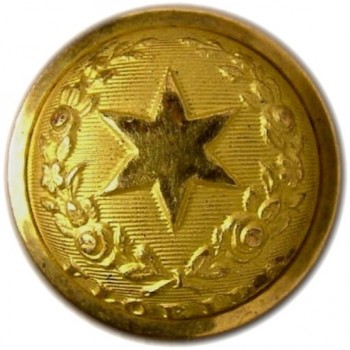
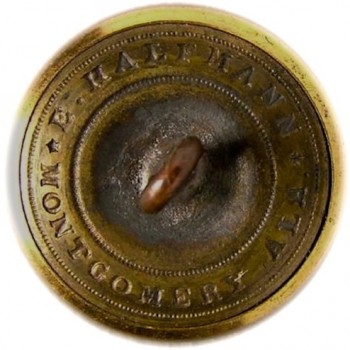
1860’s Florida’s State Militia
Color: Florida Gold.
Metal: 3-Piece, Low-Convex, Raised Design, Gilded Brass.
Size: 22.3mm. Coat Size
Albert’s Number: FL 2: RV 150
Tice’s Number: FL 205-A.1
Variation: Raised Six-Pointed Star/ Cherokee Rose Wreath / Florida.
Present Condition: A Non Excavated Example, Exceptional Planchet Condition, An Exceptional High Relief Pattern Remains.
Isabela’s Notes: In 1860, the legislature asked the Governor to find a new suitable pattern for the state’s militia buttons. He chose the Cherokee Rose design. Before the Civil War, the Florida Militia was mostly posted around the Panhandle region. This area was an extension of the Gulf Coast economic power region of Mobile Alabama and New Orleans. The button’s pattern depicts a raised Six-Pointed Star in the center of a Cherokee Rose Wreath. The states name, “FLORIDA” is in roman font capital letters below. The whole pattern is set on a low convex lined field with a false 3-piece rim. Scovill made these around 1860, for a military contractor Ethlebert. Halfmann of Montgomery Alabama. There are only a few specimens known which makes this button not only a true rarity, but a costly one for southern state button collectors.
Reverse Button Analysis: This is a three-piece button with a loop shank. The shank is original, straight, and intact. E. HALFMANN/ * MONTGOMERY ALA. * dm between two rings of dots.

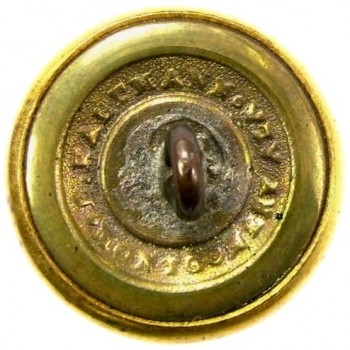
1860’s Florida’s State Militia
Color: A Spotted Gold.
Metal: 2-Piece, High Convex, Raised Design, Gilt Brass.
Size: 20.6mm. Coat Size
Albert’s Number: FL3: RV 150
Tice’s Number: FL 210-A.1
Variation: Six-Pointed Star / Cherokee Rose Wreath / No Edge Border.
Present Condition: A Non Excavated Example, Exceptional Planchet Condition, An Exceptional High Relief Pattern Remains.
Isabela’s Notes: This button was also produced by Scovills around 1860 for Ethlebert Halfmann. Unlike the officer’s die variant, this pattern was made without the 3-piece border to distinguish the enlisted men. The button’s pattern depicts a raised Six-Pointed Star with a Pebbled Surface. The star is situated in the center of a decorative Cherokee Rose Wreath. The state’s name, “FLORIDA“ is written below in large Roman font capital letters. The pattern is set on a plain convex field with no edge rim. As with the officer’s die variant, this is rare and costly for southern state button colectors.
Reverse Button Analysis: This is a two-piece button with a loop shank. The shank is intact, but professionally re-soldered. E.HALFMANN/ .MONTGOMERY ALA. rmdc on a stippled field.
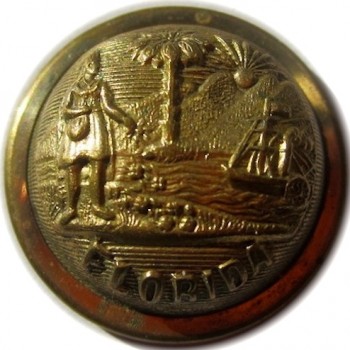
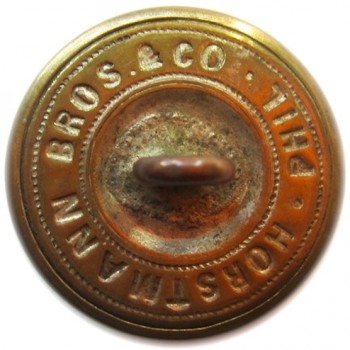
1868-1880’s Florida’s State Militia
Color: A Golden Brass Yellow.
Metal: 3-Piece, High Convex, Raised Design, Gilt Brass.
Size: 23mm. Coat Size
Albert’s Number: Similar to FL 04: RV 5
Tice’s Number: Unlisted Variant
Variation: Florida State Seal / Coca Tree is Higher / Sun’s Ray Almost Touch Rim.
Present Condition: A Non Excavated Example, Exceptional Planchet Condition, An Exceptional High Relief Pattern Remains.
Isabela’s Notes: There are 3 or 4 die variants made for this pattern. The main difference is the position of the Sun and Coca tree to the edge, and the F & A’s letter position to the lower border. The button’s patten depicts the Florida State Seal of an Indian on shore with a Steamboat on the river. There is a Coca Tree across the river with a Sun Rising over the Mountains. In this die variant, the Coca Tree and Sun is Higher and almost touch the button’s rim. The states name, FLORIDA is below in raised capital letters below.
Reverse Button Analysis: This is a three-piece button with a soldered on loop shank within a well. The shank is original, straight, and intact. HORSTMAN BROS. & CO/ PHIL. within a stipple channel.
The RJ Silverstein collection.
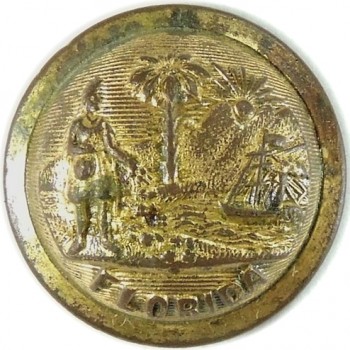
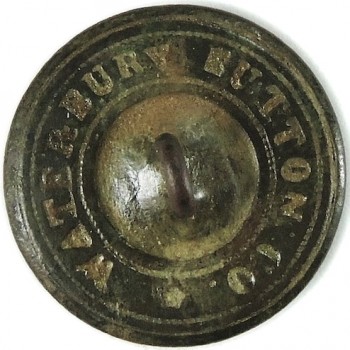
1880’s Florida’s State Militia
Color: A Golden Brown.
Metal: 3-Piece, High Convex, Raised Design, Gilt Brass.
Size: 23mm. Coat Size
Albert’s Number: FL 04: RV 1
Tice’s Number: Unlisted
Tice’s Number: Unlisted Variant
Variation: Florida State Seal / Coca Tree is Lower / Sun’s Rays are Short.
Present Condition: An Excavated Example, Good Planchet Condition, An Strong High Relief Pattern Remains.
Isabela’s Notes: There are 3 or 4 known die variants for this pattern. The main difference is the position of the Sun and Coca tree to the buttons rim, and the Florida’s F & A’s letter position in relation to the lower rim. The button’s pattern depicts the Florida State Seal of an Indian on shore with a Steamboat on the river. There is a Coca Tree across the river with a Sun Rising over the Mountains. In this die variant, the Coca Tree is Lower, and the Sun’s Rays are Short. The states name, FLORIDA is below in raised capital letters. In this die variant, the F & A letters in Florida almost touch the rim.
Reverse Button Analysis: This is a three-piece button with a loop shank. The shank is original, straight, and intact. WATERBURY BUTTON CO. * in-between a stipple channel.
*
Georgia Militia Units
Georgia is located in the southeastern part of the United States. It is bordered by Florida in the south, South Carolina & Atlantic Ocean in the East. To the west is Alabama, and it’s northern borders brinks upon North Carolina and Tennessee. Georgia was the last of the original 13 colonies to be established in 1732, and was the 4th state to join the Union on January 2, 1788. It was named after King George II, who charted the region to James Oglethorpe who established a settlement in Savannah in 1733. Originally it was created to be a buffer between the British colonies to the north, and the Spanish territory of Florida in the south. Between 1770-1840, settlers from Virginia and the Carolinas began to colonize the interior of the state and force the Creek and Cherokee Indians out of their lands. In 1861, Georgia joined the Confederacy, and was the 5th state to secede from the union. In 1799, the Georgia legislature adopted a State Seal, or Coat of Arms depicting Three Classical Pillars supporting an Arch bearing the word, “Constitution”. The design symbolizes the three branches of government; Legislative, Judicial, and Executive supporting the ratified Constitution. Wrapped within the pillars is a banner inscribed with the words, “Wisdom, Justice, and Moderation.” On the side of one of the pillars is a Minuteman with a Drawn Sword symbolizing the defense of the constitution by state military forces. There are a large number of manufacturers and die variants for Georgia buttons, which makes these buttons great for collectors.

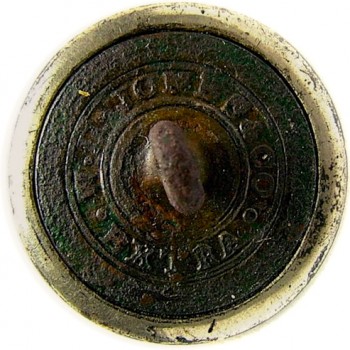
1830-50’s Republican Blues, Savannah Georgia
Color: A Two-Tone Silver.
Metal: 2-piece, Low-Convex, Raised Design, Silver Plated Copper.
Size: 21mm. Coat Size
Albert’s Number: GA 23: RV 50
Tice’s Number: GA 261-B.1
Variation: American Spread Eagle Facing Right / Short Stout Neck / Federal Lined Shield / Republican Blues.
Present Condition: An Excavated Specimen, Strong Planchet Condition, A Strong High Relief Pattern Remains.
Robert’s Notes: There are four known die variants for this pattern. One facing right with a long neck, one facing right with a short stout neck. One facing left looking toward the three o’clock position, and one looking left toward the one o’clock position. Various Northern manufacturers made this button from 1830’s through the 1850’s. All are known to be silver plated. This particular back mark dates in-between 1835-40. The button’s pattern uses the same early 1821-40 Federal Infantry & Artillery pattern of an American Spread Eagle Facing Right. This die variant depicts an eagle with a Short Stout Neck. In the eagle’s right talon is an olive branch, and in it’s right talon is a bundle of three arrows. On the eagle’s chest is a Federal Lined Shield with the initials, “R B” for Republican Blues. The high relief pattern is set on a low-convex lined field with a slightly raised thin edge. The Savannah Blues formed in 1808 by socially prominent men. This would be your typical example of how a militia unit turned from a military objective of protection to a ceremonial parade military organization as the years went by. During the Civil War, the Blues served within the 1st Volunteer Georgia Infantry. Most specimens known are excavated.
Reverse Button Analysis: This is a two-piece button with a loop shank. The shank is original, straight, and intact. rmdc .W.H. JONES &CO. EXTRA within depressed channel.
Excavated by Rocky Sommers in Savannah Georgia.~
The R. Sommers Collection.
1860’s Republican Blues, Savannah Georgia
Color: A Coppery-Red.
Metal: 2-piece, Low-Convex, Raised Design, Gilt Brass.
Size: 23mm. Coat Size
Albert’s Number: PA 40 : RV 50
Tice’s Number: GA 264-A.1
Variation: American Spread Eagle Facing Right / Short Stout Neck / Federal Lined Shield / Republican Blues.
Present Condition: An Excavated Specimen, Good Planchet Condition, A Good High Relief Pattern Remains.
Robert’s Notes: This button was made by Steele and Johnson in 1860’s and was thought to be button’s of the Pennsylvania Reserve Brigade. In my own investigation i found that Horstmann had a way of earmarking buttons to southern states. They would backmark their buttons with an inner ring of rays circumventing union laws of furnishing southern wartime trade. The button’s pattern depicts a curious font for an Old English Monogram for Republican Blues, “R B” in the center. This is surrounded by a Wreath of Oak and Laurel Leaves. The high relief pattern is set on an evenly lined field. Usually local buttons had uneven lined fields, unless British manufacturing.
Reverse Button Analysis: This is a two-piece button with a loop shank. The shank is original, straight, and intact. HORSTMANNN & ALLIEN / inner ring of lines dm.
Dug near Savannah Georgia.~
The RJ Silverstein Collection.

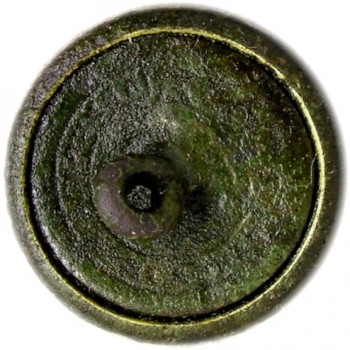
1840’s Irish Jasper Greens, Savannah Georgia
Color: A Golden Green.
Metal: 2-Piece, Low-Convex, Raised Design, Gilt Brass.
Size: 22mm. Coat Size
Albert’s Number: GA 18-A.1: RV 50
Tice’s Number: GA 256-B.1
Variation: Spread Wing Eagle Facing Right / Large Decorative Harp / Irish Jasper Greens.
Present Condition: An Excavated Specimen, Strong Planchet Condition, A Strong High Relief Pattern Remains.
Robert’s Notes: This button was made by three manufacturers with only a slight change in the depiction of the Harp and Eagle. This button depicts a Spread Wing Eagle Facing Right, while perched on top of a Large Decorative Harp. The initials for Irish Jasper Greens, “I J G” is arched above. The pattern is set upon a plain low-convex field eith no raised edge border. The Irish Jasper Greens was formed in Savannah Georgia in 1842, and designated Company A, 1st Volunteer Regiment of Georgia. The company’s name was taken from William Jasper who was an American Revolutionary War Hero born in South Carolina. During the battle of Fort Sullivan, Jasper replaced the fort’s fallen flag while under heavy fire from a British Naval squadron. All the members of this company are citizens of Savannah, and Irish. Most of these examples have been dug in the costal areas of Georgia and South Carolina. Silver plated non-excavated examples are extremely rare.
Reverse Button Analysis: This is a two-piece button with a loop shank. The shank is original, and intact, but slightly bent. BENEDICT & BURNHAM on a ribbon with an eagle.
Excavated in Savannah Georgia.~
The Picture is Courteous of H. Ridgeway
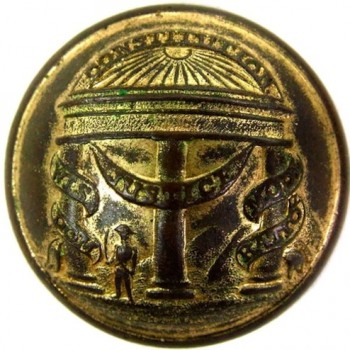
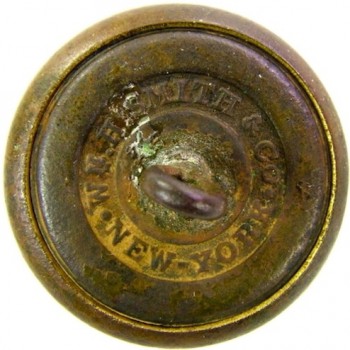
1856-61 Georgia State Militia
Color: A Golden Brown.
Metal: 2-Piece, Convex, Raised Design, Gilt Brass.
Size: 24mm. Coat Size
Albert’s Number: GA 1-A.2: RV 10
Tice’s Number: GA 200-A.4
Variation: Georgia State Coat of Arms / Period After the Word Constitution / Wisdom, Justice, and Moderation
Present Condition: An Excavated Specimen, Strong Planchet Condition, A Strong High Relief Pattern Remains.
Isabela’s Notes: There seems to be a little bit of conjecture on dating this button. Some button enthusiasts say it goes back to the early 1840’s, and Tice inaccurately labeled it 1850’s in his book. Whichever, we know it use dates prior to the Civil War. There appears to be two variants noted for this early button pattern. One with a period after the word Constitution, and without a period. This button’s pattern depicts the Georgia State Coat of Arms which is Three Classical Pillars supporting an Arch bearing the word Constitution above. In this variant there is a Period After the Word Constitution. The pattern symbolizes the judicial, legislative, and executive departments of government in support of the constitution. There is a free flowing ribbon around each of the pillars that are inscribed, “Wisdom, Justice, and Moderation.” This high relief pattern is set on a plain convex field with a thin edge border. This has always been a southern confederate button collectors favorite. Manufacturer signature back marks are much scarcer then blank locals.
Reverse Button Analysis: This is a two-piece button with a loop shank. The shank is original, straight, and intact. rmdc .WmH.SMITH&CO. NEW-YORK within a stippled depressed channel. This back mark seems to date to 1840’s according to Tice. Some back marks appear to have a raised area around the shank, this most likely is not a die variant, but caused during assembly. Some other examples of this back mark have a weak dash between New and York, this most likely is caused by either grime or die fatigue.
Possible excavated in Virginia, but unconfirmed.~
The RJ Silverstein Collection.
Georgia’s Artillery Units
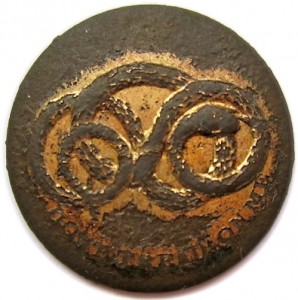
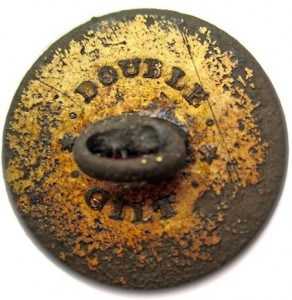
1810-20’s State of Georgia Chatham Artillery – Celtic Infinity Not Scottish?
Color: An Ochre Pigment of Brown Shades with Golden Highlights.
Metal: Flat, 1-Piece, Raised Design, Double Gilt Brass.
Size: 21mm. Coat Size
Albert’s Number: NA 1-Incorrectly Identified as Continental Navy
Tice’s Number: GA 110-A.2
Variation: Large Coiled Hissing Snake / Don’t Tread On Me / Head Points Toward Three O’clock.
Present Condition: An Excavated Specimen, A Strong Planchet Condition, A Strong High Relief Pattern Remains.
Isabela’s Notes: There appears to be three known die variants for this button. The notable difference is where the snakes head is depicted. One the snakes body near the head touches the coil, and the head points toward three o’clock. In the second, The snakes body near the head does not touch the coil, and the head points to 2:30. In the third, the snakes body near the head touches the body, and the head points toward the two o’clock position. The first variant with the double gilt back mark is the rarest or the three, and un-dug specimens in any variation are extremely rare. This button’s pattern depicts a Large Coiled Hissing Snake above the motto, “DON’T TREAD ON ME” . The motto appears to be in large Roman Font Capital letters. This variant depicts the snakes body near the head touching the coil, and the Head Points Toward Three O’clock. The high relief pattern is set on a plain flat field with no raised edge border. This artillery company traces it roots back to the 1st battalion, 118 field artillery, which organized on April 18, 1751. This was originally formed as a Georgia Militia unit in the district of Savannah. It consisted of four independent volunteer companies, three of foot, and one of horse. In 1778, the British military planners decided to embark on a southern strategy to conquer all the rebellious colonies with the support of their loyalist supporters in the southern states. Their first step was to gain control of the southern ports of Savannah Georgia, and Charleston, South Carolina. In December, the British took Savannah as an easy conquest. There was only moderate resistance from the in-effective Georgia Militia, and Continental Army defenses. With survivors from this encounter, the Georgia militia disbanded for almost two years, and then reformed and joined the Continental Army using the common pewter enlisted man’s U.S.A. pattern buttons. Officially, they were re-designated as the Chatham Artillery in 1786 under Captain Edward Lloyd. There first documented duty was the funeral honors of Revolutionary War General Nathanael Greene in June of 1786. This company was also instrumental for George Washington in the Oconee Wars of 1789 to 1793. In 1792 George Washington showed his appreciation for their gallant services, and presented them with 2 cannons. One of which was captured at Yorktown, and the other was from France. This button has become a real collector’s favorites, and usually demands a premium.
Reverse Button Analysis: This is a one-piece button with a loop shank, The shank is original, but very slightly bent. There is the rare “Double Gilt” raised back mark with two Six Pointed Stars with Four Dots in-between in high relief.
Excavated in around Savannah Georgia.~
The RJ Silverstein Collection.
Robert’s Notes: This button has been mistakenly identified by A. Albert (NA 1), and others as the first Continental Navy Dress Uniform Button. Records of that button show the pattern to be impressed, not in High Relief as the example above. Also, the Navy buttons with the Rattlesnake Don’t Tread On Me have never been recovered to date. Even though the Chatham Artillery Militia unit (AKA Georgia Militia Savannah District) dates back to fighting in Revolutionary War, the back mark on the button example above most likely dates anywhere from 25 to 50 years after.~
Louisiana’s Milita Infantry Units
Louisiana is located in the southern region of the United States. Louisiana is bordered by Arkansas to the north, Mississippi to the east, Texas to the west, and the Gulf of Mexico to the south. Most of state’s lands were formed over the centuries from sediment that washed down the Mississippi River created left enormous deltas and vast areas of coastal marshes and swamps. Louisiana’s capital is Baton Rouge, and it’s largest city is New Orleans. Louisiana was the 18th state to join the Union on April 30th, 1812. It is the only state in the U.S. with political subdivisions termed “Parishes.” These are what most states call their local government counties.
The first European explorers to visit Louisiana came in 1528, by a Spanish expedition led by Panfilo de Narvaez found the mouth of the Mississippi River. In 1542-43, Hernando de Soto was the first to travel down the Mississippi River all the way down to the gulf of Mexico. Spanish interest in Louisiana slowly faded away for more then 50 years. Then in 1682, a French explorer Robert Cavelier named a tract of land along the lower Mississippi River “Louisiana” to honor France’s King Louis XIV. Then seventeen years later in 1699, a French military officer from Canada, Pierre Le Moyne d’Iberville founded the first permanent settlement called,“Fort Maurepas” which is now called Ocean Springs, LA. By the late 17th Century, France and French Canadians established footholds all along the Mississippi River and Gulf Coast. There aim was to lay claim to the vast regions of North American land in order to establish a commercial empire that would stretch all the way down from Canada to the Gulf of Mexico. French Acadians were known as Cajuns, and they settled in the swamps of southern Louisiana. In 1720’s German immigrants settled along the Mississippi River in a region and was referred to as the German Coast. In 1722, France made New Orleans the seat of civilian and military authority south of the Great Lakes. Until the Louisiana purchase, France and Spain continually jockeyed for control over New Orleans and all the lands west of the Mississippi. Spain controlled most of Louisiana’s land outside of New Orleans by the Treaty of Fontainebleau. By 1763, France ceded most of its territory to the east of the Mississippi to Great Britain in the aftermath of Britain’s victory in the Seven Years’ War.
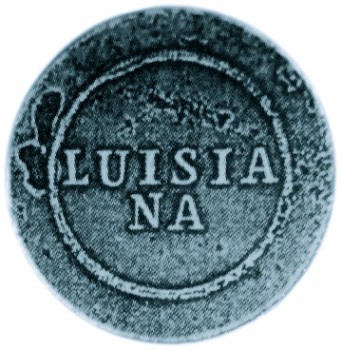
In the late 18th Century, the Spanish raised a regular infantry unit called, “Regimiento de Infanteria de Luisiana” for service in Louisiana and Florida. Before 1795, Spanish units wore crude unmarked plain buttons that were made by a “Wax” process which had large wedge shanks. A Royal decree in 1795, ordered that marked buttons be issued to all military units. Provincial soldiers were slow to convert to the new regulations. Since France gained control of the Louisiana Spanish colony by 1800, so the bulk of the “LUISIA NA” buttons were most likely used in Florida until 1821. By the 1850s, Louisiana state law required all parishes to support a regiment of local militia. Unfortunately by 1860, only a few companies were ready to go to war if called upon. New Orleans had several regiments of various ethnic groups trained and uniformed for combat. They had one Brigade of English speaking Militia which consisted of wealthy Washington Artillery, and two other regiments. One Brigade named the Louisiana Legion contained the creole Battalion and a German staffed Light infantry Regt.. By the spring of 1862, Louisiana had raised 23 regt. and about 10 Battalions of Infantry soldiers plus a single regiment of both Cavalry and Artillery. When the Civil War broke out Louisiana became a Confederate state, and the city of New Orleans fell to U.S. Admiral David G. Farragut. This was a harsh blow to the Confederate Army.
Governor William Claiborne chose a Pelican for Louisiana’s State Seal around 1812-15. The Pelican is a native bird to the state of Louisiana. The seal depicts a Pelican injuring it’s breast in order to provide blood to nourish its young. This represents the Christian symbolism in which the Pelican embodies Christ’s blood and is given in a sacrificial act for man’s salvation. Towards the end of the Civil War the governor of the Confederate part of Louisiana used a Pelican seal with its head turned towards its left, with many nestlings. The Pro-Union governor used a seal with the birds head turned towards the right with only four nestlings.
The scientific name of the American White Pelican is Pelecanus erythrorhynchos. Pelecanus is Latin for pelican, and erythrorhynchos is derived from the Greek words erythros meaning “red” and rhynchos meaning “beak.”
1860 Louisiana State Milita
Northern Manufacturer
Color: A Golden Brass Yellow.
Metal: Convex, 2-Piece, Raised Design, Gilt Brass.
Size: 21.8mm. Coat Size.
Albert’s Number: LA 2-A.1
Tice’s Number: LA 203-A.1
Variation: Pelican’s Head Turned Right / Thinner Wings / Small Nest / Lined Field / Rope Border.
Present Condition: A Non Excavated Specimen, A Strong Planchet Condition, An Exceptional High Relief Pattern Remains.
Robert’s Notes: This button was intended for Louisiana Militia units. The button was made by Scovills prior to the Civil War in 1860. There are 3 known backmarks and one 18mm cuff size that is extremely rare. Collectors rarely see the Hyde & Goodrich N.O. rmdc backmark. The button’s pattern depicts the State of Louisiana’s Pelican facing to the right. It is in the act of piecing it’s own breast to feed it’s hatchlings. The Pelican in this die variant has thinner wings. The 4 Hungry Hatchlings are facing upwards to accept mothers food. In this die variant the hatchlings are in a smaller nest. The high relief pattern is set on an evenly lined field with a raised concentric ring around the border. There outside edge has a Rope Trim.
Reverse Button Analysis: This is a two-piece button with a loop shank. The shank is original, straight, and intact. *** EXTRA *** dm within a 2 stipple rings. Scovill M340
1860 Louisiana State Militia Infantry
Northern Manufacturer
Color: Brass Orange.
Metal: Convex, 2-Piece, Raised Design, Gilt Brass.
Size: 22.01mm. Coat Size.
Albert’s Number: LA 2-A.2
Tice’s Number: LA 203-A.3
Variation: Pelican’s Head Turned Right / Pronounced Wings & Nest /The Hatchlings & Nest is more Defined.
Present Condition: A Non Excavated Specimen, An Exceptional Planchet Condition, An Exceptional High Relief Pattern Remains.
Robert’s Notes: This button was intended for Louisiana Militia units. The button was made by Scovills prior to the Civil War in 1860. This is the 2nd known backmark. The button’s pattern depicts the State of Louisiana’s Pelican facing to the right. It is in the act of piecing it’s own breast to feed it’s hatchlings. The Pelican in this die variant has more pronounced wings. The 4 Hungry Hatchlings are facing upwards to accept mothers food. In this button variant, the hatchlings are more defined in detail, as well as the nest. The high relief pattern is set on an evenly lined convex field with a high relief edge border. There is a rope trim around the button’s edge.
Reverse Button Analysis: This is a two-piece button with a loop shank. The shank is original, straight, and intact. *** EXTRA *** dm within a 2 stipple rings.
1860 Louisiana State Milita Infantry
Northern Manufacturer
Color: Brass Yellow W/ Brownish Highlights .
Metal: Convex, 2-Piece, Raised Design, Gilt Brass.
Size: 22mm. Coat Size
Albert’s Number: LA 3-A
Tice’s Number: LA 204 A.2
Variation: New Orleans / State of Louisiana / 4 Hungry Hatchlings Less Detailed Nest.
Present Condition: A Non Excavated Plate Specimen, A Strong Planchet Condition Remains, A Strong High Relief Pattern Remains.
Robert’s Notes: This button was made for Louisiana Militia as a general use button. Thought to be made just prior to the Civil War. Scovills made these in the beginning of 1860 for Hyde & Goodrich who was a New Orlean’s outfitter. The Scovill MFG backmark is less common to find on the market then the Hyde & Goodrich backmarks. Most collectors seem to desire the “New Orleans” backmarks from Hyde & Goodrich. The button’s pattern depicts the State of Louisiana’s Pelican facing to the right. It is in the act of piecing it’s own breast to feed it’s hatchlings. The 4 Hungry Hatchlings are facing upwards to accept mothers food. The hatchlings are in a Less Detailed Nest. The high relief pattern is set on an evenly lined convex field with a thin raised edge. This variant does not have the rope edge border.
Reverse Button Analysis: This is a two-piece button with a loop shank. The shank is original, straight, and intact. HYDE & GOODRICH II . NEW ORLEANS . dm with an inner stipple ring.
The RJ Silverstein Collection.
1860 Louisiana State Milita Infantry
Northern Manufacturer
Color: A Silvery Green.
Metal: Convex, 2-Piece, Raised Design, Gilt Brass.
Size: 13.8mm. Cuff Size.
Albert’s Number: LA 3-As
Tice’s Number: LA 204 As.2
Variation: State of Louisiana Pelican /4 Hungry Hatchlings / Pronounced & Thicker Wings / Large Strand Nest.
Present Condition: An Excavated Specimen, A Fair Planchet Condition, A Fair High Relief Pattern Remains.
Robert’s Notes: The button was produced before the Civil War for Louisiana’s Militia Units. This was manufactured by Scovill for Hyde & Goodrich. This backmark is the only used for the cuff size buttons. The button’s pattern depicts the State of Louisiana’s Pelican facing to the right. It is in the act of piecing it’s own breast to feed it’s hatchlings. In this die variant the Pelican has more pronounced and thicker wings. There are 4 hatchlings facing upwards in a Large Strand Nest. The hatchlings are in a more pronounced nest in this variant. The high relief pattern is set on an evenly lined convex field with a thin raised plain edge.
Reverse Button Analysis: This is a two-piece button with a loop shank. The shank is original, straight, and intact. HYDE & GOODRICH N-O dm. Hyde 05, small
Dug in Centerville Virginia.
Picture Courteous of Harry Ridgeway.
1860 Louisiana State Milita Infantry
Northern Manufacturer
Color: A Speckled Brass White .
Metal: Convex, 2-Piece, Raised Design, Gilt Brass.
Size: 20.05mm. Coat Size.
Albert’s Number: LA 04
Tice’s Number: LA 210-A.1
Variation: State Of Louisiana / Nest is Not Detailed and Less Pronounced is Relief/ 4 Hungry Hatchlings.
Present Condition: An Excavated Specimen, A Strong Planchet Condition Remains, A Strong High Relief Pattern Remains.
Robert’s Notes: This was made by Scovills around 1860. This is one of the more scarce Louisiana Militia general use buttons. Collectors should note that non-dug specimens are the rarity, and Silver-Plated specimens as well as cuff specimens are rarely offered on the market. The button’s pattern depicts the State of Louisiana’s Pelican facing to the right. It is in the act of piecing it’s own breast to feed it’s hatchlings. The Pelican’s wings are less pronounced in this variant. The 4 Hungry Hatchlings are facing upwards to accept their mothers food. In this die variant the Nest is Not Detailed and Less Pronounced is Relief. The high relief pattern is set on a plain convex field with a plain edge.
Reverse Button Analysis: This is a two-piece button with a loop shank. The shank is original, straight, and intact. HYDE & GOODRICH. N-O rmdc.
1860 Louisiana State Milita
Northern Manufacturer
Color: Speckled Gold.
Metal: Convex, 2-Piece, Raised Design, Gilt Brass.
Size: 22.5mm. Coat Size.
Albert’s Number: LA 06
Tice’s Number: LA 220-A.6
Variation: State of Louisiana Pelican/ Right Wing Down Swept Profile/ 4 Hungry Hatchlings / Rope Edge Trim.
Present Condition: A Non Excavated Specimen, An Exceptional Planchet Condition, An Exceptional High Relief Pattern Remains.
Robert’s Notes: Scovills actually made these in the 1840’s-60 period. The button went unrecognized though prior to the Civil War. This button is reportedly the most commonly found examples dug at Civil War sites. The Shuyler H & G, Scovill MFG co Waterbury backmarks, and vest size are considered unusual. 14-15mm Cuff variants are very common. This button was made just prior to the Civil War in 1860. The button’s pattern depicts the State of Louisiana’s Pelican facing to the left. It is in the act of feed it’s hatchlings. The Pelican’s beak is pointing straight down to feed it’s hatchlings. The 4 Hungry Hatchlings are facing upwards to accept their mothers food. The Pelican’s Right Wing has a Down Swept profile. The high relief pattern is set on an evenly lined convex field with a high relief edge and rope trim.
Reverse Button Analysis: This is a two-piece button with a loop shank. The shank is original, straight, and intact. SCOVILL. MF’G. CO. / * WATERBURY. * dm between 2 rings of stipples. Scovill M 340.
1860 Louisiana State Milita, General Use
Confederate Local Manufacturer
Color: Gilt Brown.
Metal: Convex, 2-Piece, Raised Design, Gilt Brass.
Size: 21.42mm. Coat Size.
Albert’s Number: LA 08
Tice’s Number: LA 249-E.1
Variation: State of Louisiana / Pelican facing Right /4 Hungry Hatchlings /Nest is in Higher Relief.
Present Condition: An Excavated Specimen, A Fair Planchet Condition, A Good High Relief Pattern Remains.
Robert’s Notes: Charles Bellenot and Casimir Rouyer of New Orleans made these state militia buttons for Louisiana troops in the beginning of the Civil War. Compared to most other southern state arms buttons these are abundant in Non-Dug condition. Collectors usually seek Dug Specimens to guarantee use during the war. The button’s pattern depicts the State of Louisiana’s Pelican facing to the right. It is in the act of piecing it’s own breast to feed it’s hatchlings. The 4 Hungry Hatchlings are facing upwards to accept their mothers food. In this die variant the Nest is in Higher Relief. The high relief pattern is set on an evenly lined high convex field with a high channel edge.
Reverse Button Analysis: This is a two-piece button with a loop shank. The shank is original, straight, and intact. Blank, Southern made.
The RJ Silverstein Collection.
*
Massachusetts’s Militia Infantry Units
 1800-1825
1800-1825
Massachusetts State Militia
The official state title is, “The Commonwealth of Massachusetts,” or is simply referred to as, “The Commonwealth.” The early colonists took the name Massachusetts from the Algonquian Indian term, “Near the Great Hill,” or “By the Blue Hills”. Massachusetts is located in the New England region of the northeastern United States, and lies on the coast of the Atlantic Ocean. It is bordered by Rhode Island and Connecticut to the south, New York to the west, and Vermont and New Hampshire to the north. Massachusetts was originally formed from three distinct settlements. Plymouth near Cape Cod, Gloucester on Cape Ann, and Mass. Bay Colony around Boston. The first English settlers were known as Pilgrims, and they came to Plymouth, Massachusetts in 1620. They developed friendly relations with the native Wampanoag Indians, and this became the second successful permanent English colony in North America after Jamestown. In 1630, the Puritans soon followed and established the Massachusetts Bay colony. This is what we know in present day as Boston. Unlike the Plymouth colony, the Bay colony was founded under a Royal Charter by the Puritans. They were seeking religious freedom from the Church of England. In 1691, both the colonies (& Maine) were united into the Province of Massachusetts Bay. The new governor of the Province, Sir William Phips, is the one in which the Salem Witch Trials took place. This resulted in a number of men and women being hanged or burned. In the late 18th Century, Boston became known as the “Cradle of Liberty” because of the agitation of it’s colonists that led to the American Revolution, and the independence of United States from Great Britain. Later on in the Federal Period around 1780, John Adams who was known as, “The Atlas of Independence” wrote Massachusetts’s original Constitution. This was the first state to have a Constitution that declared the universal rights for it’s citizens. Also in 1780, Nathan Cushing designed the Massachusetts’s Coat of Arms. This depicts a standing Native American Indian holding a Bow in his left hand, and an Arrow in his right. There is a five-pointed North Star over his right shoulder which represents the dependent territory of Maine. The Commonwealth’s Latin motto, “Ense Petit Placidam sub Libertate Quietem,” means “This Hand the Rule of Tyrants to oppose, Seeks with the sword fair freedom’s soft repose,” This prompted the adoption of a Sword and Arm as the unofficial crest. Most of the Massachusetts Militia buttons depict either the Arm & Sword, or the Standing Indian. The earliest known use of a military button depicting an Arm and Sword would be Henry Jackson’s independent Boston Militia in 1776. Massachusetts was the 6th state to join the Union on February 6, 1788.
By the early part of the 19th Century, Massachusetts operated with a large number of undisciplined militia units who were ceremonial in nature. It wasn’t until 1840, the state started to re-organize all these rouge companies in order to create a more disciplined volunteer system. By 1851, they had integrated most of the independent companies into regiments and battalions. The companies who wouldn’t join and opposed the new reorganization soon disbanded.
Robert’s Notes: In 1820, Maine separated from The Commonwealth of Massachusetts, began it’s own statehood, and entered into the union as the 23rd state. This branch off from Massachusetts was a direct result of the Missouri Compromise. This legislation dictated that slave and free states be admitted to the union in an equal number. Maine accompanied Missouri, and both were admitted together. By the Civil War, Maine had it’s own distinct Militia entity from Massachusetts.
1800-25 Massachusetts State Militia, General Use
Color: Silver With Soft Brownish-Gold Out Traces.
Metal: Flat, 1-Piece, Raised Design, Gilt Brass.
Size: 23.35mm. Coat Size.
Albert’s Number: MS 17: Unlisted Back Mark: RV 50
Tice’s Number: MSO 32-A.1
Variation: Native American Indian Standing on A Grassy Mound / Large Hunting Bow / Downward Pointing Arrow.
Present Condition: A Non Excavated Specimen,A Strong Planchet Condition, A Strong High Relief Pattern Remains.
Robert’s Notes: This was a popular pattern for the state Militiamen in the beginning of the 19th Century. The button’s pattern depicts a Native American Indian Standing on a Mound. He is leaning on a Large Hunting Bow in his Left Hand, and holding a Downward Pointing Arrow in his right. Above the Indian’s right shoulder is the symbolic Five-Point North Star which represents the dependent territory of Maine. In a semi-circle around the legend Indian is the states name, “MASSACHUSETTS” in large Roman font capital letters. The high relief pattern is set on a plain flat field with a plain edge. Collectors should seek specimens that clearly show the Indian’s belt, boots and the shirt’s V neck double lines clearly.
Reverse Button Analysis: This is a one-piece button with a loop shank. The shank is original, straight, and intact. TREBLE GILT / BOSTON rm is struck over a floral pattern.
Previously, The Mabel-Frost Collection.
The RJ Silverstein Collection.
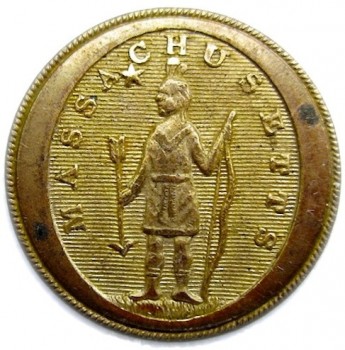
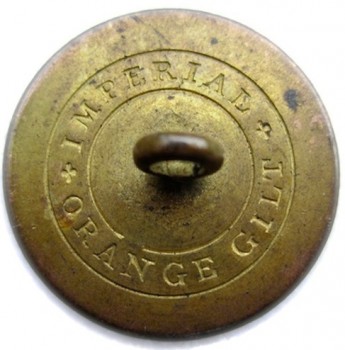
1812-30’s Massachusetts State Militia, General Use
Color: A Golden Center With A Light Coppery Brown Border.
Metal: Flat, 1-Piece, Raised Design, Gilt Brass.
Size: 25mm. Coat Size
Albert’s Number: MS 19-A: RV 10
Tice’s Number: MSO 36-A Unlisted Back Mark
Variation: Native American Indian Standing on A Grassy Mound / Large Hunting Bow / Downward Pointing Arrow
Present Condition: A Non Excavated Example, Exceptional Planchet Condition, An Exceptional High Relief Pattern Remains.
Robert’s Notes: This pattern has always been a collector’s favorite among both button and coin collectors. It was produced by British manufacturers all throughout the first quarter of the 19th century. The button’s pattern depicts a Native American Indian Standing on a Grassy Mound. He is leaning on a Large Hunting Bow in his Left Hand, and holding a Downward Pointing Arrow in his right. Over the Indian’s right shoulder is the symbolic Five-Point North Star which represents the dependent territory of Maine. Arched in a semi-circle around the Indian is the states name, “MASSACHUSETTS” in large Roman font capital letters. The high relief pattern is set on an evenly lined field that is set within an oval picture frame border with an outer rope edging. When this button becomes available, collectors should seek specimens that clearly show the Indian’s belt and depict the shirt’s V neck lines clearly.
Reverse Button Analysis: This is a one-piece button with a loop shank. The shank is original, straight, and intact. dm IMPERIAL+ ORANGE GILT+ within 2 dm rings.
The RJ Silverstein Collection.
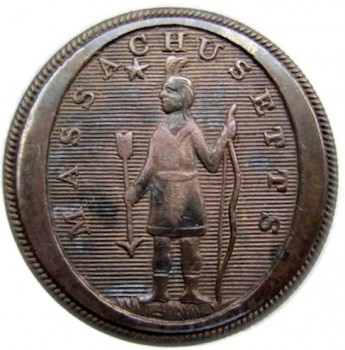
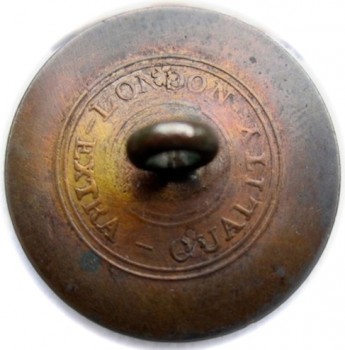
1812-30’s Massachusetts State Militia, General Use
Color: A Coppery Brown.
Metal: Flat, 1-Piece, Raised Design, Brass.
Size: 25mm. Coat Size
Albert’s Number: MS 19-A: RV 6-10
Tice’s Number: MSO 36-A.2
Variation: Native American Indian Standing on A Grassy Mound / Large Hunting Bow / Downward Pointing Arrow
Present Condition: A Non Excavated Example, Exceptional Planchet Condition, An Exceptional High Relief Pattern Remains.
Robert’s Notes: This is the same British manufacturer’s obverse pattern, just a different back mark. The button’s pattern depicts a Native American Indian Standing on a Grassy Mound. He is leaning on a Large Hunting Bow in his Left Hand, and holding a Downward Pointing Arrow in his right. Over the Indian’s right shoulder is the symbolic Five-Point North Star which represents the dependent territory of Maine. Arched in a semi-circle around the Indian is the states name, “MASSACHUSETTS” in large Roman font capital letters. The high relief pattern is set on an evenly lined field that is set within an oval picture frame border with an outer rope edging. When this button becomes available, collectors should seek specimens that clearly show the Indian’s belt and depict the shirt’s V neck lines clearly.
Reverse Button Analysis: This is a one-piece button with a loop shank. The shank is original, straight, and intact. rm LONDON- EXTRA-QUALITY within a set of 2 double Rm rings.
The RJ Silverstein Collection.
1812-30’s Massachusetts State Militia, General Use
Color:Wood Brown.
Metal: Convex, 1-Piece, Raised Design, Silver-Plated.
Size: 20.46mm. Small Coat / Vest?
Albert’s Number: MS 20-Unlisted Backmark: RV25
Tice’s Number: MSO 38-A.1
Variation: Native American Indian Standing on A Grassy Mound / Large Hunting Bow / Downward Pointing Arrow.
Present Condition: A Non Excavated Specimen, Exceptional Planchet Condition, An Exceptional High Relief Pattern Remains.
Robert’s Notes: This was made by an unidentified British manufacturer in the early 19th Century. Of all varieties of this specific pattern this button would show the highest craftsmanship in the details. The button’s pattern depicts a Native American Indian Standing on a Grassy Mound. He is leaning on a Large Hunting Bow in his Left Hand, and holding a Downward Pointing Arrow in his right. Over the Indian’s right shoulder is the symbolic Five-Point North Star which represents the dependent territory of Maine. Arched in a semi-circle around the Indian is the states name, “MASSACHUSETTS” in large Roman font capital letters. The high relief pattern is set on an evenly lined field that is set within an oval picture frame border with an outer pipe rope edge. When this button variant becomes available, collectors should seek specimens that clearly show the Indian’s tunic and depicts the Indian’s head & hair.
Reverse Button Analysis: This is a concave one-piece button with a copper loop shank. The shank is original, straight, and intact. dm WARRANTED / WREATH INNER set of 2 double dm rings. Overstrike TREBLE PLATED.
The RJ Silverstein Collection.

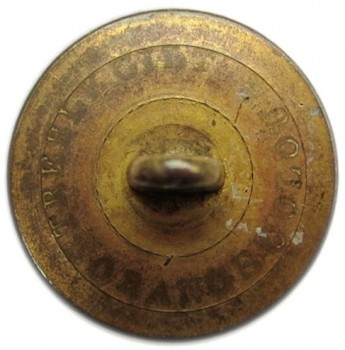
1815-25 Massachusetts State Militia, General Use
Color: A Coppery Brass Yellow.
Metal: Flat, 1-Piece, Raised Design, Gilt Brass.
Size: 24mm. Coat Size
Albert’s Number: MS 22-B: RV 25
Tice’s Number: MS 102-A/B
Variation: Native American Indian / Large Hunting Bow / Downward Pointing Arrow / Five Point North Star.
Present Condition: A Non Excavated Specimen, A Strong Planchet Condition, An Exceptional High Relief Pattern Remains.
Robert’s Notes: This specific pattern was made by both the British & American Manufacturers between 1815-25 . The button’s pattern depicts a Native American Indian Standing on a Grassy Mound. He is leaning on a Large Hunting Bow in his Left Hand, and holding a Downward Pointing Arrow in his right. Over the Indian’s right shoulder is a Five-Point North Star Pointing Downward. This star is to symbolically represent the dependent territory of Maine. The high relief pattern is set on an evenly lined field that is set within an oval picture frame border with an outer rope edging. This button is a little more scarce then it’s counterpart with the states name in the legend. A clearly defined belt and tunic should be a strong consideration in pricing.
Reverse Button Analysis: This is a one-piece button with a loop shank. The shank is original, straight, and intact. This button is a strike over from surplus early official/diplomatic buttons. TREBLE GILT ORANGE COLOUR within 2 dm rings.
The RJ Silverstein Collection.
1816 Massachusetts Independent Corps of Cadets
Color: Bright Gold.
Metal: Flat, 1-Piece, Raised Design, Gilt Brass.
Size: 24.58mm. Coat Size
Albert’s Number: MS 60.1: RV 35
Tice’s Number: MS 116-A.1
Variation: Right Facing Flying Flag/ Sun Rays/ E. Pluribus Unum/ Monstrat.Viam/ Independent Cadets.
Present Condition: A Non Excavated Specimen, An Exceptional Planchet Condition, An Exceptional High Relief Pattern Remains.
Robert’s Notes: The colonial authorities organized the Independent Corps of Cadets in 1741. This button is the second generation design to a much cruder impressed 1800 cast pewter design. This replacement button offered the technological advance of a raised design pattern, a cleaner technical engraving design, and two new added features. The rays above the eagle, and the flag design. The button does have a matching cuff, but without the flag or mottos. Tice mentions in his book, “In unsettled times just before the Revolution, British Gov. Gage dismissed patriot leader John Hancock from his position as Corps Commander. The corps responded by returning the Gov. standard, declaring that the dismissal of Hancock was comparable to disbandment.” The Independent Corps of Cadets reorganized in 1776, and served throughout the American Revolution under Jackson’s 16th Continental Regt. It should be noted by collectors, that buttons with the Commonwealth Arms were first used exclusively by Cadets. The button depicts an eagle with it’s head turned sideways. In the eagle’s mouth is a banner ribbon with the impressed LATIN inscription, “E PLURIBUS UNUM,” which means, “Out of one many.” In the eagle’s left talon is a Six Petal Olive Branch, and an upward pointing Spear. In the eagle’s right talon is a small bundle of 4 Arrows. Above the eagle is a raised Sun Ray pattern, and a banner ribbon with the raised inscription, “MONSTRAT.VIAM” which translates, “He shows the way.” Below the eagle is a right facing blowing Flag with a Commonwealth emblem. (This later button does not have the inscription, “INST 1786” in the flag). Below the flag is another banner ribbon with the military designation, “INDEPENDENT. CADETS.” The high relief pattern is set on a plain flat field.
Reverse Button Analysis: This is a one-piece button with a loop shank. The shank is original, straight, and intact. TREBLE/GILT rm.
The Robert J. Silverstein Collection.
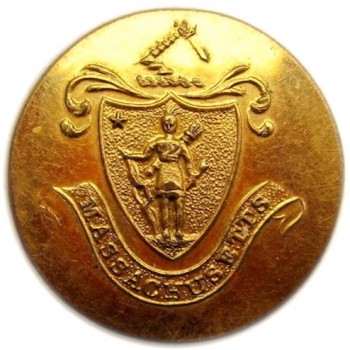
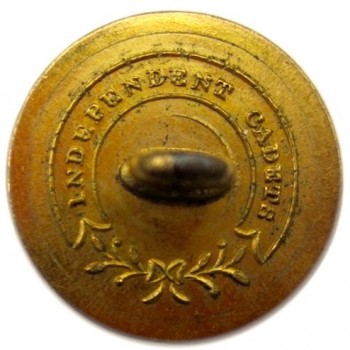
1830’s-65 Massachusetts State Militia
Color: Antique Brass with An Orange Glow.
Metal: Flat, 1-Piece, Raised Design, Gilt Brass.
Size: 21.63mm. Coat Size.
Albert’s Number: MS 26: RV 5
Tice’s Number: MS 200-A.1
Variation: Native American Indian / Pebbled Field / Quiver of Arrows / North Star / Bent Arm / Downward Pointing Saber.
Present Condition: A Non Excavated Specimen, A Strong Planchet Condition, An Exceptional High Relief Pattern Remains.
Robert’s Notes: This was the first Massachusetts button in the 1830’s to depict the entire Commonwealth Coat of Arms. The button was also re-manufactured throughout the Civil War. The button’s pattern depicts a Native American Indian standing on a grassy mound. The Indian is depicted on a Pebbled Field that is within a recessed shield that has a raised outline border. The Indian is leaning on a large bow with his right hand, and holding a downward pointing arrow in his left. Over the Indian’s left shoulder is a Quiver of Arrows. In the upper right hand corner of the shield is the symbolic North Star which represents the dependent territory of Maine. Directly above the shield is a mantle depicted by some graphic swirly lines. Above that is the Bent Arm Holding a Downward Pointing Saber. Below the shield is a “U” shaped banner ribbon that has the states name, “MASSACHUSETTS” in capital letters on a pebbled field. The high relief pattern is set against a plain flat field with no raised edge border.
Reverse Button Analysis: This is a flat one-piece button with a loop shank. The shank is original, straight, and intact. above is a rm INDEPENDENT CORPS within a ribbon. Below is a rm wreath & Bow design.
The RJ Silverstein Collection.
1820’s Massachusetts State Militia
Color: A Leather Brown.
Metal: Flat, 1-Piece, Raised Design, Gilt Brass.
Size: 22.36mm. Coat Size
Albert’s Number: MS 27: RV 5
Tice’s Number: MS 110-B.1
Variation: Pebbled Field / Slanted Bow / Quiver of Arrows / North Star / Saber Tip Above the Crest.
Present Condition: A Non Excavated Specimen, An Exceptional Planchet Condition, An Exceptional High Relief Pattern Remains.
Robert’s Notes: These buttons were made in Great Britain during the 1820’s. There appears to be at least three known die variants. The main differences are in the depiction of the length of the saber, and its spacing to the top of the mantling. The button’s pattern depicts a Native American Indian standing on a very small mound. The Indian is depicted on a Pebbled Field that is within a shield with a raised outline. The Indian is leaning on a large Slanted Bow with his right hand, and holding a Downward Pointing Arrow in his left. Over the Indian’s left shoulder is a Quiver of Arrows. In the upper right hand corner of the shield is the symbolic North Star which represents the dependent territory of Maine. Directly above the shield is a mantle depicted by some graphic swirly lines. Above that is the bent arm holding a downward pointing saber. In this variant, the Saber Tip of the Crest is Above the Mantling. Below the shield is a “U” shaped banner ribbon that has the states name, “MASSACHUSETTS” in Roman font capital letters. The high relief pattern is set on a lined field with a thin raised edge trim.
Reverse Button Analysis: This is a one-piece button with a loop shank. The shank is original, straight, and intact. dm LONDON / RICH QUALITY in Old English Script with an inner cross set of 2 double dm rings/ ********
The RJ Silverstein Collection.
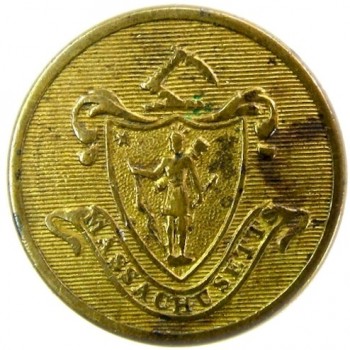
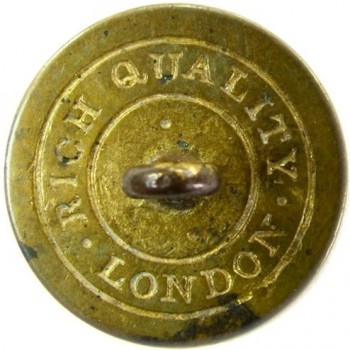
1820’s Massachusetts State Militia
Color: A Brass Yellow With Green Undertones.
Metal: Flat, 1-Piece, Raised Design, Gilded Brass.
Size: 23mm. Coat Size
Albert’s Number: MS 27: RV 5
Tice’s Number: MS 110-C.2
Variation: Pebbled Field / Slanted Bow / Quiver of Arrows / North Star / Saber Appears like a Short Knife.
Present Condition: A Non Excavated Specimen, A Strong Planchet Condition, A Strong High Relief Pattern Remains.
Robert’s Notes: These buttons were manufactured in Great Britain during the 1820’s. There appears to be at least three die variants. The main differences are in the depiction of the length of the saber, and its spacing to the top of the mantling. The button’s pattern depicts a Native American Indian standing on a very small mound. The Indian is depicted on a Pebbled Field that is within a shield with a raised outline. The Indian is leaning on a large Slanted Bow with his right hand, and holding a Downward Pointing Arrow in his left. Over the Indian’s left shoulder is a Quiver of Arrows. In the upper right hand corner of the shield is the symbolic North Star which represents the dependent territory of Maine. Directly above the shield is a mantle depicted by some graphic swirly lines. Above that is the bent arm holding a downward pointing saber. In this variant, the Saber Appears like a Short Knife. Below the shield is a “U” shaped banner ribbon that has the states name, “MASSACHUSETTS” in capital letters. The high relief pattern is set on a lined field with a thin raised edge border.
Reverse Button Analysis: This is a one-piece button with a loop shank. The shank is original, straight, and intact. rm LONDON. RICH .QUALITY within a set of 2 double dm rings.
The RJ Silverstein Collection.

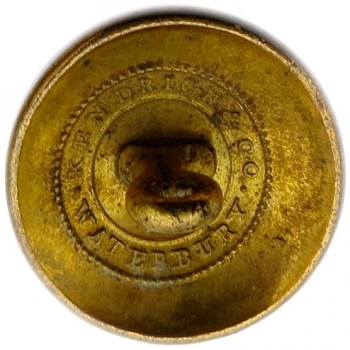
1830’s Massachusetts State Militia
Color: A Coppery Brown Golden Areas.
Metal: 1-Piece, Slightly Convex, Raised Design, Gilt Brass.
Size: 20.08mm. Coat Size.
Albert’s Number: MS 33: RV 8
Tice’s Number: MS 204-A.1
Variation: Bent Arm Clothed in a Military Style Button Shirt / Long Downward Pointing Saber / 26 Five Pointed Stars.
Present Condition: A Non Excavated Specimen, A Strong Planchet Condition, A Strong High Relief Pattern Remains.
Isabela’s Notes: This is one of the last Massachusetts one-piece military buttons made during the 1830’s. The same front dies were later used for the production of two-piece buttons. There are two die variants known for this one piece button. One with a long sword, and the other with a short sword. The button’s pattern depicts a large Bent Arm Clothed in a Military Style Button Shirt holding a Long Downward Pointing Saber. In a semi-circle above is the states abbreviation, “MASS.” with the designation,“ VOLUNTEER.” In the legend below is the military designation, “MILITIA” in capital letters. Circling around the button’s edge is 26 Five Pointed Stars. The high relief pattern is set on a plain convex field with no raised edge border. There is another die variant with a shorter sword.
Reverse Button Analysis: This is a slightly concave one-piece button with a loop shank. The shank is original, straight, and intact. .KENDRICK & CO./WATERBURY rm with an inner contiguous ring and outer ring of dots.
The RJ Silverstein Collection.
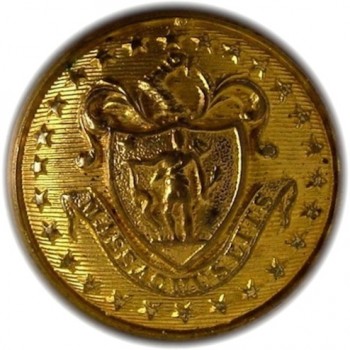
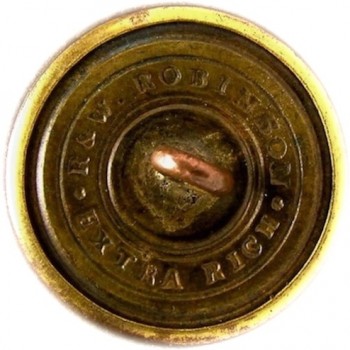
1840’s Massachusetts State Militia, General Use, Independent Corps of Cadets
Color: A Tarnished Gold.
Metal: 2-Piece, Low-Convex, Raised Design, Gilt Brass.
Size: 23mm. Coat Size.
Albert’s Number: MS 30: RV 1
Tice’s Number: MS 202-B.2
Variation: Native American Indian / Pebbled Shield / Hunting Bow / Decorative Mantle / Short Saber / 26 Five Point Stars / Stars Rotated 180 Deg..
Present Condition: A Non Excavated Specimen, A Strong Planchet Condition, An Exceptional High Relief Pattern Remains.
Robert’s Notes: Originally Colonel Winchester made these buttons for the Independent Corps of Cadets when he was visiting Paris. When he returned home he presented them to the cadets. By October 4, 1844 the pattern was officially adopted. There are four known die variants that later became general use button for all Massachusetts troops. The differences mainly lie in the depiction of the sword, stars, and shield. The button depicts the Commonwealth Arms of a small Native American Indian standing within a Pebbled Shield. In his right hand he is leaning on a Hunting Bow. In his left hand he is holding an arrow pointing downward. Over his left shoulder is a quiver of arrows. There is a North Star in the upper corner of the shield which represents the dependent territory of Maine. Above the shield is a Decorative Mantle with a bent arm holding a Short Saber in the middle. Below the shield is a banner ribbon with the states name, “MASSACHUSETTS” in all capital letters on a pebbled field. Circling around the border is 26 Five Point Stars. In this die variant, the stars are rotated 180 degrees with the point outward. The pattern is set against a lined field with a thin flat border ring encircling the edge.
Reverse Button Analysis: This is a two-piece button with a loop shank. The shank is original, straight, and intact. dm R&W. ROBINSON. EXTRA RICH. within a set of double inner dm rings, and one outer dm ring.
The Picture is Courteous of H. Ridgeway.
1860’s-Post Massachusetts State Militia, General Use
Color: A Silvery Highlighted Gold.
Metal: 2-Piece, Low-Convex, Raised Design, Gilt Brass.
Size: 23.23mm. Coat Size.
Albert’s Number: MS 30: RV 1
Tice’s Number: MS 202-C.1
Variation: Native American Indian / Pebbled Shield / Short Saber / Star Touches Shield’s Top Outline / Arrow Pointing Toward his Leg / Smaller Central Shield.
Present Condition: An Excavated Specimen, A Strong Planchet Condition, A Strong High Relief Pattern Remains.
Robert’s Notes: There are four known die variants that later became general use button for all Massachusetts troops. This specific button was most likely made after the Civil War, but backmark indicates it could be as early as 1850’s. The button depicts the Commonwealth Arms of a small Native American Indian standing within a Pebbled Shield. In his right hand he is leaning on a hunting bow. In his left hand he is holding an Arrow Pointing toward his Leg. Over his left shoulder is a quiver of arrows. There is a North Star in the upper corner that Touches the Shield’s Top Outline. Above the shield is a Decorative Mantle with a bent arm holding a Short Saber in the middle. Below the shield is a banner ribbon with the states name, “MASSACHUSETTS” in all capital letters on a pebbled field. Circling around the border is 26 Five Point Stars. In this die variant, the Stars are Rotated 180 Degrees with the point outward. Also, the Central Shield is Smaller. The high relief pattern is set on a lined field with a thin raised beveled edge.
Reverse Button Analysis: This is a two-piece button with a loop shank. The shank is original, straight, and intact. D. EVANS & CO. ATTLEBORO . MASS dm on a ribbon reading clockwise, flower at bottom, ca 1850’s – 1860’s, Evans D.210.
The RJ. Silverstein Collection.
1860’s-Post Massachusetts State Militia, General Use
Color: A Gold W/ Brown Outlines.
Metal: 2-Piece, High-Convex, Raised Design, Gilt Brass.
Size: 23.23mm. Coat Size.
Albert’s Number: MS 30: RV 1
Tice’s Number: MS 202-C.1
Variation: Native American Indian / Lined Shield / Holding A Hunting Bow / Arrow Pointing Toward the Ground / Smaller Central Shield.
Present Condition: An Excavated Specimen, A Strong Planchet Condition, A Strong High Relief Pattern Remains.
Robert’s Notes: This cuff button was most likely made after the Civil War. The button depicts the Massachusetts Commonwealth Coat of Arms of a small Native American Indian standing within a Lined Shield. In his right hand he is Holding a Hunting Bow. In his left hand he is holding an Arrow Pointing toward the Ground. There is no quiver of arrows on his left shoulder. There is a North Star in the upper corner that Touches the Shield’s Top Outline. Above the shield is a Decorative Mantle with a bent arm holding a Short Saber in the middle. In a semi-circle below the shield is the states name, “MASSACHUSETTS” in all capital letters on a pebbled field. Circling around the border is 26 Five Point Stars. In this die variant, the Stars are Rotated 180 Degrees with the point outward.
Reverse Button Analysis: This is a two-piece button with a loop shank. The shank is original, straight, and intact. D. EVANS & CO. Superfine dm.
The RJ. Silverstein Collection.


1865-90’s Massachusetts State Militia, General Use
Color: Antique Brass.
Metal: 3-Piece, High Convex, Raised Design, Gilt Brass.
Size: 22.94mm. Coat Size.
Albert’s Number: MS 30: RV 1
Tice’s Number: MS 202-D.1.
Variation: Native American Indian / Lined Shield / Small Hunting Bow / Large Arrow / Short Saber / 24 Five Point Stars.
Present Condition: A Non Excavated Specimen, A Strong Planchet Condition, An Exceptional High Relief Pattern Remains.
Robert’s Notes: Robinson & Evans made most of these after the Civil War, but there are some manufactured prior to 1865. Civil War collectors should be careful noting back marks. There are two known die variants. One with the star over the Indians left shoulder, and one with it over his right. The button depicts the Commonwealth Arms of a small Native American Indian standing within an evenly Lined Shield. In his right hand he is holding on a Small Hunting Bow. In his left hand he is holding a Large Arrow pointing downward. Over his left shoulder is a Small Quiver of Arrows. There is a North Star on the right hand side between the Indian’s head and hunting bow. This represents the dependent territory of Maine. Above the shield is a decorative mantle with a bent arm holding a Long Saber in the middle. In this die variant, the sword in the crest is longer the other variants. Below the shield is with the states name, “MASSACHUSETTS” in all capital letters. Circling around the border is 24 Five Point Stars. The high relief pattern is set on a high convex lined field.
Reverse Button Analysis: This is a two-piece button with a loop shank. The shank is original, straight, and intact. SCOVILL MF’G Co. (o is underlined) / * WATERBURY * dm large letters inner ring of dots, no outer ring, manufactured after the Civil War, Scovill.920.
The RJ Silverstein Collection.
1840-1865 Massachusetts State Militia Volunteers, Officer’s Use
Color: A Coppery-Brown Yellow.
Metal: 3-Piece, Convex, Raised Design, Gilt Brass.
Size: 22.01mm. Coat Size.
Albert’s Number: MS 35: Unlisted B/M
Tice’s Number: MS 210-E: Unlisted B/M
Variation: Bent Arm / Uniform Shirt / Elbow Guard / Down Pointing Saber / 11 Buttons / 24 5 Pointed Stars.
Present Condition: A Non Excavated Specimen, A Strong Planchet Condition, A Strong High Relief Pattern Remains.
Isabela’s Notes: These buttons were made for the Massachusetts State Militia starting around 1840, and made through-out the Civil War. There are at least 13 known pattern variations, and lots of makers and backmarks. This is a great collector’s favorite since they are relatively inexpensive, and a wide collector’s pattern varieties. In this variant, the front group of sleeve buttons have 3 each. The button’s pattern depicts a Bent Arm in the act of striking. The arm is depicted in a Uniform Shirt with an added Elbow Guard. The Arm is holding a Downward Pointing Saber. In this die variant, the Saber lies at the end of the wreath’s twist. The sleeve of the uniform has 11 Buttons. In a semi-circle above the arm is the state’s military designation, “MASS. VOLUNTEER” in all capital letters. Flanking each side of the legend’s inscription is 2 small raised stipples. In the legend below the military designation, “MILITIA” in capital letters. Circling around the legend is 24 Five pointed American Stars. The high relief pattern is set on an evenly lined convex field with a false edge.
Reverse Button Analysis: This is a three-piece button with a loop shank. The shank is original, straight, and intact. TREBLE (FLORAL DESIGN) / GILT (FLORAL DESIGN).
1840-1865 Massachusetts State Militia Volunteers, Officer’s Use
Color: Tarnished Gold.
Metal: 3-Piece, Convex, Raised Design, Gilt Brass.
Size: 22.5mm. Coat Size.
Albert’s Number: MS 35-A.4: RV 3
Tice’s Number: MS 210-D.1
Variation: Bent Arm / Uniform Shirt / Elbow Guard / Down Pointing Saber / 11 Buttons / 24 5 Pointed Stars.
Present Condition: A Non Excavated Specimen, A Strong Planchet Condition, A Strong High Relief Pattern Remains.
Isabela’s Notes: These buttons were made for the Massachusetts State Militia starting around 1840, and carried on through-out the Civil War. There are at least 13 known pattern variations and tons of makers and backmarks. This is a great collector’s favorite since they are relatively inexpensive and a wide collector’s variety. In 1853, the new prescribed regulations allowed for dress uniforms of enlisted men to have the same Arm gilt buttons as officers. By December of 1865, Massachusetts prescribed new types of militia buttons, but some of these buttons were still made for a very short time after the war. The button’s pattern depicts a Bent Arm in the act of striking. The arm is depicted in a Uniform Shirt with an added Elbow Guard. The Arm is holding a Downward Pointing Saber. In this die variant, the Saber lies over the last twist of the wreath. The sleeve of the uniform has 11 Buttons. In a semi-circle above the arm is the state’s military designation, “MASS. VOLUNTEER” in all capital letters. Flanking each side of the legend’s inscription is two raised stipples. In the legend below the military designation, “MILITIA” in capital letters. Circling around the legend is 24 Five pointed American Stars. The high relief pattern is set on an evenly lined convex field with a false edge.
Reverse Button Analysis: This is a three-piece button with a loop shank. The shank is original, straight, and intact. .*.*. R&W ROBINSON.*.*. / MAKERS / ATTLEBOROUGH *MASS * dm
1840-1865 Massachusetts State Militia Volunteers, Officer’s Use
Color: A Silvery Brown.
Metal: 3-Piece, Convex, Raised Design, Silver’d.
Size: 22.02mm. Coat Size.
Albert’s Number: MS 35-A.4: RV 3
Tice’s Number: MS 210-D.1
Variation: Bent Arm / Uniform Shirt / 3 & 2 Buttons / Down Pointing Saber over last Twist / 24 5 Pointed Stars.
Present Condition: A Non Excavated Specimen, A Strong Planchet Condition, A Strong High Relief Pattern Remains.
Isabela’s Notes: These buttons were made for the Massachusetts State Militia starting around 1840, and carried on through-out the Civil War. There are at least 13 known pattern variations and tons of makers and backmarks. This is a great collector’s favorite since they are relatively inexpensive and a wide collector’s variety. In 1853, the new prescribed regulations allowed for dress uniforms of enlisted men to have the same Arm gilt buttons as officers. In this variant the front groups of buttons have 3 & 2. The button’s pattern depicts a Bent Arm in the act of striking. The arm is depicted in a Uniform Shirt with an added Elbow Guard. The Arm is holding a Downward Pointing Saber. In this die variant, the Saber lies over the last twist of the wreath. The sleeve of the uniform has 12 Buttons. In a semi-circle above the arm is the state’s military designation, “MASS. VOLUNTEER” in all capital letters. Flanking each side of the legend’s inscription is 2 raised stipples. In the legend below the military designation, “MILITIA” in capital letters. Circling around the legend is 24 Five pointed American Stars. The high relief pattern is set on an evenly lined convex field with a false edge.
Reverse Button Analysis: This is a three-piece button with a loop shank. The shank is original, straight, and intact..*.*. R&W ROBINSON.*.*. / MAKERS / ATTLEBOROUGH *MASS * dm.
1840-1865 Massachusetts State Militia Volunteers, Officer’s Use
Color: A Bright Golden Yellow.
Metal: 3-Piece, Convex, Raised Design, Gilt Brass.
Size: 22.01mm. Coat Size.
Albert’s Number: MS 35-B: RV 1
Tice’s Number: MS 210-F.3
Variation: Bent Arm / Uniform Shirt / Elbow Guard / Down Pointing Saber / 11 Buttons / 24 5 Pointed Stars.
Present Condition: A Non Excavated Specimen, A Strong Planchet Condition, A Exceptional High Relief Pattern Remains.
Isabela’s Notes: These buttons were made for the Massachusetts State Militia starting around 1840, and carried on through-out the Civil War. There are at least 13 known pattern variations and tons of makers and backmarks. This is a great collector’s favorite since they are relatively inexpensive and a wide collector’s variety. In this variant the front groups of buttons have 3 each. The button’s pattern depicts a Bent Arm in the act of striking. The arm is depicted in a Uniform Shirt with an added Elbow Guard. The Arm is holding a Downward Pointing Saber, and almost touches the “U” in legend’s top inscription. In this die variant, the Saber lies at the end of the wreath’s twist. The sleeve of the uniform has 11 Buttons. In a semi-circle above the arm is the state’s military designation, “MASS. VOLUNTEER” in all capital letters. Flanking each side of the legend’s inscription is 2 raised stipples. In the legend below the military designation, “MILITIA” in capital letters. Circling around the legend is 24 Five pointed American Stars. The high relief pattern is set on an evenly lined convex field with a false edge.
Reverse Button Analysis: This is a three-piece button with a loop shank. The shank is original, straight, and intact. * WATERBURY BUTTON. CO. * / EXTRA. dm with an inner ring.
1850-60’s Massachusetts State Militia Volunteers, General Use
Color: A Deep Gold.
Metal: 2-Piece, Convex, Raised Design, Gilt Brass.
Size: 14.91mm. Cuff Size.
Albert’s Number: MS 37-Av: RV 8
Tice’s Number: MS 212-Cs.1
Variation: Bent Arm Clothed in a Military Style Button Shirt / 4 Buttons / Downward Pointing Saber.
Present Condition: A Non Excavated Specimen, A Strong Planchet Condition, A Strong High Relief Pattern Remains.
Isabela’s Notes: The backmark clearly indicates the was made during the early 1850-60’s. Tice noted that a lot of these were made Post 1865. They are sometimes mistaken for earlier one-piece buttons with the same pattern. The button’s pattern depicts a Bent Arm Clothed in a Military Style Button Shirt holding a Downward Pointing Saber. The sleeve of the uniform has 4 Buttons. In a semi-circle above is MASS. VOLUNTEER.” Flanking the lower sides of the legend are 2 American Five Pointed Stars. In the legend below is the military designation, “MILITIA” in capital letters. The high relief pattern is set on a plain convex field with a plain edge.
Reverse Button Analysis: This is a two-piece button with a loop shank. The shank is original, straight, and intact. .D. EVANS & CO. / (star) EXTRA (star)” dm inner solid ring, only used small size, ca 1850’s to 1860’s, Evans D.230
The RJ Silverstein Collection.
1840-55 Worcester City Guard
Color: A Coppery Gold.
Metal: 2-Piece, Convex, Raised Design, Gilt Brass.
Size: 23mm. Coat Size.
Albert’s Number: MS 100: RV 5
Tice’s Number: MS 284-A.1
Variation:
Present Condition: A Non Excavated Specimen, A Strong Planchet Condition, An Exceptional High Relief Pattern Remains.
Isabela’s Notes: Robinson or D. Evans made these common buttons during the 1840’s and 50’s. The City Guard organized in 1840, after a political party discord split the Worcester Light Infantry. The button was used on Blue or ceremonial white uniforms. The unit served for three months during the Civil War in 1861. The again in 1864, as Company F, 60th Regt. Militia Infantry for 100 days. The button depicts the Commonwealth of Massachusetts Coat of Arms of a small Native American Indian standing within an evenly Lined Shield. In his right hand he is holding on a Long Hunting Bow. In his left hand he is holding a Large Arrow pointing downward. There is a North Star on the right hand side between the Indian’s head and hunting bow. This represents the dependent territory of Maine. Above the shield is a decorative mantle with a bent arm holding a Short Saber in the middle. Below the shield is the unit’s organized date, “1840” in large raised numbers. Flanking each side of the shield is the unit’s initials, “C G” in old English letters. The high relief pattern is set on a plain convex field.
Reverse Button Analysis: This is a two-piece button with a loop shank. The shank is original, straight, and intact.
1861-65 18th Regt. of Massachusetts State Volunteers
Color: Spoon Silver.
Metal: 1-Piece, Convex, Raised Design, White Metal.
Size: 23.01mm. Coat Size.
Albert’s Number: MS 104 RV 20
Tice’s Number: MS 218-B.1
Variation: Eagles Right Wing Touches the Arrows & Laurel / 13 Six Point Stars / Angle Cut Corners.
Present Condition: A Non Excavated Plate Specimen, Exceptional Planchet Condition, An Exceptional High Relief Pattern Remains.
Isabela’s Notes: At the beginning of the Civil War, The Federal Union received 10,000 Chasseur uniforms from France. These buttons were used on the uniforms of the 83rd Pennsylvania, and the 18th Massachusetts Volunteers. In 1861-62, General McCellan issued them to the 83rd Pennsylvania and the 18th Massachusetts Volunteers. These uniforms were issued with these “White Metal” one piece buttons. Along with the buttons were large Shako Hat Pins and Rifleman Buckles with the same motif. Unfortunately, the French tailored uniforms proved to be poor fitted for the American troops and many were discarded. There is also a Two-Piece Specimen dug, but provenance is unknown. Collectors believe it might have been fabricated for an officer 1861-62. This design is a collector’s favorite, and white metal specimens should be achievable in the market. The button’s pattern depicts a a Federal Eagle facing right with Upright Wings. A Federal Type Shield with Thirteen Horizontal Stripes across the top, and 6 Verticale Thicker Bar Stripes in the lower half. The Federal shield has Straight Angle Cut Corners on both sides of the shield’s top. In the Eagle’s left talon is Three Arrows pointing towards the left. In the Eagle’s right talon is an 8 Petal Laurel Branch. In this die variant, the Eagle’s Wing touches the Arrows & Laurels. Thirteen 6 Point Stars are in a semicircle above the Eagle. The high relief pattern is set on a plain convex field with a raised thin edge border.
Reverse Button Analysis: This is a concave one-piece button with a loop shank. The shank is original, straight, and intact. WORDIER FRERES / PARIS rm.
Previously, The Mabel-Fischer Collection.
The RJ Silverstein Collection.
1861-65 18th Regt. of Massachusetts State Volunteers
Color: Silver With Yellowish-Green Encrustations.
Metal: 1-Piece, Convex, Raised Design, White Metal.
Size: 16.07mm. Cuff Size.
Albert’s Number: MS 104 RV 20
Tice’s Number: MS 218-As.1
Variation: Eagles Right Wing Above the Laurel Leaves / 13 Six Point Stars / Straight Angle Cut Corners.
Present Condition: An Excavated Specimen, Good Planchet Condition, A Good High Relief Pattern Remains.
Isabela’s Notes: At the beginning of the Civil War, The Federal Union received 10,000 Chasseur uniforms from France. In 1861-62, General McCellan issued them to the 83rd Pennsylvania and the 18th Massachusetts Volunteers. These uniforms were issued with these “White Metal” one piece buttons. Along with the buttons were large Shako Hat Pins and Rifleman Buckles with the same motif. Unfortunately, the French tailored uniforms proved to be poor fitted for the American troops and many were discarded. The button’s pattern depicts a Federal Type Eagle facing right with Upright Wings. A Federal Type Shield with Thirteen Horizontal Stripes across the top, and 6 verticale Thicker Bar Stripes in the lower half. The Federal shield has Straight Angle Cut Corners on both sides of the shield’s top. In the Eagle’s left talon is Three Arrows pointing towards the left. In the Eagle’s right talon is a 5 Petal Laurel Branch. In this die variant, the Eagle’s Wing Above the Laurels. There is Thirteen 6 Point Stars in a semicircle above the Eagle. The high relief pattern is set on a plain convex field with a raised thin edge border.
Reverse Button Analysis: This is a concave one-piece button with a loop shank. The shank is original, straight, and intact. PARIS rm. WREATH.
Picture Courteous of Harry Ridgeway.
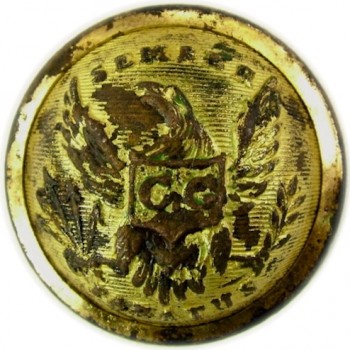
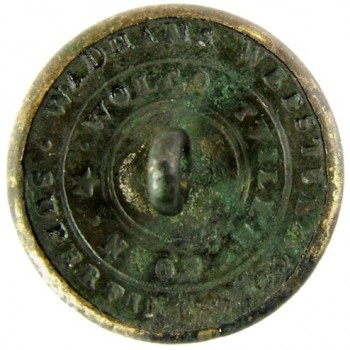
1838-46 Massachusetts Boston City Guards Officer’s Staff Button
Color: Golden Yellow With Brown Patches.
Metal: 3-Piece, Low-Convex, Raised Design, Gilt Brass.
Size: 22.5mm. Coat Button
Albert’s Number: MS 56: RV 8
Tice’s Number: MS 230-A.1
Variation: Eagle with Upraised Wings / Bundle of Five Arrows / Olive Branch with Seven Petals / CG / Semper / Paratus.
Present Condition: An Excavated Specimen, Strong Planchet Condition, Strong High Relief Pattern Remains.
Roberts Notes: In September of 1821, this unit organized as the “Boston City Greys,” but was soon renamed Guards. They later became Company E of the 1st Light Infantry Regiment. They were nicknamed, “Tiger First”. Windhams, Webster & Co made these buttons in Torrington, CT between 1838-46. This appears to be the only manufacture for this specific pattern, hence the only pattern known. The button’s pattern depicts an Eagle with Upraised Wings facing right. In it’s right talon is a Bundle of Five Arrows, and in it’s left talon is a short stem Olive Branch with Seven Petals. On the eagle’s chest is an outlined shield with the initials, “CG” for City Guard. In an arc above the eagles head is the Latin word, “SEMPER“ and arched in the bottom legend is the word, “PARATUS,” which means, Always Ready. The high relief pattern is set on a low-convex lined field. Collectors like this button because there are three different design types to collect.
Reverse Button Analysis: This is a three-piece button with a loop shank. The shank is original, straight, and intact. WINDHAMS WEBSTER & CO/. SUPERFINE . WOLCOTTEVILLE CONN.*. dm middle solid ring, and two inner solid rings
The Old Court House Civil War Museum Collection.
The Picture is Courteous of H. Ridgeway.
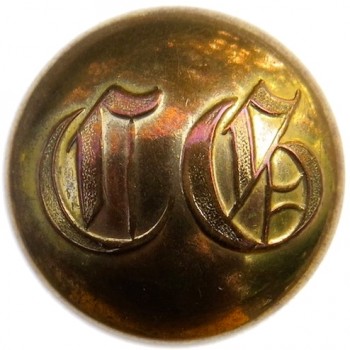
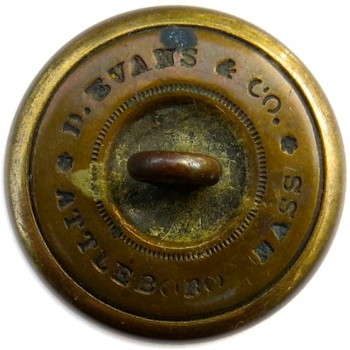
1845-59 Massachusetts Boston City Guards
Color: A Golden Reddish Brown.
Metal: 2-Piece, Convex, Raised Design, Gilt Brass.
Size: 22.94mm. Coat Button.
Albert’s Number: MS 57: RV 5
Tice’s Number: MS 232-A.2
Variation: C G in Old English / Raised Outline / Pebbled Field
Present Condition: A Non Excavated Specimen, Strong Planchet Condition, Strong High Relief Pattern Remains.
Robert’s Notes: This new style button replaced the City Guards Semper Paratus eagle button in 1846. The button’s pattern depicts the City Guards initials, “C G” in Old English. The initials have a Raised Outline with a Pebbled Field. The high relief pattern is set on a plain convex field with no raised edge border. There appears to be at least four manufacturers that produced the same style pattern. Robinson being the most common, and Draper and Sandland a it more scarcer.
Reverse Button Analysis: This is a two-piece button with a loop shank. The shank is original, straight, and intact. *D.EVANS & CO./*ATTLEBORO MASS inner line dm surrounding a shank well.
The RJ. Silverstein Collection
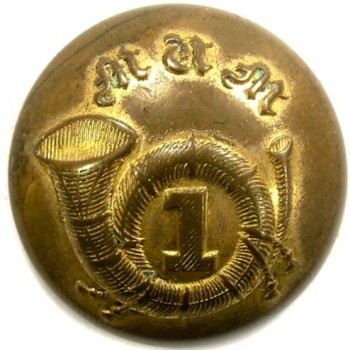
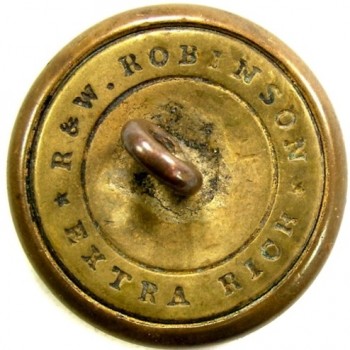
1854 Massachusetts State Volunteer Militia, 1st Regiment Infantry.
Color: Antique Brown With Gold Highlights.
Metal: 2-Piece, Convex, Raised Design, Gilt Brass.
Size: 23.18mm. Coat Size
Albert’s Number: MS 41: RV 5
Tice’s Number: MS 214-A.1
Variation: False Embroidered Hunting Horn / Four Tassels / Lined Number 1 / MVM in Old English Capital Letters.
Present Condition: An Excavated Specimen, Strong Planchet Condition, Strong High Relief Pattern Remains.
Robert’s Notes: A very popular state infantry button among collectors. The button’s pattern depicts a False Embroidered Hunting Horn with Four Tassels. Inside the loop of the horn is a big Lined Number, “1” to distinguish the regiment. Above the hunting horn is the abbreviation for Massachusetts Volunteer Militia, “MVM” in Old English capital letters. The high relief pattern is set on a plain convex field with no raised edge border. State authorities formed the volunteer regiment from existing companies that were still around from the “old” 1st & 2nd regiment. During the Civil War, the 1st & 2nd Regiments were organized into the 42nd Massachusetts Volunteer Infantry Regiment which saw distinguished service.
Reverse Button Analysis: This is a two-Piece button with a loop shank. There is a slight push, but straight, original, and intact. * R&W. ROBINSON/ EXTRA RICH* single inner ring dm.
The RJ Silverstein Collection.
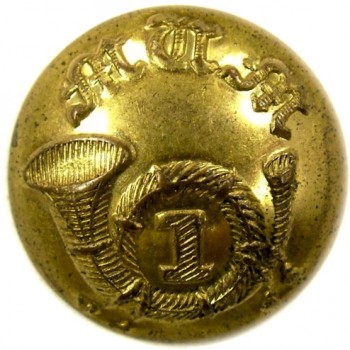
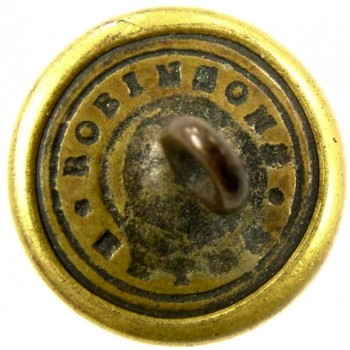
1854 Massachusetts State Volunteer Militia, 1st Regiment Infantry.
Color: Brass Yellow With Brown Speckles.
Metal: 2-Piece, Convex, Raised Design, Gilt Brass.
Size: 15.08 mm. Cuff Size
Albert’s Number: MS 41: RV 10
Tice’s Number: MS 214-As.1
Variation: False Embroidered Hunting Horn / Four Tassels / Lined Number 1 / MVM in Old English Capital Letters.
Present Condition: A Non Excavated Specimen, Strong Planchet Condition, An Exceptional High Relief Pattern Remains.
Robert’s Notes: A very popular state infantry button among collectors. The button’s pattern depicts a False Embroidered Hunting Horn with Four Tassels. Inside the loop of the horn is a big Lined Number, “1” to distinguish the regiment. Above the hunting horn is the abbreviation for Massachusetts Volunteer Militia, “MVM” in Old English capital letters. The high relief pattern is set on a plain convex field with no raised edge border. State authorities formed the volunteer regiment from existing companies that were still around from the “old” 1st & 2nd regiment. During the Civil War, the 1st & 2nd Regiments were organized into the 42nd Massachusetts Volunteer Infantry Regiment which saw distinguished service.
Reverse Button Analysis: This is a two-Piece button with a loop shank. There is a slight push, but straight, original, and intact. * R&W. ROBINSON/ EXTRA RICH* single inner ring dm.
The RJ Silverstein Collection.
1855 Massachusetts State Volunteer Militia, 4th Regiment Infantry.
Color: A Polished Brassy-Brown.
Metal: 2-Piece, Convex, Raised Design, Gilt Brass.
Size: 23mm. Coat Size
Albert’s Number: MS 42: RV 10
Tice’s Number: MS-216 A.1
Variation: False Embroidered Hunting Horn / Four Tassels / Lined Number 1 / MVM in Old English Capital Letters.
Present Condition: A Non Excavated Specimen, Strong Planchet Condition, Strong High Relief Pattern Remains.
Robert’s Notes: D. Evans made these handsome mis-backed buttons around 1855. The unit originated out of the old 2nd light infantry regiment of southeastern Massachusetts in 1855. The button’s pattern depicts a False Embroidered Hunting Horn with Four Tassels. Inside the loop of the horn is a big Lined Number, “4” to distinguish the regiment. Above the hunting horn is the abbreviation for Massachusetts Volunteer Militia, “MVM” in Old English capital letters. The high relief pattern is set on a plain convex field with no raised edge border. During the Civil War, authorities mustered this regiment into service for three months in 1861 and nine months in 1862 &1863. This button is much scarcer then the 1st regiment. Collectors should base there cost according to the detail remaining in the embroidered hunting horn.
Reverse Button Analysis: This is a Two-Piece button with a loop shank. The shank is straight, original, and intact. R&W. ROBINSON* EXTRA RICH* single dm ring.
The RJ Silverstein Collection
1835 National Lancers, Co. A, 1st Battalion, Light Dragoons
Color: Brass Yellow.
Metal: Low-Convex, 2-Piece, Raised Design, Gilt Brass.
Size: 22.01mm. Coat Size
Albert’s Number: MS 73: RV 15
Tice’s Number: MS 258-A.1
Variation: Old English / N L / Capital Letters / National Lancers.
Present Condition: A Non Excavated Plate Specimen, Strong Planchet Condition, A Strong High Relief Pattern Remains.
Robert’s Notes: Robinson made these buttons around 1835. This unit was first organized in 1837, and each soldier was responsible for providing his own horse. The soldiers were known for their bright colorful uniforms and their fluttering pennons on their lancers. The unit gave a military style ceremony for the state Governor’s commencement parades that traveled from Boston to Cambridge. When the Civil War broke out, the troops formed companies C, D, and G of the 1st Massachusetts Volunteer Cavalry. The Lancers were originally ordered to Hilton Head, South Carolina, but then later most troops went to the Army of the Potomac in Virginia. There is only one button pattern known for Massachusetts’s National Lancers. This 1-piece button came in both a coat and cuff size. The button depicts large Old English Style capital letters, “N L” which stands for National Lancers. The high relief pattern is set on an evenly lined field with a thin beveled plain edge that forms a picture window.
Reverse Button Analysis: This is a one-piece button with a loop shank. The shank is straight, original, and intact. * ROBINSON * / EXTRA RICH within two rm concentric rings.
1850’s-60’s National Lancers, Co. A, 1st Battalion, Light Dragoons
Color: Brass Yellow W/ Copper Undertones.
Metal: Low-Convex, 2-Piece, Raised Design, Gilt Brass.
Size: 22.08mm. Coat Size
Albert’s Number: MS 74: RV 02
Tice’s Number: MS 260-A.1
Variation: Old English / N L / Capital Letters / National Lancers.
Present Condition: A Non Excavated Plate Specimen, Strong Planchet Condition, A Strong High Relief Pattern Remains.
Robert’s Notes: D. Evans made these coat buttons in the 1850’s and 1860’s. This unit was first organized in 1837, and was used ceremonially. Their bright colorful uniforms and their fluttering pennons on their lancers gave a military style ceremony for the state Governor’s commencement parades that went from Boston to Cambridge. When the Civil War broke out, the troops formed companies C, D, and G of the 1st Massachusetts Volunteer Cavalry. The Lancers were originally ordered to Hilton Head, South Carolina, but later most went to the Army of the Potomac in Virginia. There is actually 2 variations with the 2-piece buttons. There is a slight difference in the letter design between the coat and cuff. The button’s pattern depicts large Old English Style capital letters, “N L” which stands for National Lancers. The high relief pattern is set on an evenly lined field with a thin beveled plain edge that forms a picture window.
Reverse Button Analysis: This is a two-piece button with a loop shank. The shank is straight, original, and intact.
1850’s-60’s National Lancers, Co. A, 1st Battalion, Light Dragoons
Color: Brass Yellow.
Metal: Low-Convex, 2-Piece, Raised Design, Gilt Brass.
Size: 15.32mm. Cuff Size
Albert’s Number: MS 74-Av: RV 02
Tice’s Number: MS 260-As.1
Variation: Old English / N L / Capital Letters / National Lancers.
Present Condition: A Non Excavated Plate Specimen, Strong Planchet Condition, A Strong High Relief Pattern Remains.
Robert’s Notes: D. Evans made these cuff buttons in the 1850’s and 1860’s. This unit was first organized in 1837, and was used ceremonially. Their bright colorful uniforms and their fluttering pennons on their lancers gave a military style ceremony for the state Governor’s commencement parades that went from Boston to Cambridge. When the Civil War broke out, the troops formed companies C, D, and G of the 1st Massachusetts Volunteer Cavalry. The Lancers were originally ordered to Hilton Head, South Carolina, but later most went to the Army of the Potomac in Virginia. There is a slight difference in the letter design between the coat and cuff. The button’s pattern depicts large Old English Style capital letters, “N L” which stands for National Lancers. The high relief pattern is set on an evenly lined field with a beveled plain edge that forms a picture window.
Reverse Button Analysis: This is a two-piece button with a loop shank. The shank is straight, original, and intact. D.EVANS & CO. / SUPERFINE dm with outer ring and dashes.
The RJ. Silverstein Collection.
Massachusetts Artillery Units
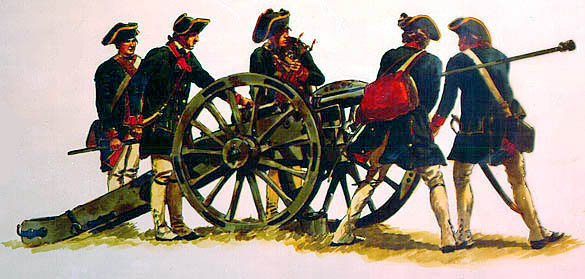
Each cannon would be manned by five or six soldiers. Two gunners and 3 to 4 officers. The right gunner was to prime the piece, and then load it with powder, while the left gunner would fetch the powder from the magazine, and keep ready to fire the cannon at the officer’s command. Three soldiers stood on each side of the cannon, to ram and sponge the cannon, and hold the ladle. The second soldier on the left was charged with providing 50 rounds.

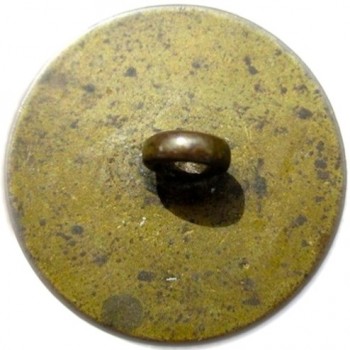
1799-1810 Massachusetts Ancient & Honourable Artillery 1638
Color: A Golden Brown With A Softer Light Brown Center.
Metal: Flat, 1-Piece, Impressed Design, Gilt Brass.
Size: 25.09mm. Coat Size
Albert’s Number: MS45: RV 45? Isabela’s: RV 75
Tice’s Number: MSO40A.1
Variation: Charter Year 1638 / Ancient & Honourable Artillery / Massachusetts Militia
Present Condition: A Non Excavated Specimen, Exceptional Planchet Condition, An Exceptional Impression Remains.
Robert’s Notes: The Ancient & Honourable Artillery unit acquired it’s first named button in 1799-1800. The button’s pattern depicts the companies Charter Year, “1638” in the center. The company’s name and designation, “ANCIENT & HONOURABLE ARTILLERY” is in capital letters circling around the buttons edge. The word “HONOURABLE” is spelled the British way, so obviously they had a grammar problem with more then just the word colour..lol or they just spelled it to honor their British heritage with the formal spelling of the time. The impressed pattern is on a plain flat field with no raised edge border. This company was originally founded in 1637, by Robert Keyane. All 24 Original Members were Officers in the Massachusetts Militia. Some of these 24 officers were originally from the Ancient & Artillery Company in London before they sailed to the new world. (Obviously they were leading dead end-lives in London with no hopes of military career advancement). During the early colonial times, this company served as a school for training Militia. Many cadets went on to fight with distinction on the Champlain frontier and also in Canada. During the American Revolution, some members were at the Boston Tea Party, and some served in the Continental Army. After the Revolution, some members helped suppress Shay’s Rebellion in the Berkshire Mountains in Massachusetts. The company turned into a ceremonial organization in the mid 1800’s, and did “NOT” function as a fighting unit during the Civil War! The different style buttons that followed after the first two original patterns were mostly ceremonial in nature. There must have been a few floating around that Albert new about for such a low RV rating, because I have only come across this one during my whole life of collecting…. and my dear friend William L. made me pay dearly. I recommend that if any specimen that comes to market consider the opportunity of buying it with extreme prejudice.
Reverse Button Analysis: This is a flat one-piece button. The shank is original, straight, and intact. No back mark.
The RJ. Silverstein Collection.
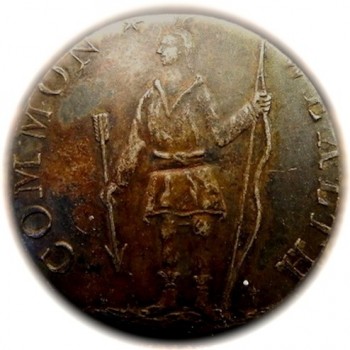
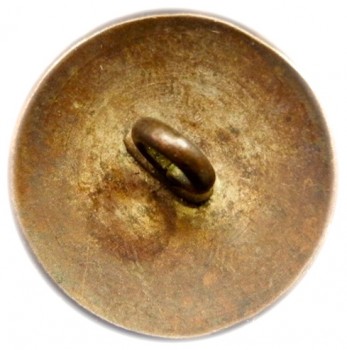
1810 Massachusetts Ancient & Honourable Artillery 1638
Color: A Golden Brown With Some Purple & Blue.
Metal: Low Convex 1-Piece Gilt.
Size: 25mm.
Albert’s Number: MS 46: RV 40
Tice’s Number: MSO 42-A.1
Variation: 5 Point Star.
Present Condition: A Non Excavated Specimen, Exceptional Planchet Condition, A Strong High Relief Pattern Remains.
Robert’s Notes: This popular pattern button was made both in Gilt and Silver Plated Copper around 1810. The high relief pattern depicts a Standing Indian Facing Right, while holding a bow in his left hand, and an arrow in his right. There is a raised five pointed star over his right shoulder. (There is another variant with a 6 pointed star). The inscription COMMON WEALTH circles the button’s outside periphery. The Ancient & Honourable Artillery unit turned into a ceremonial organization during the mid 1800’s, and did “NOT” function as a fighting unit during the Civil War. The different style buttons that followed after the first two original patterns were mostly ceremonial in nature. The Ancient & Honourable Artillery unit acquired it’s first named button in 1799-1800.
Reverse Button Analysis: Slightly concave one-piece button. The shank is original, straight, and intact. No back mark.
The RJ Silverstein Collection.
1810 Massachusetts Ancient & Honourable Artillery 1638
Color: Silver With Copper Highlights.
Metal: Low Convex 1-Piece Silver Plated Copper.
Size: 22.32mm. Coat Size.
Albert’s Number: MS 46: RV 40
Tice’s Number: MSO 42-A.1
Variation: 5 Point Star.
Present Condition: A Non Excavated Specimen, Exceptional Planchet Condition, A Strong High Relief Pattern Remains.
Robert’s Notes: This popular pattern button was made both in Gilt and Silver Plated Copper around 1810. The high relief pattern depicts a Standing Indian Facing Right, while holding a bow in his left hand, and an arrow in his right. There is a raised Five Pointed Star over his right shoulder. (There is another variant with a 6 pointed star). The inscription COMMON WEALTH circles the button’s outside periphery. The Ancient & Honourable Artillery unit turned into a ceremonial organization during the mid 1800’s, and did “NOT” function as a fighting unit during the Civil War. The different style buttons that followed after the first two original patterns were mostly ceremonial in nature. The Ancient & Honourable Artillery unit acquired it’s first named button in 1799-1800.
Reverse Button Analysis: Slightly concave one-piece button. The shank is original, straight, and intact. No back mark.
The RJ Silverstein Collection.
1841 & 42 Massachusetts Ancient & Honourable Artillery 1638
Color: A Faded Gold.
Metal: Flat, 2-Piece, Raised Design, Gilt Brass.
Size: 25.42mm. Coat Size.
Albert’s Number: MS 47: RV 3
Tice’s Number: MS 222-A.2
Variation: A H & A / 1638
Present Condition: A Non Excavated Specimen, A Strong Planchet Condition, An Exceptional High Relief Remains.
Robert’s Notes: The button’s pattern has Ancient & Honourable Artillery’s initials, A & H A in large capital letters. The company’s established date “1638” is in large numbers below. The high relief pattern is set on a plain field with a plain edge. Tice noted in his book that “All were worn on Continental uniforms of a pattern worn by George Washington.” Albert noted inches book that a re-issue with the backmark “D. Evans & Co / Attleboro Mass” was produced in 1848. RV 2
Reverse Button Analysis: This is a flat two-piece button. The shank is original, straight, and intact. No back mark.
The RJ. Silverstein Collection.
1862 Massachusetts Ancient & Honourable Artillery 1638 Ceremonial Button
Color: A Tarnshed Gold.
Metal: Convex, 2-Piece, Raised Design, Gilt Brass.
Size: 15.18mm. Cuff Size.
Albert’s Number: MS 48: RV 2
Tice’s Number: MS 224-As.1
Variation: 1638 / Stipple Base.
Present Condition: An Excavated Specimen, A Strong Planchet Condition, An Exceptional High Relief Remains.
Robert’s Notes: The button’s pattern has the company’s established date “1638” centered in large numbers. There is a Stipple Base within the number cuts. The high relief pattern is set on a plain field with a plain edge. This pattern buttons was used for ceremonial purposes in 1862. They were put on dress coats that were purchased in 1843. There are several known backmarks that were made earlier with this design; anywhere from 1850, 1854 to 1865. *THO. CAHILL* / BOSTON dm made in 1850 is the rarest of them all.
Reverse Button Analysis: This is a two-piece button. The shank is original, straight, and intact. No back mark.
The RJ. Silverstein Collection.

1786 Charlestown Artillery (Uncelebrated History)
Color: Worn Brass.
Metal: Flat, 1-Piece, Raised Design, Gilt Brass.
Size: 24.3mm. Coat Size.
Albert’s Number: MS 83
Pattern Variation: Distressed Cannon / 18 Six Pointed Stars / 15 Cannonballs.
Present Condition: A Non Excavated Specimen, A Strong Planchet Condition, A Strong High Relief Remains.
Robert’s Notes: This company sized artillery unit has a long American History which dates back to the American Revolution. Originally, in the Revolution they served as, “The Military Company.” With strong bonds of kinship in post war they formed their own artillery company in 1786, known as, “Charlestown Artillery.” This Artillery Company should be recognized as one of the first artillery companies established in the United States State Militia because its members fought together as a company in the American Revolution.
Putting this Companies History together was a major feat through history books. Here is their record through old “Massachusetts Adjutant Reports”: Company C, Fifth Regiment, Massachusetts Volunteer Militia (MVM), of Charlestown, was organized May 22, 1786, as the Charlestown Artillery. It was disbanded in 1830, but then reorganized in 1831. Receiving new field pieces delivered by the State Adjutant General. Under the new organization, The Charlestown Artillery Company was assigned to the 2nd Division Third Brigade, 1st Regiment of Artillery, Charlestown Artillery Company MVM. The Charlestown Artillery served as Company C, in the 5th Regiment MVM, and was mustered April 1861 for Three Months Service, the Company participated in the Fist Battle of Bull Run. It would be interesting to see if there was a Federal Period button produced for this company.
The buttons pattern depicts a Large Standing Eagle on top of a Distressed Cannon. The Eagle is facing right in readiness prepared to take flight. The Cannon’s Breech is facing Skyward in a Distressed Position. A Breech Loader is in the forefront of the cannon. Under the cannon is a Battered Fallen Flag. There is an unused pyramid of 15 Cannon Balls stacked in a Pyramid Shape on the L-H-S of the cannon. There is 18 Six Pointed Stars circling the Legend.
Reverse Button Analysis: This is a one-piece button. The shank is missing.
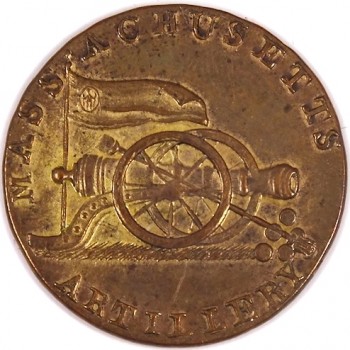

1800-1825 Massachusetts State Militia Artillery Unit
Color: A Forest Green with Brown Undertones.
Metal: Flat, 1-Piece, Gilt Brass.
Size: 25mm.
Albert’s Number: MS 18: RV 40
Tice’s Number: MSO 34
Present Condition: A Non Excavated Specimen, An Exceptional Planchet Condition, An Exceptional High Relief Pattern Remains.
Robert’s Notes: Originally, the Massachusetts Militia Artillery purchased these buttons from an American owned manufacturers in Boston. After awhile several manufacturers made this including ones in England. The button’s pattern depicts a an Old Style Cannon in the center Pointing Left. The cannon’s carriage extends to the wheel axel, and shows five carriage bolts. On the right hand side behind the cannon is a raised flag with a motif of a Small Standing Indian within a Circle. There is a Pile of Cannon Balls stacked with a Gaming Sponge in front of the cannon. The state’s name, “ MASSACHUSETTS” is in an arc along the top legend, and the word, “ARTILLERY” is written below in a semicircle. Collectors usually seek A.M PEASLEY. Recently there was a 6-8 found in New Boston New Hampshire.
Reverse Button Analysis: This is a flat one-piece button with a loop shank. The shank is original, straight and intact.
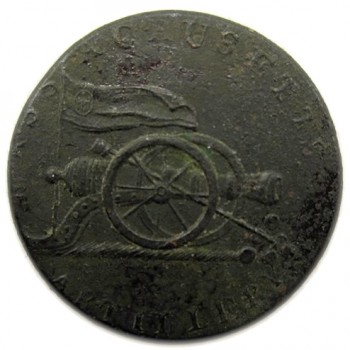

1800-1825 Massachusetts State Militia Artillery Unit
Color: A Forest Green with Brown Undertones.
Metal: Flat, 1-Piece, Gilt Brass.
Size: 25mm.
Albert’s Number: MS 18: RV 40
Tice’s Number: MSO 34
Present Condition: An Excavated Specimen, Strong Planchet Condition, A Strong High Relief Pattern Remains.
Robert’s Notes: This button is from the original A.M. Peasly order. The button’s pattern depicts a an Old Style Cannon in the center Pointing Left. The cannon’s carriage extends to the wheel axel, and shows five carriage bolts. On the right hand side behind the cannon is a raised flag with a motif of a Small Standing Indian within a Circle. There is a Pile of Cannon Balls stacked with a Gaming Sponge in front of the cannon. The state’s name, ” MASSACHUSETTS” is in an arc along the top legend, and the word, “ARTILLERY” is written below in a semicircle. Originally, the Massachusetts Militia Artillery purchased these buttons from an American owned manufacturers in Boston. After awhile several manufacturers made this pattern including button makers in England.
Reverse Button Analysis: This is a flat one-piece button with a loop shank. The shank is original, straight and intact. Sixteen raised asterisk type stars encircle in a depressed channel (A.M. PEASLY BOSTON’S back mark). 2 rm small rings within.
Excavated in New Boston, New Hampshire (1 of 2 found together).
The RJ Silverstein Collection.
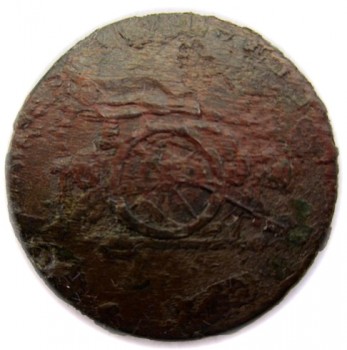

2nd one found in New Boston.
The R. Lissy Collection.
Maine Infantry Militia
Maine is both the most northern, and eastern state in the United States. The Atlantic Ocean lies on it’s eastern border, with the state of New Hampshire to the West, and Canadian provinces of Quebec and New Brunswick to the north. Some historians believe that it’s name comes from the mariner Jargon, who would differentiate the “mainland” from the myriad of islands off the Atlantic Coast. The first European settlement was in 1604, by Pierre Dugua on Saint Croix Island. Then two Jesuit missions were established by the French some 10-12 years later. The first English settlement was established by the Plymouth Company in 1607, but unfortunately due to the rugged climate, and the constant conflicts with the local natives, the English Popham Colony was short lived. A number of colonies eventually sprung up along the coast line in the 1620’s, but most of them were also short lived due to the same underlining reasons. The few sparsely populated settlements that did survive in that rugged region accepted control by the Massachusetts Bay Colony. In the beginning, the Massachusetts’s “Puritan” social and ethical convictions were welcomed by Maine colonists, and by 1652 it was a way of life for people. Then for the next hundred and fifty years, Massachusetts and Maine were as one in embodiment under the “Commonwealth of Massachusetts.” Maine had a scarce population, and relied upon Massachusetts’s Militia for help if need be. Then a combination of events in the early 1800’s caused Maine to look toward secession from the Commonwealth. First was a long standing disagreements over land speculations and settlements in 1807. This caused the first attempt for Maine to secede from Massachusetts by vote, but it failed. Then it wasn’t until the War of 1812, when it came to a head once more. Massachusetts’s Pro-British merchants opposed the war, and it’s militia refused to defend Maine against the British invaders. By 1819, Massachusetts agreed for Maine to secede if voters called for it. They won the vote, and finally seceded from the Commonwealth of Massachusetts in 1820. Maine was the 23rd state to join the Union on March 15, 1820.
Later that year, Maine was admitted to the “Union” as the 23rd state under the Missouri Compromise. Also in 1820, the State of Maine Legislature convened, and immediately adopted their own State of Arms. This design shows a shield emblazoned with a stately White Pine with a Moose below. A husbandman is resting on a scythe representing agriculture is on one side of the shield, and the other side has a seaman leaning on an anchor. A crest above contains the North Star which was taken from the Massachusetts’s seal. Maine’s motto, “Diringo” which means, “I Direct” is symbolic of Maine helping mariners find there way alludes to the North Star. By the early 1820-30’s, Maine began to organize more of their own volunteer militia companies. Even with the War of 1812 ending a short time ago, these new volunteers unfortunately had little or no military field experience. By 1851, they undergone a reorganization to a uniformed volunteer militia. Still mostly ceremonial at this point, but growing in numbers. By 1861, there were thirty five Volunteer companies in three military divisions. With the onset of the Civil War, Maine was able raise 15 regiments of infantry, a cavalry regiment, and five light artillery batteries. Early Maine Militia buttons only used Maine’s State of Arms “North Star” symbol as their button main pattern. Not the complete State of Arms symbol. Several variations of the North Stars emerged, some with lines, some with beveled edges, some with ropes, and some florals within. These were all one-piece buttons in various metals. In 1856, the Legislature changed the militia’s North Star pattern to the complete Maine State of Arms symbol, which includes the North Star. Scovill produced the first examples in 1857, and by 1861 they were a standard for all Maine troops.
1830’s Maine State Militia, General Use
Color: A Distressed Brass Yellow.
Metal: Flat, 1-Piece, Raised Design, Gilt Brass.
Size: 21.63mm. Coat Size.
Albert’s Number: ME 4-A: RV 4
Tice’s Number: ME 100 A.1 Gilt Variation
Variation: Large 11mm Wide American 5 Pointed Star / Beveled Flat Rays / 17 Small American 5 Pointed Stars.
Present Condition: A Non Excavated Specimen, A Strong Planchet Condition, A Strong High Relief Pattern Remains.
Isabela’s Notes: This button was made in the 1830’s for Maine’s State Volunteer Militia. There is 2 known backmarks depicting a Large 17mm Center Star. The Star was the chosen symbol for Maine’s State Militia in the 1830’s, but it was never officially adopted for the State Seal. In the 1830’s outfitters applied them onto headgear as well as their coats. Maine took the symbol of the North Star from the Massachusetts’s Militia Coat of Arms when they broke away and became an independent state. This button’s pattern depicts a Large 11mm Wide American Five-Point Star in the center. The star has Beveled Flat Rays. Circling around the legend is 17 Small American 5 Pointed Stars pointing outwards. The high relief pattern is set on an evenly lined field with a raised flat edge. Great button for collectors because of the wide number of pattern variations, and available specimens.
Reverse Button Analysis: This is a one-piece button with a loop shank. The shank is original straight, and intact. LONDON RICH QUALITD dm ring/inner ring of 8 six pointed Asterisk Type stars.
The RJ Silverstein Collection.

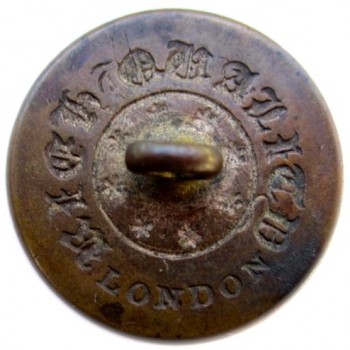
1830’s Maine State Militia, General Use
Color: Silver Remnants With A Mixed Light & Dark Chocolate Undertone.
Metal: Flat, 1-Piece, Raised Design, Silver Plated.
Size: 21.66mm. Coat Size.
Albert’s Number: ME 4-A: RV 4
Tice’s Number: ME 100 A.1 Silver-Plated Variation
Variation: Large 11mm Wide American 5 Pointed Star / Beveled Flat Rays / 17 Small American 5 Pointed Stars.
Present Condition: A Non Excavated Specimen, A Strong Planchet Condition, A Strong High Relief Pattern Remains.
Isabela’s Notes: This button was made in the 1830’s for Maine’s State Volunteer Militia. There is 2 known backmarks depicting a Large 17mm Center Star. The Star was the chosen symbol for Maine’s State Militia in the 1830’s, but it was never officially adopted for the State Seal. In the 1830’s outfitters applied them onto headgear as well as their coats. Maine took the symbol of the North Star from the Massachusetts’s Militia Coat of Arms when they broke away and became an independent state. This button’s pattern depicts a large 11mm Wide American Five-Point Star in the center. The star has Beveled Flat Rays. Circling around the legend is 17 Small American 5 Pointed Stars pointing outwards. The high relief pattern is set on an evenly lined field with a raised flat edge. Great button for collectors because of the wide number of pattern variations, and available specimens.
Reverse Button Analysis: This is a one-piece button with a loop shank. The shank is original straight, and intact. LONDON RICH QUALITD dm ring/inner ring of 8 six pointed Asterisk Type stars.
The RJ Silverstein Collection.
1830’s Maine State Militia, General Use
Color: A Bright Gold.
Metal: Flat, 1-Piece, Raised Design, Brass.
Size: 21mm. Coat Size.
Albert’s Number: ME 4:
Tice’s Number: ME 100-B.3 Backmark Variation
Variation: Small 11mm Center Star / Beveled Flat 5 Point Star / 17 Small American 5 Pointed Stars.
Present Condition: A Non Excavated Specimen, A Strong Planchet Condition, An Exceptional High Relief Pattern Remains.
Isabela’s Notes: This button was made in the 1830’s for Maine’s State Volunteer Militia. There is 10 known backmarks depicting a Small 11mm Center Star. The Star was the chosen symbol for Maine’s State Militia in the 1830’s, but it was never officially adopted for the State Seal. In the 1830’s outfitters applied them onto headgear as well as their coats. Maine took the symbol of the North Star from the Massachusetts’s Militia Coat of Arms when they broke away and became an independent state. This button’s pattern depicts a Small 11mm Wide American Five-Point Star in the center. The star has Beveled Flat Rays. Circling around the legend is 17 Small American 5 Pointed Stars pointing outwards. The high relief pattern is set on an evenly lined field with a raised flat edge. Great button for collectors because of the wide number of pattern variations, and available specimens.
Reverse Button Analysis: This is a one-piece flat button with a loop shank. The shank is original straight, and intact. IMPERIAL / (dot) (star) (dot) STANDARD (dot) (star) (dot)” rmdc, backmark was a trademark denoting quality, and was probably manufactured in England, Imperial 02.
Picture Courteous of Harry Ridgeway.
1830’s Maine State Militia, General Use
Color: Worn Silver With Brass Undertones.
Metal: Flat, 1-Piece, Raised Design, Silver-Plated.
Size: 21.52mm. Coat Size.
Albert’s Number: ME 4: Unlisted Variant.
Tice’s Number: ME 100 B.6
Variation: Smaller 8mm American 5 Pointed Star / Beveled Flat Rays / 17 Small 5 Point Stars.
Present Condition: A Non Excavated Specimen, A Strong Planchet Condition, A Strong High Relief Pattern Remains.
Isabela’s Notes: This button is identical to the “A” variant except it has a smaller 8mm Center Star. There are 10 known backmarks, and come in both Gilt and Silver-Plating. The button’s pattern depicts a Smaller 8mm American 5 Pointed Star in the Center. The star’s has Beveled Flat Rays. Circling around the legend is 17 Smaller American 5 Pointed Stars pointing outwards. The high relief pattern is set on an evenly lined field with a wide raised flat edge. This is a great button for collectors because of the wide number of backmarks.
Reverse Button Analysis: This is a flat one-piece button with a loop shank. RICH is in a sun rays / STANDARD is in Old English calligraphy.
The RJ Silverstein Collection.

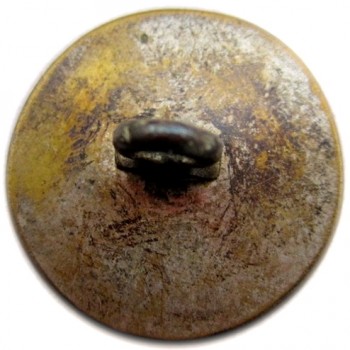
1830’s Maine State Militia, General Use
Color: A Coppery Gold With Silver Pockets.
Metal: Flat, 1-Piece, Raised Design, Silver-Plated.
Size: 22.69mm. Coat Size.
Albert’s Number: ME 4-C: RV 8
Tice’s Number: ME 100 F.5
Variation: Large American 5 Pointed Star / Alternating Flat and Lined Rays / Beveled Outside Border.
Present Condition: A Non Excavated Specimen, A Strong Planchet Condition, A Strong High Relief Pattern Remains.
Robert’s Notes: This button has a Large raised American 5 Pointed Star in the center. There is a considerable number of die variations in this group, and some variants depict a rope border. The button can be found in both Gilt and Silver-Plating. There are 6 known backmarks, and AM Peasley appears to have the earliest known. This button’s pattern depicts a Large Raised American Five Pointed Star in the center. The Star’s Rays are Beveled and depict Alternating Flat and Lined Rays. The high relief pattern is set on a plain flat field with a wide raised edge border that has an incuse cut ring on the outside. This pattern is great button for Militia collectors because of the wide number of patterns and sub-variations that are obtainable.
Reverse Button Analysis: This is a flat one-piece button with a loop shank. The shank is original straight, and intact. No back mark.
Maine was admitted to the Union in 1820, Aaron Peasley out of Boston made this button for three years, from 1820-23.
The RJ Silverstein Collection.
1830’s Maine State Militia, General Use
Color: Brass W/ Orange Undertones.
Metal: Flat, 1-Piece, Raised Design, Gilt Brass.
Size: 21.69mm.
Albert’s Number: ME4E: RV 6
Tice’s Number: ME 100 E-3
Variation: Large Raised 5 Pointed American Star /Concentric Solid Ring /Ring of 20 Five Pointed Stars.
Present Condition: An Excavated Specimen, A Strong Planchet Condition, An Exceptional High Relief Pattern Remains.
Isabela’s Notes: For this pattern there are two known backmarks that were struck over older civilian buttons. This button’s pattern depicts a Large Raised 5 Pointed American Star that is within a raised Concentric Solid Ring. Circling around the legend is a Ring of 20 Five Pointed Stars 180 deg. pointing outwards. The high relief pattern is set on a plain flat field with a thin raised edge giving an appearance of a channel for the circling legend stars.
Reverse Button Analysis: This is a flat one-piece button with a loop shank. The shank is original straight, and intact. R & W. ROBINSON / (dot) ATTLEBOROUGH (dot) / EXTRA / (dot) (star) (dot) (star) (dot) (star) (dot) RICH (dot) (star) (dot) (star) (dot) (star) (dot) rm with four raised rings, ca 1830’s, Robinson RW13.
The RJ Silverstein Collection.
1830’s Maine State Militia, General Use
Color: Brass Yellow.
Metal: Flat, 1-Piece, Raised Design, Gilt Brass.
Size: 23mm. Coat Size.
Albert’s Number: ME 4-F: RV 5
Tice’s Number: ME 100-G.1 Backmark Variation
Variation: American 5 Pointed Star / 13 Petal Flower / 12 Inner Petals / Closed Center Stigma / 4 Petal Flower / 3 Loose Petals / 20 Five Pointed-Stars.
Present Condition: A Non Excavated Specimen, An Exceptional Planchet Condition, An Exceptional High Relief Pattern Remains.
Isabela’s Notes: This button’s pattern has two known backmarks for the coat and cuff size. This die variant comes in both Gilt and Silver-Plating. The button’s pattern depicts a raised outline of an American 5 Pointed Star that is decorated with floral elements inside. Within the star’s center is a large wheel-like 13 Petal Flower that has an inner ring of 12 Petals. The flower has a Closed Center Stigma. In each of the star’s rays is Four Petals that flow into the point. Circling around the legend is 20 American Five-Pointed Stars 180 deg. pointing outwards. The stars are set between a raised Solid Concentric Ring and a thin raised edge. The button’s high relief pattern is set on an evenly lined field.
Reverse Button Analysis: This is a one-piece button with a loop shank. The shank is original straight, and intact. THOMAS POTTS / EXTRA RICH within a 2 dm ring.
The William Leigh Collection.
1830’s Maine State Militia, General Use
Color: Bright Brass Yellow.
Metal: Flat, 1-Piece, Raised Design, Gilt Brass.
Size: 15mm. Cuff Size.
Albert’s Number: ME 4-F
Tice’s Number: ME 100-Gs.1
Variation: American 5 Pointed Star / 11 Petal Spindle Type Flower / Closed Center Stigma / 2 Raised Stipples / 4 Loose Petals / 20 Five Pointed-Stars.
Present Condition: A Non Excavated Specimen, An Exceptional Planchet Condition, An Exceptional High Relief Pattern Remains.
Isabela’s Notes: With this variant the T POTTS / Extra Rich backmarks were Silver-Plated. The button’s pattern depicts a raised outline of an American 5 Pointed Star that is decorated with floral elements inside. Within the star’s center is an 11 Petal Spindle Type Flower that has a Closed Center Stigma. In each of the rays just outside of the center flower is Two Raised Stipples. This precedes Four Petals that flow into the point. Circling around the legend is 20 Five-Pointed Stars 180 deg. pointing outwards. The stars are set between a solid raised ring and a plain raised edge. The button’s high relief pattern is set on an evenly lined field.
Reverse Button Analysis: This is a one-piece button with a loop shank. The shank is original straight, and intact. THOMAS POTTS / EXTRA RICH within a 2 dm ring.
The William Leigh Collection.
1830’s Maine State Militia, General Use
Color: A Golden Reddish-Copper.
Metal: Flat, 1-Piece, Raised Design, Gilt Brass.
Size: 23.01mm. Coat Size
Albert’s Number: ME 4-G: RV 6 ?
Tice’s Number: ME 100-H.2 Variation
Variation: American 5 Pointed Star / 10 Petal Flower W/ Open Stigma / 4 Petal Flower / 3 Loose Petals / 38 Chain link Border.
Present Condition: An Excavated Specimen, A Strong Planchet Condition, An Exceptional High Relief Pattern Remains.
Isabela’s Notes: I believe Albert’s book RV rating must be inaccurate. I have only seen two specimens in the past. There are 2 known backmarks for the coat and 2 for the cuff size. The button’s pattern depicts a raised outline of an American 5 Pointed Star that is decorated with floral elements inside. Within the star’s center is a large 10 Petal Flower with an Open Stigma. In each of the star’s rays is a small 4 Petal Flower with 3 Loose Petals flowing into the point. Circling around the star’s legend is a Chain of 38 Links that is set between a solid raised ring and a plain raised edge. The high relief pattern is set on an evenly lined field.
Reverse Button Analysis: This is a one-piece button with a loop shank. The shank is original straight, and intact. THOMAS POTTS / EXTRA RICH dm.
1830’s Maine State Militia, General Use
Color: Brass Yellow.
Metal: Flat, 1-Piece, Raised Design, Gilt Brass.
Size: 15.02mm. Cuff Size.
Albert’s Number: ME 4-G: Unlisted Size
Tice’s Number: ME 100-Hs.2
Variation: American 5 Pointed Star / 11 Petal Flower With Closed Stigma / 5 Petal Flower / 3 Loose Petals / 38 Link Chain Border / Crosshatch Lined Field.
Present Condition: A Non Excavated Specimen, A Strong Planchet Condition, An Exceptional High Relief Pattern Remains.
Isabela’s Notes: This cuff variant also comes in plated silver. The button’s pattern depicts a raised outline of an American 5 Pointed Star that is decorated with floral elements inside. Within the star’s center is a large 11 Petal Flower with an Closed Stigma. In each of the star’s rays is a small 5 Petal Flower with 3 Loose Petals flowing into the point. Circling around the star’s legend is a Chain of 38 Links that is set between a solid raised ring and a plain raised edge. The high relief pattern is set on a Crosshatch Lined Field with a thin raised edge border.
Reverse Button Analysis: This is a one-piece button with a loop shank. The shank is original straight, and intact. * TREBLE * / GILT dm inside of two rings of stipples.
The William Leigh Collection.
1857-60’s Maine State Militia Officer’s Cuff
Color: A Brass Yellow With Brown Pattern Highlights.
Metal: 3-Piece, High Convex, Raised Design, Gilt Brass.
Size: 14.07mm. Hat or Cuff Size.
Albert’s Number: ME 1-Av: RV 5
Tice’s Number: ME 200-As.1
Variation: Maine’s State Coat of Arms / 5 Pointed American Star W/ Rays / 18 Five Pointed Stars / Maine.
Present Condition: An Excavated Specimen, Good Planchet Condition, An Fair High Relief Pattern Remains.
Isabela’s Notes: The state of Maine approved this pattern for it’s volunteer militia in 1856. Scovills started producing these buttons in 1857, and by 1861, this was the standard for all Maine troops serving in the Civil War. There appears to be at least two cuff variants with 7 known backmarks. The button can be found in both Gilt and Silver-Plated versions. The pattern main difference is if the Star above has Rays or not. The button’s pattern depicts a variation of the state of Maine’s Coat of Arms. There is a Five Pointed American Star above with emanating Rays. The state’s name, “Maine” in a banner ribbon below. Circling around the outside legend is 18 Five-Pointed American Stars. The high relief pattern is set on an evenly lined convex field.
Reverse Button Analysis: This is a three-piece button with a loop shank. The shank is missing. * CANFIELD. BRO & CO. / BAL inner dm stipple ring.


1857-60’s Maine State Militia Officer’s Cuff
Color: A Golden Brass Yellow.
Metal: 3-Piece, High Convex, Raised Design, Brass.
Size: 14.09mm. Hat or Sleeve size
Albert’s Number: ME 1: RV 5
Tice’s Number: ME 200-As.2
Variation: Maine’s State Coat of Arms / 5 Pointed American Star / Maine.
Present Condition: An Excavated Specimen, Strong Planchet Condition, An Exceptional High Relief Pattern Remains.
Isabela’s Notes: The state of Maine approved this pattern for it’s volunteer militia in 1856. Scovills started producing these buttons in 1857, and by 1861, this was the standard for all Maine troops serving in the Civil War. There appears to be at least two cuff variants with 7 known backmarks. The button can be found in both Gilt and Silver-Plated versions. The pattern main difference is if the Star above has Rays or not. The button’s pattern depicts a variation of the state of Maine’s Coat of Arms. There is a Five Pointed American Star above and the state’s name, “Maine” in a banner ribbon below. Circling around the outside legend is 18 Five-Pointed American Stars. The high relief pattern is set on an evenly lined convex field.
Reverse Button Analysis: This is a three-piece button with a loop shank. The shank is missing. * CULLEN BROWN/DETROIT. 2 inner dm rings.
The Picture is Courteous of H. Ridgeway.
1850 Maine State 3rd Volunteer Infantry, Bath City Grays.
Color: Dirty Brass Yellow.
Metal: Convex, 2-Piece, Raised Design, Gilt Brass.
Size: 23.01mm. Coat Size.
Albert’s Number: ME 10 RV 08
Tice’s Number: ME 270A.1
Variation: American Shield / 13 Five Pointed Stars / 13 Lines W/ Alternating Thickness / Grays.
Present Condition: A Non Excavated Specimen, Strong Planchet Condition, Strong High Relief Pattern Remains.
Isabela’s Notes: The Robinson brothers made these buttons at Attleborough in 1850. In 1854, the fine uniform appearance of the company led to many appearances throughout Northern England during the know nothing anti-immigrant disturbances. The Grays entered Federal service on June 4, 1861, as Company A, 3rd Maine Volunteer Infantry. The buttons pattern depicts an American Shield with 13 Five Pointed Stars set on a lined background. In the lower half of the shield is 13 Lines with Alternating Thick and Thin Bars. Below the shield is the company’s name “GRAYS” in thick letters. The high relief pattern is set on an evenly lined field with a raised flat edge border. They are known to have two different back marks. The only distinction is the size of the backmark letters.
Reverse Button Analysis: This is a slightly convex two-piece button with a soldered on copper loop shank. The shank is original, straight, and intact *R & W. ROBINSON*/ EXTRA RICH dm large letters with one inside ring.
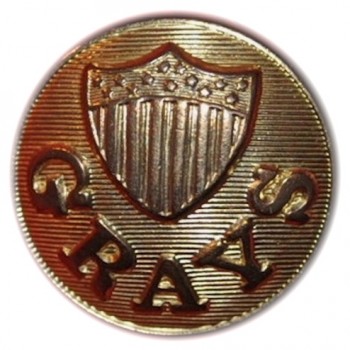

1850 Maine State 3rd Volunteer Infantry, Bath City Grays.
Color: A Coppery-Redish Gold.
Metal: Convex, 2-Piece, Raised Design, Gilt Brass.
Size: 23.05mm. Coat Size.
Albert’s Number: ME 10 RV 08
Tice’s Number: ME 270A.2
Variation: American Shield / 13 Five Pointed Stars / 13 Lines W/ Alternating Thickness / Grays.
Present Condition: A Non Excavated Specimen, Strong Planchet Condition, An Exceptional High Relief Pattern Remains.
Isabela’s Notes: The Robinson brothers made these buttons at Attleborough in 1850. They are known to have two different back marks. In 1854, the fine uniform appearance of the company led to many appearances throughout Northern England during the know nothing anti-immigrant disturbances. The Grays entered Federal service on June 4, 1861, as Company A, 3rd Maine Volunteer Infantry. The only distinction is the size of the backmark letters. The buttons pattern depicts an American Shield with 13 Five Pointed Stars set on a lined background. In the lower half of the shield is 13 Lines with Alternating Thick and Thin Bars. Below the shield is the company’s name “GRAYS” in thick letters. The high relief pattern is set on an evenly lined field with a raised flat edge border.
Reverse Button Analysis: This is a slightly convex two-piece button with a soldered on copper loop shank. The shank is original, straight, and intact *R & W. ROBINSON*/ EXTRA RICH dm small letters with 2 inside & 1 outside ring.
Mississippi Infantry Units
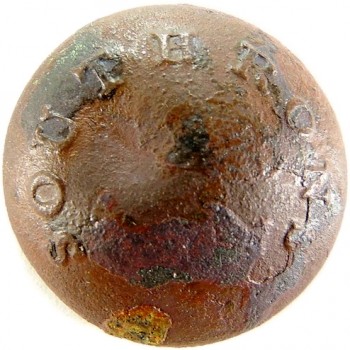
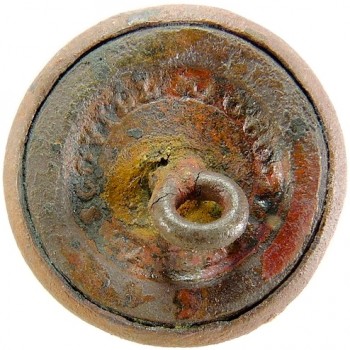
1850 Mississippi State Regiment of Volunteers
Color: An Orangish-Brown.
Metal: Round, 2-Piece, Raised Design, Gilt Brass.
Size: 23.10mm.
Albert’s Number: MP 9 RV 10
Tice’s Number: MP-270
Variation: SOUTHRONS / Round Planchet.
Present Condition: An Excavated Specimen, Good Planchet Condition, A Strong High Relief Pattern Remains.
Isabela’s Notes: This button depicts, “Southrons” in raised letters on a plain field. This button was intended for volunteer Southrons of Vicksburg. This unit was organized before the civil war and eventually became Company A of the 21st Mississippi Infantry.
Reverse Button Analysis: This is a two-piece button with a loop shank. The shank is original, straight, and intact. Scovill MFG CO /. Waterbury . RMDC (Scovill.650.Coat).
Dug in Murfreesboro, TN by Ropy Blick.
Picture of Harry Ridgeway.
Missouri Infantry Militia
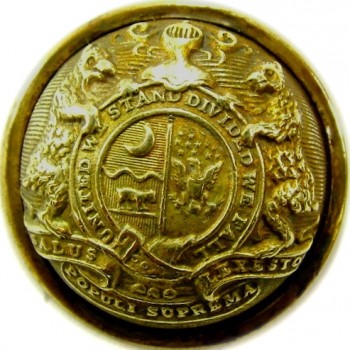

1860 Missouri’s State Militia Infantry Officer’s Button
Color: Whitewash Gold.
Metal: 3-Piece, High Convex, Raised Design, Brass.
Size: 22.3mm.
Albert’s Number: MO 1-A: RV 10
Tice’s Number: MO200A.1
Variation: 12 Stars above Eagle / Helmet Has 6 Bars / Wavy Line Under Crescent.
Present Condition: A Non Excavated Specimen, StrongPlanchet Condition, A Strong High Relief Pattern Remains.
Isabela’s Notes: The back mark indicates that this button was manufactured by Scovills in the early 1860’s, but used the original die variant. This button was intended for the Missouri Militia officers who generally sided with the North, but were known to serve both sides. The button’s pattern depicts the Missouri State Seal of a split shield symbolizing that the State and Federal government have separate functions, but are united as one. Within the shield is an eagle on one side with 12 five-pointed stars above. The other side has a crescent moon on a horizontal lined field with a wavy line underneath. Beneath the wavy line is a walking bear on a vertical lined field. Encircling the design is the motto in raised capital letters, UNITED WE STAND DIVIDED WE FALL. Surmounting the top of the shield is a helmet with Six bars. Flanking each side of the shield is two large standing Grizzly Bears. Underneath in the legend is a scroll with the Latin saying, “Salus Populi supema Lex Esto”, which means, “Let the good of the people be the supreme law.” The whole raised pattern is set upon a high convex lined field with a 3-piece false rim. This particular die variant was used prior to 1860, and then was re-introduced with a later back mark for the Civil War years.
Reverse Button Analysis: This is a three-piece button with a loop shank. The shank is original, straight, and intact. SCOVILL MF’G CO, / WATERBURY small depressed letters within 2 rings of dots.
The Picture is Courteous of H. Ridgeway
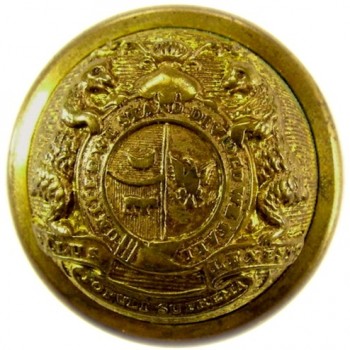
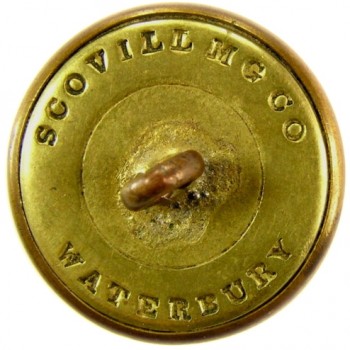
1850 Missouri’s State Militia Infantry Officer’s Button
Color: Antique Gold.
Metal: 3-Piece, High Convex, Raised Design, Brass.
Size: 22.3mm.
Albert’s Number: MO 2: RV 10
Tice’s Number: MO205A.1/ Tice PG 71 back marks.
Variation: No Stars above Eagle / Divider Under Crescent is an Arc.
Present Condition: A Non Excavated Specimen, Exceptional Planchet Condition, An Exceptional High Relief Pattern Remains.
Isabela’s Notes: The back mark indicates that this button was manufactured by Scovills in the early 1850’s. Intended for Missouri Militia officers who generally sided with the North, but were known to serve both sides during the Civil War. This early button’s pattern depicts the Missouri State Seal of a split shield which symbolizes the State and Federal government are separate in their duties, but are united as one. In this variant, the one side of the shield has a spread eagle on a plain field with no stars above. The other side has a crescent moon on a horizontal lined field with an arc divider underneath. Beneath the divider is a smaller bear on a vertical lined field. Encircling the design is the motto in raised capital letters, UNITED WE STAND DIVIDED WE FALL. Surmounting the top of the shield is a Helmet with Six bars. Flanking each side of the shield is Two large standing Grizzly Bears. Underneath in the legend is a scroll with the Latin saying, “Salus Populi supema Lex Esto”, which means, “Let the good of the people be the supreme law.” The whole raised pattern is set upon a high convex lined field with a 3-piece false rim.
Reverse Button Analysis: This is a three-piece button with a loop shank. The shank is original, straight, and intact. SCOVILL MG CO/WATERBURY dm.
New Hampshire Infantry Units
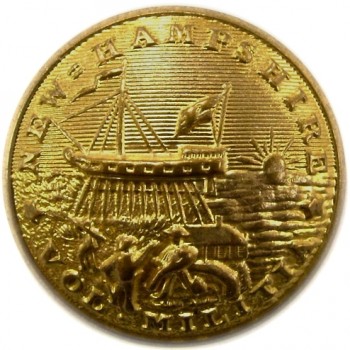
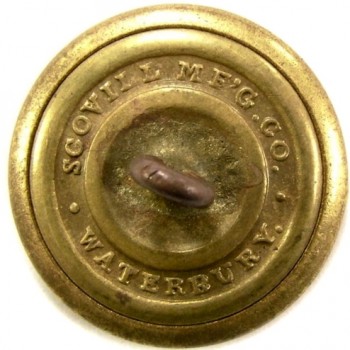
1850’s New Hampshire State Militia Infantry Unit
Color: Crisp Brass With Light Golden Brown Undertones.
Metal: Convex, 2-Piece, Raised Design, Gilt Brass.
Size: 23mm.
Albert’s Number: NH 6: RV 5
Tice’s Number: NH 200 A.2
Variation: New=Hampshire / Double Hyphen / Slanting Foremast Touches E / Sun Short Radiating Lines.
Present Condition: A Non Excavated Specimen, Strong Planchet Condition, An Exceptional High Relief Pattern Remains.
Robert’s Notes: Even though manufactured earlier, this button was the standard Civil War button for New Hampshire Infantry units. This was first used in 1855, by the Battalion of Amoskeag of Manchester, N.H. Since most large manufacturers produced this pattern, there appears to be more then 5 or 6 variations for the coat size, and several different ones in the cuff size. There are quite a few differences depicted for the State of Arms. Anything from the use of a hyphen, to the building depicted, the size of the sun, the angle and position of the boat’s foremast, and the position of the flag. This button’s pattern depicts New Hampshire’s State of Arms on a lined field. Arced in the legend above, is the states name, “NEW=HAMPSHIRE” in all capital letters, and this die variant uses a Double Hyphen. The boat’s Slanting Foremast Touches the Tip of the,“E” in the word NEW. The boat’s flag is shown at half mast gently blowing. There is a small Sun, with Short Radiating Lines. In the legend below is the abbreviation for volunteer,“VOL.” which is followed by an abbreviated dot, and then the word, “MILITIA.” The high relief pattern is set on a convex lined field with a thin edge border. This is a strong collector’s favorite because of all the variations.
Reverse Button Analysis: This is a 2-Piece button with a loop shank. . SCOVILL MF’G. CO. /. WATERBURY. rmdc on a stippled background. (ScovillM250)
The RJ Silverstein Collection.
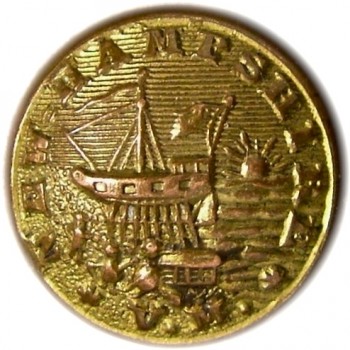
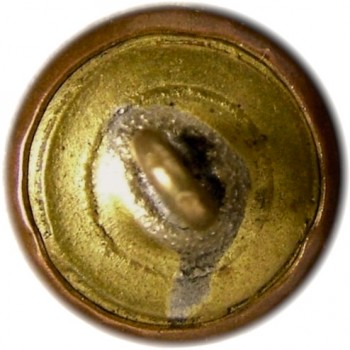
1850’s New Hampshire State Militia Infantry Unit
Color: Crisp Brass With Light Golden Brown Undertones.
Metal: Convex, 2-Piece, Raised Design, Copper.
Size: 14mm.
Albert’s Number: NH 6: RV 5
Tice’s Number: NH 200 AS.3
Variation: New=Hampshire / Double Hyphen / VM for Volunteer Militia / Slanting Foremast Points toward the hyphen / Sun Short Radiating Lines.
Present Condition: A Non Excavated Specimen, Strong Planchet Condition, An Exceptional High Relief Pattern Remains.
Robert’s Notes: This button was probably made by Steele and Johnson in 1860’s. This button’s pattern is a crude depiction of New Hampshire’s State of Arms on a copper face. Circling around the upper half of the legend is the states name, “NEW=HAMPSHIRE” in all capital letters; and uses a Double Hyphen in-between the words. Circling around the lower legend, is the initials, “V.M.”, for Volunteer Militia. Separating the states name, and bottom legend’s inscription is Two Five Pointed Stars. There is a small boat floating on gentle waters, and the Slanting Foremast is pointing toward the, “Hyphen” in-between the states name. In this die variant, the main mast is in the ship’s center, and the boat’s flag is gently blowing in the wind. This die variant shows a very Small Cabin Type Building, with three individuals outside. There is a small sun, with short radiating lines. The high relief pattern is set on a convex field with a thin edge border. These cuff buttons are a nice variation to the coat examples.
Reverse Button Analysis: This is a 2-Piece button with a loop shank. Blank back mark (BlankNorth 04) dm inner ring.
Picture Courteous of Harry Ridgeway.
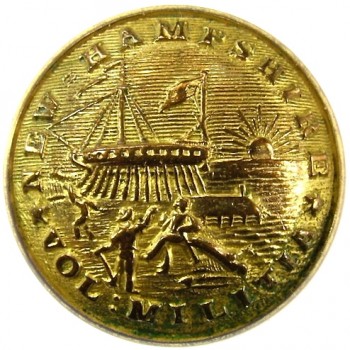
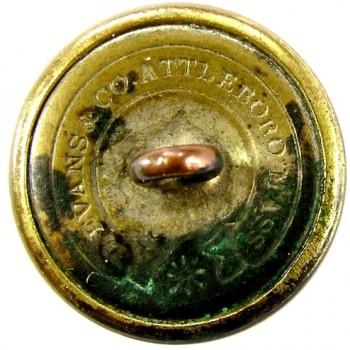
1855-60’s New Hampshire State Militia Infantry Unit
Color: Golden Brass With Green Encrustations.
Metal: Convex, 2-Piece, Raised Design, Gilt Brass.
Size: 23mm.
Albert’s Number: NH 6: RV 5
Tice’s Number: NH 200 C.1
Variation: Double Hyphen / Vol: is Followed By Colon / Two Five Pointed Stars / Slanting Foremast is Found Between the E & W / Flat Roof that Resembles a Wharf.
Present Condition: An Excavated Example, Strong Planchet Condition, Strong, An Exceptional High Relief Pattern.
Robert’s Notes: Even though manufactured prior to the Civil War, this button was the standard for New Hampshire Infantry units. This was first used in 1855, by the Battalion of Amoskeag of Manchester, N.H. Since most large manufacturers produced this pattern, there appears to be more then 5 or 6 variations for the coat size, and several different ones in the cuff size. There are quite a few differences depicted for the State of Arms. Anything from the use of a hyphen, to the building depicted, the size of the sun, the angle and position of the boat’s foremast, and the position of the flag. This button’s pattern depicts New Hampshire’s State of Arms on a lined field. Arced in the legend above is the states name, “NEW=HAMPSHIRE” in all capital letters, and uses a Double Hyphen in-between the words. In the lower legend, the abbreviation for volunteer, “VOL:” is followed Colon, and then the word, “MILITIA.” Separating the states name, and bottom legend’s inscription is Two Five Pointed Stars. The boat in this variant is floating on calm waters, and the Slanting Foremast is found between the,“E” and the, “W” in the word NEW. In this variant, the boat’s flag is blowing gently in the wind. The building in this die variant has a Flat Roof that Resembles a Wharf. There is a small sun, with short radiating lines. The high relief pattern is set on a convex field with a thin edge border. This is a strong collector’s favorite because of all the variations.
Reverse Button Analysis: This is a 2-Piece button with a loop shank. D.EVANS & CO ATTLEBORO. MASS dm in ribbon reading clockwise, flower at bottom (Evans07)
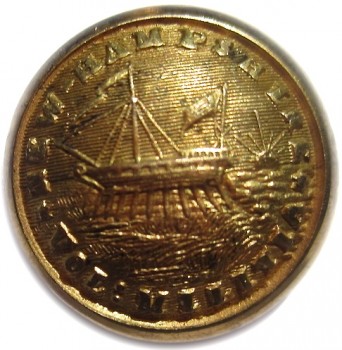
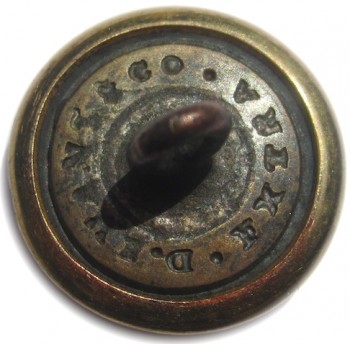
1850’s New Hampshire State Militia Infantry Unit
Color:
Metal: High Convex, 2-Piece, Raised Design, Gilt Brass.
Size: 15mm.
Albert’s Number: Similar to NH 6: Unlisted back mark Variant RV 25
Tice’s Number: NH 200 UNCL-C.1
Variation: Single Hyphen / Vol: is Followed By Colon / Two Five Pointed Stars / Slanting Foremast is Found Between the E & W / Flat Roof that Resembles a Wharf.
Present Condition: An Excavated Example, Strong Planchet Conditon, Strong, An Exceptional High Relief Pattern Remains.
Robert’s Notes: This would be the hardest Die Variant to find for a collector. Unlike other specimens, there are no people in the foreground or building. Circling around the upper half of the legend is the states name, “NEW-HAMPSHIRE” in all capital letters. This variant only uses a Single Hyphen in-between the words. Circling around the lower legend is the abbreviation for volunteer,”VOL:” which is followed Colon, and then the word, “MILITIA.” Separating the states name, and bottom legend’s inscription is Two Five Pointed Stars. The boat is shown on calm waters, and the Slanting Foremast is touching the, “E” in the word NEW. The main is toward the center of the boat, and the flag is hanging downward lightly blowing. There is a small sun, with short & long radiating lines. The high relief pattern is set on a convex field with a thin edge border.
Reverse Button Analysis: This is a 2-Piece button with a loop shank. D.EVANS & CO
The RJ Silverstein Collection
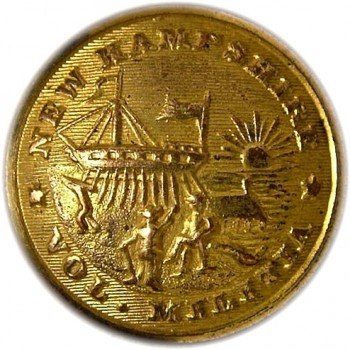
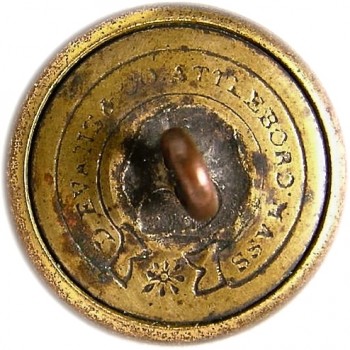
1855-60’s New Hampshire State Militia Infantry Unit
Color: Golden Brass With Brown Highlights.
Metal: Convex, 2-Piece, Raised Design, Gilt Brass.
Size: 23mm.
Albert’s Number: NH 6: RV 5
Tice’s Number: NH 200 D.1
Variation: Raised Center Field / Wide Lined Border / Two Five Pointed Stars / Slanting Foremast is Found Between the N & E / Flat Roof Resembles a Wharf.
Present Condition: An Excavated Example, Strong Planchet Condition, A Strong High Relief Pattern Remains.
Robert’s Notes: This button’s pattern is on a slightly Raised Center Field, that is partially stippled and lined. The button uses a Wide Lined Border for the legend inscription. Arced halfway around the upper portion of the legend is the states name, “NEW HAMPSHIRE” in all capital letters. (This die variant does not use a hyphen). Circling the lower half of the legend, the abbreviation for volunteer,“VOL.” which is followed by a dot, and then the word, “MILITIA.” Separating the states name, and bottom legend’s inscription is Two Five Pointed Stars. The boat depicted is floating on calm waters, and the Slanting Foremast is found between the,“N” and the, “E”in the word NEW. The boat’s flag is blowing in the wind. The building in this die variant shows a Flat Roof that Resembles a Wharf. There is a small sun, with medium radiating lines. The high relief pattern is set on a convex field with a thin edge border. This is a strong collector’s favorite because of all the known die variants.
Reverse Button Analysis: This is a 2-Piece button with a loop shank. D.EVANS & CO ATTLEBORO. MASS dm in ribbon reading clockwise, flower at bottom (Evans07)
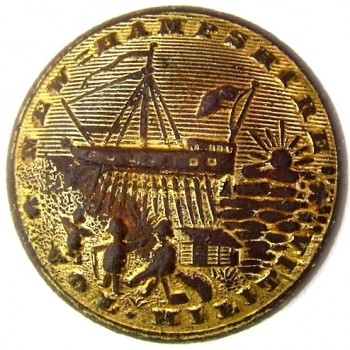
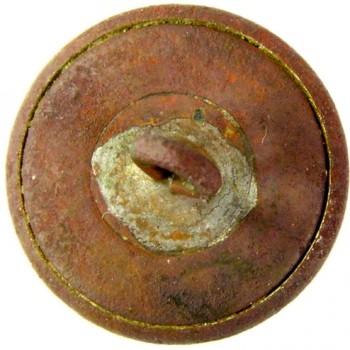
1860’s New Hampshire State Militia Infantry Unit
Color: Golden Brass W/ Rust Highlights.
Metal: Convex, 2-Piece, Raised Design, Copper.
Size: 22.5mm.
Albert’s Number: NH 6: RV 5
Tice’s Number: NH 200 E.1
Variation: Double Hyphen / Two Five Pointed Stars / Slanting Foremast is pointing Toward the W / Small Cabin Type Bulding.
Present Condition: An Excavated Example, Good Planchet Condition, A GoodHigh Relief Pattern Remains.
Robert’s Notes: This button was probably made by Steele and Johnson in 1860’s. This button’s pattern is a crude depiction of New Hampshire’s State of Arms on a copper face. Circling around the upper half of the legend is the states name, “NEW=HAMPSHIRE” in all capital letters; and uses a Double Hyphen in-between the words. Circling around the lower legend, the abbreviation for volunteer,“VOL:” which is followed Colon; and then the word, “MILITIA.” Separating the states name, and bottom legend’s inscription is Two Five Pointed Stars. The boat in this variant is floating on gentle waters, and the Slanting Foremast is pointing toward the, “W” in the word NEW. In this die variant, the main mast is located near the ship’s center, and the boat’s flag is gently blowing in the wind. This die variant shows a Small Cabin Type Building. There is a small sun, with short & long radiating lines. The high relief pattern is set on a convex field with a thin edge border. This is a strong collector’s favorite because of all the variations.
Reverse Button Analysis: This is a 2-Piece button with a loop shank. Blank back mark (BlankNorth 04) dm inner ring.
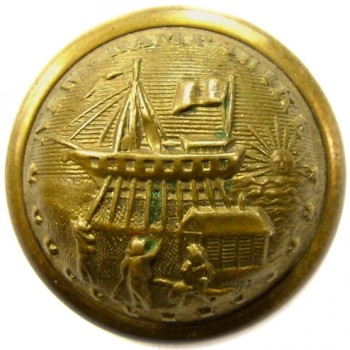
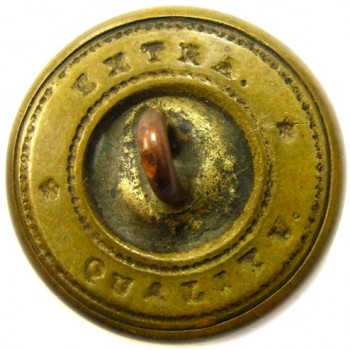
1860 New Hampshire State Militia Infantry Unit-Officer’s Button
Color: A Deep Yellow Brass
Metal: High Convex, 3-Piece, Raised Design, Gilt Brass.
Size: 24mm.
Albert’s Number: Not Listed Variant:
Tice’s Number: NH 210: Unlisted back mark
Variation: Coat of Arms / 13 Stars Below /
Present Condition: An Excavated Example, Strong Planchet Condition, A Strong High Relief Pattern Remains.
Robert’s Notes: Civil War examples of this particular pattern are scarce. After 1865, they became more common. You would have to have the correct back mark for Pre-War. The button’s pattern most likely depicts the frigate, “Raleigh” under sail. There is a radiating sun on the horizon, along with agriculture farmers next to a building on shore. This is representative of the New Hampshire’s Coat of Arms on a lined field. Most New Hampshire buttons are variations of this depiction. Above is the states name, New Hampshire” in capital letters, and in the lower legend is 13 five pointed stars. The high relief pattern is set on a high-convex lined field with a false three part rim. These were most likely produced by Steele and Johnson, and intended for staff officers of militia units. This particular back mark dates to 1860. (Extra Q07)
Reverse Button Analysis: This is a false 3-Piece button with a loop shank. EXTRA. /* QUALITY.* dm between channel of dots.
New Hampshire Artillery Units
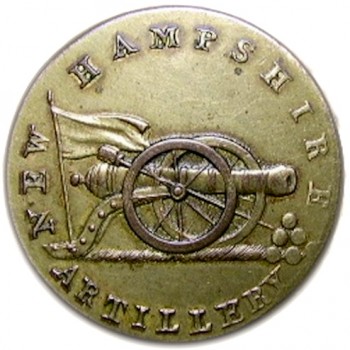
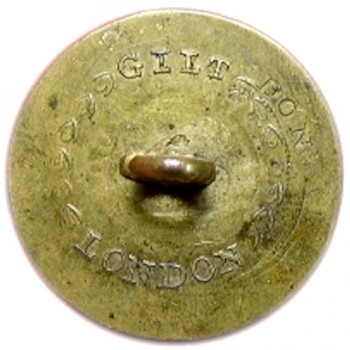
1812-15 New Hampshire State Militia Artillery Unit
Color: Antique Brass With Silver Highlights.
Metal: Flat, 1-Piece, Raised Design, Gilt Brass.
Size: 24mm.
Albert’s Number: NH 3: RV 45
Tice’s Number: NH100A.1
Variation: Old Style Ringed Cannon with a Large Breech / Six Cannon Balls / Unmarked Flag.
Present Condition: A Non Excavated Example, Exceptional Planchet Condition, Exceptional High Relief Pattern Remains.
Robert’s Notes: AM Peasley of Boston took the design from the Continental Artillery buttons in the American Revolution. We know that in 1815 these were used by soldiers in the Battle of New Orleans because of a recovered specimen. The button’s pattern depicts an Old Style Ringed Cannon with a Large Breech. There is a pile of Six Cannon Balls stacked in a pyramid in front, and an Unmarked Flag behind the cannon. Circling around the edge is, “NEW HAMPSHIRE ARTILLERY” in large Roman font capital letters. The high relief pattern is set on a plain flat field. This is a rare specimen, un-dug are extremely rare to come upon.
Reverse Button Analysis: This is a flat one-piece button with a loop shank. The shank is original, straight and intact. GILT LONDON rm WREATH. Over stamp LONDON..
Jim Dew’s Keemakoo Collection.
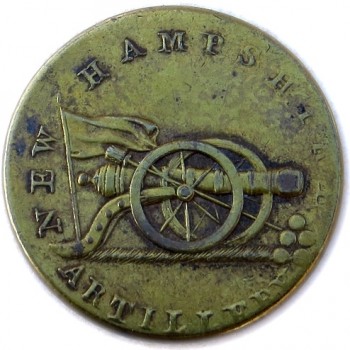
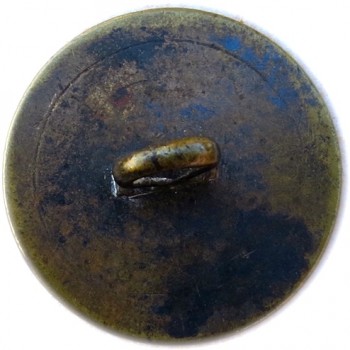
1812-15 New Hampshire State Militia Artillery Unit
Color: Antique Brass With Silver Highlights.
Metal: Flat, 1-Piece, Raised Design, Gilt Brass.
Size: 24mm.
Albert’s Number: NH 3: RV 45
Tice’s Number: NH100A.1
Variation: Old Style Ringed Cannon with a Large Breech / Six Cannon Balls / Unmarked Flag.
Present Condition: An Excavated Example, Strong Planchet Condition, Strong High Relief Pattern Remains.
Robert’s Notes: AM Peasley of Boston took the design from the Continental Artillery buttons from the American Revolution Artillery design. We know that in 1815, these were used by soldiers in the Battle of New Orleans because of a recovered specimens found on sites. The button’s pattern depicts an Old Style Ringed Cannon with a Large Breech. There is a pile of Six Cannon Balls stacked in a pyramid in front, and an Unmarked Flag behind the cannon. Circling around the edge is, “NEW HAMPSHIRE ARTILLERY” in large Roman font capital letters. The high relief pattern is set on a plain flat field. This is a rare specimen, un-dug are extremely rare to come upon. Collectors should seek any specimen available.
Reverse Button Analysis: This is a flat one-piece button with a loop shank. The shank is original, straight and intact.
The RJ Silverstein Collection.
New York Militia Infantry
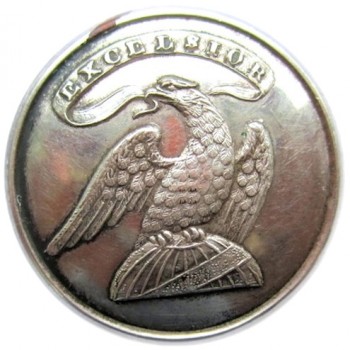
In the pre-colonial era, The City of New York and it’s surrounding areas were inhabited by the various bands of the Algonquin Indian tribes. The actual first visit to New York by a European was in 1524 by Giovanni da Verrazzano. He was a Florentine explorer in the service of the French Crown. He sailed his ship, “La Dauphine” into upper New York harbor, where he spent one night aboard his ship, and then sailed out the next day. Giovanni claimed the land for France, and named it, “Nouvelle Angouleme.” The following year in January of 1525, a Portuguese sailor who was commissioned by the emperor of Spain entered New York Harbor, and chartered the mouth of the Hudson River. He named it Rio de San Antonio. He would have sailed down the Hudson River, but the heavy ice kept him from exploring any further. New York remained for the most part untouched by the rest of the world until 1609, when an English explorer named Henry Hudson sailed his boat the Halve Maen (Half Moon) into NY harbor, and re-discovered the region. Hudson was commissioned by the Dutch East India Company to find a faster trade route to the Orient (Northwestern passageway). He sailed up the Hudson River for 10 days ( as far as Albany) thinking it could be a passageway, but then turned around when he realized the river was no longer salty and narrowed. A few more years passed, and then in 1614 the Dutch founded a fur trading settlement on the southern tip of Manhattan, which was later called, “New Amsterdam” in 1625. The Dutch West India Company was then chartered in 1621 to settle a new North American colony called,“New Netherlands.” This establishment was based on giving large land grants to a handful of quasi-feudal landlords with little or no governing populations; rather then conveying the land to young eager settlers. After a few years, the new settlers of the Dutch Republic established a trading post in 1624. We accredit this establishment to what we we would call the “grass roots” of New York.
This colony slowly began to populate, and then by 1664, the city and all of it’s surroundings came under English control, and was renamed, “New York.” Fearing bloodshed, Peter Stuyvesant who was the Director-General of the colony of New Netherlands surrendered New Amsterdam to King Charles of England who in-turn granted the lands to his brother, The Duke of York. While under British rule, NY became one of the most important trading ports throughout the world. By 1730, it became the center of the slave trade, and was just under Charleston South Carolina with more then 42% of all households owning slaves. By 1776, anti-British sentiments swept through the city, and setting a stage for one of the largest battles of the American Revolution. The Battle of Long Island took place in August 1776, in what we know as modern day Brooklyn. With heavy casualties and being outnumbered, the Americans patriots fled along with sympathizers of the cause. New York quickly became the military and political base of operations in North America for the British Crown. In the next few years, New York became a haven for Loyalist refugees and escaped slaves who were quick to join the British line for a promise of freedom. In 1777, the Americans were able to contain the british to the city part of the state with a major victory in Saratoga- Lake Champlain/ Hudson River corridor.
A State Coat of Arms was adopted in 1777, which shows a river and mountains in-front of a rising sun. The Crest depicts an American Bald Eagle perched on the top of a Terrestrial Globe. A figure of Liberty supports the shield on the left hand side, and Justice is to the right. Beneath the shield is the motto, “Excelsior” which means higher. Many early militia buttons used the Crest of the Eagle on top of the globe, but only a few carried the complete Coat of Arms on their device. New York was the 11th state to join the Union on July 26, 1788. By the Civil War, many common buttons sported the state military seal which links the State of New York, and the United States Arms on a shield to symbolize the twin allegiance of her state militia to the federal government. By 1862, the different militia units used variants of the Eagle and Shield Design.
1790-1800 New York State Militia, (1st Regt?)
Color: A Dull Tarnished Silver.
Metal: Flat, 1-Piece, Hand Engraved Design, Sheffield Plate.
Size: 30mm. Large Overcoat size. (Reported 25.40mm)
Albert’s Number: NY 7: RV 50
Tice’s Number: NY 035-A.1.
Variation: Bird with Upraised Wings / Standing on Half A Terrestrial Globe / Feet Close Together / Excelsior.
Present Condition: A Non Excavated Specimen, A Good Planchet Condition, A Good Impression Remains.
Isabela’s Notes: This button is the only known hand engraved NY Militia specimen from the 1790’s without the 1st Regt. military designation above. The button depicts a crude hand engraving of both the NY State Crest and Motto. This button sheffield plate and was only silvered on one-side. My research shows that in the late 18th Century this was quite customary among buttonmakers, even up to the time when electroplating came into use. The button’s pattern depicts a War-Like Bird facing right with Upright Wings. The Bird’s head is looking forward toward the sky. The Bird is Standing on half of a Terrestrial Globe with it’s Feet Close Together as if starting to lift off for flight. The New York State motto, “EXCELSIOR” which means higher, is inscribed in a stippled semi-circle banner ribbon in the bottom legend. This hand engraving was done on a plain flat field with a plain edge.
Reverse Button Analysis: This is a flat one-piece button with a loop shank.
1790-1800 New York State Militia, 1st Regt
Color: A Tarnished Silver W/ Black Encrustations.
Metal: Flat, 1-Piece, Hand Engraved Design, Sheffield Plate.
Size: 30mm. Large Overcoat size.
Albert’s Number: NY 8 R1: RV 35
Tice’s Number: NY 035-A.1.
Variation: Eagle with Down Swept Wings / Standing on Half A Terrestrial Globe / Feet Apart / Excelsior.
Present Condition: An Excavated Specimen, A Good Planchet Condition, A Good Impression Remains.
Isabela’s Notes: There are eight known specimens of the 1st Regiment buttons. All the buttons show a slight variation in the birds depiction due to it being hand engraved. Meaning, no two buttons are identical. The bird on the other N.Y. 1st Regt. buttons are slightly different in appearance from the others in the set. Actually, if you study the design closely you will see that the bird resembles a dove more than the adopted American Eagle. All of the buttons were only silvered on one-side. My research shows that in the late 18th Century, this was quite customary among button makers. The button’s pattern depicts a Bird facing right with Down Swept Wings. The Bird’s head is Proudly looking forward. The Bird is Standing on half of a Terrestrial Globe with it’s Feet Apart as if standing. Above, is a decorative stippled banner ribbon with the military designation of the 1st Regiment abbreviated, “I REGT.” in crooked letters. The New York State motto, “EXCELSIOR” which means higher, is inscribed in a stippled semi-circle banner ribbon in the bottom legend. The hand engraving was done on a plain field with a plain edge.
Reverse Button Analysis: This is a flat one-piece button with a loop shank.
1790-1800 New York State Militia, 2nd Regt. (Plate Specimen)
Color: Supposedly Silver.
Metal: Flat, 1-Piece, Hand Engraved Design, Sheffield Plate.
Size: 30mm. Large Overcoat size.
Albert’s Number: NY 8 R2: RV 50
Tice’s Number: Unlisted Variant
Variation: Eagle with Down Swept Wings / Standing on Half A Terrestrial Globe / Feet Apart / Excelsior.
Present Condition: A Non Specimen, A Good Planchet Condition, A Good Impression Remains.
Isabela’s Notes: All these early N.Y. Regt. buttons show a slight variation in the birds depiction due to it being hand engraved. Meaning, no two buttons are alike. The bird on the other 2nd Regt. buttons are slightly different in appearance from the others in the set. Actually, if you study the design closely you will see that the bird resembles a doves more than the adopted American Eagle. All of the buttons were only silvered on one-side. My research shows that in the late 18th Century, this was quite customary among button makers. The button’s pattern depicts an Eagle? facing right with Down Swept Wings. The Bird’s head is Proudly looking forward. The Bird is Standing on half of a Terrestrial Globe with it’s Feet Apart as if standing. Above, is a decorative stippled banner ribbon with the military designation of the 2nd Regiment abbreviated, “II REGT.” in crooked letters. The New York State motto, “EXCELSIOR” which means higher, is inscribed in a stippled semi-circle banner ribbon in the bottom legend. The hand engraving was done on a plain field with a plain edge.
Reverse Button Analysis: This is a flat one-piece button with a loop shank.
1800-15 New York State Militia, General Use
Color: A Soft Leather brown.
Metal: Flat, 1-Piece, Raised Design, Gilt Brass.
Size: 24.09mm. Coat size.
Albert’s Number: NY 9-A: RV 10
Tice’s Number: NY 040-A.1.1
Variation: Eagle with Upraised Wings / Perched on a Terrestrial Globe / Excelsior.
Present Condition: An Excavated Specimen, A Strong Planchet Condition, A Strong High Relief Pattern Remains.
Isabela’s Notes: This button’s pattern has at least 6 known die variants. Variations include the depiction of the eagle’s head, the position of it’s feet on the terrestrial globe, and one variant has the Roman number “XLI” added to the deign. These early New York State militia buttons were made prior to, and during the War of 1812. The button’s pattern depicts an Eagle with it’s head looking up towards the sky while facing right. The Eagle is perched on a Terrestrial Globe with it’s feet spread Wide Apart. The New York State motto, “EXCELSIOR” which means higher, is inscribed in a semi-circle in the bottom legend. The high relief pattern is set on a plain field with a flat edge.
Reverse Button Analysis: This is a flat one-piece button with a loop shank. The shank is original, straight, and intact. Blank with a split anvil line on an over struck back.
The RJ. Silverstein Collection.


1800-15 New York State Militia, General Use
Color: Flat Silver Wash.
Metal: Flat, 1-Piece, Raised Design, Silver Wash.
Size: 23mm. Coat Size.
Albert’s Number: NY 9-A: RV 10
Tice’s Number: NY 040-D.1
Variation: Eagle with Upraised Wings / Perched on a Terrestrial Globe / Excelsior.
Present Condition: An Excavated Example, Good Planchet Casting, Good/Strong High Relief Pattern.
Isabela’s Notes: This particular button seems to have at least 6 die variants known. This variant has a subtle difference in the eagle depicted. These early NY state militia buttons were made prior, and during the War of 1812. The button’s pattern depicts the an Eagle with Upraised Wings facing right, while Perched on a Terrestrial Globe. The New York motto, “EXCELSIOR” which means higher, is arced in capital letters in the bottom legend. The high relief pattern is set on a plain flat field with no raised edge border.
Reverse Button Analysis: This is a one-piece button with an alpha shank. The alpha shank is on a raised plateau-type anvil mark. This was a very unusual pedestal structure. The shank is broken off. (indistinct) EXTRA TREBLE dm.
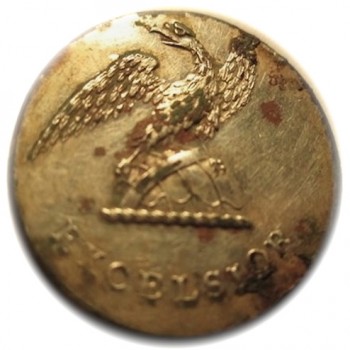
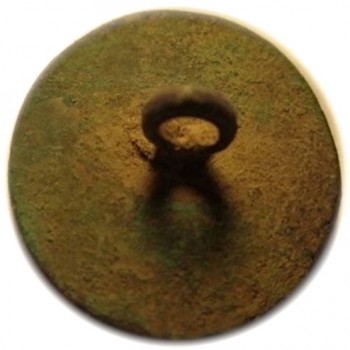
1800-15 New York State Militia, General Use
Color: Silver with Red Undertone.
Metal: Flat, 1-Piece, Raised Design, Silvered Copper.
Size: 23mm. Coat Size.
Albert’s Number: NY 9-A- Unlisted Variant: RV 10
Tice’s Number: NY 040-C.1.1
Variation: Plain Field.
Present Condition: An Excavated Example, Good Planchet Casting, Strong High Relief Pattern.
Isabela’s Notes: This particular button seems to have at least 6 die variants known. This die variant is similar, but has small variations in the design of the eagle. The button’s pattern depicts the state crest of an Eagle perched on a terrestrial globe facing right. The New York motto, “EXCELSIOR” which means higher, is arced in capital letters below. The high relief pattern is set on a plain flat field with no edge border. This die variant was also made prior, and during the War of 1812.
Reverse Button Analysis: This is a one-piece button with a loop shank. The shank is original, straight, and intact. Blank back.
Excavated in Upstate New York.~
1812-29 New York State Militia, General Use
Color: Bright Gold.
Metal: Flat, 1-Piece, Raised Design, Gilt Brass.
Size: 23.44mm. coat Size.
Albert’s Number: NY 10: RV 3
Tice’s Number: NY 100-A.09
Variation: NY State Crest / Terrestrial Globe / Open Beak / Small Flailing Tongue / Wide Stance.
Present Condition: A Non Excavated Specimen, A Strong Planchet Condition, A Strong High Relief Pattern Remains.
Robert’s Notes: Tice notes that British manufacturers produced a large quantity of these button in both gilt and silver finishes before 1830. He lists 38 backmarks for the coat size and 8 for the cuff size. Most patterns only differ on the style of the eagle, the position of the eagle’s talons on the globe, and the style of the globe’s pattern. With this button, it was noted that some manufacturers offered hand chasing for an extra charge. The button’s pattern depicts the NY State Crest of an Eagle perched on the top of a Terrestrial Globe. The Eagle is facing towards the right with an Open Beak, and has a Small Flailing Tongue. The Eagle is perched with a Wide Stance on the terrestrial globe. The New York State motto, “EXCELSIOR” is inscribed below the globe in capital letters in a semi-circle. This crude low-relief cut pattern is set on an evenly lined field that is within an oval picture frame border. The button’s outside edge has a thin pipe-rope trim.
Reverse Button Analysis: This is a flat one-piece button with a loop shank. The shank is original, straight, and intact. LEWIS & TOMES EXTRA RICH rmdc
The RJ. Silverstein Collection.
1812-29 New York State Militia, General Use
Color: Brassy-Copper W/Gold Prominence.
Metal: Flat, 1-Piece, Raised Design, Gilt Brass.
Size: 22.39mm. coat Size.
Albert’s Number: NY 10: RV 3
Tice’s Number: NY 100-A.15
Variation: NY State Crest / Terrestrial Globe / Open Beak / Small Flailing Tongue / Shoulder Width Stance.
Present Condition: A Non Excavated Specimen, A Strong Planchet Condition, An Exceptional High Relief Pattern Remains.
Robert’s Notes: This is another variant made for NY State Militiamen. This one has a more Feather detailed Eagle and prominent terrestrial globe. There are 38 backmarks for this pattern in the coat size, and 8 for the cuff size. Most patterns only differ on the detail of the eagle, the position of the eagle’s talons on the globe, and the style of the globe’s pattern. With this button, it was noted that some manufacturers offered hand chasing for an extra charge. The button’s pattern depicts the NY State Crest of an Eagle on the top of a Terrestrial Globe. The Eagle is facing towards the right with an Open Beak, and has a very Small Flailing Tongue. The Eagle is perched with a Shoulder Width Stance on the terrestrial globe. The New York State motto, “EXCELSIOR” is inscribed in a semicircle below the globe. This high relief pattern is set on an evenly lined field that is within an oval center-wide flat border. The button’s outside edge has a thin pipe-rope trim.
Reverse Button Analysis: This is a flat one-piece button with a loop shank. The shank is original, straight, and intact. LONDON TEBLE GILT 2 dm inner rings / Crown Surmounting a Wreath dm.
The RJ. Silverstein Collection.
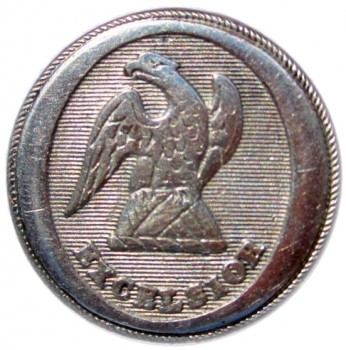
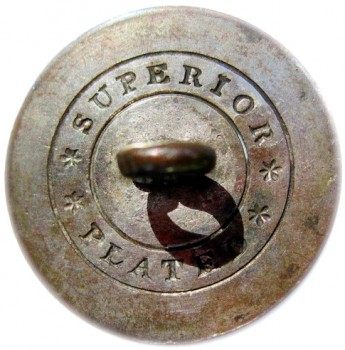
1812-29 New York State Militia, General Use
Color: Silver with Pink Undertones.
Metal: Flat, 1-Piece, Raised Design, Silver Plated.
Size: 23mm. Coat Size.
Albert’s Number: NY 10: RV 3
Tice’s Number: NY 100-A.22
Variation:NY State Crest / Terrestrial Globe / Closed Beak / Close Stance.
Present Condition: A Non Excavated Specimen, A Strong Planchet Condtion, A Good High Relief Pattern Remains.
Robert’s Notes: This is another crude cut die variant for this pattern, but with some subtle differences in the pattern. The button’s pattern depicts an Eagle on a Terrestrial Globe. The Eagle is facing towards the right with an Closed Beak. The Eagle is perched with a Close-Stance on the terrestrial globe. The New York State motto, “EXCELSIOR” is inscribed in capital letters below the globe in a semi-circle. This low-relief pattern is set on an evenly lined field that is within an oval picture frame border. The outside edge has a thin pipe-rope trim.
Reverse Button Analysis: This is a one-piece button with a loop shank. The shank is original, straight, and intact. SUPERIOR** PLATED** in-between 2 dm rings.
The RJ Silverstein Collection.
1812-29 New York State Militia, General Use
Color: A Fiery Red.
Metal: Flat, 1-Piece, Raised Design, Silver-Plated.
Size: 22.23mm. Coat Size.
Albert’s Number: NY 10: Unlisted Backmark
Tice’s Number: NY 100-A: Unlisted Backmark
Variation: NY State Crest / Terrestrial Globe / Open Beak / Close Stance.
Present Condition: A Non Excavated Specimen, A Strong Planchet Condtion, A Strong High Relief Pattern Remains.
Robert’s Notes: Here is another die variant for this popular pattern. The button’s pattern depicts the New York State Crest of an Eagle perched on a Terrestrial Globe. The Eagle is facing towards the right with an Open Beak. The Eagle is perched with a Close-Stance on a Thick Line terrestrial globe. The New York State motto, “EXCELSIOR” is in raised thin cut capital letters in the legend below. This low-relief crude pattern is set on an evenly lined field that is set within an oval picture frame border. The outside edge has a thin pipe-rope trim.
Reverse Button Analysis: This is a one-piece button with a loop shank. The shank is original, straight, and intact.SILVER’D SURFACE WARRANTED with an inner Stipple Triple Line Ring with 3 lines. This is an English producer in the 1820’s. Silvered 01.
The RJ Silverstein Collection.
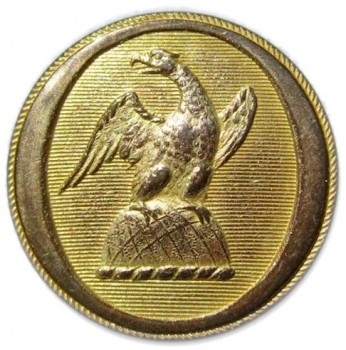
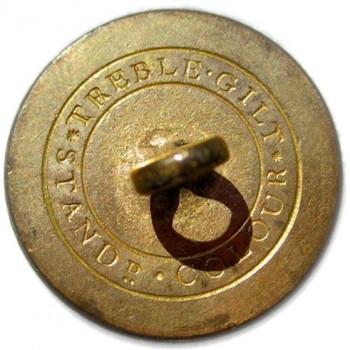
1830’s New York State Militia, General Use
Color: Gold!
Metal: Flat, 1-Piece, Raised Design, Gilt Brass.
Size: 23mm. Coat Size.
Albert’s Number: NY 11: RV 5
Tice’s Number: NY 105-A.3
Variation: New York State Crest / Terrestrial Globe / Open Beak / Wide Stance.
Present Condition: A Non Excavated Specimen, Exceptional Planchet Condition, An Exceptional High Relief Pattern Remains.
Robert’s Notes: This New York Militia button was manufactured in Britain during the early 1830’s. This pattern is not as crude as the earlier 1812-29 series with the same pattern. Also, this pattern without the state’s motto, “Excelsior” is a little more scares then the earlier ones with it. The buttons pattern depicts the New York State Crest of an Eagle on a Terrestrial Globe. The eagle is facing towards the right with an Open Beak. The Eagle is perched with a Wide Stance on the terrestrial globe. This high relief pattern is set on an evenly lined field that is within an oval picture frame border. The outside edge has a thin pipe-rope trim.
Reverse Button Analysis: This is a one-piece button with a loop shank. The shank is original, straight, and intact. TREBLE.GILT / * STRAND d. COLOUR*
The RJ Silverstein Collection
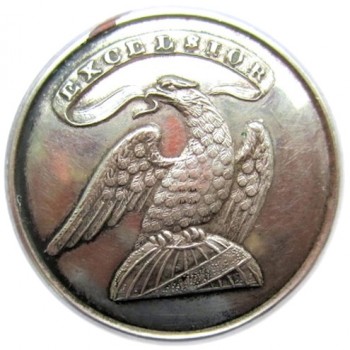
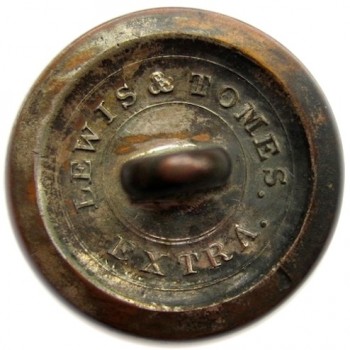
1815-30 New York State Militia, General Use
Color: A Shiny Silver.
Metal: 1-Piece, Low Convex, Raised Design, Silver-Plated Copper.
Size: 20.93mm. Coat Size.
Albert’s Number: NY 12-A.1: RV 5
Tice’s Number: NY 110-A.3
Variation: Eagle / Terrestrial Globe / Excelsior / Close Stance / Wide Stippled Sash.
Present Condition: A Non Excavated Specimen, Strong Planchet Condition, A Strong High Relief Pattern Remains.
Isabela’s Notes: There are at least 17 known backmarks for this pattern in coat size, and 6 known backmarks with 2 subtlety different patterns for the cuff size. British manufacturers produced these silver-plated specimens in the early 19th century. The button’s pattern depicts the NY Crest of an Eagle perched on a Terrestrial Globe. The Eagle is facing right with a Banner Ribbon in it’s beak. Inscribed in the banner ribbon is the states motto, “Excelsior” in all Roman font capital letters. The eagle has a Close Stance on the top of the terrestrial globe. The globe itself has vertical raised lines on longitude with a Wide Stippled Sash going across diagonally. The low-relief pattern is set on a plain convex field with a slightly raised edge.
Reverse Button Analysis: This is a one-piece slightly concave button with a loop shank. The shank is original, straight, and intact. rm LEWIS & TOMES. EXTRA. within a 2 ring channel rm.
The RJ Silverstein Collection.
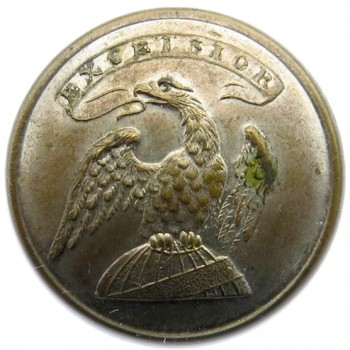
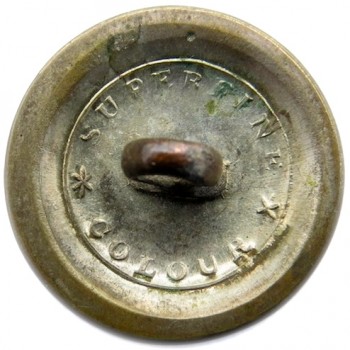
1815-30 New York State Militia, General Use
Color: A Silvery-Brown W/ A Green Wing Top.
Metal: 1-Piece, Convex, Raised Design, Silver-Plated Copper.
Size: 21.10mm. Coat Size.
Albert’s Number: NY 13-A. Unlisted back mark: RV 15
Tice’s Number: NY 110-A.10 Unlisted back mark
Variation: Eagle / Terrestrial Globe / Excelsior / Close Stance / Wide Stippled Sash.
Present Condition: A Non Excavated Specimen, Strong Planchet Condition, A Strong High Relief Pattern Remains.
Isabela’s Notes: This is another variation the British made button for this pattern. The Eagle is slightly different. It appears to have a slightly thinner neck, a bigger eye, and the beak is sightly wider. The button’s pattern depicts an Eagle perched on a Terrestrial Globe. The Eagle is facing towards the right with a Banner Ribbon in it’s beak. Inscribed in the banner ribbon is the states motto, “Excelsior” in all Roman font capital letters. The eagle has a Close Stance on the top of the terrestrial globe. The globe itself has vertical raised lines on longitude with a Wide Stippled Sash going across diagonally. The low-relief pattern is set on a plain convex field with a slightly raised edge.
Reverse Button Analysis: This is a one-piece concave button with a copper loop shank. The shank is original, straight, and intact. rm .* SUPERFINE COLOUR * within a ring rm.
The RJ Silverstein Collection.
1815-30 New York State Militia, General Use
Color: A Gold With Silver Highlights.
Metal: 1-Piece, Convex, Raised Design, Silver-Plated Copper.
Size: 16.10mm. Coat Size.
Albert’s Number: NY 13-Av:Unlisted Size.
Tice’s Number: NY 110-As.3 Unlisted back mark
Variation: Eagle / Terrestrial Globe / Excelsior / Close Stance / Wide Stippled Sash.
Present Condition: A Non Excavated Specimen, Strong Planchet Condition, A Strong High Relief Pattern Remains.
Isabela’s Notes: This is the rare cuff button. The Eagle is very detailed. The Eagle has a thin neck, eye, and the beak is wide. The button’s pattern depicts an Eagle perched on a Terrestrial Globe. The Eagle is facing towards the right with a Banner Ribbon in it’s beak. Inscribed in the banner ribbon is the states motto, “Excelsior” in all Roman font capital letters. The eagle has a Close Stance on the top of the terrestrial globe. The globe itself has vertical raised lines on longitude with a Wide Stippled Sash going across diagonally. The low-relief pattern is set on a plain convex field with a slightly raised edge.
Reverse Button Analysis: This is a one-piece concave button with a copper loop shank. The shank is original, straight, and intact. rm . OLIVE BRANCH / STANDARD / GILT / OLIVE BRANCH
The RJ Silverstein Collection.
1820’s New York State Militia
Color: A Fiery Red Copper Brown. – Outstanding –
Metal: Low-Convex, 1-Piece, Raised Design, Silver-Plated.
Size: 20.41mm. Coat Size.
Albert’s Number: Unlisted Variant
Tice’s Number: NY 115-A.1
Variation: Full Spread Wing Eagle / Terrestrial Globe / Stipple Banner Ribbon / Screeching Beak.
Present Condition: A Non Excavated Specimen, A Strong Planchet Condition Remains, An Exceptional High Relief Pattern Remains.
Isabela’s Notes: In my opinion, this is the best pattern is the whole NY Militia series. There are 3 die variants in this series that use this pattern. The differences are the poison of the Eagles feet on the globe, and the space between the eagles head and stippled banner ribbon. The button’s pattern depicts an American Eagle standing on the top of a Terrestrial Globe. The Eagle is facing towards the right with a raised stipple Banner Ribbon captured in it’s Screeching Beak. Because the Eagle is depicted with it’s beak open and it’s tongue flailing, it makes the on-looker think the Eagle is screaming Excelsior! This is the only button in this pattern series in which the Eagles tongue is present. Also, this is the only depiction of a Full Spread wing Eagle, all the other buttons in this series have the Eagle’s left wing tucked-in. The Terrestrial Globe has solid raised vertical and horizontal lines for latitude and longitude. There is a raised stipple pattern in-between. In the Stipple Banner Ribbon above is the motto, “EXCELSIOR” in large raised Roman font capital letters. The high relief pattern is set on a plain low-convex field with a thin raised edge.
Reverse Button Analysis: This is a flat one-piece button with a copper loop shank. The shank is original, straight, and intact. **SUPERIOR** QUALITY within an outer and 2 inner raised rings.
The RJ Silverstein Collection.
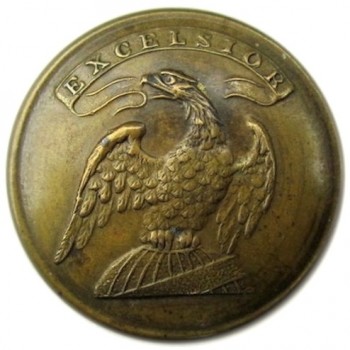
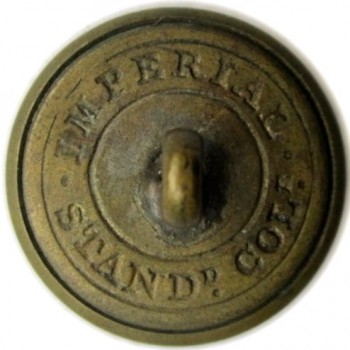
1835-40’s New York State Militia
Color: Antique Brass.
Metal: 2-Piece, Low Convex, Raised Design, Gilt Brass.
Size: 20.63mm. Coat Size.
Albert’s Number: NY 14: Unlisted Backmark.
Tice’s Number: NY 200-A.1
Variation: Droop Wing Eagle / Terrestrial Globe / Excelsior / Diagonal Stipple Sash / Vertical Lines.
Present Condition: A Non Excavated Specimen, Strong Planchet Condition, A Strong High Relief Pattern Remains.
Isabela’s Notes: This button was made for general use and there are two known die variants for this pattern. The only noticeable difference is the position of the Eagle’s head. These two-piece buttons are occasionally excavated at Civil War sites. Collectors of NY Militia buttons find them more rarer then the earlier one-piece button counterparts bearing a similar pattern. This variant was also made in both Silver-Plating and Gilt Brass. The button’s pattern depicts the N.Y. Crest of a Droop Wing Eagle on a Terrestrial Globe. The Eagle is facing towards the right with a Banner Ribbon in it’s beak. Inscribed within the banner ribbon is the states motto, “Excelsior” which means higher. This inscription is in raised Roman font capital letters on a plain field. In this newer variant, the Eagle is perched with it’s Talons Close-Together on the very top portion of the Terrestrial Globe. The terrestrial globe has only has Vertical Lines with a Diagonal Stipple Sash. The globe itself appears to have a raised stipple pattern. The high relief pattern is set on a plain low-convex field with a slightly raised edge.
Reverse Button Analysis: This is a two-piece button with a loop shank. The shank is original, straight, and intact. IMPERIAL./STANDd.COLr. within 2 dm rings.
The RJ Silverstein Collection.
1835-40’s New York State Militia
Color: A Silvery Blue.
Metal: 2-Piece, Low-Convex, Raised Design, Silver Plated.
Size: 21.26mm. Coat Size.
Albert’s Number: NY 14: Unlisted Backmark.
Tice’s Number: NY 200-B.1
Variation: New York Crest / Droop Wing Eagle / Terrestrial Globe / Talons Close Together.
Present Condition: A Non Excavated Example, Strong Planchet Condition, A Strong High Relief Pattern Remains.
Isabela’s Notes: This is the 2nd known die variant for this pattern. The button’s pattern depicts the New York Crest depicting a Droop Wing Eagle on a Terrestrial Globe. The Eagle is facing towards the right with a Banner Ribbon in it’s beak. Inscribed within the banner ribbon is the states motto, “Excelsior” is in raised Roman font capital letters on a plain field. As with the first variant, the Eagle is perched with it’s Talons Close-Together on the very top portion of the Terrestrial Globe. The terrestrial globe has only has Vertical Lines with a Diagonal Stipple Sash. The globe itself appears to have a raised stipple pattern. The high relief pattern is set on a plain low-convex field with a slightly raised edge.
Reverse Button Analysis: This is a two-piece button with a loop shank. The shank is original, straight, and intact. YOUNG.SMITH & Co / *New . York * inner dm ring.
The RJ Silverstein Collection.
Late 1820’s-35 New York State Artillery, National Guard
Color: Brass Yellow.
Metal: Convex, One-Piece, Raised Design, Gilt Brass.
Size: 19.77mm. Coat Size.
Albert’s Number: NY 19-C: RV 10
Tice’s Number: NY 209 C.1
Variation: Flying Eagle / Small Federal Shield / Excelsior / N.Y.S.A. / Raised Stipple Banner Ribbon.
Present Condition: A Non Excavated Specimen, Exceptional Planchet Condition, An Exceptional High Relief Pattern Remains.
Isabela’s Notes: Different makers made these buttons in the late 1820’s to about 1835 for the National Guard Artillery units. This is one of the fancier detailed patterns made for the National Guard series. The button’s pattern depicts a Flying Eagle with it’s head turned toward the left. In it’s beak is a Small Federal Shield. By the Eagle carrying a Federal Shield it is suppose to symbolize the twin allegiance of the Militia. Above the Eagle’s head is the NY State’s motto, “Excelsior” which means higher. Below the shield is a Raised Stipple Banner Ribbon with the initials, “N.Y.S.A” which means New York State Artillery. Below the ribbon is National Guard in capital letters flowing in a semi-circle. The high relief pattern is set on a plain domed face.
Reverse Button Analysis: This is a two-piece button with a loop shank. The shank is original, straight, and intact. ROBINSON.JONES & CO / *A* rm with in 2 pair of Raised Rings.
The RJ Silverstein Collection.
Post 1865 New York State Artillery, National Guard
Color: A Greenish Brass Yellow.
Metal: Convex, 2-Piece, Raised Design, Gilt Brass.
Size: 20.76mm. Coat Size.
Albert’s Number: NY 20: RV 10
Tice’s Number: NY 210-B.2
Variation: 7mm. Wide Federal Shield / Clawed Beak / N.Y.S.A. / Raised Stipple Banner Ribbon.
Present Condition: A Non Excavated Specimen, A Strong Planchet Condition, A Strong High Relief Pattern Remains.
Isabela’s Notes: This button was made for New York Artillery’s National Guard to be used as a general use button. All the backs with the Scovill backmarks with a “7mm wide Federal shield” post date the Civil War. The button’s pattern depicts an Eagle with it’s head turned toward the left. In it’s Clawed Beak is a 7mm Wide Federal Shield. Above the Eagle’s head is the N.Y. State’s motto, “Excelsior” in large capital letters. Below the shield is a Raised Stipple Banner Ribbon with the initials, “N.Y.S.A” which means New York State Artillery. Below the ribbon is National Guard in capital letters flowing in a semi-circle.Flanking each side of the legend is a raised 5 Pointed Star. The high relief pattern is set on a plain domed face.
Reverse Button Analysis: This is a two-piece button with a loop shank. The shank is original, straight, and intact. SCOVILL MFG CO / WATERBURY CONN / 7TH REGT / STANDARD dm
The RJ Silverstein Collection.
1860’s New York State Artillery, National Guard
Color: A Brass Yellow With A Splash of Green.
Metal: Convex, 2-Piece, Raised Design, Gilt Brass.
Size: 20.49mm. Coat Size.
Albert’s Number: NY 20: RV 10
Tice’s Number: NY 210-I.1
Variation: Wide Pron. Federal Shield / Excelsior / NY . SA / National . Guard / 5 Pointed Star.
Present Condition: A Non Excavated Specimen, A Strong Planchet Condition, A Strong High Relief Pattern Remains.
Isabela’s Notes: This button was made for New York Artillery’s National Guard to be used as a general use button. This is the only button with this pattern, and is a little more difficult to find in the series. What makes it unique is the Dot-STAR-Dot pattern on each side of the legend. Also, the blowing banner ribbon depiction should be noted. The button’s pattern depicts a turning Eagle with it’s head turned toward the left. In it’s beak is a Wide Pronounced Federal Shield. Above the Eagle’s head is the NY State’s motto, “Excelsior” in large capital letters. Below the shield is a Stipple Banner Ribbon which appears to be blowing in the wind carelessly. The initials, “NY . SA” shows 1 raised stipple in the middle instead of following each initial. Below the ribbon is National . Guard in large capital letters that flows in a semi-circle. Flanking each side of the legend is a raised 5 Pointed Star with a raised stipple on each side. The high relief pattern is set on a plain domed face.
Reverse Button Analysis: This is a two-piece button with a loop shank. The shank is original, straight, and intact. HORSTMANN & ALLIEN / NY within an outer dm ring and a pair of inner rings.
The RJ Silverstein Collection.
1860’s New York State Militia, National Guard
Color: Strong Gold.
Metal: Convex, 2-Piece, Raised Design, Gilt Brass.
Size: 21.02mm.
Albert’s Number: NY 21: Unlisted Backmark.
Tice’s Number: NY 211 Unlisted Backmark.
Variation: In Flight Eagle / Wide Federal Shield / N.Y.S.M. / Stipple Banner Ribbon / 5 Pointed Star.
Present Condition: A Non Excavated Specimen, Exceptional Planchet Condition, An Exceptional High Relief Pattern Remains.
Isabela’s Notes: This button’s pattern is similar to Tice’s NY 022., but was made for the Militia. The button’s pattern depicts an Inflight Eagle with it’s head turned downward toward the left. In it’s beak is a Wide Federal Shield. By the Eagle carrying a Federal Shield it is suppose to symbolize the twin allegiance of the Militia. Above the Eagle’s head is the N.Y. State’s motto, “Excelsior” which means higher. Below the shield is a raised Stipple Banner Ribbon with the initials, “N.Y.S.M” which means New York State Militia. Flanking each side of the legend is a raised 5 Pointed Star. Below the ribbon is National Guard in capital letters flowing in a semi-circle. The high relief pattern is set on a plain domed face.
Reverse Button Analysis: This is a two-piece button with a loop shank. The shank is original, straight, and intact. WATERBURY / BUTTON CO *
The RJ Silverstein Collection.
1865-Post New York State National Guard, General Use
Color: Clear Brass-Yellow.
Metal: Convex, 2-Piece, Raised Design, Gilt Brass.
Size: 20.14mm. Coat Size.
Albert’s Number: NY 18-A.2: RV 3
Tice’s Number: NY208-A.5
Variation: Eagle Facing Left / Federal Type Shield / Excelsior.
Present Condition: A Non Excavated Specimen, Exceptional Planchet Condition, An Exceptional High Relief Pattern Remains.
Isabela’s Notes: This is a commonly found NY National Guard button made for general use. Since the design was used both during and after the Civil War, collector’s should study the backmarks. This is one of the few rmdc post Civil War backmarks. The button’s pattern depicts an inflight Eagle facing left with it’s wings tucked close to it’s body. Hanging from the Eagle’s beak is a medium sized pronounced outline Federal Shield. By the Eagle carrying a Federal shield it is suppose to symbolize the twin allegiance of the Militia. The NY State motto, “Excelsior” is above in raised Roman font capital letters. The motto, “Excelsior” actually means higher. The high relief pattern is set on an evenly lined field with a thin raised edge.
Reverse Button Analysis: This is a two-piece button with a loop shank. The shank is original, straight, and intact. H.V. ALLIEN & CO / NY rmdc
The RJ Silverstein Collection.
1860’s New York State National Guard, General Use Cuff Button
Color: A Bright Gold.
Metal: Convex, 2-Piece, Raised Design, Gilt Brass.
Size: 14.01mm. Cuff Size.
Albert’s Number: NY 18: Unlisted Backmark
Tice’s Number: NY208-As.2
Variation: In-Flight Eagle Facing Left / Wings Tucked Close to Body / Small Federal Type Shield.
Present Condition: A Non Excavated Specimen, Exceptional Planchet Condition, An Exceptional High Relief Pattern Remains.
Isabela’s Notes: This is a commonly found NY National Guard button made for general use. Since the design was used both during and after the Civil War, collector’s should study the backmarks. The button’s pattern depicts an Inflight Eagle facing left with it’s wings tucked close to it’s body. Hanging from the Eagle’s beak is a Small Federal Shield. The NY State motto, “Excelsior” is above in raised Roman font capital letters. The high relief pattern is set on an evenly lined field with a thin raised edge.
Reverse Button Analysis: This is a two-piece button with a loop shank. The shank is original, straight, and intact. HORSTMANN.BROS. & ALLIEN.dm
The RJ Silverstein Collection.
1840’s & 1850’s New York State Militia, General Use
Color: A Coppery Brown.
Metal: Convex, 2-Piece, Raised Design, Gilt Brass.
Size: 15.00mm. Cuff Size.
Albert’s Number: NY 26-Av.1 RV: 05
Tice’s Number: NY216-As.3
Variation: New York State Coat of Arms / NY State Motto / Eagle’s Wings Extends Completely Over Left Figure.
Present Condition: A Dug Specimen, A Good Planchet Condition, A Good High Relief Pattern Remains.
Isabela’s Notes: Button makers made made these buttons with crude dies in the 1840’s and 1850’s. Collectors have been able to obtain diggers specimens from Civil War battlefields and campsites. There are two known dies with several backmarks. The button’s pattern depicts the New York State Coat of Arms. In this die, the eagle’s left wind extends over the left figure’s head. The New York State Motto, “Excelsior” meaning higher is in the bottom legend in all capital letters. The high relief pattern is set on an evenly lined convex field with a thin raised edge.
Reverse Button Analysis: This is a two-piece button with a loop shank. The shank is original, straight, and intact. W.H.SMITH & CO. /NEW – YORK rmdc.
1840s or 50s The 12th Regiment, New York State Militia AKA “Independence Guard”
Color: Speckled Gold.
Metal: Convex, 2-Piece, Raised Design, Gilt Brass.
Size: 13.94mm. Cuff Size.
Albert’s Number: NY 48: Unlisted Backmark.
Tice’s Number: NY 230-Asl.1
Variation: 12th Regiment / Wreath of Laurel & Oak Leaves.
Present Condition: A non Excavated Specimen, A Strong Planchet Condition, A Strong High Relief Pattern Remains.
Robert’s Notes: The 12th Regiment went by the name “Independence Guard.” The 12th was out of New York City, NY. During the Civil War, they saw 3 months of action in 1861, 6 months in 1862, and 1 month in 1863. There was an additional button used by this regiment under “Independence Guard.” The button is fairly common and can usually be found in un-dug condition. Site recoveries specimens are the rarity. The button’s pattern depicts the 12th Regiment’s number, “12″ surrounded by a Wreath of Laurel & Oak Leaves. The high relief pattern is set on an evenly lined field with a thin raised edge.
Reverse Button Analysis: This is a two-piece button with a loop shank. The shank is original, straight, and intact. SCOVILL.MG.CO: / WATERBURY rmdc.
The RJ Silverstein Collection.
1850s-64 13th Regiment, New York State Militia, AKA “National Grays”
Color: Dirty Brass Yellow
Metal: Convex, 2-Piece, Raised Design, Gilt Brass.
Size: 22.90mm. Coat Size.
Albert’s Number: NY 49-A: RV 10
Tice’s Number: NY 230-A.1
Variation: 13th Regiment Number/ Wreath of Laurel & Oak Leaves.
Present Condition: An Excavated Specimen, A Strong Planchet Condition, A Strong High Relief Pattern Remains.
Robert’s Notes: This pattern was made during the 1850s through the early 60s. This regiment was out of Brooklyn, NY. They were nicknamed National Grays. They served 3 months in 1861 & 1862, and 1 month in 1863. Authorities later combined the 13th with the 40th Infantry to create the 87th New York Volunteer Infantry. The button is common and can usually be found in the market. The button’s pattern depicts the 13th Regiment’s number, “13” surrounded by A Wreath of Laurel & Oak Leaves. The high relief pattern is set on an evenly lined field with a thin raised edge.
Reverse Button Analysis: This is a two-piece button with a loop shank. The shank is original, straight, and intact. SCOVILL.MG.CO: / WATERBURY rmdc.
The RJ Silverstein Collection.
1850s-64 13th Regiment New York State Militia, AKA “National Grays”
Color: Bright Brass Yellow
Metal: Convex, 2-Piece, Raised Design, Gilt Brass.
Size: 13.91mm. Cuff Size.
Albert’s Number: NY 49: Unlisted Size
Tice’s Number: NY 230-As.1
Variation: 13th Regiment Number / A Wreath of Laurel & Oak Leaves.
Present Condition: An Excavated Specimen, A Strong Planchet Condition, A Strong High Relief Pattern Remains.
Robert’s Notes: This cuff size button was made during the 1850s through the early 60s. This regiment was out of Brooklyn, NY. They were nicknamed National Grays. They served 3 months in 1861 & 1862, and 1 month in 1863. Authorities later combined the 13th with the 40th Infantry to create the 87th New York Volunteer Infantry. The button is common and can usually be found in the market. The button’s pattern depicts the Regiment’s number, “13” surrounded by a Wreath of Laurel & Oak Leaves. The high relief pattern is set on an evenly lined field with a thin raised edge.
Reverse Button Analysis: This is a two-piece button with a loop shank. The shank is original, straight, and intact. SCOVILL.Mfg.CO.dm
The RJ Silverstein Collection.
1852 71st Regiment, New York State Militia, AKA “NGSNY”
Color: Brass Yellow With green Splashes.
Metal: Convex, 2-Piece, Raised Design, Gilt Brass.
Size: 22.77mm. Coat Size.
Albert’s Number: NY 61: RV 8
Tice’s Number: NY 238-A.2
Variation: 71st Regiment Number / A Wreath of Laurel & Oak Leaves.
Present Condition: A Non Excavated Specimen, A Strong Planchet Condition, An Exceptional High Relief Pattern Remains.
Robert’s Notes: This button’s pattern was made prior to the Civil War, but this backmark indicates it was made during the conflict. In 1852, the state of New York combined the American Guard, American Rifles, New York Light Guard, and a few smaller companies to form the 71st Regiment. Answering President Lincoln’s call for volunteers, the unit served for 3 months in 1861, and in 1862 elements of the 71st joined NY 124th Volunteer infantry known as the “Orange Blossoms.” After the war, the regiment combined with the Cameron Highlanders as the new 71st Regiment, NGSNY. The button’s pattern depicts the Regiment’s number, “71” surrounded by a Wreath of Laurel & Oak Leaves. The high relief pattern is set on an evenly lined field with a thin raised edge.
Reverse Button Analysis: This is a two-piece button with a loop shank. The shank is original, straight, and intact. SCOVILL.Mfg.CO. WATERBURY rmdc.
The RJ Silverstein Collection.
1860’s 47th Regiment New York State Militia – Staff Button
Color: Dirty Brass Yellow
Metal: High Convex, 2-Piece, Raised Design, Gilt Brass.
Size: 23.78mm. Coat Size.
Albert’s Number: NY 58: RV 80
Tice’s Number: Unlisted Specimen.
Variation: Ducit Amor Patria / N.G.S.N.Y. / 47th Regiment Number /
Present Condition: A Non Excavated Specimen, A Strong Planchet Condition, An Exceptional High Relief Pattern Remains.
Robert’s Inquiry: Robert, 02-18-2012
I don’t think I answered this email. This button is listed in Albert (NY58) but is not listed in Tice. The backmark appears to be a back that Scovill used on state and local contracts and has been very difficult to date. It is very similar to a back used on Alabama and Kentucky buttons that are accepted as pre-war, although is slightly larger and the well around the shank seems to have been formed differently. It may be the same die, the difference could have been the technique used for crimping and attachment of the shank. So this is one that is not at all clear. The regiment had a rich Civil War history, but could have had these buttons produced after the war. My personal opinion is that the idea of these being post war does not make much sense, and since tice couldn’t make up his mind, he left it out entirely. Albert seems to have thought it was period. I think this mark was used only for small contracts, and could have been used over a wide period. I recognize that there is not going to be agreement among collectors. It is available for you, I think it is an interesting button. – Harry Ridgeway.
Robert’s Notes: The regiment was recruited principally in New York City, Kings County, (Brooklyn) and a few men came from Upstate Dutchess County. The 47th Regiment mustered in for three months on May 27, 1862, and then mustered out September 1, 1862. The regiment first went to Baltimore MD, and then duty at Fort Mc Henry until September. The button’s pattern is inscribed with a Latin Motto, “Ducit Amor Patria” which translates to “Love Leads the Country.” In a semi-circle in the lower legend is the initials, “N.G.S.N.Y.” which i believe stands for the National Guard State New York? The button’s pattern depicts a Spread Wing Eagle perched on a Terrestrial Globe. The shield is broken up into 3 quadrants. In the upper left is 13 Five Pointed Stars. On the right is a Shinning Sun. In the lower half of the shield is a “47” imposed over the Flag’s Vertical Stripes. The high relief pattern is set on an evenly lined High-Convex field . I personally believe this was a specialized order by an (Freemason?) Officer for a limited service in 1862. What i like about it is that it is a “Variation of an earlier Scovill backmark.” Meaning it wouldn’t have been one of the normal backmarks used for production of NYS National Guard Staff buttons.
Reverse Button Analysis: This is a two-piece button with a loop shank. The shank is original, straight, and intact. SCOVILL MF’G CO. / WATERBURY. within 2 stipple rings.
1840’s-50’s Cameron highlanders, New York State Militia
70th Regiment New York Volunteer Militia, New York City.
Color: Brown With Gilt Highlights.
Metal: Slightly Convex, 2-Piece, Raised Design, Gilt Brass.
Size: 21mm. Coat Size.
Albert’s Number: NY 63: RV 15
Tice’s Number: NY 250-A.3
Variation: Scottish Thistle in center /Nemo Ne Impune Lacesset / No, not with Impunity.
Present Condition: An Excavated Specimen, A Good Planchet Condition, A Good High Relief Pattern Remains.
Robert’s Notes: This is one of the rarest Northern militia buttons. In 1861, this Scottish regiment formed 6 companies attached to the 1st Division New York State Militia. Federalized after President Lincoln’s second call for troops. The Highlanders served for three years as the 79th Regiment New York Volunteer Militia. Several specimens have been dug at Civil War campsites in the deep south. Others have been found in West Virginia Campsites after the battle of Antietam. Several grievances erupted during the Civil War and the men were disarmed and their colors confiscated. General McClellan restored their standing and returned their colors and weapons. The button’s pattern depicts a large Scottish Thistle in the center. Circling the legend is the motto, “Nemo Ne Impune Lacesset” in all raised capital letters. Meaning, “No not with Impunity.” The high relief pattern is set on a slightly domed plain field.
Reverse Button Analysis: This is a two-piece button with a loop shank. The shank is original, slightly bent, but intact. Blank northern manufacture 280 backmark.
Dug in Stafford, Virginia
Picture Courteous of Harry Ridgeway.
1833-62 New York Light Guard
1862 23rd New York Militia Regiment.
Color: Brass Yellow.
Metal: Slightly Convex, 2-Piece, Raised Design, Gilt Brass.
Size: 23.00mm. Coat Size.
Albert’s Number: NY 78: RV 5
Tice’s Number: NY 256-A.1
Variation: New York City Guard / Old English / L G / Laurel Branch / Oak Branch.
Present Condition: A Non Excavated Specimen, An Exceptional Planchet Condition, An Exceptional High Relief Pattern Remains.
Robert’s Notes: In 1830, Colonel Thompkins took command of the 14th NY militia regt. The unit took the name New York Light Guard in 1833. In 1862, they were reorganized into the 23rd NY Militia Regiment. After the Civil War, the Light Guard and the New York City Guard was combined to form the Old Guard. There is two pattern variations. The Horstmann & Allien pattern has a vertical bar on the letter “L”. Both patterns are commonly found in the market place for a reasonable price. The button’s pattern depicts the Old English Initials, “LG” in the center. Flanking each side in the legend is a Laurel Branch and Oak Branch joined together at the bottom. The high relief pattern is set on an evenly lined field with a plain flat edge.
Reverse Button Analysis: This is a two-piece button with a loop shank. The shank is original, straight, and intact. * R & W. ROBINSON * / EXTRA RICH inner dm ring.
North Carolina’s Infantry Militia
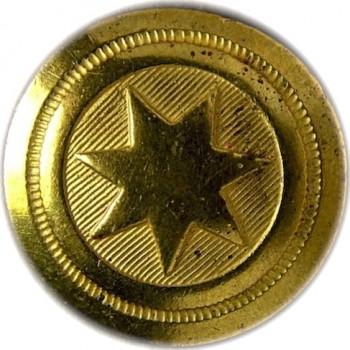
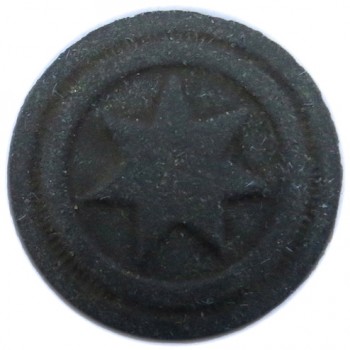
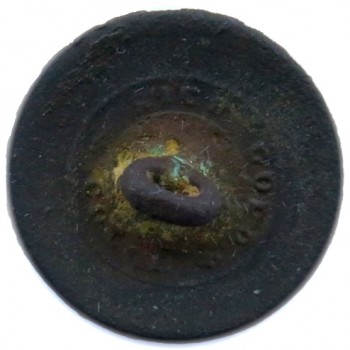
1830-40’s North Carolina’s State Cherokee Indian Nation (Indian Troops)
Color: Brass Yellow.
Metal: 1-Piece, Low Convex, Raised Design, Gilded Brass.
Size: 22mm.
Albert’s Number: Unlisted. Robert’s Rating: RV 75
Tice’s Number: UM248A.1
Variation: 7 Point Star / Lined Field
Present Condition: An Excavated Example, Fair Planchet Condition, A Fair Relief Pattern Remains.
Isabela’s Notes: This coat size button has been identified as belonging to the Cherokee Indian Nation who used the seven point star as an emblem in the early 19th century. Later, Cherokee Indians served as Confederate Troops in North Carolina, and wore these earlier manufactured buttons while in service. This button’s seven pointed star is very similar to Florida’s Cherokee Rose six pointed star buttons that was used by both the states militia, and their Indian Troops. The button’s pattern depicts a raised seven point star (Cherokee Rose) set on a lined field. Encircling the star is a lined ring milled into a wide border. This high quality button is most likely of English Manufacture, but there is some doubt in my mind because of how the word color is spelled. We do know for a fact that these was made specifically for the Cherokee Nation during the 1830-40’s. This button’s back mark is also identified as having Confederate Army Indian Troop usage during the Civil War by David F. Johnson in his book, “American Armed Forces 1784-1948”. Only a few examples exist, and most known ones have been dug directly from several Civil War battle sites, including ones in Virginia. Collectors should only seek dug specimens since a 1/2 card of unsold buttons was discovered in England, and then sold slowly through e-bay in 2011-12. If you have question about it’s authenticity of being American Indian Provenance, then don’t buy it. Dug examples usually range around $250-$300. Non Dug British card specimens go for around $100-$200.
Reverse Button Analysis: This is a slightly concave one-piece button with a loop shank. +RICH GOLD + COLOR within a 2 rm channel.
The RJ Silverstein Collection.
Robert’s Notes: Because of early prejudices, and the distinct living areas of settlers and Cherokee Nation, I highly doubt any Indians volunteered for North Carolina’s early militia units pre-civil war. I do believe that by the mid 19th century, tensions eased enough for the confederacy or state government to ask the Cherokees for help during the Civil War. So to emphasize a point on this seven star Cherokee Rose pattern; This button was not especially made for Indian Troops who served for the Confederacy’s North Carolina Regiments, it was made many years earlier and used by the Cherokees prior to the Civil War. As I have learned with many Civil War items that were made Prior to the war, they became Civil War items by the virtue of their usage!
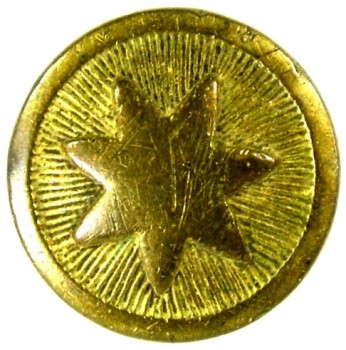
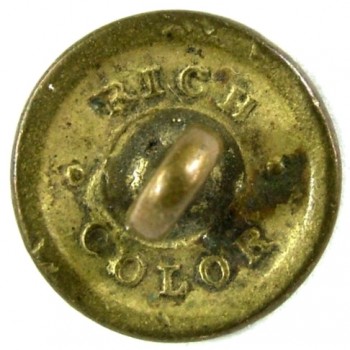
1830-40’s North Carolina’s State Cherokee Indian Nation (Indian Troops)
Color: Brass Yellow.
Metal: 1-Piece, Low Convex, Raised Design, Gilded Brass.
Size: 12.5mm. Cuff Size
Albert’s Number: Unlisted. Robert’s Rating: RV 250
Tice’s Number: UM248A.1- Undocumented & Unlisted Variant.
Variation: 7 Point Star / Rayed Field
Present Condition: A Non Excavated Example, Strong Planchet Condition, A Strong High Relief Pattern Remains.
Isabela’s Notes: This extremely rare early button has been identified as belonging to the Cherokee Indian Nation who used the seven point star as an emblem in the early 19th century. Later, Cherokee Indians served as Confederate Troops in North Carolina, and wore these earlier manufactured buttons while in service. This button’s seven pointed star is very similar to Florida’s Cherokee Rose six pointed star buttons that was used by both the states militia, and their Indian Troops. The button’s pattern depicts a raised seven point star (Cherokee Rose) set on a rayed field. Encircling the star is a small plain border. This high quality button is most likely of English Manufacture, but there is some doubt in my mind because of how the word color is spelled. We do know for a fact that these was made specifically for the Cherokee Nation during the 1830-40’s. This button’s back mark is also identified as having Confederate Army Indian Troop usage during the Civil War by David F. Johnson in his book, “American Armed Forces 1784-1948”. Only a few examples exist, and most known ones have been dug directly from several Civil War battle sites, including ones in Virginia.
Reverse Button Analysis: This is a slightly concave one-piece casting with a concave back and a loop shank. The shank is original, straight, and intact. . RICH . COLOR
The RJ Silverstein Collection.
1860 North Carolina State Militia
Color: Gilt Yellow Over Brown.
Metal: 1-Piece, Low Convex, Raised Design, Gilt Brass.
Size: 21.26mm.
Albert’s Number: NC 14-A RV 50
Tice’s Number: 233A.1
Variation: Finely Stippled Gilded Field
Present Condition: An Excavated Example, Strong Planchet Condition, A Strong High Relief Pattern Remains.
Isabela’s Notes: This button is believed by Civil War collectors to be a well made Confederate local made in the early years of the war. All the buttons were fitted with a non footed shank, showing that they are securely brazed into place. The workmanship of the reverse reflects that these were all lathe turned buttons. .
Reverse Button Analysis: This is a slightly concave one-piece button with a loop shank. The shank is original, straight, and intact. No back mark
The RJ Silverstein Collection.
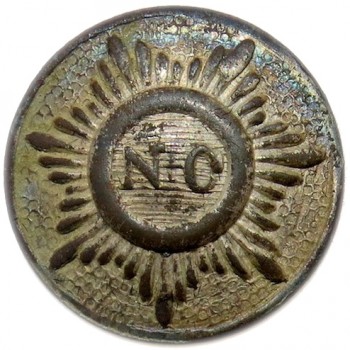
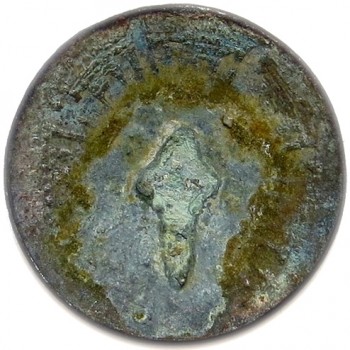
1863-64 North Carolina State Militia.
Color: Brown With Traces of Blue & Red.
Metal: Convex, 1-Piece, Raised Design, Silver Wash.
Size: 22.47mm. Coat Size
Albert’s Number: NC 16-B: RV 25
Tice’s Number: NC 242 B.1
Variation: Seven Rays
Present Condition: An Excavated Specimen, Good Planchet Condition, Strong High Relief Pattern Remains.
Isabela’s Notes: Confederate local.
Reverse Button Analysis: This is a slightly convex one-piece button with a soldered on loop shank. The shank is unfortunately missing.
Dug Benny Anderson at General Manigaults 1863-64 Winter Camp at Dalton. This happens to be where they were issued in 1863-64.This button was published on page 209 in Charles Harris book, Western Campaigns.
The RJ. Silverstein Collection.
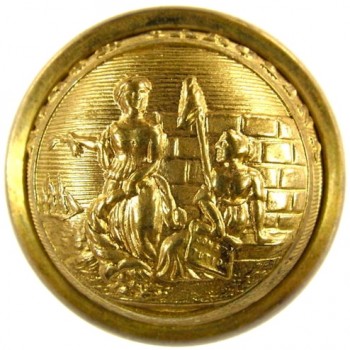

1860 North Carolina State Militia.
Color: Gold!
Metal: High-Convex, 3-Piece, Raised Design, Gilt Brass.
Size: 22.50mm. Coat Size
Albert’s Number: NC 2: Variant Not Listed RV
Tice’s Number: NC 204A.4
Variation:
Present Condition: A Non Excavated Specimen, Exceptional Condition, An Exceptional High Relief Pattern Remains.
Isabela’s Notes: Scovills manufactured this button for officers slightly before the war started. This button was well made compared to other North Carolina buttons.
Reverse Button Analysis: This is a slightly convex one-piece button with a soldered on copper loop shank. The shank is original, straight, and intact *EXTRA */QUALITY small letters between two rings of dots. inner dm ring.
Picture Courteous of Harry Ridgeway.
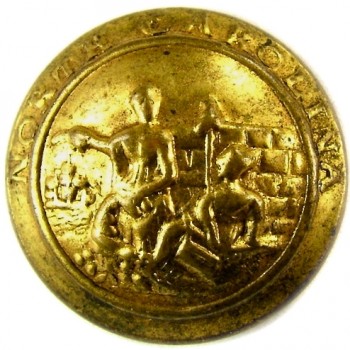

1860’s North Carolina State Militia.
Color: Antique Gold.
Metal: Convex, 2-Piece, Raised Design, Gilt Brass.
Size: 23mm. Coat Size
Albert’s Number: NC 8 RV
Tice’s Number: NC 210A.1
Variation:
Present Condition: A Non Excavated Specimen, Strong Planchet Condition, A Strong High Relief Pattern Remains.
Isabela’s Notes: This southern wartime manufacturer S.A. Myers of Richmond made these crude style buttons for North Carolina troops. It is one of the most commonly encounter southern civil war buttons found. The NC 8 has many variants.
Reverse Button Analysis: This is a two-piece convex button with a soldered Copper loop shank. The shank is original, straight, and intact. S.A MYERS/ RICHMOND VA. rmdc (Myers 01)
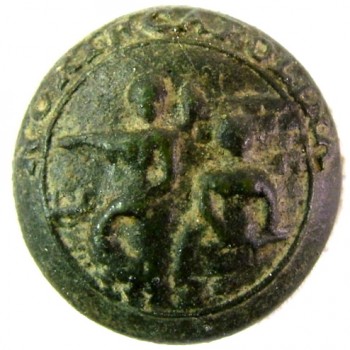
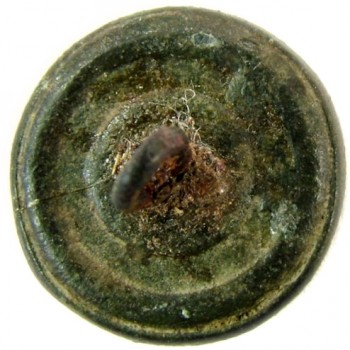
1860’s North Carolina State Militia.
Color: Green With Yellow Encrustations
Metal: Convex, 2-Piece, Raised Design, Gilt Brass.
Size: 14.2mm. Cuff Size
Albert’s Number: NC 8 RV
Tice’s Number: NC 210As1
Variation: Most likely made by Wildt.
Present Condition: A Non Excavated Specimen, Good Planchet Condition, A Good High Relief Pattern Remains.
Isabela’s Notes: This southern wartime manufacturer S.A. Myers of Richmond made these crude style buttons for North Carolina troops.
Reverse Button Analysis: This is a two-piece convex button with a soldered Copper loop shank. The shank is original, straight, and intact. (Blank Southern 360)
Dug in Eastern North Carolina.
Picture Courteous of Harry Ridgeway.
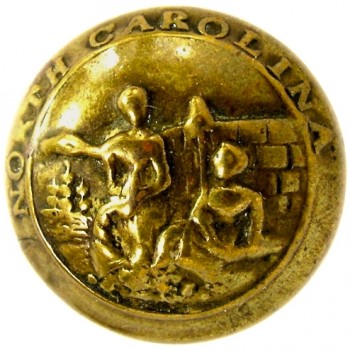

1860’s North Carolina State Militia.
Color: Golden Brown.
Metal: Convex, 2-Piece, Raised Design, Gilt Brass.
Size: 21.90mm. Coat Size
Albert’s Number: NC 8B RV
Tice’s Number: NC 210B.1
Variation:
Present Condition: A Non Excavated Specimen, Strong Planchet Condition, A Strong High Relief Pattern Remains.
Isabela’s Notes: William Wildt was a Jeweler out of Richmond Va.
Reverse Button Analysis: This is a two-piece convex button with a soldered Copper loop shank. The shank is original, straight, and intact. W.WILDT & SON / RICHMOND VA rmdc Back mark is usually illegible.
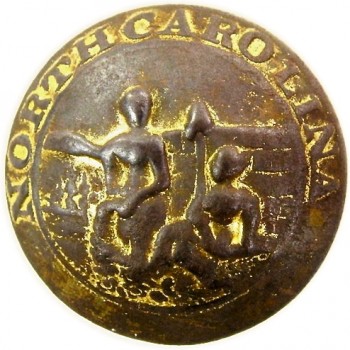
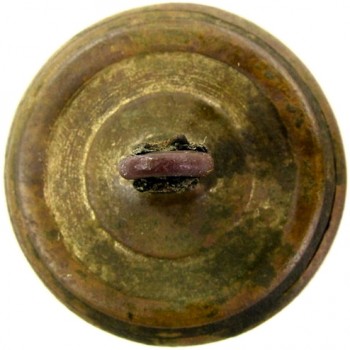
1860’s North Carolina State Militia.
Color: Rusty Gold.
Metal: Convex, 2-Piece, Raised Design, Gilt Brass.
Size: 22.50mm. Coat Size
Albert’s Number: NC 8C RV
Tice’s Number: NC 210C.1
Variation:
Present Condition: A Non Excavated Specimen, Good Planchet Condition, A Good High Relief Pattern Remains.
Isabela’s Notes:
Reverse Button Analysis: This is a two-piece convex button with a Brass or Copper loop shank spot brazed. The shank is original, straight, and intact. (Blank Southern 370)
Dug in Central Virginia.
Picture Courteous of Harry Ridgeway.
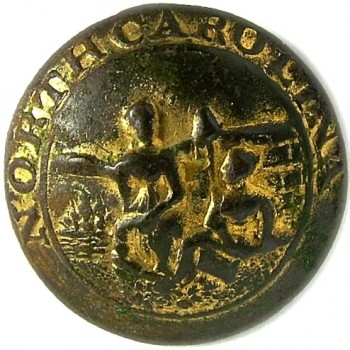
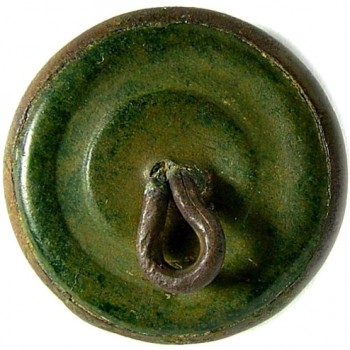
1860’s North Carolina State Militia.
Color: Yellow and Browns.
Metal: Convex, 2-Piece, Raised Design, Gilt Brass.
Size: 22.49mm. Coat Size
Albert’s Number: NC 8D RV
Tice’s Number: NC 210D.2
Variation: Plain Narrow Channel w/o star / Wide Center
Present Condition: An Excavated Specimen, Strong Planchet Condition, A Strong High Relief Pattern Remains.
Isabela’s Notes: Confederate local most likely manufactured by Wildt.
Reverse Button Analysis: This is a two-piece convex button with a soldered on Brass or Copper loop shank. The shank is bent over. (Blank Southern 360)
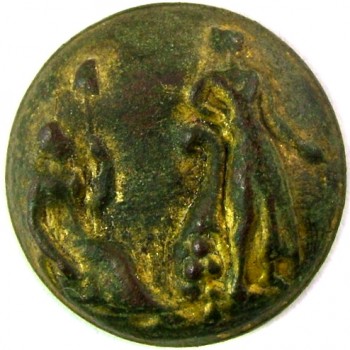
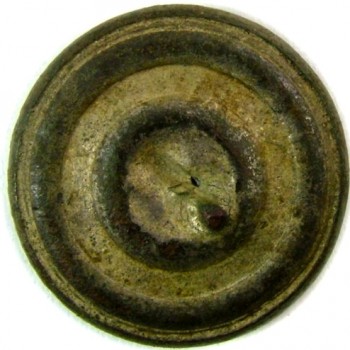
1860 North Carolina State Militia.
Color: Golden Green.
Metal: Convex, 2-Piece, Raised Design, Gilt Brass.
Size: 22.50mm. Coat Size
Albert’s Number: NC 9 RV 25
Tice’s Number: NC 216 A.1
Variation:
Present Condition: An Excavated Specimen, Good Planchet Condition, A Strong High Relief Pattern Remains.
Isabela’s Notes: Referred to as Standing Shepard. Most likely produced by C. Rouyer of New Orleans.
Reverse Button Analysis: This is a two-piece convex button with a soldered on loop shank. The shank is unfortunately missing. (Blank Southern 341).
Dug in Stafford County,Virginia.
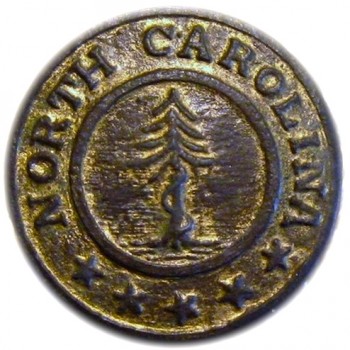
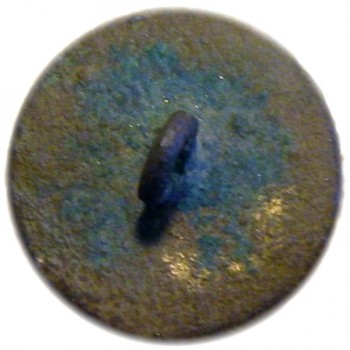
1860-65 North Carolina State Militia.
Color:
Metal: Flat, 1-Piece, Raised Design, Gilt Brass.
Size: 22mm. Coat Size
Albert’s Number: NC 12-A RV
Tice’s Number:
Variation:
Present Condition: An Excavated Specimen, Good Planchet Condition, Strong High Relief Pattern Remains.
Isabela’s Notes: Specimens of this button are exceedingly rare. Some collectors refer to this button as, “The Pine Tree“. Some theorize that this button was manufactured at Wilmington’s Sword Factory. Since recovers were few and far between, it was likely a limited run or possibly a custom order. The button’s pattern depicts a high relief Pine Tree with a Serpent Coiled around it’s trunk moving in an upward direction. The Snake’s head extends to the tree branches. In the lower chanel there is a semi-circle of five raised 5-pointed Stars. In the upper chanel is the raised inscription, “North Carolina” in all upper case letters. The inside high relief pattern is set on an evenly spaced lined field within a picture frame border. The outer inscription and stars are set on a stipple field
Reverse Button Analysis: This is a Flat one-piece button with a soldered on loop shank. The shank is original, straight, and intact.
Reverse Button Analysis: This is a flat one-piece button with a soldered on loop shank. The shank is original, straight, and intact.
Picture Courteous of Allen Gaskins.
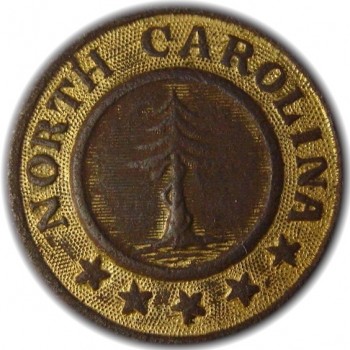
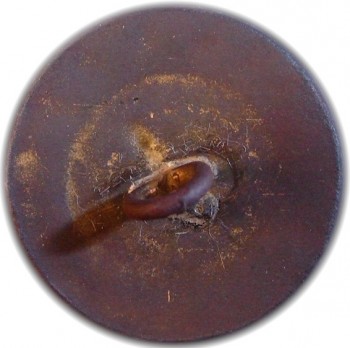
1860-65 North Carolina State Militia.
Color: Golden Brown.
Metal: Flat, 1-Piece, Raised Design, Gilt Brass.
Size: 22mm. Coat Size
Albert’s Number: NC 12-A
Tice’s Number: NC 251
Variation:
Present Condition: An Excavated Specimen, Good Planchet Condition, Strong High Relief Pattern Remains.
Isabela’s Notes: Specimens of this button are exceedingly rare. Some collectors refer to this button as, “The Pine Tree“. Some theorize that this button was manufactured at Wilmington’s Sword Factory. Since recovers were few and far between, it was likely a limited run or possibly a custom order. The button’s pattern depicts a high relief Pine Tree with a Serpent Coiled around it’s trunk moving in an upward direction. The Snake’s head extends to the tree branches. In the lower chanel there is a semi-circle of five raised 5-pointed Stars. In the upper chanel is the raised inscription, “North Carolina” in all upper case letters. The inside high relief pattern is set on an evenly spaced lined field within a picture frame border. The outer inscription and stars are set on a stipple field.
Reverse Button Analysis: This is a flat one-piece button with a soldered on loop shank. The shank is original, straight, and intact.
Picture Courteous of William henderson.
Pennsylvania State Militia
1850-61 Pennsylvania State Militia, General Use
Color: A Bright Brass Yellow.
Metal: 3-Piece, High Convex, Raised Design, Gilt Brass.
Size: 23.01mm. Coat Size.
Albert’s Number: PA 18: RV 10
Tice’s Number: PA 203-A.1
Variation: Horse on Right Side is Facing Outward. Both Horses have One Leg inside of the Crest.
Present Condition: A Non Dug Specimen, A Strong Planchet Condition, A Strong High Relief Pattern Remains.
Isabela’s Notes: Steele & Johnson made these general use coat buttons for Pennsylvania’s State Militia starting from 1850, and continuing onto 1861. During the Civil War, Pennsylvania troops used these Coat of Arms buttons in all units. There appears to be 3 variations to the button’s depiction of the Coat of Arms. All have to do with the direction of the horses head and the position of the legs. The button’s pattern depicts the Pennsylvania Coat of Arms with the Horses Head on the right turned away from the center. Both horses have one leg inside of the crest. The high relief pattern is set on an evenly lined high convex field.
Reverse Button Analysis: This is a 3-piece button with a copper loop shank. The shank is original, straight, and intact.
Picture Courteous of Roger Young.
1850-61 Pennsylvania State Militia, General Use
Color: A Dull Brass Yellow.
Metal: 3-Piece, High Convex, Raised Design, Gilt Brass.
Size: 23.01mm. Coat Size.
Albert’s Number: PA 18: RV 10
Tice’s Number: PA 203-A.2
Variation: Horse on Right Side is Facing Outward. Both Horses have One Leg inside of the Crest.
Present Condition: A Non Dug Specimen, A Strong Planchet Condition, A Strong High Relief Pattern Remains.
Isabela’s Notes: Steele & Johnson made these general use coat buttons for Pennsylvania’s State Militia starting from 1850, and continuing onto 1861. During the Civil War, Pennsylvania troops used these Coat of Arms buttons in all units. There appears to be 3 variations to the button’s depiction of the Coat of Arms. All have to do with the direction of the horses head and the position of the legs. The button’s pattern depicts the Pennsylvania Coat of Arms with the Horses Head on the right turned away from the center. Both horses have one leg inside of the crest. The high relief pattern is set on an evenly lined high convex field.
Reverse Button Analysis: This is a 3-piece button with a copper loop shank. The shank is original, straight, and intact.
Picture Courteous of Roger Young.
1850-61 Pennsylvania State Militia, General Use
Color: A Tarnished Brass Yellow-Gold.
Metal: 3-Piece, High Convex, Raised Design, Gilt Brass.
Size: 23.01mm. Coat Size.
Albert’s Number: PA 18: RV 10
Tice’s Number: PA 203-A.4
Variation: Horse on Right Side is Facing Outward. Both Horses have One Leg inside of the Crest.
Present Condition: A Non Dug Specimen, A Strong Planchet Condition, A Strong High Relief Pattern Remains.
Isabela’s Notes: Steele & Johnson made these general use coat buttons for Pennsylvania’s State Militia starting from 1850, and continuing onto 1861. During the Civil War, Pennsylvania troops used these Coat of Arms buttons in all units. There appears to be 3 variations to the button’s depiction of the Coat of Arms. All have to do with the direction of the horses head and the position of the legs. The button’s pattern depicts the Pennsylvania Coat of Arms with the Horses Head on the right turned away from the center. Both horses have one leg inside of the crest. The high relief pattern is set on an evenly lined high convex field.
Reverse Button Analysis: This is a 3-piece button with a copper loop shank. The shank is original, straight, and intact.
Picture Courteous of Roger Young.
1850-61 Pennsylvania State Militia, General Use
Color: Antique Brass Yellow.
Metal: 3-Piece, High Convex, Raised Design, Gilt Brass.
Size: 15mm. Cuff Size.
Albert’s Number: PA 18Av: RV 10
Tice’s Number: PA 203-As.3
Variation: Horse on Right Side is Facing Outward. Both Horses have One Leg inside of the Crest.
Present Condition: A Non Dug Specimen, A Strong Planchet Condition, A Strong High Relief Pattern Remains.
Isabela’s Notes: Steele & Johnson made these general use cuff buttons for Pennsylvania’s State Militia starting from 1850, and continuing onto 1861. During the Civil War, Pennsylvania troops used these Coat of Arms buttons in all units. There appears to be 3 variations to the button’s depiction of the Coat of Arms. All have to do with the direction of the horses head and the position of the legs. The button’s pattern depicts the Pennsylvania Coat of Arms with the Horses Head on the right turned away from the center. Both horses have one leg inside of the crest. The high relief pattern is set on an evenly lined high convex field.
Reverse Button Analysis: This is a 3-piece button with a copper loop shank. The shank is original, straight, and intact.
Picture Courteous of Roger Young.
1850-61 Pennsylvania State Militia, General Use
Color: A Bright Brass Yellow.
Metal: 3-Piece, High Convex, Raised Design, Gilt Brass.
Size: 23.01mm. Coat Size.
Albert’s Number: PA 18: RV 10
Tice’s Number: PA 203-A.5
Variation: Horse on Right Side is Facing Outward. Both Horses have One Leg inside of the Crest.
Present Condition: A Non Dug Specimen, A Strong Planchet Condition, A Strong High Relief Pattern Remains.
Isabela’s Notes: Steele & Johnson made these general use coat buttons for Pennsylvania’s State Militia starting from 1850, and continuing onto 1861. During the Civil War, Pennsylvania troops used these Coat of Arms buttons in all units. There appears to be 3 variations to the button’s depiction of the State’s Coat of Arms. All have to do with the direction of the horses head and the position of the legs. The button’s pattern depicts the Pennsylvania Coat of Arms with the Horses Head on the right turned away from the center. Both horses have one leg inside of the crest. The high relief pattern is set on an evenly lined high convex field.
Reverse Button Analysis: This is a 3-piece button with a copper loop shank. The shank is original, straight, and intact. SUPERIOR * QUALITY dm within a channel of stipples.
Picture Courteous of Harry R.
1850-61 Pennsylvania State Militia, General Use
Color: Antique Bright Brass Yellow.
Metal: 3-Piece, High Convex, Raised Design, Gilt Brass.
Size: 23mm. Coat Size.
Albert’s Number: PA 18-B: RV 10
Tice’s Number: PA 203-B.4
Variation: Horse on Right Side is Facing Outward & Has One Leg inside of the Crest.
Present Condition: A Non Dug Specimen, A Strong Planchet Condition, A Strong High Relief Pattern Remains.
Isabela’s Notes: Steele & Johnson made these general use cuff buttons for Pennsylvania’s State Militia starting from 1850, and continuing onto 1861. During the Civil War, Pennsylvania troops used these Coat of Arms buttons in all units. There appears to be 3 variations to the button’s depiction of the Coat of Arms. All have to do with the direction of the horses head and the position of the legs. The button’s pattern depicts the Pennsylvania Coat of Arms with the Horses Head on the right turned away from the center. Only the horse on the right has it’s leg in the crest. The high relief pattern is set on an evenly lined high convex field.
Reverse Button Analysis: This is a 3-piece button with a copper loop shank. The shank is original, straight, and intact.
1850-61 Pennsylvania State Militia, General Use
Color: Antique Silver.
Metal: 3-Piece, Convex, Raised Design, Silver’d.
Size: 22mm. Coat Size.
Albert’s Number: PA 18-C: RV 04
Tice’s Number: PA 203-C.2
Variation: Horse on Right Side is Facing Outward & Has One Leg inside of the Crest / The Eagle Has A Short Wing Span.
Present Condition: A Non Dug Specimen, A Strong Planchet Condition, A Strong High Relief Pattern Remains.
Isabela’s Notes: Steele & Johnson made these general use cuff buttons for Pennsylvania’s State Militia starting from 1850, and continuing onto 1861. During the Civil War, Pennsylvania troops used these Coat of Arms buttons in all units. There appears to be 3 variations to the button’s depiction of the Coat of Arms. All have to do with the direction of the horses head and the position of the legs. The button’s pattern depicts the Pennsylvania Coat of Arms with the Horses Head on the right turned away from the center. Only the horse on the right has it’s leg in the crest. The high relief pattern is set on an evenly lined high convex field.
Reverse Button Analysis: This is a 3-piece button with a copper loop shank. The shank is original, straight, and intact.
Picture Courteous of Roger Young.
1850-70 Pennsylvania State National Guard
Color: Antique Gold.
Metal: 2-Piece, Convex, Raised Design, Gilt brass.
Size: 22.60mm. Coat Size.
Albert’s Number: PA 39: RV 02
Tice’s Number: PA 223-A.2
Variation: National Guard / NG / Old English Letters / Wreath of Oak & Laurels.
Present Condition:A Non Dug Specimen, A Strong Planchet Condition, A Strong High Relief Pattern Remains.
Isabela’s Notes: Scovill made these National Guard Gilt buttons from 1850 to 1870. There are three slightly different patterns and several backmarks. The button’s pattern depicts the initials for National Guard, “NG” in large Old English Letters. Surrounding the initials is a tied Wreath of Oak and Laurels. The high relief pattern is set on an evenly lined field with a thin raised edge.
Reverse Button Analysis: This is a 2-piece button with a copper loop shank. The shank is original, straight, and intact.
Picture Courteous of Harry Ridgeway.
1861-65 Pennsylvania 83rd Regt. of Volunteers
Color: Dull Silver.
Metal: 1-Piece, Convex, Raised Design, White Metal.
Size: 23mm. Coat Size.
Albert’s Number: PA 48 RV 20
Tice’s Number: PA 235-A.1
Variation: Eagles Right Wing Above the Arrows & Laurels / 13 Six Point Stars /Angle Cut Corners.
Present Condition: A Non Excavated Specimen, A Strong Planchet Condition, A Strong High Relief Pattern Remains.
Isabela’s Notes: At the beginning of the Civil War, The Federal Union received 10,000 Chasseur uniforms from France. These buttons were used on the uniforms of the 83rd Pennsylvania, and the 18th Massachusetts Volunteers. In 1861-62, General McCellan issued them to the 83rd Pennsylvania and the 18th Massachusetts Volunteers. These uniforms were issued with these “White Metal” one piece buttons. Along with the buttons were large Shako Hat Pins and Rifleman Buckles with the same motif. Unfortunately, the French tailored uniforms proved to be poor fitted for the American troops and many were discarded. There is also a Two-Piece Specimen dug, but provenance is unknown. Collectors believe that button might have been fabricated for an officer 1861-62. There are two die variations for this button. The only slight difference is the Eagle’s wing touches the laurel in “B” and the shield is slightly angled on L-H-S in “A”. The button’s pattern depicts a Federal Eagle facing right with Upright Wings. A Federal Type Shield with Thirteen Horizontal Stripes across the top, and 6 Vertical Thicker Bar Stripes in the lower half. The Federal shield has Straight Angle Cut Corners on both sides of the shield’s top. In the Eagle’s left talon is Three Arrows pointing towards the left. In the Eagle’s right talon is an 8 Petal Laurel Branch. In this die variant, the Eagle’s Wing touches the Arrows & Laurels. Thirteen 6 Point Stars are in a semicircle above the eagle. The high relief pattern is set on a plain convex field with a raised thin edge border.
Reverse Button Analysis: This is a concave one-piece button with a loop shank. The shank is original, straight, and intact. CORDIER FRERES / PARIS rm.
1861-65 Pennsylvania 83rd Regt. of Volunteers
Color: Spoon Silver.
Metal: 1-Piece, Convex, Raised Design, White Metal.
Size: 23.01mm. Coat Size.
Albert’s Number: PA 48 RV 20
Tice’s Number: PA 235-B.1
Variation: Eagles Right Wing Touches the Arrows & Laurels / 13 Six Point Stars /Angle Cut Corners.
Present Condition: A Plate Specimen, Exceptional Planchet Condition, An Exceptional High Relief Pattern Remains.
Isabela’s Notes: At the beginning of the Civil War, The Federal Union received 10,000 Chasseur uniforms from France. These buttons were used on the uniforms of the 83rd Pennsylvania, and the 18th Massachusetts Volunteers. In 1861-62, General McCellan issued them to the 83rd Pennsylvania and the 18th Massachusetts Volunteers. These uniforms were issued with these “White Metal” one piece buttons. Along with the buttons were large Shako Hat Pins and Rifleman Buckles with the same motif. Unfortunately, the French tailored uniforms proved to be poor fitted for the American troops and many were discarded. There is also a Two-Piece Specimen dug, but provenance is unknown. Collectors believe that button might have been fabricated for an officer 1861-62. There are two die variations for this button. The only slight difference is the Eagle’s wing touches the laurel in “B” and the shield is slightly angled on L-H-S in “A”. This PA 235-B Pattern with the Eagles Wing touching the Laurel is a collector’s favorite, and specimens should be achievable in the market. The button’s pattern depicts a Federal Eagle facing right with Upright Wings. A Federal Type Shield with Thirteen Horizontal Stripes across the top, and 6 Vertical Thicker Bar Stripes in the lower half. The Federal shield has Straight Angle Cut Corners on both sides of the shield’s top. In the Eagle’s left talon is Three Arrows pointing towards the left. In the Eagle’s right talon is an 8 Petal Laurel Branch. In this die variant, the Eagle’s Wing touches the Arrows & Laurels. Thirteen 6 Point Stars are in a semicircle above the eagle. The high relief pattern is set on a plain convex field with a raised thin edge border.
Reverse Button Analysis: This is a concave one-piece button with a loop shank. The shank is original, straight, and intact. CORDIER FRERES / PARIS rm.
Previously, the Mabel-Fischer Collection.
The RJ Silverstein Collection.
1861-65 Pennsylvania 83rd Regt. of Volunteers
Color: Silver With Yellowish-Green Encrustations.
Metal: 1-Piece, Convex, Raised Design, White Metal.
Size: 16.07mm. Cuff Size.
Albert’s Number: PA 48 RV 20
Tice’s Number: PA 235-As.1
Variation: Eagles Right Wing Above the Arrows & Laurel / 13 Six Point Stars / Angle Cut Corners.
Present Condition: A Dug Specimen, A Good Planchet Condition, A Good High Relief Pattern Remains.
Isabela’s Notes: At the beginning of the Civil War, The Federal Union received 10,000 Chasseur uniforms from France. These buttons were presented to General McCellan who issued them to the 83rd Pennsylvania and the 18th Massachusetts Volunteers. These uniforms were issued with these “White Metal” one piece buttons. Along with the buttons were large Shako Hat Pins and Rifleman Buckles with the same motif. Unfortunately, the French tailored uniforms proved to be poor fitted for the American troops and many were discarded. The button’s pattern depicts a Federal Eagle facing right with Upright Wings. A Federal Type Shield with Thirteen Horizontal Stripes across the top, and 6 Vertical Thicker Bar Stripes in the lower half. The Federal shield has Straight Angle Cut Corners on both sides of the shield’s top. In the Eagle’s left talon is Three Arrows pointing towards the left. In the Eagle’s right talon is a 5 Petal Laurel Branch. In this die variant, the Eagle’s Wings are Above the Arrows & Laurels. There is Thirteen 6 Point Stars in a semicircle above the Eagle. The high relief pattern is set on a plain convex field with a raised thin edge border.
Reverse Button Analysis: This is a concave one-piece button with a loop shank. The shank is original, straight, and intact. PARIS rm. WREATH.
Picture Courteous of Harry Ridgeway.
1841-44 Pennsylvania Mechanic Rifles, Philadelphia
Color: Gold With Copper Undertones.
Metal: 2-Piece, Convex, Raised Design, Gilt Brass.
Size: 21mm. Coat Size.
Albert’s Number: PA 49: RV 25
Tice’s Number: PA 241-A.1
Variation: Federal Eagle / Federal Striped Shield / 7 Petal Olive Branch / 24 Five Pointed Stars / Mechanic Rifles, M.R.
Present Condition: A Dug Specimen, Good Planchet Condition, A Good High Relief Pattern Remains.
Isabela’s Notes: George Floyd of Philadelphia manufactured these rare buttons around 1841-1844. The Mechanic Rifles was apparently a short lived company during the time of peace. There is only one pattern known for this button. The button’s pattern depicts a Federal Eagle looking up towards the right. On the Eagle’s chest is a Federal Type Striped Shield. In the Eagle’s left talon is a 7 Petal Olive Branch. In the Eagle’s right talon is a small bundle of Three Arrows. Circling the legend is 24 Five Pointed American Stars. Below the eagle in large bold capital letters is the initials for Mechanic Rifles, “M.R.” The high relief pattern is set on an evenly lined field with a thin raised edge.
Reverse Button Analysis: This is a concave one-piece button with a loop shank. The shank is original, straight, and intact. .*.G.Floyd & co.*./superfine dm with two inner depressed rings in a channel and an outer depressed ring.
Picture Courteous of Roger Young.
Rhode Island & Providence Plantations
1860-Post
Rhode Island State Militia
The official name of the state is, The State of Rhode Island and Providence Plantations. It’s official nickname is, “The Ocean State.” This is a reference to the state’s geography of having several large bays and inlets that amount to 14% of it’s total state area. Rhode Island is in the New England Region of the United States, and covers an area of 1,214 square miles. Rhode Island is bordered by Massachusetts in both the north and east, Connecticut in the west, and in the south by Rhode Island’s Sound and the Atlantic ocean. It also shares a narrow maritime border with New York State between Long Island and it’s Block Island. Narragansett Bay is a major feature of the state’s topography. Within the Bay, there are over 30 islands.
In 1636, Roger Williams settled at the tip of Narragansett Bay after being banished from Massachusetts Bay Colony for his religious views. Land was granted to him by the Narragansett and Pequot Indian tribes who were subservient to the Wampanoag tribe led by Massasoit. Williams called the site “Providence” in reflection of having a sense of God’s merciful providence unto him while he was in religious distress. Eventually, Providence became known as a place of religious freedom. In 1638, after conferring with Roger Williams, Anne Hutchinson, William Coddington, John Clarke, Philip Sherman, and other religious dissenters settled on Aquidneck Island. This parcel of land was purchased from the local natives, who called it, “Pocasset.” This settlement was called, “Portsmouth” by these new settlers, and was governed by the Portsmouth Compact. In 1639, after a bitter disagreement, Anne Hutchinson broke relations with William Coddington and moved to the southern part of the island to establish a new village (settlement) called,”Newport.” In 1644, Roger Williams acquired a charter uniting all three settlements of Providence, Portsmouth, and Newport into a single colony named, “Rhode Island.”
Rhode Island’s soil was unsuitable for it’s residents to make a living through agricultural farming. This forced the colonists to become merchants and seamen; and then benefit from the manufacturing of these trade goods. In these early colonial times, the sea merchants of Rhode Island profited from trade with Europe, the West Indies, Africa, and Asia. By the mid 1770’s, the British Empire attempted to inhibit manufacturing in all of her American colonies, and imposed a taxes on all maritime trade. This infuriated Rhode Island maritime shipping merchants, and forced the Rhode Island colonists to be the first to declare itself independent of the British Empire on May 4th 1776.
In the post Revolutionary war era, Rhode Island was the last of the thirteen states to ratify the United States’ new Constitution. They held out until they received assurances that the Bill of Rights would become the cornerstone and foundation of the U.S. Constitution. This stubbornness kind of gave them the un-official nickname, “Rouge Island” among it’s bickering politicians. They finally ratified the U.S. Constitution on May 29th, 1790. In post-revolutionary times, Rhode Island became an important textile manufacturing center for the U.S.. By the time the Civil War broke out it, Rhode Island was in a manufacturing position to furnish many of the Union’s needed military wares including muskets to the union Army. Rhode Island’s State Militia became especially proficient in the use and development of it’s Light Artillery. Rhode Island’s native son General Ambrose Burnside was accredited for his invention of the breechloading percussion carbine. This was manufactured at his Bristol Fire Arms Company. By 1862, Rhode Island raised four regiments and a battalion of Infantry, eight batteries of Field Artillery, and two battalions of Cavalry.
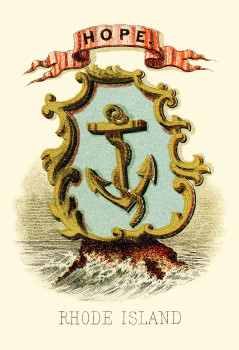 Rhode Island Coat of Arms 1876
Rhode Island Coat of Arms 1876
The Coat of Arms was adopted on February 1st 1882. It is the official emblem of the State along side Rhode Island’s seal and state flag. The Seal of the State of Rhode Island and Providence Plantations features a blue field with a golden maritime anchor as its central image below the phrase “HOPE.” The anchor has been used as a symbol for Rhode Island since the colony’s founding in 1636, which is well before region claimed the statehood. The anchor is also used in dangerous storms to secure ships and their crews. This is symbolic of ones religious faith in God. The state’s motto, “Hope” suggests placing trust in both religion and state. The state has used the anchor symbol as early as the revolutionary War on their buttons!
The Official Seal of the State of Rhode Island and Providence Plantations
1850’s-Post Rhode Island State Militia, Officer’s Staff, General Use
Color: A Nicely Aged Gold.
Metal: High Convex, 3-Piece, Raised Design, Gilt Brass.
Size: 22.07mm. Coat Size.
Albert’s Number: RI 7: Unlisted B/M
Tice’s Number: RI 201-A.1
Variation: Rhode Island Coat of Arms / Short Banner Ribbon / 24 Six Pointed stars /Small 3 Mast Sailing Ship.
Present Condition: A Non Excavated Specimen, Exceptional Planchet Condition, An Exceptional High Relief Pattern Remains.
Isabela’s Notes: Several manufacturers made this pattern button for staff officers who were in the Rhode Island’s State Militia. There are 2 known die variants, and 8 backmarks for the coat size; and 4 backmarks for the cuff size. Even though the pattern dates from 1850’s, this button’s backmarks dates to a transitional use from 1860’s post. The main difference in the coat’s size pattern is the length of the banner ribbon. The buttons that has a short banner ribbon were made prior to, and during the Civil War, and buttons with the longer banner ribbons were made post 1865. The button’s pattern depicts Rhode Island’s Coat of Arms. There is a small anchor on a pebbled field. The cable comes off the anchor’s upright top ring on the L-H-S. It goes under the stock, then under and over the shaft, and then dangles under the left side of the crown. Above the anchor is the state’s motto, “Hope” in a Short Banner Ribbon. Circling around the outside legend is 24 Six Pointed Stars. On the lower left-side is a Small 3 Mast Sailing Ship.The high relief pattern is set on a high convex evenly lined field with an extended flat edge.
Reverse Button Analysis: This is a 3-piece button with a loop shank. The original shank is original, straight, and intact. D. EVANS & CO. / ATTLEBORO MASS dm inner inner stipple ring, transitional use ca 1860 to post war, Evans 02.
1850’s-Post Rhode Island State Militia, Officer’s Staff, General Use
Color: A Glimmering Gold.
Metal: High Convex, 3-Piece, Raised Design, Gilt Brass.
Size: 21.67mm. Coat Size.
Albert’s Number: RI 7: RV 10
Tice’s Number: RI 201-A.2
Variation: Rhode Island Coat of Arms / Small Anchor / Hope / Short Banner Ribbon / 24 Six Pointed stars.
Present Condition: A Non Excavated Specimen, Exceptional Planchet Condition, An Exceptional High Relief Pattern Remains.
Isabela’s Notes: Several manufacturers made this pattern button for staff officers who were in the Rhode Island’s State Militia. There are 2 known die variants, and at least 8 backmarks for the coat size; and 4 backmarks for the cuff size. The main difference in the coat’s size pattern is the length of the banner ribbon. The buttons that depict the short banner ribbon were made prior to, and during the Civil War, and buttons with the longer banner ribbons were made post war. The button’s pattern depicts Rhode Island’s Coat of Arms. There is a Small Anchor on a pebbled field. The cable comes off the anchor’s upright top ring on the L-H-S. It goes over the stock, then under and over the shaft, and then dangles under the left side of the crown. Above the anchor is the state’s motto, “Hope” in a Short Banner Ribbon. Circling around the outside legend is 24 Six Pointed Stars. On the lower left-side is a Small 3 Mast Sailing Ship.The high relief pattern is set on a high convex evenly lined field with an extended flat edge.
Reverse Button Analysis: This is a 3-piece button with a loop shank. The original shank is original, straight, and intact. R & W. ROBINSON / .*.*. MAKERS .*.*. / ATTLEBOROUGH / * MASS. * dm solid ring separating inner and outer inscription, ca 1840’s, Robinson RW16.
The RJ Silverstein Collection.
1850’s-Post Rhode Island State Militia, Officer’s Staff, General Use
Color: Gold W/ Brown Highlights.
Metal: High Convex, 3-Piece, Raised Design, Gilt Brass.
Size: 14.6mm. Hat or Cuff Size.
Albert’s Number: RI 7: RV 10
Tice’s Number: RI 201-As.3
Variation: Rhode Island Coat of Arms / Small Anchor / Hope / Short Banner Ribbon / 24 Six Pointed stars.
Present Condition: A Non Excavated Specimen, Strong Planchet Condition, An Good High Relief Pattern Remains.
Isabela’s Notes: Several manufacturers made this pattern button for staff officers who were in the Rhode Island’s State Militia. There are 3 known backmarks for this pattern in cuff size. This is very similar to coat size pattern. The button’s pattern depicts Rhode Island’s Coat of Arms. There is a Small Anchor on a pebbled field. The cable comes off the anchor’s Upright Top Ring on the L-H-S. It goes over the stock, then under and over the shaft, and then dangles under the left side of the crown. Above the anchor is the state’s motto, “Hope” in a Small Banner Ribbon. Circling around the outside legend is 24 Six Pointed Stars. On the lower left-side is a Small Sailing Ship. The high relief pattern is set on a high convex evenly lined field with an extended flat edge.
Reverse Button Analysis: This is a 3-piece button with a loop shank. The original shank is original, straight, and intact.FINE / ** QUALITY ** dm, small size only, likely D Evans, ca 1860, Fine02 Small.
1860’s Rhode Island State Militia, General Use
Color: A Brassy Brown.
Metal: Convex, 2-Piece, Raised Design, Gilt Brass.
Size: 23.35mm. Coat Size.
Albert’s Number: RI 8: RV 5
Tice’s Number: RI 203-A.2
Variation: Pronounced Stock, Crown and Flukes / Rhode – Island / Hope / R H D S Touch Crest Scrolls.
Present Condition: A Non Excavated Specimen, Strong Planchet Condition, A Strong High Relief Pattern Remains.
Isabela’s Notes: There are 4 known die variations to this pattern. The differences are in the position of the letters to the scroll, and if there is a hyphen present in-between the state’s name. Scovill made these buttons for Rhode Island’s enlisted men, and they were used extensively during the Civil War. Some of the backmarks suggest this pattern button continued to be manufactured after the war. The button’s pattern depicts a medium size Anchor in the center. The anchor has a Pronounced Stock, Crown, and Flukes. The cable comes off the anchor’s relaxed top ring from the left hand side. It goes over the stock and then under and over the shaft where it ends dangling behind the left crown. In the legend above is the states name, “Rhode – Island” in a semicircle. In this variant there is a Hyphen in-between the state’s name. In the legend below is the state’s motto, “Hope” in a flowing banner ribbon. In this variant the letters, “R“,”H“,”D“, and “S” all Touch the Crest’s Scrolls. The high relief pattern is set on an evenly lined convex field with a thin raised edge.
Reverse Button Analysis: This is a 2-piece button with a loop shank. The original shank is original, straight, and intact. SCOVILL. MFG. CO. / WATERBURY. dm between rings of dots, ca 1860’s, Scovill M320.
The R J. Silverstein Collection.
1850’s-60’s Rhode Island State Militia, General Use Cuff
Color: Brass Yellow W/ Brown highlights.
Metal: Convex, 2-Piece, Raised Design, Gilt Brass.
Size: 14.06mm. Cuff or Hat Size.
Albert’s Number: RI 8: Unlisted
Tice’s Number: RI 203-As.1
Variation: Small Anchor / Pronounced Stock, Crown, and Flukes / Rhode Island / No Hyphen / Hope.
Present Condition: An Excavated Specimen, A good Planchet Condition, A Strong High Relief Pattern Remains.
Isabela’s Notes: This is similar to the coat pattern, and there is 3 known Scovill backmarks. The button’s pattern depicts a Small Anchor in the center. The anchor has a Pronounced Stock, Crown, and Flukes. The cable comes from the L-H-S of the anchor’s relaxed top ring. It goes over the stock, then under the shaft 2x and under the right side of the crown where it dangles below. In the legend above the anchor is the states name, “Rhode Island.” In this die variant there is No Hyphen in-between the state’s name. In the legend below is the states motto, “Hope” in a flowing banner ribbon. In this die variant, none of the letters in the state’s name touch the crest’s scrolls. The high relief pattern is set on an evenly lined convex field with a thin raised edge.
Reverse Button Analysis: This is a 2-piece button with a loop shank. The original shank is original, straight, and intact. SCOVILLS & Co (dot under the o). / . EXTRA . dm between two stipple rings, used only for small size, the abbreviated name, Scovills & Co, from the 1840’s was used with Scovill Mfg coat buttons of the 1850’s and 1860’s, as a way to abbreviate the mark on the limited space of a small size button. Scovill C15Small.
1850’s-65 Rhode Island State Militia, General Use
Color: A Brassy Brown.
Metal: Convex, 2-Piece, Raised Design, Gilt Brass.
Size: 22.09mm. Coat Size.
Albert’s Number: RI 8: RV 5
Tice’s Number: RI 203-C.1
Variation: No Hyphen / Pronounced Stock, Crown, and Flukes / Rhode Island / Hope.
Present Condition: An Excavated Specimen, Good Planchet Condition, A Good High Relief Pattern Remains.
Isabela’s Notes: D. Evans made these buttons for Rhode Island’s militia prior to and then during the Civil War. Evans also produced Silver-Plated buttons with this pattern. In this die variation there is No Hyphen in-between the state’s name. The button’s pattern depicts a medium size Anchor in the center. The anchor has a Pronounced Stock, Crown and Flukes. The cable comes off the anchor’s relaxed top ring from the center. It goes over the stock and then under, over, and under the shaft where it disappears behind the crown. In the legend above is the states name, “Rhode Island” in a semicircle. In this variant there is No Hyphen in-between the state’s name. In the legend below is the state’s motto, “Hope” in a flowing banner ribbon. In this variant none of the letters touch the crest’s scrolls. The high relief pattern is set on an evenly lined convex field with a thin raised edge.
Reverse Button Analysis: This is a 2-piece button with a loop shank. The original shank is original, straight, and intact. D. EVANS & CO / * ATTLEBORO * MASS * dm ca 1850’s to 1865, Evans 06.
1850’s-65 Rhode Island State Militia, General Use
Color: A Brassy Brown.
Metal: Convex, 2-Piece, Raised Design, Gilt Brass.
Size: 22.09mm. Coat Size.
Albert’s Number: RI 8: RV 5
Tice’s Number: RI 203-C.1
Variation: No Hyphen / Pronounced Stock, Crown, and Flukes / Rhode Island / Hope.
Present Condition: An Excavated Specimen, Good Planchet Condition, A Good High Relief Pattern Remains.
Isabela’s Notes: F.F. Hassan of Boston made these buttons with No Hyphen in-between the state’s name. The button’s pattern depicts a medium size Anchor in the center. The anchor has a Pronounced Stock, Crown and Flukes. The cable comes off the anchor’s relaxed top ring from the center. It goes over the stock and then under, over, and under the shaft where it disappears behind the crown. In the legend above is the states name, “Rhode Island” in a semicircle. In this variant there is No Hyphen in-between the state’s name. In the legend below is the state’s motto, “Hope” in a flowing banner ribbon. In this variant none of the letters touch the crest’s scrolls. The high relief pattern is set on an evenly lined convex field with a thin raised edge.
Reverse Button Analysis: This is a 2-piece button with a loop shank. The original shank is original, straight, and intact. ***F.F.HASSAM.*** / BOSTON dm with flower having 6 petals.
1860’s Rhode Island State Militia, General Use Cuff
Color: Brass Yellow.
Metal: Convex, 2-Piece, Raised Design, Gilt Brass.
Size: 15.28mm. Cuff or Hat Size.
Albert’s Number: RI 8: Unlisted
Tice’s Number: RI 203-Cs.2
Variation: Small Anchor / Rhode Island / No Hyphen / Hope / No Letters Touch Scroll.
Present Condition: A Non Excavated Specimen, A Strong Planchet Condition, A Strong High Relief Pattern Remains.
Isabela’s Notes: This is similar to the coat pattern, and there is 5 known backmarks. The earlier ones made by D. Evans can be found in both Silver plating and Gilt brass. The button’s pattern depicts a Small Anchor from the states coat of arms in the center. The anchor has a Pronounced Crown. The cable comes from the center of the anchor’s upright top ring. It goes over the stock, then under the shaft where it then disappears behind the crown on the r-h-s. In the legend above the anchor is the states name, “Rhode Island.” In this die variant there is No Hyphen in-between the state’s name. In the legend below is the states motto, “Hope” in a flowing banner ribbon. In this variant, none of the letters in the state’s name touches the crest’s scrolls. The high relief pattern is set on an evenly lined field with a thin raised beveled edge.
Reverse Button Analysis: This is a 2-piece button with a loop shank. The original shank is original, straight, and intact. D. EVANS & CO / * EXTRA * dm inner solid ring, only used small size, ca 1860’s, Evans 20 small.
The R J. Silverstein Collection.
1860 Rhode Island State Militia, General Use
Color: A Dull Brass Yellow With Brown Highlights.
Metal: Low Convex, 1-Piece, Raised Design, Gilt Brass.
Size: 22.19mm. Coat Size.
Albert’s Number: RI 27: RV 25
Tice’s Number: RI 233-A.1
Variation: Mounted Dragoon on a Charging Mount while Wielding an Unsheathed Saber.
Present Condition: A Non Excavated Specimen, Exceptional Planchet Condition, A Strong High Relief Pattern Remains.
Isabela’s Notes: The providence Horse Guard was first organized in September of 1842, at the close of the Dorr Rebellion. (The Dorr War (1841–1842) was a failed attempt to force a broader democracy in Rhode Island, where a small rural elite was in control of the government. The war was led by Thomas Wilson Dorr, who mobilized the disenfranchised people to demand changes to the state’s electoral rules). The first elected Captain of the Providence Horse Guard was Almon K Hodges. Unfortunately, a few years after the initial formation the recruits interest waned and the guard disbanded. In 1861, Lincoln’s call for volunteers spurred the reorganization of the Horse Guard into a new state regiment. This became the 1st Rhode Island Cavalry, and was composed of the Horse Guards and the New Hampshire Cavalrymen. Robinson manufactured these fairly common buttons during the 1840’s. Most of these buttons measure 22mm, and were poorly struck off center. There is a noted large 25mm button with this pattern, but is unknown if it was an anomaly. Most of these buttons appear unworn and in great condition. The button’s pattern depicts a Mounted Dragoon on a Charging Mount while Wielding an Unsheathed Saber. In the legend above is the 1st part of the military designation, “Providence Horse” in a semicircle. Below is the 2nd part of the designation, “Guard” in a semicircle. The high relief pattern is set on a plain low convex field with a plain edge.
Reverse Button Analysis: This is a 1-piece button. The original shank is original, straight, and intact.
The R J. Silverstein Collection.
1835-55 Kentish Guards, East Greenwich.
Color: A Brass Yellow With Copper Undertones.
Metal: Convex, 2-Piece, Raised Design, Gilt Brass.
Size: 22.7mm. Coat Size.
Albert’s Number: RI 22: Unlisted B/M.
Tice’s Number: RI 221: Unlisted B/M.
Variation: K G / 1774 / 13 American 5 Pointed Stars 180 Deg. Pointing Outwards.
Present Condition: A Non Excavated Specimen, Strong Planchet Condition, A Strong High Relief Pattern Remains.
Isabela’s Notes: This guard was originally formed in 1774, and then by the war in 1776, it was part of the Rhode Island Brigade. Story goes that 3 hours of the arrival of the news of the Battle of Lexington & Concord, this uniformed company was marching towards Boston for war. It was noted that the guard manned a Fort at East Greenwich Harbor, and also sent 35 of it’s troops to join the Continental Army. The Guards furnished more important officers to the Revolutionary Army then any other company in New England. This included: Major General Nathanael Greene, Colonel Christopher Greene, and Colonel A. Crary. Also, during the Thomas Dorr War, the company guarded the bridge over the Blackstone River at Pawtucket. Then later during the Civil War, this company served as Company H, 2nd Regt. Rhode Island Infantry. It also had men on the rolls of the 4th Brigade Rhode Island Militia. These button’s date from 1835-1855 Antebellum period. There is only one known pattern for this companies button, but has at least 3 known backmarks. The button’s pattern depicts the initials of the Kentish Guards, “KG” in large Roman font letters. Underneath is the date of the guards original formation, “1774“. Circling the legend is 13 American 5 Pointed Stars turned 180 deg. pointing outwards. The high relief pattern is set on an evenly lined field with a raised plain slanted edge which helps form an inner Picture Window.
Reverse Button Analysis: This is a 2-piece button. The original shank is original, straight, and intact.
G. W. SIMMONS & CO. / . BOSTON . dm outer ring of stipples. Simmons 01.
Picture Courteous of Harry Ridgeway.
1843 Rhode Island State Guard
Color: A Brass Yellow With Coppery-Brown Undertones.
Metal: Convex, 2-Piece, Raised Design, Gilt Brass.
Size: 22.74mm. Coat Size.
Albert’s Number: RI 31: RV 25
Tice’s Number: RI 242-A.1
Variation: R I G /13 American 5 Pointed Stars / Picture Window.
Present Condition: A Non Excavated Plate Specimen, Strong Planchet Condition, A Strong High Relief Pattern Remains.
Isabela’s Notes: In 1843, the State of Rhode Island chartered this unit under Captain John C. Harris as acting Commander. By 1850, the unit became inactive. This regiment should not be confused with Providence RI’s Irish regiment that used the same name at the close of the Civil War in 1865. The button’s pattern depicts the initials for Rhode Island Guard, “RIG” in the center. Circling the legend is 13 American 5 Pointed Stars. The high relief pattern is set on an evenly lined field with a raised plain slanted edge which helps form an inner Picture Window.
Reverse Button Analysis: This is a 2-piece button. The original shank is original, straight, and intact. * R & W ROBINSON * / EXTRA dm with 2 inner dm rings and one outer.
Previously, the Mabel-fischer Collection.
The R J. Silverstein Collection.
1850’s-60s’ Rhode Island, Bristol Train Artillery
Color: A Brass Yellow With Copper Highlights.
Metal: Convex, 2-Piece, Raised Design, Gilt Brass.
Size: 22.94mm. Coat Size.
Albert’s Number: RI 15: Unlisted B/M
Tice’s Number: RI 206-A.2
Variation: American Eagle / Federal Type Shield / Rhode Island’s Crest Anchor / B.T.A / 13 American Stars.
Present Condition: A Non Excavated Specimen, Strong Planchet Condition, A Strong High Relief Pattern Remains.
Isabela’s Notes: There was only one pattern made for this unit’s button, but it could show 3 different backmarks. Robinson and D. Evans manufactured these common buttons from the early 1840’s and continued on into the 1860’s. The Backmark with the D. Evan’s Swallowtails is the harder backmark to find over the others. In 1794, this unit was organized in Bristol, Rhode Island. Samuel Wardwell became the first Captain 2 years later in 1796. In 1797, 14 years after the Revolutionary War ended, 2 brass field pieces which were captured in the war from British General John Burgoyne was presented to the company. They were used for ceremonial purposes at all public occasions. During the Civil War, The Train of Artillery was part of the 5th Brigade Rhode Island Active Militia. What is unique about this die is the Rhode Island Navy Anchor from the state’s crest was added into the federal Shield. The button’s pattern depicts an American Eagle perched on a Triple Ringed Cannon facing right. On the eagle’s chest is a Federal Type Shield with a Rhode Island’s Crest Anchor. The Cannon has a Large Double Ring Breech, and sits on a Carriage with Eight Spokes. There are 6 Cannon Balls stacked in a pyramid shape under the breech. In the legend above is the initials for Bristol Train Artillery, “B.T.A” in large capital letters. In the legend below is the units inception date, “1794”. Flanking the center motif on both sides is 13 American 5 Pointed Stars. Six Stars on the left, and Seven Stars on the Right. The high relief pattern is set on an evenly lined low convex field with a thin flat edge that makes a picture window.
Reverse Button Analysis: This is a 2-piece button. The original shank is original, straight, and intact. D. EVANS & CO. ATTLEBORO . MASS dm on a ribbon reading clockwise with swallow tails on each end, flower at bottom. ca 1850’s – 1860’s, Evans D.210.
The R J. Silverstein Collection.
1850’s-60s’ Rhode Island, Bristol Train Artillery
Color: A Bright Gold.
Metal: Convex, 2-Piece, Raised Design, Gilt Brass.
Size: 22.89mm. Coat Size.
Albert’s Number: RI 15: RV 2
Tice’s Number: RI 206-A.3
Variation: American Eagle / Federal Type Shield / Rhode Island’s Crest Anchor / B.T.A / 13 American Stars.
Present Condition: A Non Excavated Plate Specimen, A Strong Planchet Condition, An Exceptional High Relief Pattern Remains.
Isabela’s Notes: There was only one pattern made for this unit’s button, but it could show 3 different backmarks. Robinson and D. Evans manufactured these common buttons from the early 1840’s and continued on into the 1860’s. In 1794, this unit was organized in Bristol, Rhode Island. Samuel Wardwell became the first Captain 2 years later in 1796. In 1797, 14 years after the Revolutionary War ended, 2 brass field pieces which were captured in the war from British General John Burgoyne was presented to the company. They were used for ceremonial purposes at all public occasions. During the Civil War, The Train of Artillery was part of the 5th Brigade Rhode Island Active Militia. What is unique about this die is the Rhode Island Navy Anchor from the state’s crest was added into the federal Shield. The button’s pattern depicts an American Eagle perched on a Triple Ringed Cannon facing right. On the eagle’s chest is a Federal Type Shield with a Rhode Island’s Crest Anchor. The Cannon has a Large Double Ring Breech, and sits on a Carriage with Eight Spokes. There are 6 Cannon Balls stacked in a pyramid shape under the breech. In the legend above is the initials for Bristol Train Artillery, “B.T.A” in large capital letters. In the legend below is the units inception date, “1794”. Flanking the center motif on both sides is 13 American 5 Pointed Stars. Six Stars on the left, and Seven Stars on the Right. The high relief pattern is set on an evenly lined low convex field with a thin flat edge that makes a picture window.
Reverse Button Analysis: This is a 2-piece button. The original shank is original, straight, and intact. D. EVANS & CO. ATTLEBORO MASS dm is in-between 2 circles.
Previously, the Mabel-Fischer Collection.
The R J. Silverstein Collection.
1880’s Rhode Island State Militia (Indian War Period)
Color: A golden Brown.
Metal: Low-Convex, 2-Piece, Raised Design, Gilt Brass.
Size: 22.59mm. Coat Size.
Albert’s Number: RI 10:
Tice’s Number: RI # Unlisted
Variation: Small 11 mm Anchor / Slightly Barbed Crown / Hope / Rhode Island / 13 American 5 Pointed stars.
Present Condition: A Non Excavated Specimen, Strong Planchet Condition, A Strong High Relief Pattern Remains.
Isabela’s Notes: The button has 2 known patterns. The first die variant has a Small 11mm Anchor with large flukes. The second known die variant has a Large Anchor. This button’s pattern depicts the Seal of Rhode Island. There is a Small Anchor with Large Flukes, and a Slightly Barbed Crown. The anchor has an upright top ring without a relaxed cable. The state’s motto, “HOPE” is in small letters under the crown. In the legend above is the state’s name, “RHODE ISLAND” in a semicircle. In the legend below is 13 American 5 Pointed Stars pointed outwards. The high relief pattern is set on an evenly lined field with a thin raised plain edge.
Reverse Button Analysis: This is a 2-piece button. The original shank is original, straight, and intact. SCOVILL MF’G CO. / WATERBURY. ” dm large letters inner ring of dots, Scovill.932.
The RJ Silverstein Collection.
1840’s-60 Rhode Marine Corps Artillery
Color: A Brass Yellow W/ Brown Speckles.
Metal: Convex, 2-Piece, Raised Design, Gilt Brass.
Size: 23.00mm. Coat Size.
Albert’s Number: RI 29: RV 05
Tice’s Number: RI 236-A.1
Variation: Double Ringed Cannon / Large Breech / Carriage has 8 Spokes / PMCA / 1801.
Present Condition: A Non Excavated Specimen, A Strong Planchet Condition, A Strong High Relief Pattern Remains.
Isabela’s Notes: This unit was formed by the city of Providence in 1801, to improve it’s citizenry in military discipline and protocols. The unit was originally made up of officers from the Providence Marine Society and the city’s seafaring men. Originally, they were equipped with two heavy coastal defense guns which were mainly used for ceremonial purposes during parades. The first time the Marines saw action was in the Dorr War of 1842. A small expedition that was armed with muskets went to Acote’s Hill. In 1847, the Marine Artillery became the 1st light artillery unit organized by the state’s militia. It’s principle duties was to act as a training unit for new light artillery companies. Military historians often claimed that the Providence Marine Corps was the mother of all volunteer light artillery units during the Civil War. They became the battery of the 1st Rhode Island Detached Militia Regt. at the onset of the Civil War. The Marine Corps of Artillery mustered out on August of 1861, but continued on as the 2nd Brigade, Rhode Island Active Militia. buttons of this historic unit have been found at the base of Louden Heights, Virginia, and the Antietam area. Both Robinson and D. Evans manufactured these buttons for 20 years from 1840-1860. There is only one known pattern for this button, but has 3 maker backmarks. The button’s pattern depicts a Double Ringed Cannon with a Large Breech. The cannon’s a Carriage has Eight Spokes and sits on a grassy plain. Under the cannon’s breech is Nine Cannon Balls stacked in a pyramid shape. In the legend above the cannon is the initials for the Providence Marine Corps of Artillery, “PMCA.” In the legend below is the date, “1801” which is when this Corps was first organized. The high relief pattern is set on an evenly lined convex field with a flat raised edge.
Reverse Button Analysis: This is a 2-piece button. The original shank is Pos. Replacement, straight, and intact. * R & W ROBINSON * / EXTRA RICH dm with 2 inner rings and one outer.
1840’s-60 Rhode Marine Corps Artillery
Color: A Brass Yellow W/ Rusty Brown Highlights.
Metal: Convex, 2-Piece, Raised Design, Gilt Brass.
Size: 23.00mm. Coat Size.
Albert’s Number: RI 29: RV 05
Tice’s Number: RI 236-A.3
Variation: Double Ringed Cannon / Large Breech / Carriage has 8 Spokes / PMCA / 1801.
Present Condition: A Dug Specimen, A Good Planchet Condition, A Good High Relief Pattern Remains.
Isabela’s Notes: This unit was formed by the city of Providence in 1801, to improve it’s citizenry in military discipline and protocols. The unit was originally made up of officers from the Providence Marine Society and the city’s seafaring men. Originally, they were equipped with two heavy coastal defense guns which were mainly used for ceremonial purposes during parades. The first time the Marines saw action was in the Dorr War of 1842. A small expedition that was armed with muskets went to Acote’s Hill. In 1847, the Marine Artillery became the 1st light artillery unit organized by the state’s militia. It’s principle duties was to act as a training unit for new light artillery companies. Military historians often claimed that the Providence Marine Corps was the mother of all volunteer light artillery units during the Civil War. They became the battery of the 1st Rhode Island Detached Militia Regt. at the onset of the Civil War. The Marine Corps of Artillery mustered out on August of 1861, but continued on as the 2nd Brigade, Rhode Island Active Militia. buttons of this historic unit have been found at the base of Louden Heights, Virginia, and the Antietam area. Both Robinson and D. Evans manufactured these buttons for 20 years from 1840-1860. There is only one known pattern for this button, but has 3 maker backmarks. The button’s pattern depicts a Double Ringed Cannon with a Large Breech. The cannon’s a Carriage has Eight Spokes and sits on a grassy plain. Under the cannon’s breech is Nine Cannon Balls stacked in a pyramid shape. In the legend above the cannon is the initials for the Providence Marine Corps of Artillery, “PMCA.” In the legend below is the date, “1801” which is when this Corps was first organized. The high relief pattern is set on an evenly lined convex field with a flat raised edge.
Reverse Button Analysis: This is a 2-piece button. The original shank is original, straight, and intact. D. EVANS & CO . ATTLEBORO MASS dm with a swallow-tailed ribbon. There is a sunburst between the ribbon ends.
1835-1855 Rhode Island Washington Cavalry
Color: A Brass Yellow.
Metal: Convex, 2-Piece, Raised Design, Gilt Brass.
Size: 22.58mm. Coat Size.
Albert’s Number: RI 35: RV 20
Tice’s Number: RI 251-A.1
Variation: Rhode Island Coat of Arms / Small Anchor / Hope / Short Banner Ribbon / Washington Cavalry.
Present Condition: A Non Excavated Specimen, A Strong Planchet Condition, An Exceptional High Relief Pattern Remains.
Isabela’s Notes: R & W Robinson made these buttons from 1835 to 1855. The button’s pattern depicts Rhode Island’s Coat of Arms. There is a Small Anchor on a pebbled field. The cable comes off the anchor’s upright top ring on the L-H-S. It goes over the stock, then under and over the shaft, and then dangles under the left side of the crown. Above the anchor is the state’s motto, “Hope” in a Short Banner Ribbon. Below the Coat of Arms is the initials for Washington Cavalry, “WC” in old english capital letters. The high relief pattern is set on an evenly lined convex field with a thin flat edge that makes a picture window.
Reverse Button Analysis: This is a 2-piece button. The original shank is original, straight, and intact.
The RJ Silverstein Collection.
1860 Rhode Island State Militia, General Use
Color: A Brassy Brown.
Metal: Convex, 2-Piece, Raised Design, Gilt Brass.
Size: 23.35mm. Coat Size.
Albert’s Number: RI 8:
Tice’s Number: RI
Variation:
Present Condition: A Non Excavated Specimen, Strong Planchet Condition, A Strong High Relief Pattern Remains.
Isabela’s Notes:
Reverse Button Analysis: This is a 2-piece button. The original shank is original, straight, and intact.
The R J. Silverstein Collection.
South Carolina’s Militia

South Carolina is located in the Southeastern United States. It is bordered by the Atlantic Ocean to the East, North Carolina in the north, and the Savannah River to the west with Georgia. The name Carolina takes it’s name from Charles I; which is Latin for “Charles land.” Originally Spain colonized the coastal areas, but frequent battles between the Native Americans caused the Spanish people to retreat to Florida, Cuba, and Mexico. Then a colony of Carolina was established by British settlers from Barbados; and shortly after in 1670, King Charles gave eight aristocrats a Royal Charter, and they sponsored the first permanent settlement in Charleston. At this point there was no North or South Carolina, it was solely the Province of Carolina. John Locke who was an English philosopher wrote a constitution for the colony that covered topics for land division and social ranking. This caused settlers not to buy land there, and after a time proprietors were forced to lower prices to attract new settlers. The Province of Carolina did not develop as planned because of political reasons, and this caused a split creating two different colonies. In 1719 settlers in South Carolina wanted more political power and seized control from it’s proprietors. This rebellion failed, and the King assumed jurisdiction for a short time. Then in 1729, Carolina became two Royal Colonies- North Carolina and South Carolina. Farmers from Virginia moved into North Carolina and grew tobacco and sold timber and tar to the English Navy. Since North Carolina lacked a good harbor, they used Virginia’s ports to conduct their trade.
As settlements spread in South Carolina, more Germans and Scotch-Irish moved up from Virginia and traded in deer skin, lumber, and beef. South Carolina farming prospered from the fertility of their Low-Country, and the use of good harbors such as, Charlestown. The Low Country ended up creating and earthworks of dams and canals which irrigated rice fields and indigo plants. Indigo is a blue flowering plant which was used to dye textiles. This became a major commodity crop for South Carolina. Slave labor slowly became an integral part of South Carolina’s economic success for farming. By the time of the American Revolution, slaves exceeded the number of Anglo-European colonists. In March of 1776, the colony adopted the first constitution of South Carolina and it became the first Republic in America; and John Rutledge was elected as the first President. After the Battle at Sullivan’s Island in 1776, South Carolina approved their Coat of Arms design. It depicts a Palmetto Tree on a seashore, which is suppose to be symbolic of a Revolutionary fort built that was built on Sullivan’s Island by Palmetto Trees. At the base of the Palmetto is a broken Oak Tree which symbolizes the British fleet. Twelve Spears are bound to the Palmetto’s trunk which represents the other twelve colonies. A band that ties the spears is inscribed in Latin, “Quis Separabit” which means, “Who shall separate.” Beneath the oak is another Latin inscription, “Meliorem Lapsa Locavit” which means, “Having fallen, set up better”; which basically means the decline of British control and the ascendance of South Carolina.
The state also adopted a motto,“Animis Opibusque Parati” which means, “Prepared in Mind and Resources.” (In 1831-32, Gov.Hamilton placed the first order to Scovills with this design and motto in defiance to the Federal Gov. Policy on Tariffs. The states militia used these buttons several years later). In February of 1778, South Carolina became the first state to ratify the Articles of Confederation. On May 23, 1788 South Carolina became the 8th state to enter the Union. In later years during the Federal Period of 1783-95, politics was split between the Federal elite who supported the central government in Philadelphia, and the large portion of common people who wanted more democracy. As far as foreign affairs, most people supported the French Revolution (1789-95). Charleston was one of the most French influenced cities in America. Leading figures such as Governors Charles Pinckney and William Moultrie backed with money and political support French commercial goals in North America. This pro-French stance ended soon because of the XYZ Affair, and Frances refusal to accept C. Pinckney US Ambassador. By the beginning of 1800, with the increasing value of cotton, ordinary farmers shifted into slave major holders. With the collapse of the cotton prices in the late 1820’s and 1830’s, South Carolina went into a major economic crises. This was mostly blamed on the Federal Tariffs Laws of 1828 & 32, in which northern tariffs were placed on foreign manufactured goods. In 1832, John Calhoun tried to nullify the Federal Tariff Act but failed because President Andrew Jackson responded to the crises with the threat of force. As the years progressed, festering problems of northern domination and slavery led to another convention in Charleston, and in December of 1860, South Carolina became the first state to leave the Union. Shortly after hostilities commenced when Cadets from the Citadel fired on the Federal ship, “Star of the West” while attempting to supply Fort Sumter.

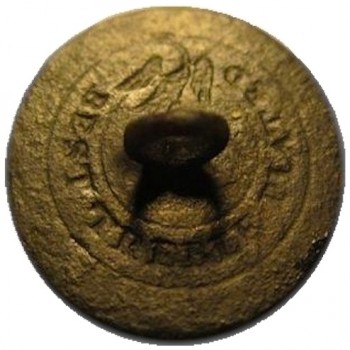
1790-1800? South Carolina State Militia Palmetto Button
Color: A Pewter Grey with Brown Undertones.
Metal: Flat, 1-Piece, Raised Design, Plated.
Size: 20mm.
Albert’s Number: Unlisted RV 200
Tice’s Number: Unlisted
Present Condition: An Excavated Specimen, Strong Planchet Condition, A Strong Impression Remains.
Isabela’s Notes: This most likely was the first English Palmetto Tree button manufactured.
Reverse Button Analysis: This is a flat one-piece casting for reverse shank. The original shank is original straight and intact.
The Dale Collection.


1775-1780 2nd Regiment, South Carolina State Militia
Color: Muddy River.
Metal: Flat, 1-Piece, Raised Design, Pewter.
Size: 24.50mm.
Troiani’s Number: A2SC.f.: RV 200
Tice’s Number: Similar to SC OO6A.1
Present Condition: An Excavated Example, Good Planchet Condition, A Strong High Relief Pattern Remains.
Isabela’s Notes: This is an extremely rare button, probably only 5-8 known specimens. The button’s pattern depicts South Carolina’s initials, “SC” above the Arabic number “2”. Encompassing the inner pattern is a concentric ring that circles around the edge. The high relief design is set on a plain flat field. Records show this unit organized in Charleston in the summer of 1775, and served there until 1776. and then again in 1780. Consolidated with the 6th Regiment in 1780. Also Served in Savannah and a detachment in Florida.
Reverse Button Analysis: This is a flat one-piece casting for reverse shank. The original shank is unfortunately missing. Mold line present.
Excavated by Edisto River, South Carolina.~
The Bill Cross Collection.
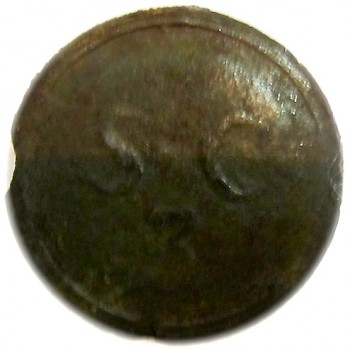
1775-1780 3rd Regiment, South Carolina State Militia
Color: Muddy River.
Metal: Slightly Domed, 1-Piece, Raised Design, Pewter.
Size: 24.50mm. Coat Size.
Troiani’s Number: A3SC.a
Tice’s Number: Similar to SC012A.1
Present Condition: An Excavated Specimen, Good Planchet Condition, A Good High Relief Pattern Remains.
Isabela’s Notes: This is another extremely rare Rev War button, most likely under 5 specimens known. The button’s pattern depicts South Carolina’s initials, “SC” above the Arabic number “3”. Encompassing the inner pattern is a concentric ring that circles around the edge. The high relief design is set on a plain slightly domed field. Served in Charleston in 1775-76, and in Savannah, and Southern Highlands. This unit served against the Cherokee Indians in 1776 and also in Florida in 1778. Captured by the British with the fall of Charleston in May of 1780.
Reverse Button Analysis: This is a flat one-piece casting for reverse shank. The original shank is original and intact, but bent. Mold line present.
The Robert French Collection.
1805-12 South Carolina State Militia Palmetto Button
Color: A Forest Green with Brown Highlights.
Metal: Flat, 1-Piece, Raised Design, Pewter.
Size: 23.25mm.
Albert’s Number: Unlisted RV 200
Tice’s Number: SC033A.1
Present Condition: An Excavated Specimen, A Good Planchet Condition, A Good High Relief Pattern Remains.
Isabela’s Notes: This most likely was the first Palmetto Tree button produced. This was made by Raymond Chissey of Charleston in 1808. He advertised in the newspaper he was making these now for the South Carolina local Militia. The button depicts a Palmetto tree in the center with the 1776 date underneath. enircling around the design is 17 Six Pointed Asterisk Type Stars. This is encompassed by a concentric rope-like ring around the edge. The high relief pattern is set on a plain flat field.
Reverse Button Analysis: This is a flat one-piece button with a loop shank. The shank is original, straight, and intact.
Excavated by Edisto River, South Carolina.~
The Bill Cross Collection.
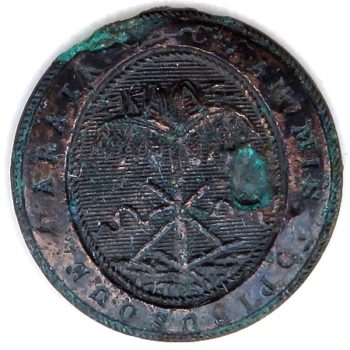
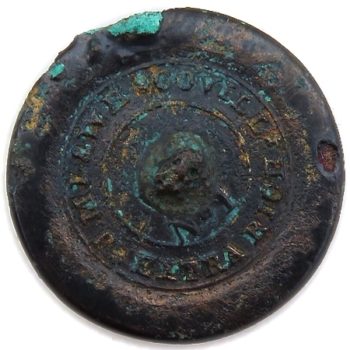
1832-65 South Carolina (Nullification) State Militia
Color: A Coppery Brown.
Metal: Flat, 1-Piece, Raised Design, Copper (Poss. Brass).
Size: 22.5mm.
Albert’s Number: SC1/PC9: RV 50 Isabela: RV 100
Tice’s Number: SC 210A.1
Present Condition: An Excavated Specimen, Good Planchet Condition, A Strong High Relief & Impressed Pattern.
Isabela’s Notes: These buttons were originally known as Nullification buttons, or States Rights Buttons. In either 1831 or 1832, Governor Hamilton placed the original order with Scovills for this pattern. Records indicate repeat orders were made for several more years. They were originally purchased as a symbol of political defiance to the US Government’s policy on Tariffs for foreign manufactured goods (Federal Tariffs Act) namely, cotton. The buttons were later adopted by the State’s Militia. So this is one of those rare buttons that had early political significance, and later went on for military use. A number of examples have been excavated on Civil War Battlefields. The pattern shows the states coat of arms in an oval lined field with a wide plain border with inner and outer rope edging. The outside legend has the State’s Motto, “ANIMIS OPIBUSQUE PARATI .S.C.” (Meaning Prepared in Mind and Resources).
Reverse Button Analysis: This is a one-piece button. The original shank is unfortunately missing. *J.M L &W.H. SCOVILL*/EXTRA RICH/No 1″ rm within a channel.
Excavated in Charleston, South Carolina 1 of 2 found.~
The R J. Silverstein Collection.
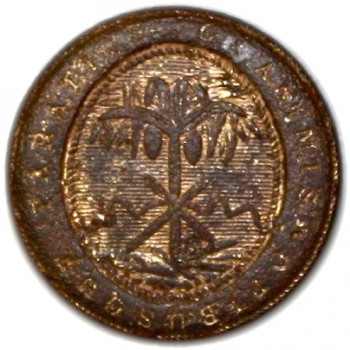
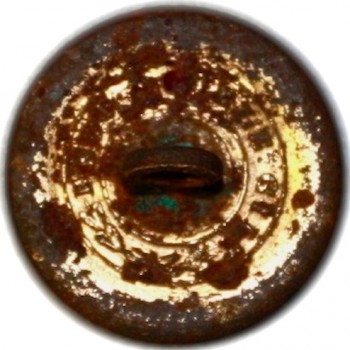
1832-65 South Carolina (Nullification) State Militia
Color: A Gilt Brown.
Metal: Flat, 1-Piece, Raised Design, Gilt Brass.
Size: 23mm. Coat Size.
Albert’s Number: SC1/PC9: RV 50 Isabela: RV 100
Tice’s Number: SC 210A.3
Present Condition: An Excavated Example, A Strong Planchet Condition, A Good/Strong High Relief & Impressed Pattern.
Isabela’s Notes: These buttons were originally known as Nullification buttons, or States Rights Buttons. In either 1831 or 1832, Governor Hamilton placed the original order with Scovills for this pattern. Records indicate repeat orders were made for several more years. They were originally purchased as a symbol of political defiance to the US Government’s policy on Tariffs for foreign manufactured goods (Federal Tariffs Act) namely, cotton. The buttons were later adopted by the State’s Militia. So this is one of those rare buttons that had early political significance, and later went on for military use. A number of examples have been excavated on Civil War Battlefields. The pattern shows the states coat of arms in an oval lined field with a wide plain border with inner and outer rope edging. The outside legend has the State’s Motto, “ANIMIS OPIBUSQUE PARATI .S.C.” (Meaning Prepared in Mind and Resources).
Reverse Button Analysis: This is a one-piece button with a loop shank. The original shank is original, straight, and intact. Double Best Gilt / Wreath
Excavated in Charleston, South Carolina 2 of 2 found.~
The Dave Gerber Collection.
South Carolina State Militia, General Use
Color: Brass With Brown Highlights.
Metal: Convex, 2-Piece, Raised Design, Gilt Brass.
Size: 23.01mm. Coat Size.
Albert’s Number: SC13: RV 8
Tice’s Number: SC 248 A.10
Variation: South Carolina Initials / 2 Arrow Points Touch Log /ANIMIS OPIBUSQUE PARATI .S.C.
Present Condition: A Non Excavated Specimen, Strong Planchet Condition, A Strong High Relief Pattern Remains.
Isabela’s Notes: These were common use buttons made by Scovills between 1840-1860’s. Many are Silver Plated Copper, and some are Gilt Brass. The button’s pattern depicts the Motif for South Carolina’s State Seal of a Palmetto Tree with Two Cross Arrows over a Broken Oak on an evenly linked field. South Carolina’s initials, “SC” flank each side of the Palmetto Tree. In this variation the 2 Arrow Points just touch the ends of the horizontal Broken Oak. In the legend circling 3/4 away around the button is the State’s Motto, “ANIMIS OPIBUSQUE PARATI .S.C.” (Meaning Prepared in Mind and Resources). There is a decorative raised half-circle on the inner border. The high relief pattern is set on an evenly lined field. There is a beveled edge trim.
Reverse Button Analysis: This is a one-piece button for the reverse shank. :SCOVILLS & CO: / WATERBURY rmdc.
The Mabel Frost-Fisher Collection.
The RJ Silverstein Collection.
1850-60’s South Carolina State Militia, General Use
Color: Brass Yellow W/ Brown Highlights.
Metal: Convex, 2-Piece, Raised Design, Gilt Brass.
Size: 28.82mm. Cuff Size.
Albert’s Number: SC15Bv: Unlisted Backmark.
Tice’s Number: SC 262 Am.5
Variation: Left Arrow Touches Log / 6 Fonds / ANIMIS OPIBUSQUE PARATI .S.C.
Present Condition: An Excavated Specimen, A Strong Planchet Condition, A Strong High Relief Pattern Remains.
Isabela’s Notes: These were common use buttons made by Scovills between 1850-1860’s. Some of these buttons post date Civil War so collectors should note backmarks. The button’s pattern depicts the Motif for South Carolina’s State Seal of a Palmetto Tree with Two Cross Arrows over a Broken Oak on an evenly linked field. South Carolina’s initials, “SC” flank each side of the Palmetto Tree. There are 6 Fonds that are on each side of the 2 central leafs. In this variation the Left Arrow Point just touch the end of the horizontal Broken Oak. In the legend circling 3/4 away around the button is the State’s Motto, “ANIMIS OPIBUSQUE PARATI .S.C.” (Meaning Prepared in Mind and Resources). There is a decorative raised half-circle on the inner border. The high relief pattern is set on an evenly lined field. There is a beveled edge trim.
Reverse Button Analysis: This is a one-piece button for the reverse shank. SCOVILLS MG.CO There 3-DOTS.
The Mabel Frost-Fisher Collection.
The RJ Silverstein Collection.
1860-65 South Carolina Palmetto Guard
Color: Brass Yellow W/ Copper Undertones.
Metal: High Convex, 2-Piece, Raised Design, Gilt Brass.
Size: 21mm. Coat Size.
Albert’s Number: SC 17 A: Unlisted Backmark.
Tice’s Number: SC 286 Am: Unlisted B/M
Variation: Snake Coiled / Palmetto Tree / C S / Three Arrows / Animis Opibusque Parati / 5 Pointed Star.
Present Condition: An Excavated Specimen, A Strong Planchet Condition, A Strong High Relief Pattern Remains.
Isabela’s Notes: Unfortunately, there is no concrete evidence that this button was used by the Palmetto Guard. The guard was part of the 17th South Carolina State Militia regt. until 1862. We know that most of the Palmetto Guard served as Company I, 2nd South Carolina Infantry in Kershaw’s Brigade. Collector’s should note that a single specimen was dug in an 1862, campsite of Kershaw’s Brigade at Maryland Heights, MD. These buttons have also been found in the Western Theatre. All of these high quality specimens were made in Britain. Some variants give the impression of a 3-piece officer’s button with a false rim. The button’s pattern depicts a Snake facing left while coiled around the trunk of a Palmetto Tree. Flanking each side of the Palmetto tree is the initial’s, “C S” for Confederate States. At the base of the tree on the left hand side is Three Arrows pointing upwards. On the right hand side is some kind of military object, possibly a cannon? Circling around the legend is the Motto for South Carolina, “ANIMIS OPIBUSQUE PARATI” which means, “Prepared in Mind and Resources.” There is a 5 Pointed American Star in the bottom legend flanked by Two raised Stipples. The high relief pattern is set on an evenly lined high-convex field with a raised flat edge.
Reverse Button Analysis: This is a one-piece button for the reverse shank. the shank is original, straight, and intact. EXTRA / Gold Quality in old english.
The Picture is Courteous of Bill Henderson.


1835-40 Moultrie Guard, South Carolina Militia
Color: Brown & White.
Metal: Flat, 1-Piece, Raised Design, Brass.
Size: 22.5mm.
Albert’s Number: SC 32 (PG 497) RV 100
Tice’s Number: SC292A.1
Present Condition: An Excavated Example, Good Planchet Condition, A Good High Relief Pattern Remains.
Isabela’s Notes: This is a very scarce button even though an “Unused card turned up in auction” miraculously in the 21st century. All preceding examples were dug on civil war sites. The button’s pattern depicts Sergeant William Jasper remounting the South Carolina Flag on Fort Sullivan during the British attack on June 28, 1776. Recommend only dug specimens.
Reverse Button Analysis: This is a flat two-piece button. The shank is original, straight, and intact. W.H.JONES & CO * / SUPERFINE rmdc
Excavated in Charleston, South Carolina.~
The Dave Gerber Collection.

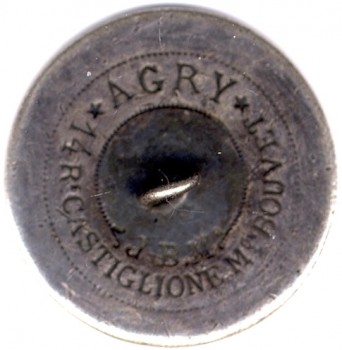
South Carolina State Militia Palmetto Tree Officer’s Button
Color: Silvery Charcoal Gray.
Metal: Flat, 1-Piece, Raised Design, Solid Silver.
Size: 25mm.
Albert’s Number: SC18: RV 50
Tice’s Number: SC208A.1
Present Condition: A Non Excavated Example, Exceptional Planchet Casting, Exceptional High Relief Pattern.
Isabela’s Notes: This rare button has a large Palmetto Tree in the center, with the states initials, “S C” separated on each side of the tree. This high relief design is set upon a Speckled field. Jean Battiste Marie Muleur of Sens, France and Agry of Paris made these buttons in a very limited number from Silver Coins. Since the buttons were made from a Silver, Mill marks were added around the rim to prevent shaving off the original Silver Coin. Tice did note that there was a single example dug at a Civil War Campsite, but most are non excavated examples that were probably cherished.
Reverse Button Analysis: This is a one-piece button for the reverse shank. *AGRY*/14Re CASTIGLIONE Mon BOUVET/J-B.M dm between an outer ring of dots and an inner semi circle of dashes with fancy ends.
The Horse Soldier.~
Republic of Texas Infantry and Artillery
1837 Texas State Militia, General Use
Color: Antique Brass.
Metal: Convex, 2-Piece, Raised Design, Gilt Brass.
Size: 22/23mm Coat Size
Albert’s Number: TX 6A: RV 75
Tice’s Number: TX 204A.2 French Blank Back.
Variation: Raised Five Point Star on a Lined Field / Thin Raised Edge.
Present Condition: A Non Excavated Plate Specimen, Strong Planchet Condition, A Strong High Relief Pattern Remains.
Isabela’s Notes: This button was most likely made after the initial Scovill order of 1837. The Republic frequently used blank backmark buttons during the era. Thought to be French made because of it’s similarities to TX 2 french blank backmark. Collectors have noted some coat and cuff specimens with backmarks. The button’s pattern depicts a large raised plain field Five Point Star on an Evenly Lined Field. The states name “TEXAS” above in raised capital letters. The high relief pattern is set on a convex field with a Thin Raised Edge.
Reverse Button Analysis: This is a two-piece button with a copper loop shank in a depressed channel.
The Picture is Courteous of Bill Cadman JR.
Previously the Mabel Frost Fisher Collection.

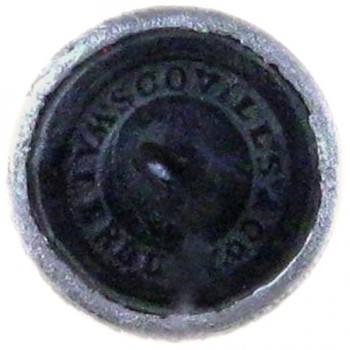
1837-1850’s Republic of Texas Infantry
Color: Silvered Charcoal.
Metal: 2-Piece, Convex, Raised Design, Silver Plated.
Size: 20mm. Coat Size
Albert’s Number: TX 10: RV 75
Tice’s Number: TX 208A.1
Variation: Five Point Star / Republic of Texas / Lone Star.
Present Condition: An ExcavatedSpecimen, Strong Planchet Condition, A Strong High Relief Pattern Remains.
Isabela’s Notes: This is one of the more commonly found infantry buttons found for Texas Troops. Scovills produced these silver plated buttons as part of the 1837 order. The button depicts a Five Point Star in the center, with a raised “I” for Infantry in the middle. Circling around the edge in the legend is “REPUBLIC OF TEXAS” in all raised capital letters; and there is a series of four raised Lone Stars in the bottom legend at six o’clock. The high relief pattern is set on a plain convex field with no edge border. Texas troops continued to use this pattern through the 1850’s. A Collector’s favorite that is semi available.
Reverse Button Analysis: This is a two-piece button with a loop shank. The shank is original, straight and intact. Scovills & Co / Waterbury rmdc (Scovill C06).
The Picture is Courteous of Allen Gaskins.
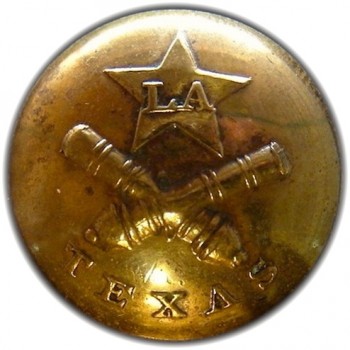

1837 Republic of Texas Light Artillery
Color: A Golden Brass with Olive Undertones.
Metal: Convex, 2-Piece, Raised Design, Gilt Brass.
Size: 19mm. Coat Size
Albert’s Number: TX11: RV 200
Tice’s Number: TX214Am.1
Variation: Cross Cannons with Double Ringed Barrels / Five Point Star / LA / Texas.
Present Condition: A Non Excavated Specimen, Exceptional Planchet Condition, An Exceptional High Relief Pattern.
Isabela’s Notes: Texas authorities actually designed and ordered these button from Scovills in 1837. This rare button depicts a set of raised Cross Cannons with Double Ringed Barrels in the center. Above is a raised Five Point Star with the raised initials, “LA” on top. Inscribed below is the Republic’s name, “TEXAS” in raised capital letters. The high relief pattern is set on a plain convex field with no edge border. Collectors of Texas buttons should seek any available example if offered.
Reverse Button Analysis: This is a two-piece button with a copper loop shank. The shank is original, straight and intact..Scovills / Waterbury dm with 2 dotted ring dm.
The Picture is Courteous of B. Henderson.

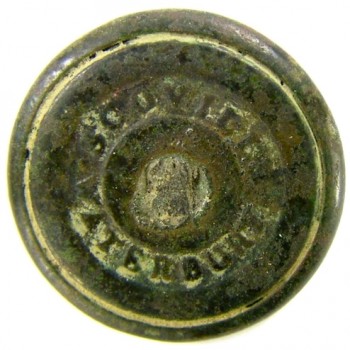
1837-40’s Republic of Texas Dragoons
Color: A Desert Brown on Black.
Metal: Low-Convex, 2-Piece, Raised Design, Gilt Brass.
Size: 19.3mm.
Albert’s Number: TX 09: RV 100
Tice’s Number: TX 216A.1
Variation: Five Point Star / Raised D for Dragoons / Texas.
Present Condition: An Excavated Specimen, Good Planchet Condition, Strong High Relief Pattern Remains.
Isabela’s Notes: The button’s pattern depicts a Five Point Star in the center with a Raised “D” for Dragoons set in the middle. Arced above the star in the top legend is the Republic’s name, “TEXAS” in all capital letters. The high relief pattern is set on a plain low-convex field with no edge border. Scovill produced these buttons as part of the 1837 order. Texas Dragoons continued to use this pattern through the 1840’s.
Reverse Button Analysis: This is a two-piece button with a loop shank. The original shank is missing. Scovills . / Waterbury rmdc (Scovill 13Coat)
*Scovill Mfg did a 1936 reissue in 13.6mm
Dug in Stafford County, Virginia.
The Picture is Courteous of Harry Ridgeway.


1860’s Texas State Militia
Color: Gold!.
Metal: Convex, 2-Piece, Raised Design, Gilt Brass.
Size: 22mm.
Albert’s Number: TX 17: RV 50
Tice’s Number: TX 234A.2
Variation: Five Point Lone Star / T-E-X-A-S in-Between the Points / Rope Border.
Present Condition: A Non Excavated Example, Strong Planchet Casting, Exceptional High Relief Pattern.
Isabela’s Notes: This button was produced just prior to the start of the Civil War in 1860. Civil War collectors consider this the standard button used by the Texas Militia during the Civil War. The button’s pattern depicts a large flat Five Point Lone Star in the center, with the letters, “T-E-X-A-S” set in-between the points in large capital letters. Circling around the outside of the design is a Rope Border. The high relief pattern is set on a convex lined field with a thin lip edge border.
Reverse Button Analysis: This is a two-piece button with a copper loop shank in a depressed channel.*** EXTRA *** /RICH within a 2 ring dotted dm. (EXTRA R02)
Cuff sized buttons with a depressed Steele & Johnson BM are post 1865.
The Picture is Courteous of Harry Ridgeway.
1860’s Texas State Militia
Color: An Olive Gold.
Metal: Convex, 2-Piece, Raised Design, Gilt Brass.
Size: 13.7mm. Cuff Size
Albert’s Number: TX 17Av: RV 20
Tice’s Number: TX 234As.1
Variation: Raised Five Point Star / T-E-X-A-S in-Between the Points / Rope Border.
Present Condition: A Non Excavated Specimen, Strong Planchet Condition, A Strong High Relief Pattern Remains.
Isabela’s Notes: This button was produced just prior to the start of the Civil War in 1860. Civil War collectors consider this the standard button used by the Texas Militia during the Civil War. The button’s pattern depicts a large flat Five Point Lone Star in the center, with the letters, “T-E-X-A-S” set in-between the points in large capital letters. Circling around the outside of the design is a Rope Border. The high relief pattern is set on a convex lined field with a thin lip edge border.
Reverse Button Analysis: This is a two-piece button with a copper loop shank in a depressed channel. HYDE & GOODRICH within a 2 ring dotted dm. (Hyde 05 Small)
Cuff sized buttons with a depressed Steele & Johnson BM are post 1865.
The Picture is Courteous of Harry Ridgeway.


1860’s Texas State Militia Officer’s Button
Color: A Golden Orange.
Metal: High-Convex, 3-Piece, Raised Design, Gilt Brass.
Size: 22.4mm Coat Size
Albert’s Number: TX 21: RV 15
Tice’s Number: TX 232A.2 Unlisted Backmark.
Variation: Five Point Star on a Lined Field / Thin Flat Edge.
Present Condition: A Non Excavated Specimen, Strong Planchet Condition, A Strong High Relief Pattern Remains.
Isabela’s Notes: Scovill first made these buttons around 1860, but most were made after the Civil War. Collectors should note that pre-1865 specimens have a very narrow rim and a small shank. The button’s pattern depicts a large raised Five Point Star on a Lined Field. The high relief pattern is set on a high convex field with a Thin Flat Edge border. Civil War collectors should study backmark before purchasing since most made after war.
Reverse Button Analysis: This is a two-piece button with a copper loop shank in a depressed channel. SCHUYLER H & G. /NEW YORK. between 2 dotted rings. (Schuyler 17).
The Picture is Courteous of Harry Ridgeway.
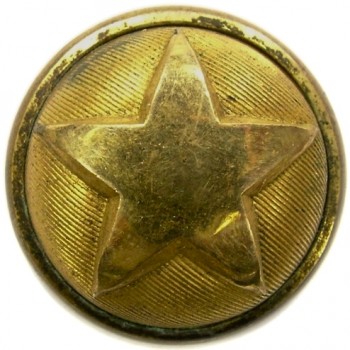
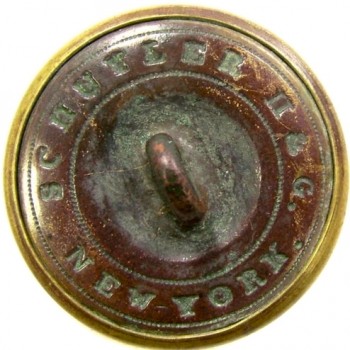
1860’s Texas State Militia Officer’s Button
Color: A Golden Orange.
Metal: High-Convex, 3-Piece, Raised Design, Gilt Brass.
Size: 22.4mm Coat Size
Albert’s Number: TX 21: RV 15
Tice’s Number: TX 232A.2
Variation: Five Point Star on a Lined Field / Thin Flat Edge.
Present Condition: A Non Excavated Specimen, Strong Planchet Condition, A Strong High Relief Pattern Remains.
Isabela’s Notes: Scovill first made these buttons around 1860, but most were made after the Civil War. Collectors should note that pre-1865 specimens have a very narrow rim and a small shank. The button’s pattern depicts a large raised Five Point Star on a Lined Field. The high relief pattern is set on a high convex field with a Thin Flat Edge border. Civil War collectors should study backmark before purchasing.
Reverse Button Analysis: This is a two-piece button with a copper loop shank in a depressed channel. SCHUYLER H & G. /NEW YORK. between 2 dotted rings. (Schuyler 17).
The Picture is Courteous of Harry Ridgeway.
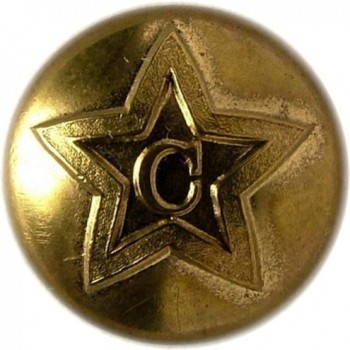
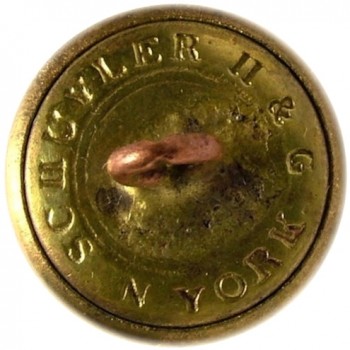
1860’s Texas State Cavalry
Color: A Golden Brass.
Metal: Convex, 2-Piece, Raised Design, Gilt Brass.
Size: 15.5mm Cuff Size
Albert’s Number: TX 22: RV 15
Tice’s Number: TX 242As.1
Variation: Stippled Five Point Star with A Matching Cut Center / C for Cavalry.
Present Condition: A Non Excavated Specimen, Strong Planchet Condition, An Exceptional High Relief Pattern Remains.
Isabela’s Notes: Scovill first produced these buttons around 1860, but non have ever been excavated in Texas. Several specimens have been excavated in Virgina within Civil War sites. There has been a long debate if these were originally intended for Texas Cavalry. The button’s pattern depicts a raised channel with a Stipple base that is in the shape of a Five Point Star. This raised pattern leaves a Matching Cut Center. Within the cut-center is the initial, “C” for Cavalry. The high relief pattern is set on a plain convex field with no edge border.
Reverse Button Analysis: This is a two-piece button with a copper loop shank. SCHUYLER H & G. /NEW YORK. 2 inner rings. (Schuyler 24 small).
The Picture is Courteous of Harry Ridgeway.
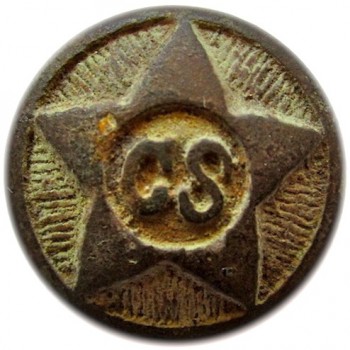
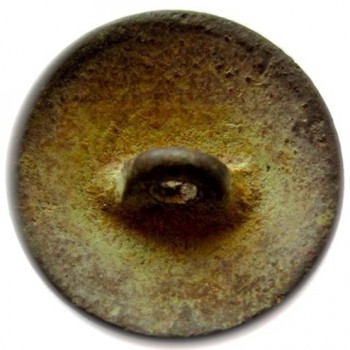
1861-65 Army of Confederate States Texas State Lone Star with CS Initials
Color: A Yellowish-Brown.
Metal: Convex, One-Piece with Integral Shank, Cast Brass.
Size: 21.43mm. Coat Size
Albert’s Number: TX 26: RV 50
Tice’s Number: TX 256A.1
Variation: Five Point Lone Star / CS for Confederate States / Non-Paralled Rays.
Present Condition: An Excavated Specimen, Strong Planchet Condition, A Strong High Relief Pattern Remains.
Isabela’s Notes: This is a Confederate Local “Wartime” manufactured button that was crudely made by T. Miller of Houston for Texas Troops. The button’s pattern depicts a large Five Point Lone Star with the star’s points reaching the outside circling edge border. Within the star’s center is a depressed well with the raised initials,”CS” for Confederate States. Outside of the star is a series of Non-Paralled Rays. The high relief pattern is set on a low-convex field with a raised edge border. This design has become a real collectors favorite with both Texas and Civil War Button Collectors. Specimens are around, but expensive since rarely available.
Reverse Button Analysis: This is a concave one-piece button with integral shank (drilled after cast). The shank is original, straight, and intact. (Blank Southern161).
Excavated in the defensive camps on the Gulf Coast near Houston, TX.
The RJ Silverstein Collection.


1861-85 Texas Army Officer, Staff (Tennessee)?
Color: A Yellowish Brown.
Metal: Convex, 3-Piece, Raised Design, Gilt Brass.
Size: 24mm.
Albert’s Number: TX 29: RV 150
Tice’s Number: TX 249A.1
Variation: Sectioned Five Point Star / Ray Lined Field / Inner Ring Border / Southern Confederacy.
Present Condition: An Excavated Specimen, Strong Planchet Condition, Strong High Relief Pattern Remains.
Isabela’s Notes: This button is a Confederate southern local wartime manufacture that was (supposedly) intended for Texas Officers. Some believe this button and TX 248 were not produced for Texas officers, but Tennessee officers. There was a Tennessee officer’s coat was found with both coat and cuff buttons still attached. The provenance of this officer was directly tied to the state of Tennessee. Close examination of several specimens show slight variations indicating the button was hand chased/detailed after the original pattern was struck. The button’s pattern depicts a Sectioned Five Point Star on a Ray Lined Field. The star points reach outside a scantly raised Inner Ring Border. In the legend above is the word, “SOUTHERN” and on the bottom legend is the word,“CONFEDERACY” in all capital letters that is set on a lined field. The pattern is scantly in relief. It is set on a rayed field with a thin plain edge border. This is a favorite among collectors because of the Southern Confederacy declaration in-scripted in the legend.
Reverse Button Analysis: This is a flat three-piece button with a copper loop shank. The button appears to be crudely crimped, blank back raised flat ring.


1861-65 Army of Confederate States, Texas State Militia, Artillery
Color: A White Wash Charcoal Brown
Metal: Convex Cast Brass.
Size: 20mm.
Albert’s Number: Unlisted. Isabela’s Rating: RV 150
Tice’s Number: CSA280A.2
Present Condition: An Excavated Example, Strong Casting, Strong Pattern in High Relief.
Isabela’s Notes: This button is a Confederate wartime manufacture for the Texas Artillery. The casting is a crude southern local that is made by T.E. Miller of Houston, who manufactured all of these southern local Texas Buttons. The design shows a Roman style bold “A” on a nonparallel lined field with a wide border. This is another hard to obtain favorite by collectors.
Reverse Button Analysis: This is a one-piece with an integral shank, then drilled. Back is blank with a deep concave well.
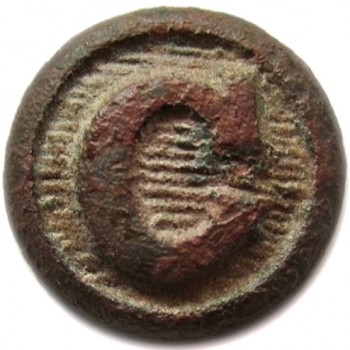
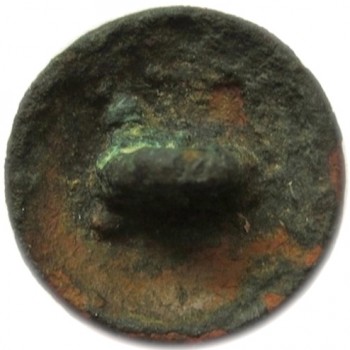
1861-65 Army of Confederate States, Texas State Cavalry
Color: An Ochre of Orange & Brown.
Metal: Convex Cast Brass.
Size: 20.02mm.
Albert’s Number: CS143: RV 125
Tice’s Number: CSC280A.2
Present Condition: An Excavated Specimen, Strong Condition, A Strong High Relief Pattern Remains.
Robert’s Notes: This button is a Confederate wartime manufacture for the Texas Cavalry. The casting is a crude southern local that is made by T.E. Miller of Houston. The design has a Roman style bold “C” on a nonparallel lined field with a wide border. This Texas Cavalry button is a rarely traded or sold on the open market. This is one most collectors hold onto unless they sell a whole collection.
Reverse Button Analysis: This is a one-piece with an integral shank, then drilled. Back is blank with a deep concave well.
Excavated in the defensive camps on the Gulf Coast near Houston, TX.
The RJ Silverstein Collection.
Vermont’s Militia Infantry
1855-60’s Vermont Miltia
Vermont is a New England State that is located in the Northeastern United States. It is bordered by Massachusetts to the south, New Hampshire to the east, New York to the west, and the Canadian Province of Quebec to the north. The state is the 6th smallest in area and is the 2nd least populous in the United States. It is the only New England state not bordering the Atlantic Ocean, but Lake Champlain forms half of Vermont’s western border with New York. Forest lands covers 75% of its total land area, and the Green Mountains are within the state.
Originally, Vermont was inhabited by two major Native American Indian tribes, the Algonquian and the Iroquois. The first European to see Vermont is thought to have been Jacques Cartier in 1535. On July 30th 1609, the French explorer Samuel de Champlain claimed Vermont as part of New France. In 1666, French settlers erected Fort Lamotte, which was the first European settlement in Vermont. The origin of the name, “Vermont” is uncertain, but most likely comes from the French les Verts Monts, meaning, “The Green Mountains.” In its early colonial period Vermont was claimed by France. In 1763, France ceded the territory to the Kingdom of Great Britain after being defeated in the 7 Years’ War ( The French-Indian War). For many years, the nearby colonies in the Province of New Hampshire and New York disputed control of the area. They issued land titles which was sometimes referred to as, “New Hampshire Grants.” There was an opposition by many of the local Vermont citizenry. Military oriented groups formed like Vermont’s Green Mountain Boys Militia. They eventually prevailed in their struggle, and created an independent state which was called, “The Vermont Republic.”
Vermont was formally established in 1777, which was during the American Revolution. On January 15th, 1777, the representatives of the New Hampshire Grants declared the independence of Vermont. For the first 6 months of it’s existence, it was called, “The Republic of New Connecticut.” On June 2, 1777, a second convention of 72 delegates met and adopted the name, “Vermont.” This was on the advice of a friendly Pennsylvanian, Dr. Thomas Young. He was also the friend and mentor of Ethan Allen who wrote to them on how to achieve admission into the newly independent United States of America as the 14th state. On July 4, the Constitution of Vermont was drafted at Windsor Tavern, and then formally adopted by it’s delegates on July 8th. It was among the first written Constitutions to partially ban slavery, provide universal suffrage for male adults, and require support for public schools. The Vermont Republic only lasted for fourteen years, and is one of only four U.S. states that was a sovereign state (Texas, Hawaii, and California). In 1791, two years after the new U.S. federal government was established, Vermont joined the union as the 14th state on March 4, 1791.
1789-1820 Vermont State Militia Officer’s button.
Color: An Antique Golden Brown.
Metal: Flat, 1-Piece, Stamped Design, Gilt Brass.
Size: 34.57mm.
Albert’s Number: WI12-D: RV 2
Tice’s Number: VTO35
Present Condition: A Non Excavated Specimen, Exceptional Planchet Condition, A Strong Impression Remains.
Isabela’s Notes: Tice notes in his book that there was an absence of a local supply of military buttons. Throughout the American Revolution Vermont Militia men had no specifications for uniforms and weapons. The law required that each man simply to posses enough material to allow him to take the field. Prescribed regulations concerning uniforms did not exist until 1838, and even then militiamen were allowed to use, “Citizens’ Coats.” So, most likely officers wore Flashy George Washington inaugural buttons as substitutes. These buttons have been found at 1777-1820 military campsites near the Poultney River in Fairhaven, and also 1790’s campsites around Vermont. Tombac buttons were also recovered in Vermont but are attributed to the Germans. Also found are 1776-1820 are common copper, brass, and pewter buttons. See description in GWI 12 Section.
Reverse Button Analysis: This is a one-piece casting for the reverse shank. Resembles a short cotter pin.
The RJ Silverstein Collection.
1820’s Vermont State Militia
Color: A Silvery Brown.
Metal: Flat, 1-Piece, Sheffield rolled Silver-Plated Copper.
Size: 21.mm. Coat Size.
Albert’s Number: VT 3 RV 30
Tice’s Number: VT 105 A.2
Variation: Stag’s Head / Vermont Militia / Six Point Star.
Present Condition: An Excavated Specimen, Fair Planchet Condition, A Fair High Relief Pattern Remains.
Isabela’s Notes: This is one of Vermont’s most desirable pattern for collectors. Tice notes last one turned up at Old Tunbridge Fairgrounds. The button’s pattern depicts a large Stag’s Head facing right. Circling around the button’s edge is the inscription, “Vermont Militia” in all capital letters. In the bottom legend is a raised Six Point Star. The high relief pattern is set on a plain flat surface with a plain edge border.
Reverse Button Analysis: This is a one-piece button with a loop shank. * BEST DOUBLE * /PLATED dm The over struck British specimens shows an outer depressed ring of dots and a pair of inner raised rings around the shank. The inner ring is of stipples and outer looks like a gear. There appears to be at least 4 different kind of backmarks including a blank one.
1810-23 Vermont’s State Militia Infantry
Color: An Antique Golden Brown.
Metal: Flat, 1-Piece, Raised Design, Gilt Brass.
Size: 26mm.
Albert’s Number: VT 2: RV 25
Tice’s Number: VT100A.4
Present Condition: An Excavated Specimen, Strong Planchet Condition, A Strong High Relief Pattern Remains.
Isabela’s Notes: Originally Arron Peasley made these button in 1810. Some of these specimens are noted for cracking around the edges due to double striking during manufacturing. There is at least 4 known backmarks including 2 British ones. The button depicts a R-H-S profile of an Eagle. In it’s left talon is a Ten Petal Laurel Branch. In the Eagle’s right talon is Three Multi-directional Arrows. The top and bottom point toward the right-hand-side, and the middle arrow points toward the laurel branch. In a semicircle above the eagle is the state’s name, “Vermont” in all capital letters. In a semicircle below is the military designation, “Militia.” The high relief pattern is set on a plain field with a plain edge.
Reverse Button Analysis: This is a one-piece casting for the reverse shank. The original shank is original, straight, and intact. TREBLE GILT / ORANGE COLOUR/ 2 RM & Possible over strike.


1842-50 Vermont State Militia Infantry
Color: Antique Silver.
Metal: Flat, 1-Piece, Raised Design, Silver Plated Copper.
Size: 22mm.
Albert’s Number: VT 4: RV 25
Tice’s Number: VT200A.1
Present Condition: An Excavated Specimen, Strong Planchet Condition, A Strong High Relief Pattern Remains.
Isabela’s Notes: The button’s pattern depicts a large standing infantryman holding a flintlock musket. Written underneath is “Vt. MILITIA” in large capital letters. The raised pattern is set on a plain field with no edge border. Robinson manufactured these early buttons for Vermont Infantry Militia. These were used until 1850-55 when two-piece coat buttons bearing the state’s Coat of Arms replaced these. This is a scarce specimen, but a collector’s favorite when available.
Reverse Button Analysis: This is a one-piece casting for the reverse shank. The original shank is original, straight, and intact. R & W. Robinson / . Attleborough/ .*.*.*. Extra.*.*.*. RICH all set within a triple raised rm ring.
Taken off a preserved Vermont Militia Uniform at the turn of the century.
The RJ Silverstein Collection.


1842-55 Vermont State Militia Infantry
Color: Chocolate Antique.
Metal: Flat, 1-Piece, Raised Design, Silver Plated Copper Obverse/Gilded Backmark?
Size: 22mm.
Albert’s Number: VT 5: RV 15
Tice’s Number: VT205A.1
Present Condition: A Non Excavated Example, Strong Planchet Condition, A Strong High Relief Pattern Remains.
Isabela’s Notes: These silver plated specimens were officially adopted by Vermont’s Militia infantry units between 1842-44. Vermont’s Artillery Militia units used the same pattern, but used Gilded Bass examples instead of the Silvered Copper. Two piece buttons bearing the State Coat of Arms replaced these early buttons by 1850-55. This button’s pattern depicts a Spread-Winged Flying Eagle facing left. In it’s left Talon is a small bundle of three arrows, in it’s right claw is holding a small petaled laurel. The center of the button has the initials, “Vt.M” with pebbled letter lines for the V & T. Underneath is a raised 5 pointed star within a wreath. The whole pattern is set on a plain field without an edge border. Robinson manufactured no smaller sizes because decorative Golden Age buttons were used on their sleeves in place.
Reverse Button Analysis: This is a one-piece casting for the reverse shank. The original shank is original, straight, and intact. R & W. Robinson / . Attleborough/ .*.*.*. Extra.*.*.*. RICH all set within a triple raised rm ring.
The RJ Silverstein Collection.


1842-55 Vermont State Militia, Light Infantry
Color: A Charcoal on Silver.
Metal: Flat, 1-Piece, Raised Design, Silver Plated Copper.
Size: 22mm.
Albert’s Number: VT 7: RV 10
Tice’s Number: VT215A.1
Present Condition: An Excavated Specimen, StrongPlanchet Condition, Exceptional High Relief Pattern Remains.
Isabela’s Notes: The idea of this button’s pattern was to show the solidarity between the United States Army and Vermont’s Militia units. NY had also adopted several die variants with this idea in mind also. This pattern was issued to the Light Infantry flanking companies for Vermont’s Militia units. The button’s pattern depicts the top view of a flying eagle facing left, while holding an American patriotic lined shield in it’s beak by a ring. Encircling the eagle in raised capital letters is, * LIGHT INFANTRY * Vt. MILITIA. The raised patterns is set on a plain flat field with no edge border. Un-dug specimens with an adequate amount of silvering are available.
Reverse Button Analysis: This is a one-piece casting for the reverse shank. The original shank is original, straight, and intact. R & W. Robinson / . Attleborough/ .*.*.*. Extra.*.*.*. RICH all set within a triple raised rm ring.
The RJ Silverstein Collection.
1860’s Vermont State Militia, General Use
Color: Brass Yellow With Brown Highlights.
Metal: Convex, 2-Piece, Raised Design, Gilt Brass.
Size: 23.42mm. Coat Size.
Albert’s Number: VT 9A: RV 15
Tice’s Number: VT 230A.6
Variation: Vermont’s Coat of Arms / Thick Wreath / 6 Tiers of Branches / 13 Five Point Stars.
Present Condition: A Non Excavated Specimen, Strong Planchet Condition, A Strong High Relief Pattern Remains.
Isabela’s Notes: Vermont soldiers wore these buttons on their state supplied uniforms during the Civil War. These were first produced around 1850, and continued to be used into the 20th century. After the Civil War, Vermont soldiers retained the small size buttons for their kepis. There is five or six die variants known. Multiple variations are shown in relation to the reach of the stag’s antlers to the letters, “E”, “O” & “N”. Collectors should also note the number and position of the pine tree limbs. There also appears to be a difference in the height of the high relief on the motif itself. Other variations include the length of the cow’s legs, and if a bar wreath supports the stag’s head. The button’s pattern depicts the state of Vermont’s Coat of Arms that is surmounted by a Stag Head Crest. In this die variant, the stag’s head is supported by a Thick Wreath without a bar. The antlers are evenly spaced from the legend inscription and do not touch either the “E” or “O“. The state seal has a lined sky, and there is Six Tiers of Branches that is perpendicular to the Pine Tree. Above the stags head in a semicircle is the state’s name, “Vermont” in all capital letters. In a semicircle running 3/4 around the button is 13 raised Five Point Stars. Below the shield is a banner ribbon with the state’s motto, “Freedom & Unity” in all capital letters on a stipple field. The high relief pattern is set on an evenly lined field with a thinly raised edge border.
Reverse Button Analysis: This is a two-piece button with a loop shank. The original shank is original, straight, and intact. * SCOVILL MF’G CO. * / WATERBURY. with an inner stipple ring.
The RJ. Silverstein Collection.
1855-60’s Vermont State Militia, General Use Cuff
Color: Brassy Brown.
Metal: Convex, 2-Piece, Raised Design, Gilt Brass.
Size: 14.57mm. Cuff or Hat Size.
Albert’s Number: VT 9Av: RV 2
Tice’s Number: VT 235As.4
Variation: Vermont’s Coat of Arms / Thin Wreath / Bushy Branch Pine Tree / 13 Five Point Stars.
Present Condition: An Excavated Specimen, Strong Planchet Condition, A Strong High Relief Pattern Remains.
Isabela’s Notes: Small buttons of this pattern were used with the large Vermont’s state Coat of Arms coat buttons (VT 235). Tice notes that the designer took the stag head motif from the Vermont Crest. The button’s pattern depicts the state of Vermont’s Coat of Arms that is surmounted by a Stag Head. In this die variant, the stag’s head is supported by a Thin Wreath without a bar. The antlers are touching the “R” and the “O“. The state seal shield has a Lined Sky, and a Bushy Branch Pine Tree. Above the stags head in a semicircle is the state’s name, “Vermont” in all capital letters. In a semicircle running 3/4 around the button is 13 raised Five Point Stars. Below the shield is a banner ribbon with the state’s motto, “Freedom & Unity” in all capital letters on a stipple field. The high relief pattern is set on an evenly lined field with a thinly raised edge border
Reverse Button Analysis: This is a two-piece button with a loop shank. The original shank is original, straight, and intact. * SCOVILL MF’G CO. * * *
The RJ. Silverstein Collection.
1855-60’s Vermont State Militia, General Use Cuff
Color: Dark Brassy Brown.
Metal: Convex, 2-Piece, Raised Design, Gilt Brass.
Size: 14.60mm. Cuff or Hat Size.
Albert’s Number: VT 9Av: RV 2
Tice’s Number: VT 235As.3
Variation: Stags Head / Thick Bar/ Vermont / 13 Five Point Stars.
Present Condition: An Excavated Specimen, Strong Planchet Condition, A Strong High Relief Pattern Remains.
Isabela’s Notes: This variant depicts the Stags Head without Vermont’s Coat of Arms. The button’s pattern depicts a large Stag’s Head in the center. The stag’s head is supported by a Thick Bar without a Wreath. The antlers are nicely spaced from the upper legend’s inscription. Above the stags head in a semicircle is the state’s name, “Vermont” in all capital letters. In a semicircle running 3/4 around the button is 13 raised Five Point Stars. The high relief pattern is set on an evenly lined field with a thinly raised edge border.
Reverse Button Analysis: This is a two-piece button with a loop shank. The original shank is original, straight, and intact. * SCOVILL MF’G CO.
The RJ. Silverstein Collection.
1865 Vermont State Militia General Use
* Johnson Plate Specimen*
Color: Brass Yellow With Brown Highlights.
Metal: Convex, 2-Piece, Raised Design, Gilt Brass.
Size: 22.70mm. Coat Size.
Albert’s Number: VT 9: Unlisted Backmark: RV 15
Tice’s Number: VT 230A.3
Variation: Vermont’s Coat of Arms / Thin Wreath / Six Tiers of Branches / 13 Five Point Stars.
Present Condition: A Non Excavated Plate Specimen, Strong Planchet Condition, A Strong High Relief Pattern Remains.
Isabela’s Notes: This button was made after the Civil War in 1865. The button’s pattern depicts the state of Vermont’s Coat of Arms that is surmounted by a Stag Head Crest. In this die variant, the stag’s head is supported by a Thin Wreath with No Support Bar. The antlers are evenly spaced from the legend inscription and do not touch either the “N” or “O”. The state seal has a lined sky, and the Tree has Six Tiers of Branches that is perpendicular to the Pine Tree. Above the stags head in a semicircle is the state’s name, “Vermont” in all capital letters. In a semicircle running 3/4 around the button is 13 raised Five Point Stars. Below the shield is a banner ribbon with the state’s motto, “Freedom & Unity” in all capital letters on a stipple field. The high relief pattern is set on an evenly lined field with a thinly raised edge border.
Reverse Button Analysis: This is a two-piece button with a loop shank. The original shank is original, straight, and intact. PETTIBONE MFG.CO / CINCINNATI dn with an inner stipple ring.
The RJ Silverstein Collection.
1850’s-60’s Vermont State Militia, General Use
Color: Dirty Brass.
Metal: Convex, 2-Piece, Raised Design, Gilt Brass.
Size: 23.02mm. Coat Size.
Albert’s Number: VT 9A: RV 15
Tice’s Number: VT 230B.1
Variation: Vermont’s Coat of Arms / Thin Bar Wreath / 3 Tiers of Down Swept Branches.
Present Condition: An Excavated Specimen, Strong Planchet Condition, A Strong High Relief Pattern Remains.
Isabela’s Notes: This variant is not nearly as pronounced in relief as the other ones. Vermont soldiers wore these buttons on their state supplied uniforms during the Civil War. These were first produced around 1850, and continued to be worn into the 20th century. There is five or six die variants known. Variations are shown in relation to the stag’s antlers and the letters, “E”,”O” & “N”. Collectors should also note the number and position of the tree limbs and number of branches. There also appears to be a difference in the height of the high relief on the motif itself. Other variations include the length of the cow’s legs, and if a bar wreath supports the stag’s head crest. The button’s pattern depicts the state of Vermont’s Coat of Arms that is surmounted by a Stag Head Crest. In this die variant, the stag’s head is supported by a Thin Bar Wreath. The antlers reach the legend inscription, and touch the “E” & “O“. The state seal has a Stipple Sky, and there is Three Tiers of Branches that is Down Swept on the Pine Tree. Above the stags head in a semicircle is the state’s name, “Vermont” in all capital letters. In a semicircle running 3/4 around the button is 13 raised Five Point Stars. Below the shield is a banner ribbon with the state’s motto, “Freedom & Unity” in all capital letters on a stipple field. The high relief pattern is set on an evenly lined field with a thinly raised edge border.
Reverse Button Analysis: This is a two-piece button with a loop shank. The original shank is original, straight, and intact. D.EVANS & CO ATTLEBORO MASS within a dm banner ribbon Flower between the ribbon ends.
1850’s-60’s Vermont State Militia, General Use
Color: Toned Down Gold.
Metal: Convex, 2-Piece, Raised Design, Gilt Brass.
Size: 23.02mm. Coat Size.
Albert’s Number: VT 9A: RV 15
Tice’s Number: VT 230c.1
Variation: Vermont’s Coat of Arms / Thick Wreath / 3 Tiers of Down Swept Branches / .
Present Condition: A Non Excavated Example, Strong Planchet Condition, A Strong High Relief Pattern Remains.
Isabela’s Notes: Vermont soldiers wore these buttons on their state supplied uniforms during the Civil War. These were first produced around 1850, and then continued to be worn into the 20th century. There is five or six die variants known. Collectors should also note the number and position of the tree limbs. They actually differ from one variant to another. Other variations include the cow’s legs, and if a wreath or bar supports the stag’s head crest. The button’s pattern depicts Vermont’s Coat of Arms that is surmounted by a Stag Head Crest. In this die variant, the stag’s head is supported by a Thick Bar Wreath. The stag’s antlers reach the legend inscription, and touch the “E” & “R“. The stats shield has a Stipple Sky, and there is Three Tiers of Branches that is Down Swept on the Pine Tree. In this version the Cow’s hind legs are truncated by the shield. Above the stags head in a semicircle is the state’s name, “Vermont” in all capital letters. In a semicircle running 3/4 around the button is 13 raised Five Point Stars. Below the shield is a banner ribbon with the state’s motto, “Freedom & Unity” in all capital letters on a stipple field. The high relief pattern is set on an evenly lined field with a thinly raised edge border.
Reverse Button Analysis: This is a two-piece button with a loop shank. The original shank is original, straight, and intact. D.EVANS & CO ATTLEBORO MASS within a dm banner ribbon Flower between the ribbon ends.
1850’s-60’s Vermont State Militia, General Use
Color: Bright Gold.
Metal: Convex, 2-Piece, Raised Design, Gilt Brass.
Size: 23.05mm. Coat Size.
Albert’s Number: VT 9A: RV 15
Tice’s Number: VT 230F.1
Variation: Pronounced Wreath / String of Beads / Antlers Touch R & O / 10 Branches on Pine Tree.
Present Condition: A Non Excavated Specimen, A Strong Planchet Condition, An Exceptional High Relief Pattern Remains.
Isabela’s Notes: A very popular variation among Vermont button collectors. The button’s pattern depicts the Vermont Coat of Arms that is surmounted by a Stag Head Crest. In this die variant, the stag’s head is supported by a Pronounced Wreath that depicts a String of Beads supporting the stag’s head. The stag’s antlers reach the legend inscription, and touch the “R” & “O”. The states shield has an evenly Lined Sky, and there is Five Tiers and 10 Branches on the Pine Tree. Above the stags head in a semicircle is the state’s name, “Vermont” in all capital letters. In a semicircle running 3/4 around the button is 13 raised Five Point Stars. Below the shield is a banner ribbon with the state’s motto, “Freedom & Unity” in all raised capital letters on a stipple field. The high relief pattern is set on an evenly lined field with a thin raised edge border. It is unclear of the date of use, but most likely within the above time frame.
Reverse Button Analysis: This is a two-piece button with a loop shank. The original shank is original, straight, and intact. +*+ EXTRA +*+ QUALITY.
1855-60’s Vermont State Militia, General Use Cuff
Color: Brass With Brown Highlights.
Metal: Convex, 2-Piece, Raised Design, Gilt Brass.
Size: 15.3mm. Cuff or Hat Size.
Albert’s Number: VT 9Av: RV 2
Tice’s Number: VT 235Ds.1
Variation: Stags Head / Thick Bar/ Vermont / Wide Rim / 13 Five Point Stars.
Present Condition: An Excavated Specimen, Fair Planchet Condition, A Good High Relief Pattern Remains.
Isabela’s Notes: This variant depicts the Stags Head without Vermont’s Coat of Arms. There are at least 13 known backmarks for the matching cuff to Tice’s VT 235. This variant is known for it’s wide rim. The button’s pattern depicts a large Stag’s Head in the center. The stag’s head is supported by a Thick Bar without a Wreath. The stag shows pronounced antlers and is nicely spaced from the upper legend’s inscription. Above the stags head in a semicircle is the state’s name, “Vermont” in all capital letters. In a semicircle running 3/4 around the button is 13 raised Five Point Stars. The high relief pattern is set on an evenly lined field with a thinly raised edge border.
Reverse Button Analysis: This is a two-piece button with a loop shank. The original shank is original, straight, and intact. * D. EVANS & CO. . / EXTRA*
The RJ. Silverstein Collection.
.
Vermont’s Artillery Units


1830’s Vermont’s State Militia Artillery
Color: A Golden Brass Yellow.
Metal: Flat 1-Piece Gilded Brass.
Size: 22mm.
Albert’s Number: VT 6: RV 15
Tice’s Number: VT210A.1
Variation: 6 Spoke Oval Carriage Wheel
Present Condition: A Non Excavated Specimen, Exceptional Planchet Condition, An Exceptional Low-Relief Pattern Remains.
Isabela’s Notes: This is a very popular button amongst collectors. The pattern depicts an Eagle facing right while perched on top of a ringed cannon facing left. The cannon’s carriage goes half way into an oval six spoke carriage wheel. On the left hand side there is a draped flag, and six cannon balls piled underneath in a pyramidal shape. The designation “ARTILLERY” is arched above on the top periphery of the button, and the state abbreviation, “Vt. MILITIA” is written in the bottom legend. Both words are in all capital letters. Tice notes in his book that Robinson copied the early U.S Artillery buttons to produce these gilt specimens for Vermont.
Reverse Button Analysis: Flat one-piece button *.*.*. Extra*.*.*./R&W.ROBINSON.ATTLEBOROUGH. rm with three rings.
The RJ Silverstein Collection.
Virginia Militia Infantry


1810-26 Virginia State Miltia & Political Use
Color: A Ochre of Green, Brown, & Orange.
Metal: Flat or Low Convex, 1-Piece, Raised Design, Brass.
Size: 20mm.
Albert’s Number: VA 1/ PC 79: RV 50
Tice’s Number: VA100 A.1
Variation: Small Helmet Plume.
Present Condition: An Excavated Specimen, Strong Planchet Condition, Good/Strong High Relief Pattern Remains.
Isabela’s Notes: This would be the earliest known button to use the Virginia Coat of Arms. George Wythe designed the Coat of Arms in 1776, which reflects a strong anti-monarchy, and Pro-Republican sentiment. The button depicts the State Seal of Virginia; which portrays Virtus who was the genius of the Commonwealth of Virginia. Virtus is dressed as an Amazon with a helmet on her head, a spear in her left hand, and a downward sword in her right. Virtus is standing victoriously on a form of tyranny. This variant has the body of a tyrant lying on the ground with his head on the right hand side and his despised crown on the ground. On the left hand side, there is a large broken chain, and the tyrant’s broken sword is on the ground on the bottom front. There is a scrolling folded ribbon that has the Latin phrase, “SIC SEMPER TYRANNIS” which means, “Thus ever to Tyrants,” is in capital high relief letters. There are two die variants known for this pattern. This would be the harder Virginia button to find, and non-dug examples are highly prized!
Reverse Button Analysis: This is a one-piece casting for the reverse shank. The original shank is original, straight, and intact. . PHILADa.. 2 ring rm
The Picture is Courteous of H. Ridgeway.

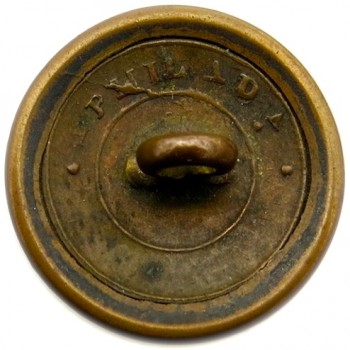
1815-25 Virginia State Militia & Political Use
Color: A Ochre of Green, Brown, & Orange.
Metal: Flat or Low Convex, 1-Piece, Raised Design, Brass (Silver Specimens known).
Size: 21mm.
Albert’s Number: VA 1-B: RV 50
Tice’s Number: VA100 B.1
Variation: Larger Helmet Plume.
Present Condition: A Non Excavated Specimen, Strong Planchet Condition, Good/Strong High Relief Pattern Remains.
Isabela’s Notes: George Armitage of Philadelphia made these between 1810-26. George Wythe was the original designer for the Virginia Coat of Arms in 1776, who’s sympathies reflect a strong anti-monarchy, and pro-Republican sentiment. This button depicts the State Seal of Virginia; which portrays Virtus who was the genius of the Commonwealth slaying a tyrant. Virtus is dressed as an Amazon Warrior who is looking forward. She has a helmet on her head that sports a large plume that is blowing to the left. In her left hand is a slanted spear that rests on the ground in-front of the fallen tyrant’s body. In Virtus right hand is a short straight sword pointing down. Virtus’s right foot is standing victoriously on the throat of the tyrant who is laying toward the right (This original variant is the only one known with the body of a tyrant lying on the ground head is on the right hand side). The tyrant’s despised crown is on the ground next to the fallen tyrant. On the lower left hand side of the button is a large chain, and the tyrant’s broken long sword is on the ground is underneath. There is a scrolling folded ribbon that has the Latin phrase, “SIC SEMPER TYRANNIS” which means, “Thus ever to Tyrants,” which is in capital high relief letters. There are two die variants known for this pattern. For serious button collectors this would be the harder Virginia specimens to obtain. Non-dug examples are highly prized!
Reverse Button Analysis: This is a one-piece button with a loop shank. The shank is original, straight, and intact. . – DOT PHILADa.DOT rm lies between two concentric rm rings.
Previously the David Gerber Collection.
The Robert J. Silverstein Collection
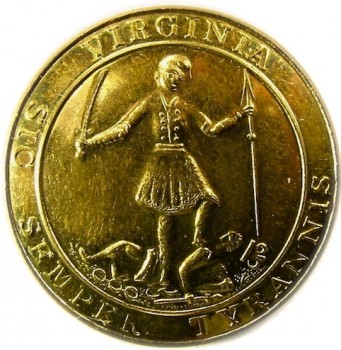
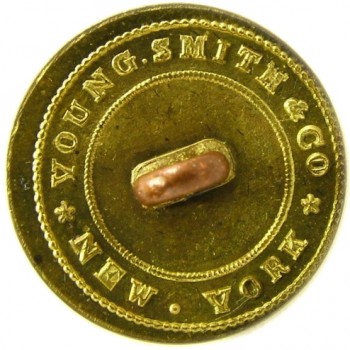
1820-35 Virginia State Militia
Color: Golden Brass.
Metal: 1-Piece, Low-Convex, Raised Design, Brass (Silver Specimens Known).
Size: 22mm.
Albert’s Number: VA 2-A: RV 25
Tice’s Number: VA105A.1
Variation: Virtus Coat has 4 Buttons on Each Side/ Spear Short of Crown & Away from Tyranny’s Head/ Ball on Spear below Virtus Hand.
Present Condition: A Non Excavated Specimen, Exceptional Planchet Condition, An Exceptional High Relief Pattern Remains.
Isabela’s Notes: As with other variants, Virtus is dressed as an Amazon Warrior who is slaying a tyrant. Virtus is facing left, and is wearing a helmet with a small plume. In this variation, she is holding a spear in her left that is characterized by a small ball below her hand. In her right hand, she is holding a short upright saber. Virtus is standing victoriously on the shoulder of the tyrant who’s despised crown is knocked off to the ground. The fallen tyrant is still clutching the blade of his sword. On the bottom right front of the button, there is a large broken chain that is symbolically cast away on the ground. Circling in the outside legend in raised capital letters is the state’s name, “VIRGINIA” which is arched at the top, and then the Latin Phrase, “SIC SEMPER TYRANNIS,” which means, Thus ever to Tyrants,” is filling out the second half of the legend. Non-dug examples are more common to come by then dug. There are 6 manufacturer’s die variants known for this pattern. This backmark indicates it was made during the early 1830’s.
Reverse Button Analysis: This is a one-piece button with a loop shank. The original shank is original, straight, and intact. *YOUNG .SMITH & CO * NEW.YORK rm lies in-between two rings of dots.
The Picture is Courteous of H. Ridgeway.
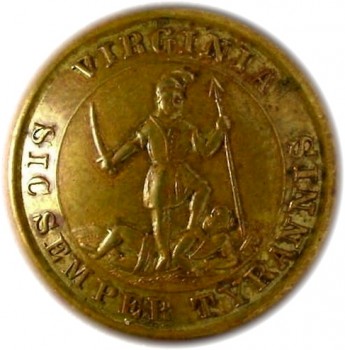

1820-35 Virginia State Militia
Color: Golden Brass.
Metal: 1-Piece, Low-Convex, Raised Design, Brass (Silver Speimens Known).
Size: 23mm.
Albert’s Number: VA 2-B: RV 25
Tice’s Number: VA105B.1
Variation: A Small Ball above Virtus’s Hand.
Present Condition: A Non Excavated Specimen, Strong Planchet Condition, A Strong High Relief Pattern Remains.
Isabela’s Notes: As with other variants, Virtus is dressed as an Amazon Warrior who is slaying a tyrant. Virtus is facing left, and is wearing a helmet with a small plume. In this variation, she is holding a spear in her left that is characterized by a small ball above her hand. In her right hand, she is holding a short upright saber. Virtus is standing victoriously on the shoulder of the tyrant who’s despised crown is knocked off to the ground. The fallen tyrant is still clutching the blade of his sword. On the bottom right front of the button, there is a large broken chain that is symbolically cast away on the ground. Circling in the outside legend in raised capital letters is the state’s name, “VIRGINIA” which is arched at the top, and then the Latin Phrase, “SIC SEMPER TYRANNIS,” which means, Thus ever to Tyrants,” is filling out the second half of the legend. Non-dug examples are more common to come by then dug. There are 6 manufacturer’s die variants known for this pattern. This backmark indicates it was made during the early 1830’s.
Reverse Button Analysis: This is a one-piece button with a loop shank. The original shank is original, straight, and intact. *YOUNG .SMITH & CO * NEW.YORK rm lies in-between two rings of dots.
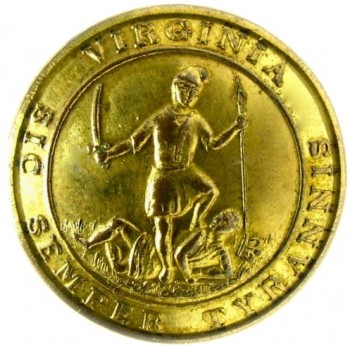
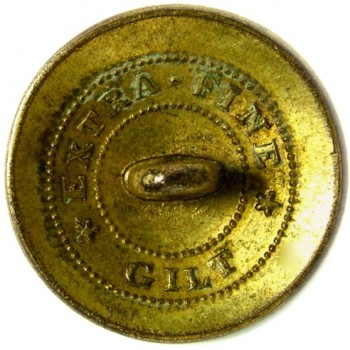
1820-35 Virginia State Militia
Color: Gold!
Metal: 1-Piece, Low-Convex, Raised Design, Brass (Silver Specimens Known).
Size: 22mm.
Albert’s Number: VA 2-C: RV 25
Tice’s Number: VA105.C.1
Variation: Spear Rests on Rim of the Crown.
Present Condition: A Non Excavated Specimen, Exceptional Planchet Condition, An Exceptional High Relief Pattern Remains.
Isabela’s Notes: The button depicts the State Seal of Virginia; which portrays Virtus who was a genius of the Commonwealth. As with other variants, Virtus is dressed as an Amazon Warrior who is slaying a tyrant. Virtus is facing left, and is wearing a helmet with a small plume on her head. In this variation, she is holding a spear in her left hand that touches the Rim of the Crown. In her right hand, she is holding a short upright saber. Virtus is standing victoriously on the shoulder of the tyrant who’s crown is knocked off to the ground. There is a very small broken chain that is symbolically cast away on the ground in front. The state’s name, “VIRGINIA” is arched at the top in capital letters that is set within a recessed channel: and the Latin phrase, “SIC SEMPER TYRANNIS” which means, “Thus ever to Tyrants,” is spelled in capitals letters in the bottom legend. Non-dug buttons are more common to come by then dug. There are 6 variation’s known for this pattern. The backmark indicates that it was English made in the 1830’s.
Reverse Button Analysis: This is a one-piece casting for the reverse shank. The original shank is original, straight, and intact. *EXTRA.FINE*GILT/ rm between two rings of dots.
The Picture is Courteous of H. Ridgeway.


1820-35 Virginia State Militia
Color: A Ochre of Green, Brown, & Orange.
Metal: 1-Piece, Low-Convex, Raised Design, Brass.
Size: 23mm.
Albert’s Number: VA2-D: RV 25
Tice’s Number: VA105.D
Variation: Spear Rest on the Upper Part of the Crown/ Dots in Legend.
Present Condition: An Excavated Specimen, Good Planchet Condition, A Good High Relief Pattern Remains.
Isabela’s Notes: This button depicts the State Seal of Virginia; which portrays Virtus who was a genius of the Commonwealth. As with other variations, Virtus is dressed as an Amazon Warrior slaying a tyrant. Virtus is facing right, and there is a helmet with a small plume on her head falling to the left. Virtus has a spear in her left hand, and a saber in her right. Virtus is standing victoriously on the top of a body form of tyranny, which is a fallen tyrant with despised crown knocked off his head. There is a small broken chain and a scourge are cast away on the ground in front. The state name, “VIRGINIA” is arched at the top in capital letters that is set within a recessed channel: and the Latin phrase, “SIC. SEMPER.TYRANNIS” which means, “Thus ever to Tyrants,” is in capitals letters in the bottom legend. Non-dug buttons are more common to come by then dug. There are 6 die variants known for this pattern. This backmark indicates it was made during the early 1830’s.
Reverse Button Analysis: This is a one-piece casting for the reverse shank. The original shank is original, straight, and intact. . YOUNG.SMITH & Co. NEW . YORK rm is in-between 2 pair of rings rm. 3rd single ring around the shank.
Excavated from the Virginia Campaign.~
The Picture is Courteous of H. Ridgeway.
1820-35 Virginia State Militia
Color: Antique Brass.
Metal: 1-Piece, Low-Convex, Raised Design, Thin Brass or Copper Overlay.
Size: 23mm.
Albert’s Number: VA2: RV 25
Tice’s Number: VA105.F
Variation: Spear Rest on the Upper Part of the Crown/ Dots in Legend.
Present Condition: A Non Specimen, Strong Planchet Condition, A Strong High Relief Pattern Remains.
Isabela’s Notes: This button was struck on a thin metal planchet and put over type “E” back. They used either a thin brass or a copper overlay for production quality purposes. This button depicts the State Seal of Virginia; which portrays Virtus who was a genius of the Commonwealth. As with other variations, Virtus is dressed as an Amazon Warrior slaying a tyrant. Virtus is facing right, and there is a helmet with a small plume on her head falling to the left. Virtus has a spear in her left hand, and a saber in her right. Virtus is standing victoriously on the top of a body form of tyranny, which is a fallen tyrant with despised crown knocked off his head. There is a small broken chain and a scourge are cast away on the ground in front. The state name, “VIRGINIA” is arched at the top in capital letters that is set within a recessed channel: and the Latin phrase, “SIC. SEMPER.TYRANNIS” which means, “Thus ever to Tyrants,” is in capitals letters in the bottom legend. This is a very hard variant to acquire, i am sad i lost my opportunity!
Reverse Button Analysis: This is a one-piece casting for the reverse shank. The original shank is original, straight, and intact. . SCOVILLS. / WATERBURY CON . / . EXTRA .. RICH rm
The Picture is Courteous of Bill Cadman JR.


1825-35 Virginia State Militia
Color: Silver with Copper Undertones.
Metal: 1-Piece, Low-Convex, Raised Design, Silvered Copper. (Gilt Specimens Known)
Size: 22mm.
Albert’s Number: VA 3-A: RV 25
Tice’s Number: VA110A.1
Variation: Spear Shaft Behind Tyranny’s Head/ 5 Point Star in Legend.
Present Condition: A Non Excavated Specimen, Strong Planchet Casting, A Strong High Relief Pattern Remains.
Isabela’s Notes: This button depicts the State Seal of Virginia; which portrays Virtus who was a genius of the Commonwealth. As with earlier variations, Virtus is dressed as an Amazon Warrior who is slaying a tyrant. Virtus is facing right, and has a helmet on her head with her hair flowing down from underneath. She is holding a spear in her left hand that goes behind the tyrants head to the ground. In her right hand, she is holding an upright saber. Virtus is standing victoriously on the shoulder of the tyrant who’s crown is dispelled to the ground. There appears to be a small mountain range in the background on the right hand side. The state’s name, ” *VIRGINIA*” is arched at the top in capital letters with two five pointed stars flanking each side. The Latin phrase, “SIC SEMPER TYRANNIS” which means, “Thus ever to Tyrants,” is spelled in capitals letters in the second half of the legend. These scarce buttons can be found in both dug and pristine un-dug condition. There are two die variants known for this pattern. British Artisans probably made these silver plated buttons between 1825-35.
Reverse Button Analysis: This is a concave one-piece button for the reverse shank. The original shank is original, straight, and intact.
The Picture is Courteous of H. Ridgeway.
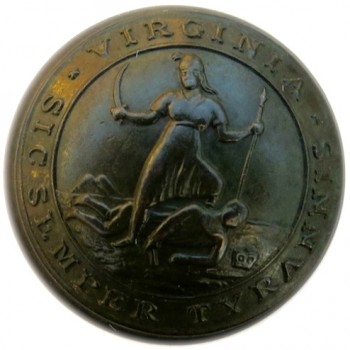
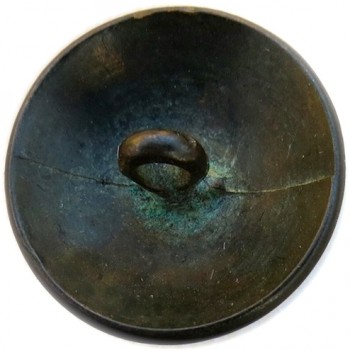
1825-35 Virginia State Militia
Color: Dark Emerald Green.
Metal: 1-Piece, Low-Convex, Raised Design, Silvered Plated.
Size: 22mm.
Albert’s Number: VA 3A: RV 25
Tice’s Number: VA110A.3
Variation: Spear Shaft Behind Tyranny’s Head/ 5 Point Star in Legend.
Present Condition: A Non Excavated Example, Strong Planchet Condition, Strong High Relief Pattern Remains.
Isabela’s Notes: This button depicts the Virginia Coat of Arms; which portrays Virtus who was a genius of the Commonwealth. As with earlier variations, Virtus is dressed as an Amazon Warrior who is slaying a tyrant. Virtus is facing right, and has a helmet on her head with her hair flowing down from underneath. She is holding a spear in her left hand that goes behind the tyrants head to the ground. In her right hand, she is holding an upright saber. Virtus is standing victoriously on the shoulder of the tyrant who’s crown is dispelled to the ground. There appears to be a small mountain range in the background on the right hand side. The state’s name, ” *VIRGINIA*” is arched at the top in capital letters with two five pointed stars flanking each side. The Latin phrase, ” SIC SEMPER TYRANNIS” which means, “Thus ever to Tyrants,” is spelled in capitals letters in the second half of the legend. These can be found in both dug and un-dug pristine condition. There are two die variants known for this pattern. British Artisans probably made these silver plated between 1825-35. This series of Virginia buttons offer a profession of variations for those collectors that like to specialize in early southern buttons.
Reverse Button Analysis: This is a concave one-piece button for the reverse shank. The original shank is original, straight, and intact.
The RJ Silverstein Collection.

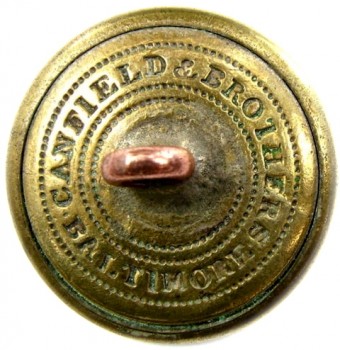
1830-40’s Virginia State Militia
Color: Silver with Copper Undertones.
Metal: Low-Convex, 2-Piece,Raised Design, Silver Plated Copper (Gilt Specimens Known).
Size: 22.5mm.
Albert’s Number: VA 4-A: RV 20
Tice’s Number: VA206A.1
Variation: Spear Rests on the Crown
Present Condition: A Non Excavated Specimen, Strong Planchet Condition, A Strong High Relief Pattern Remains.
Isabela’s Notes: Tice notes in his book, Uniform Buttons of the United States”, that this entire series of buttons is the best known, and most widely circulated out of any early 2- piece Commonwealth Coat of Arms buttons. This pattern was made by scovills during the late 1830-40’s. This button depicts Virtus slaying the tyrant. Virtus is facing left while standing on top of a tyrant. She is wearing a small helmet with a plume on her head. In her left hand she is holding a spear that rests on top of a fallen despised crown . In her right hand, she is holding a long curved saber upright. In this variation, the fallen tyrant is resting his hand upon the blade of his straight sword. There is a set of broken chains in the lower right front. Circling in the outside legend in raised capital letters is the state’s name, ” VIRGINIA” which is arched at the top, and then the Latin phrase, ” SIC SEMPER TYRANNIS” which means, “Thus ever to Tyrants,” is filling out the second half of the legend. There are two variants known for this pattern. There have been many examples of this pattern found at Civil War sites.
Reverse Button Analysis: This is a one-piece button with a copper loop shank. The original shank is original, straight, and intact. CANFIELD & BROTHERS / BALTIMORE dm two inner & one outer ring of dots.
The Picture is Courteous of H. Ridgeway.

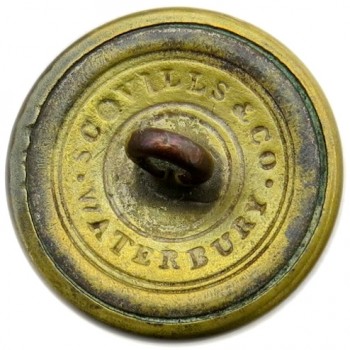
1830-40’s Virginia State Militia
Color: Gilt Brass Yellow.
Metal: Low-Convex, 2-Piece, Raised Design, Gilt Brass.
Size: 22.45mm.
Albert’s Number: VA 4-A: RV 20
Tice’s Number: VA206A.9
Variation: Spear Rests on the Crown
Present Condition: A Non Excavated Example, Strong Planchet Casting, Strong High Relief Pattern.
Isabela’s Notes: Tice notes in his book, Uniform Buttons of the United States”, that this entire series of buttons is the best known, and most widely circulated out of any early 2- piece Commonwealth Coat of Arms buttons. This pattern was made by scovills during the late 1830-40’s. This button depicts Virtus slaying the tyrant. Virtus is facing left while standing on top of a tyrant. She is wearing a small helmet with a plume on her head. In her left hand she is holding a spear that rests on top of a fallen despised crown . In her right hand, she is holding a long curved saber upright. In this variation, the fallen tyrant is resting his hand upon the blade of his straight sword. There is a set of broken chains in the lower right front. Circling in the outside legend in raised capital letters is the state’s name, ” VIRGINIA” which is arched at the top, and then the Latin phrase, ” SIC SEMPER TYRANNIS” which means, “Thus ever to Tyrants,” is filling out the second half of the legend. There are two variants known for this pattern. There have been many examples of this pattern found at Civil War sites.
Reverse Button Analysis: This is a one-piece button with a copper loop shank. The original shank is original, straight, and intact. CANFIELD & BROTHERS / BALTIMORE dm two inner & one outer ring of dots.
The RJ Silverstein Collection.
1840-50’s Zouaves, Cadets or Militia State Infantry Units
Color: A Golden Brass.
Metal: 2-Piece, High Convex Round Ball Design, Poured Brass.
Size: 19.5mm.
Albert’s Number: GI : RV 10
Variation: 17 Five Pointed Stars.
Present Condition: A Non Excavated Specimen, Strong Planchet Casting.
Isabela’s Notes: This button was intended originally for cadets, but was used by Zouaves and state militia infantry units. The button’s design was suppose to have a round look from the front, and the back is flat.
Reverse Button Analysis: This is a one-piece button with a copper loop shank. rm LONDON. BEST QUALITY. within a channel of 2 rm rings.
The RJ Silverstein Collection.
Robert’s Collector’s note on Federal General Service & State Militia Federal Style Buttons:
From my understanding, the Federal government regulated, and governed the designs and dimensions for buttons manufactured to be used by the US Army. Manufacturers were awarded the contracts, and furnished these Federal specimens. Either two things happened at this point. 1) After a time, the Federal Government could have let contracts go in way of new designs and patterns; or the manufacturers were held under no restrictions to sell these Federal Style buttons to other interested parties. In the early 19th Century, there was a lot of garment makers who would receive contracts by the various state militia units for uniforms. If a die wasn’t created for a specific unit’s button, the garment maker would supply these Federal Type buttons. Usually, under a sub-contract they would get these from the original button manufacturer who produced them under federal contract. As part of the sub-contract, the garment makers would request the manufacturer to have their name over stamp the manufacturers on the reverse.


1820-30 State Guard “Possibly” – Sarsfield Guard
Color: Gilt Brass Undertones.
Metal: Flat, 1-Piece, Raised Design, Brass.
Size: 23mm. Coat Size
Albert’s Number: UU 101
Tice:
Variation: Roman Font Letters / Wide Space Initials / Eagle Head Facing Left / Great Coat Button federal Eagle
Present Condition: A Non Excavated Specimen, Exceptional Planchet Condition, An Exceptional High Relief Pattern Remains.
Robert’s Notes: It only makes sense that “SG” would stand for State Guards, and would be available for private purchase sold to State Milita units. The backmark showing 8 stars struck over a ghost mark indicates that this is an English Re-used button. The pattern for the Great Coat button was put out for bids in 1820 and the last one ordered by the US Govt. was in 1840. So the time frame for this button would be in line with that, except I think this is an early one struck about 1820-1830. The State Guards were very popular in the Southern States during the antebellum era. National Guards were popular in the North and State Guards in the South. Mark that distinction. This is due to the feelings in the North that a strong National government was best, while the Southern States felt strong State governments was preferable.
Reverse Button Analysis: The reverse shank is original, straight, and intact. Backmark is “********” with in two concentric rings. Backmark is struck over another backmark.
